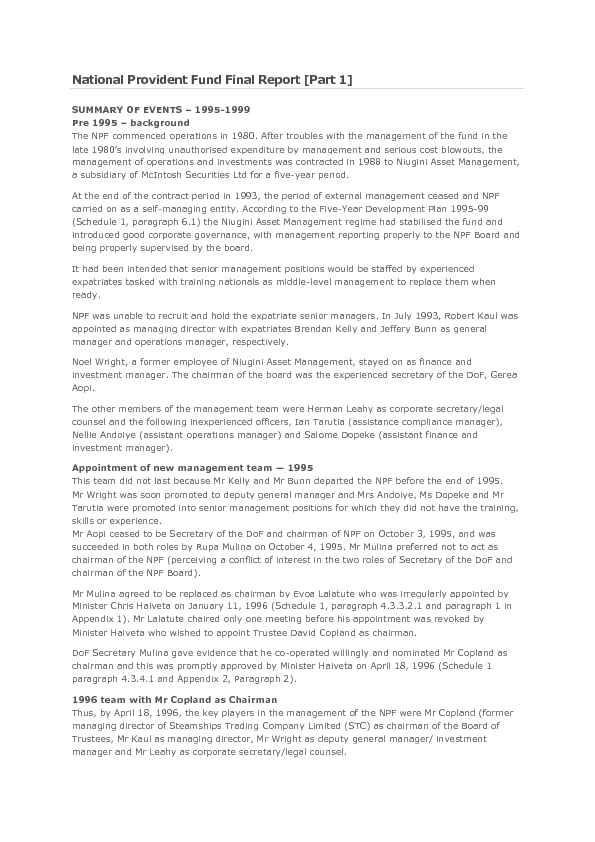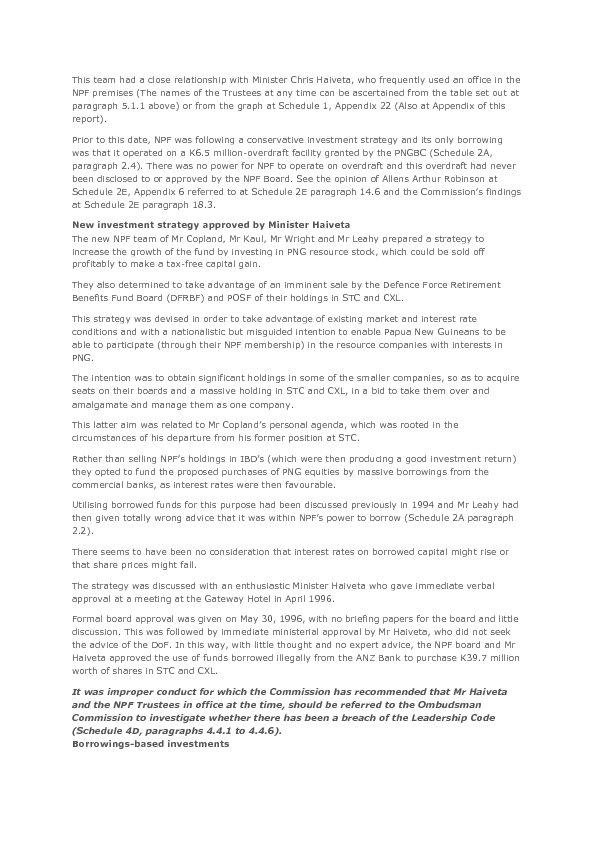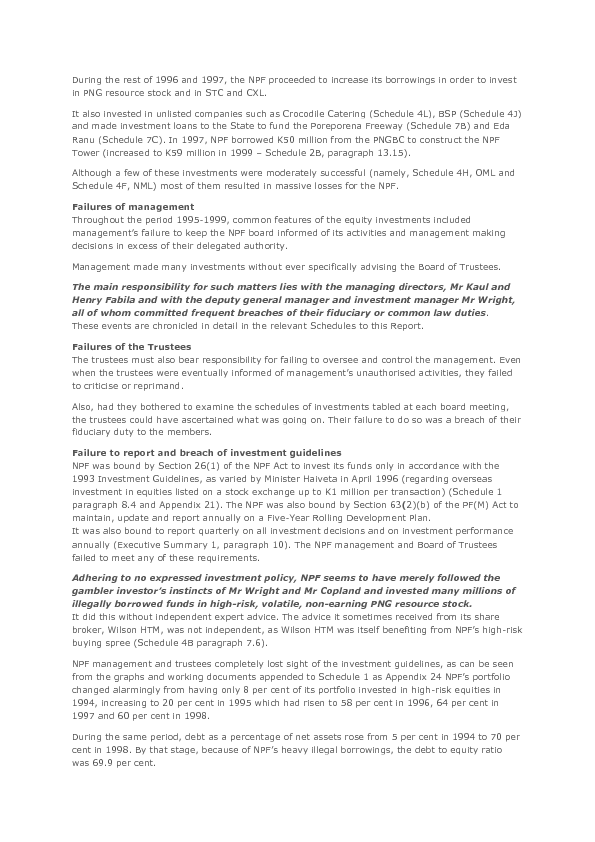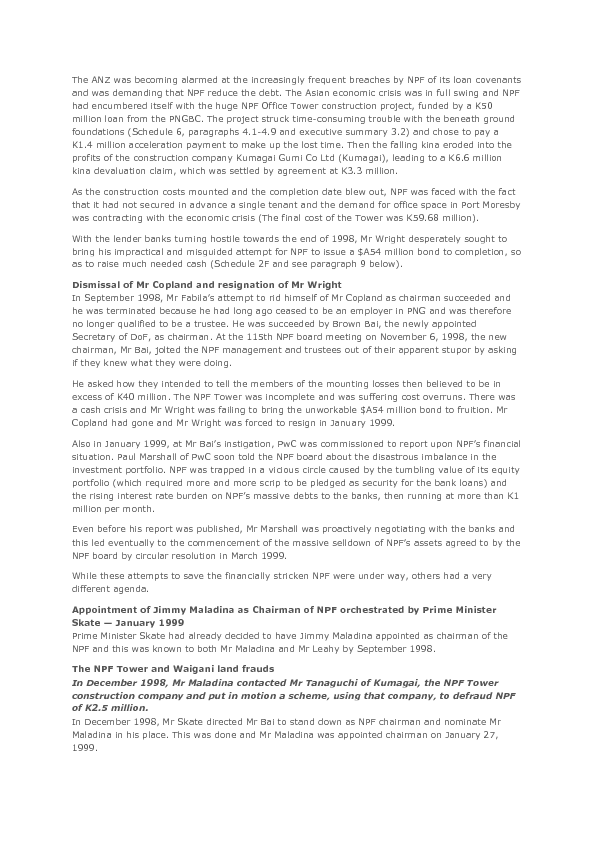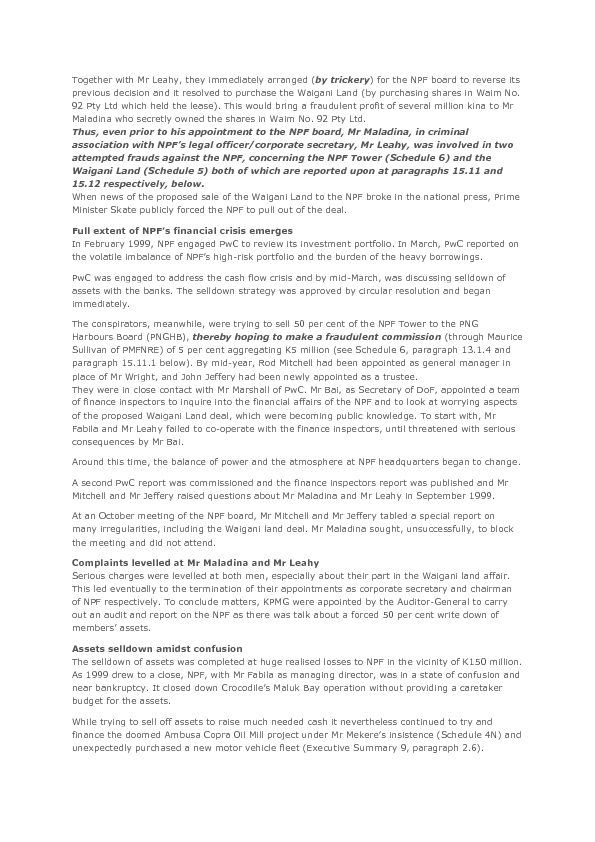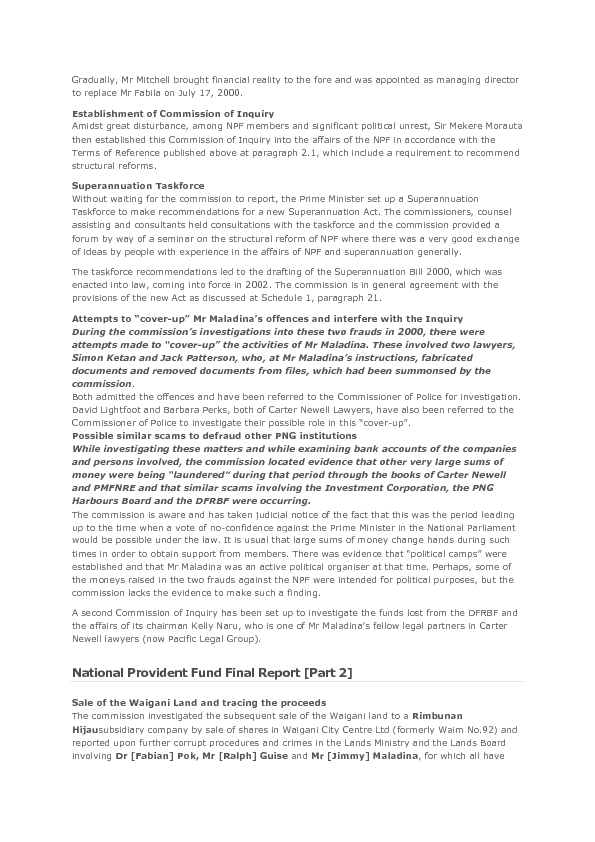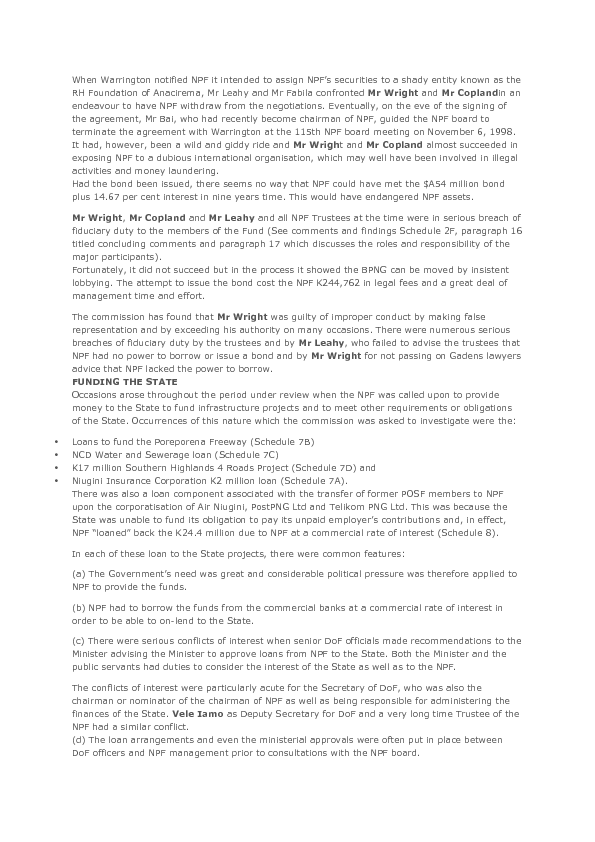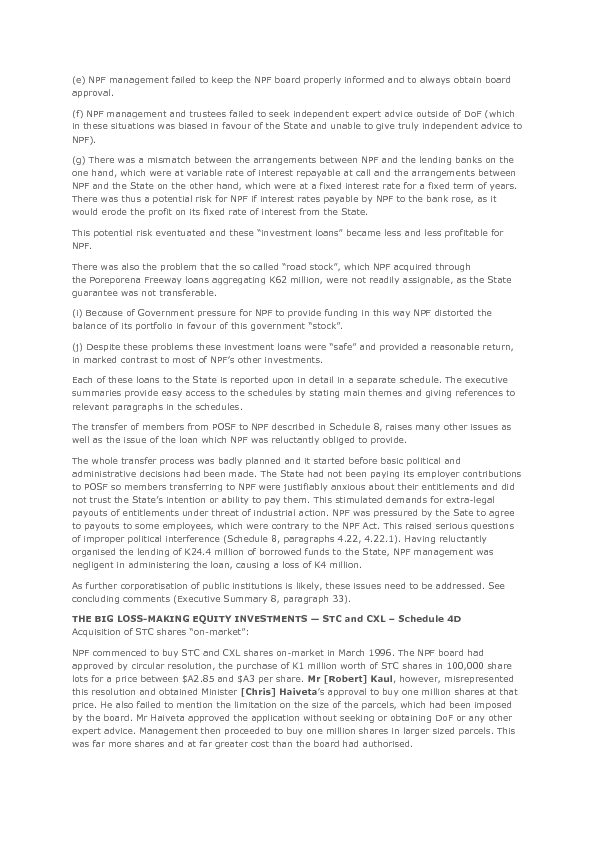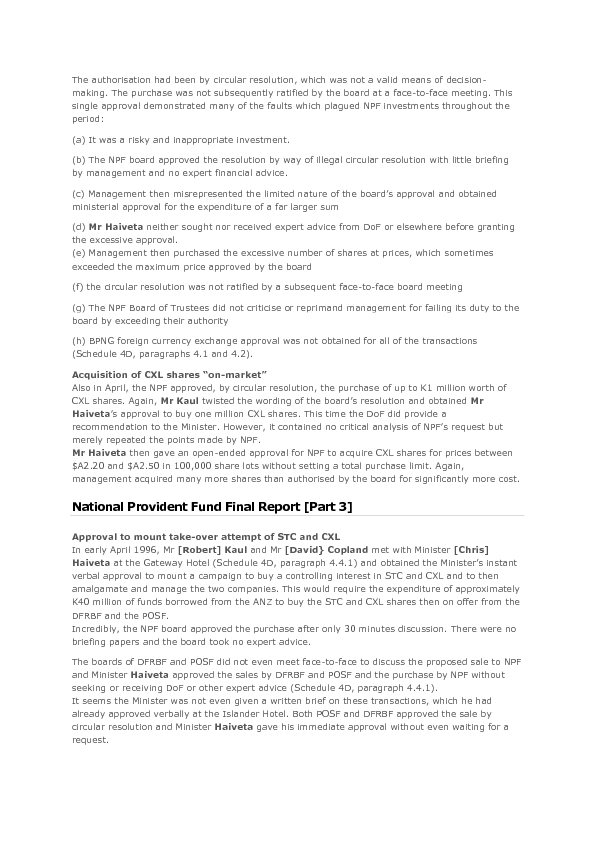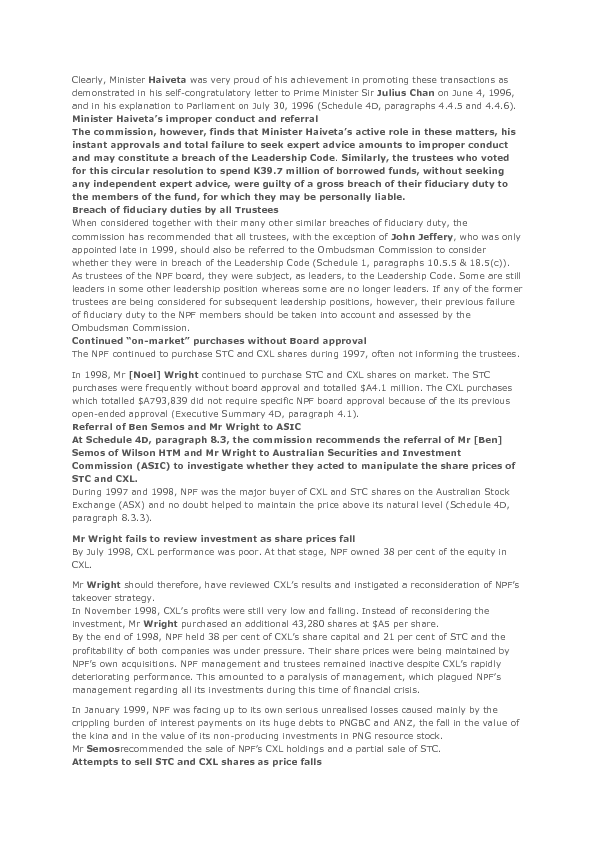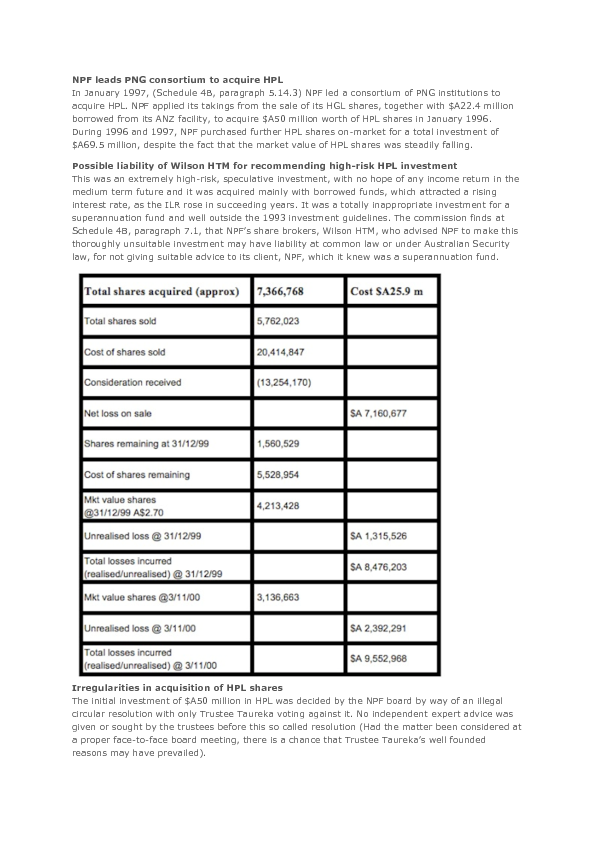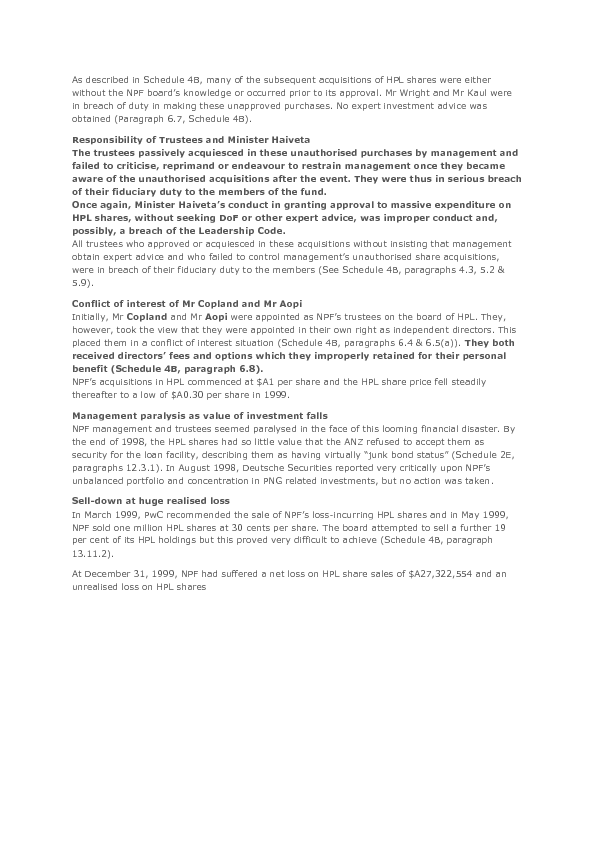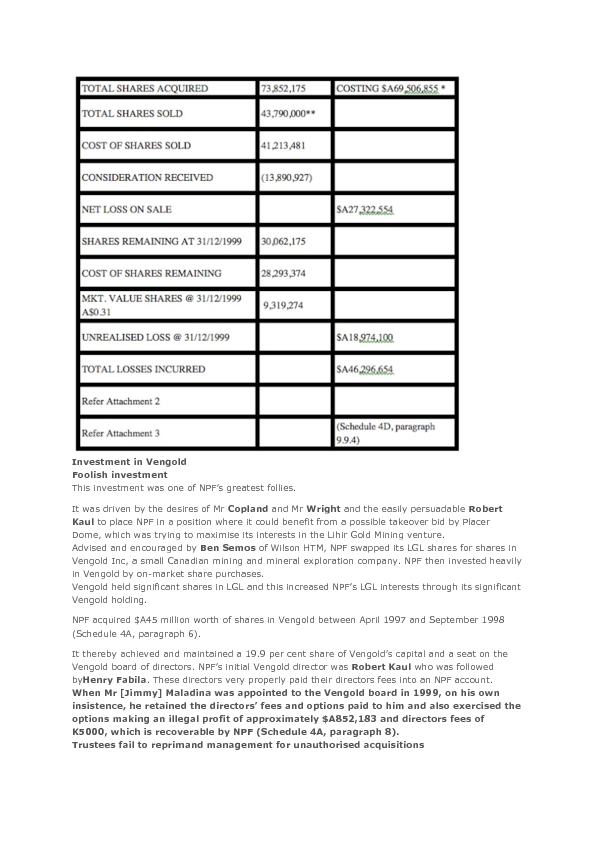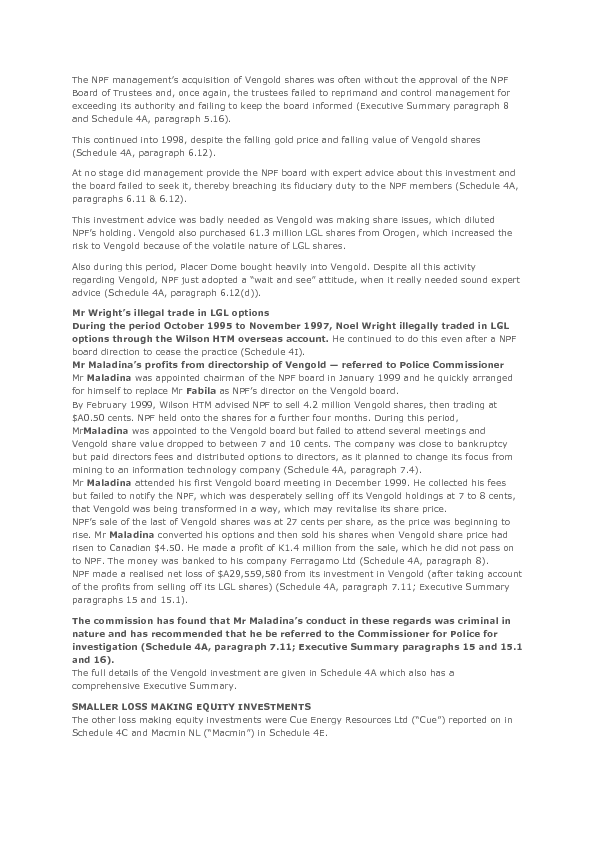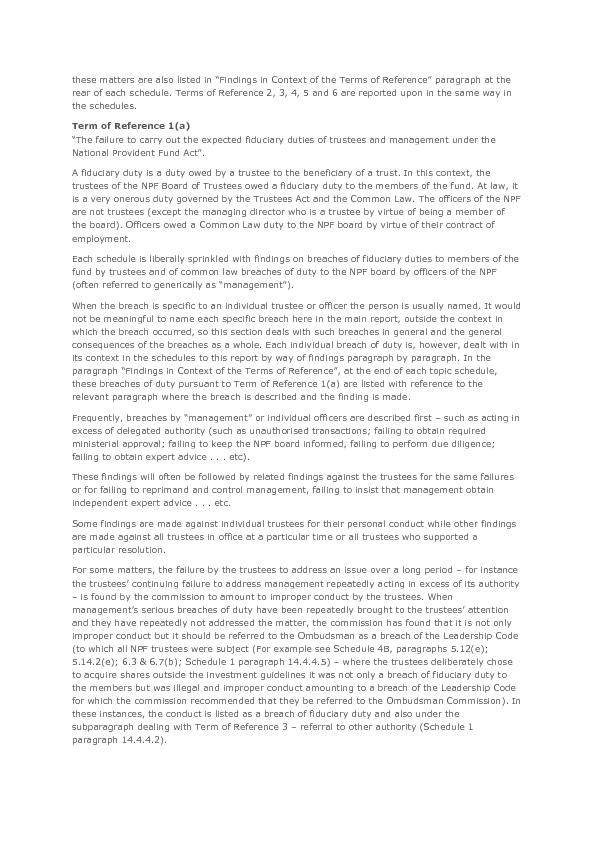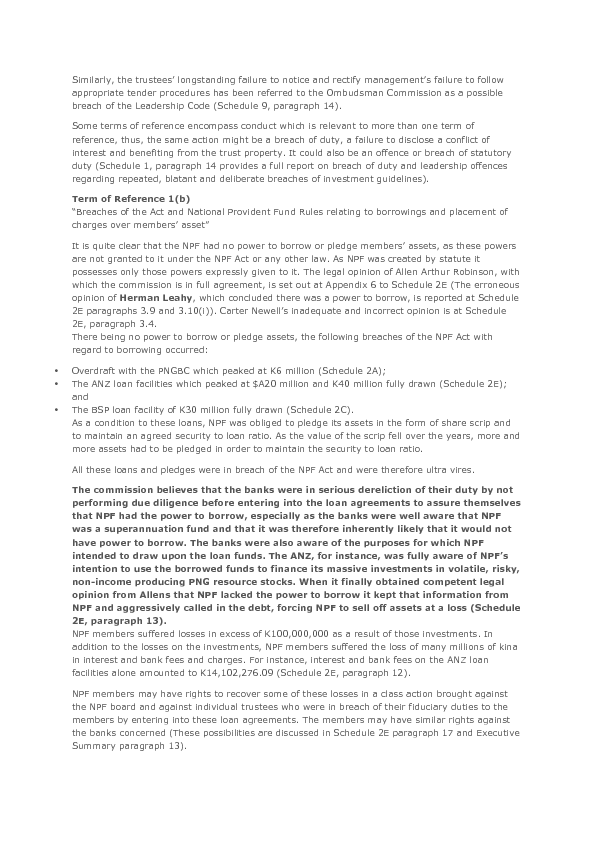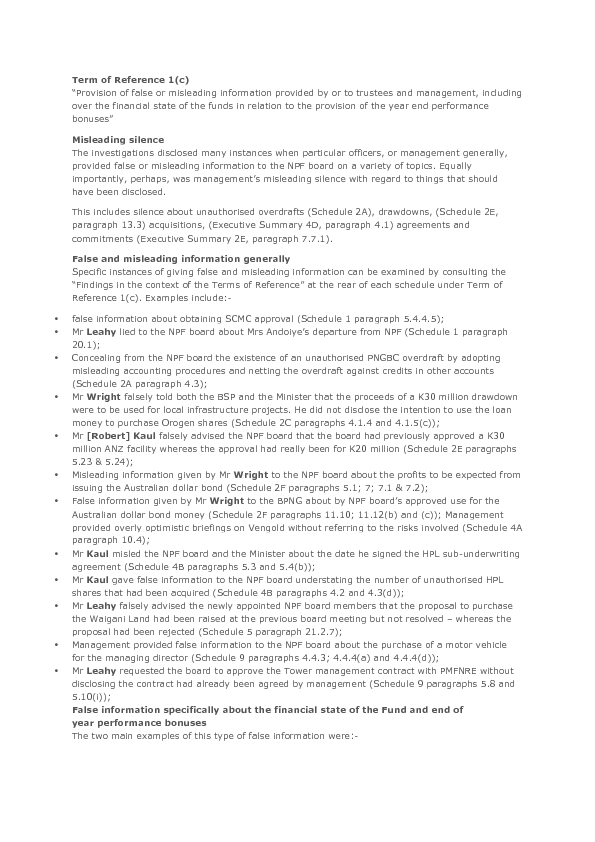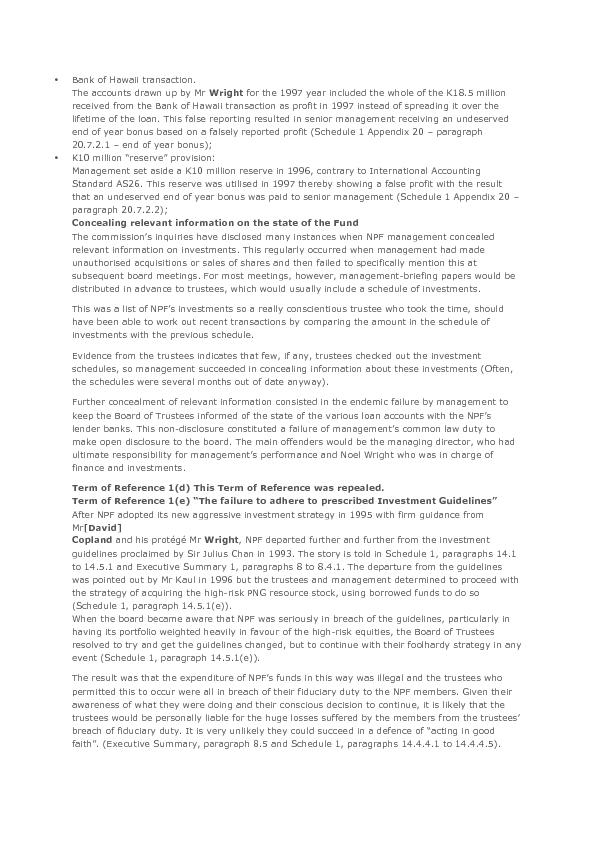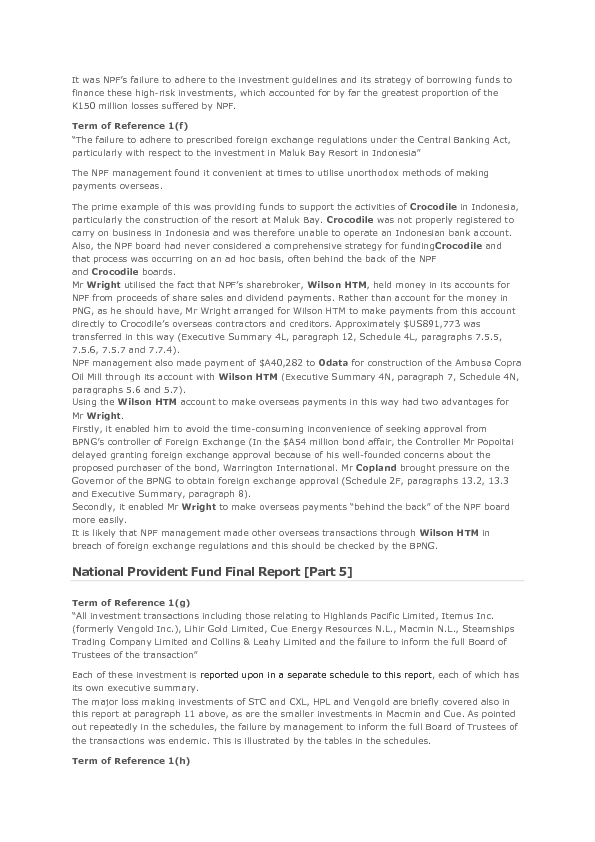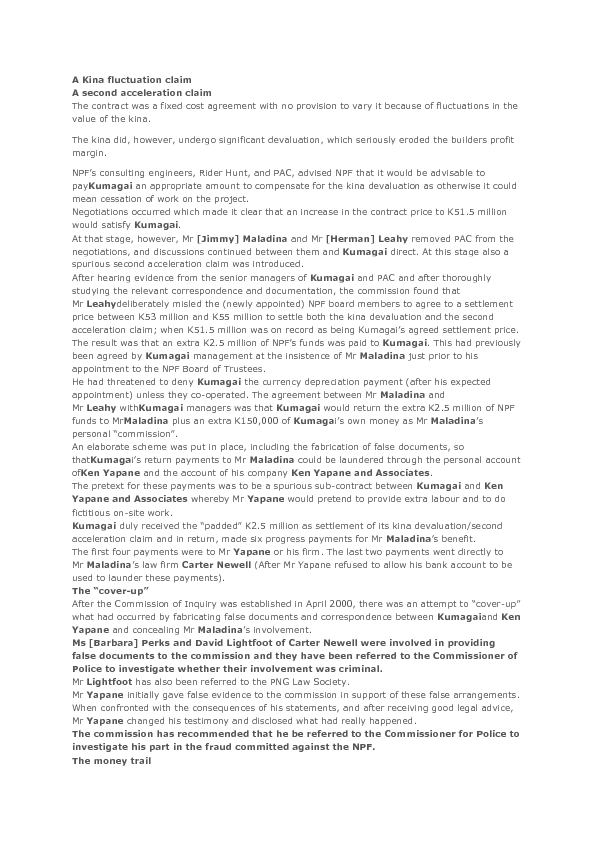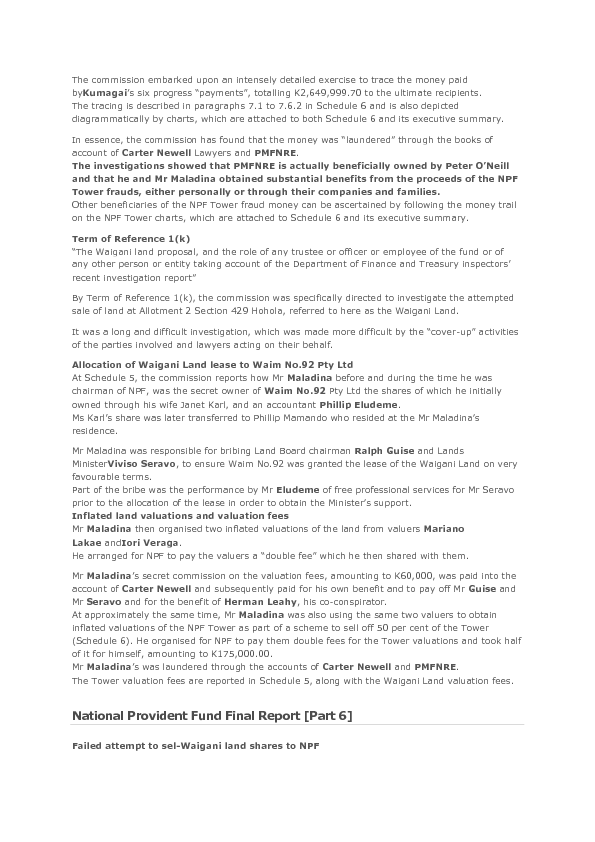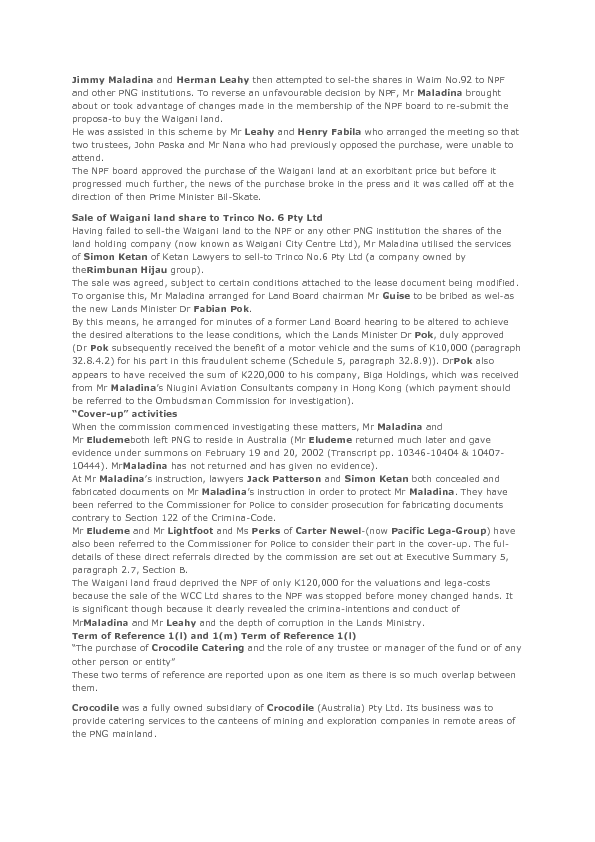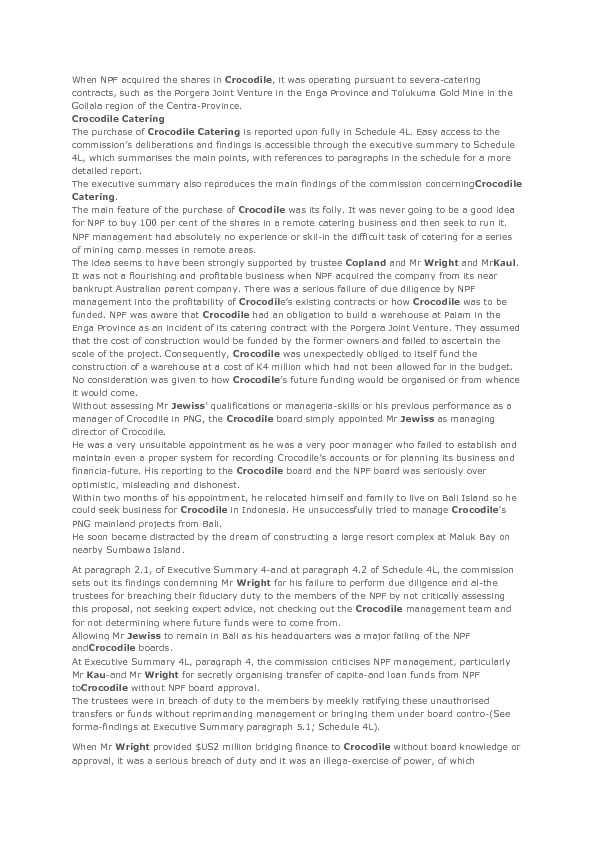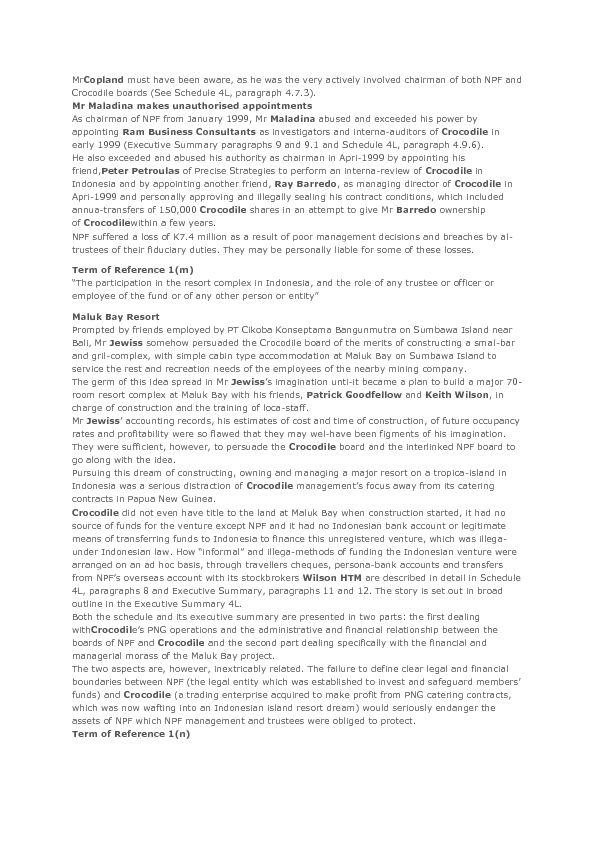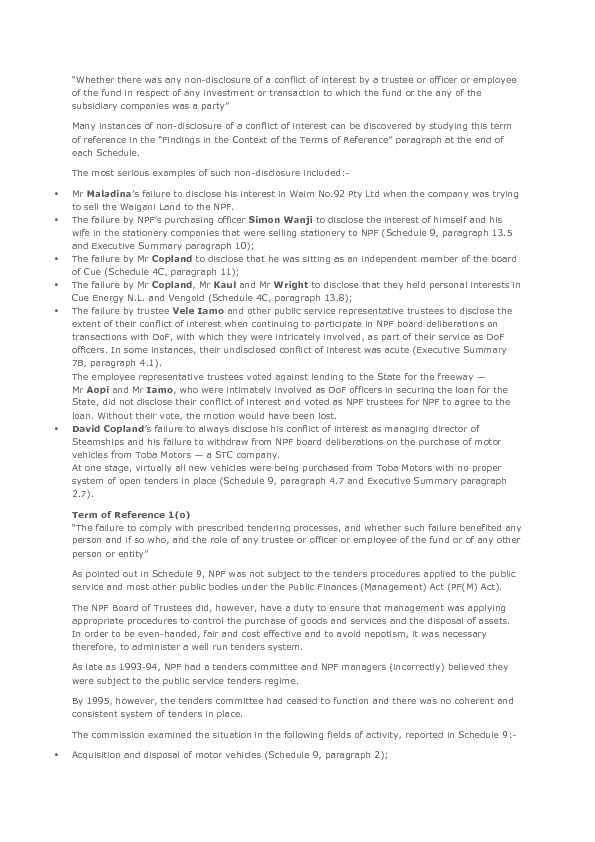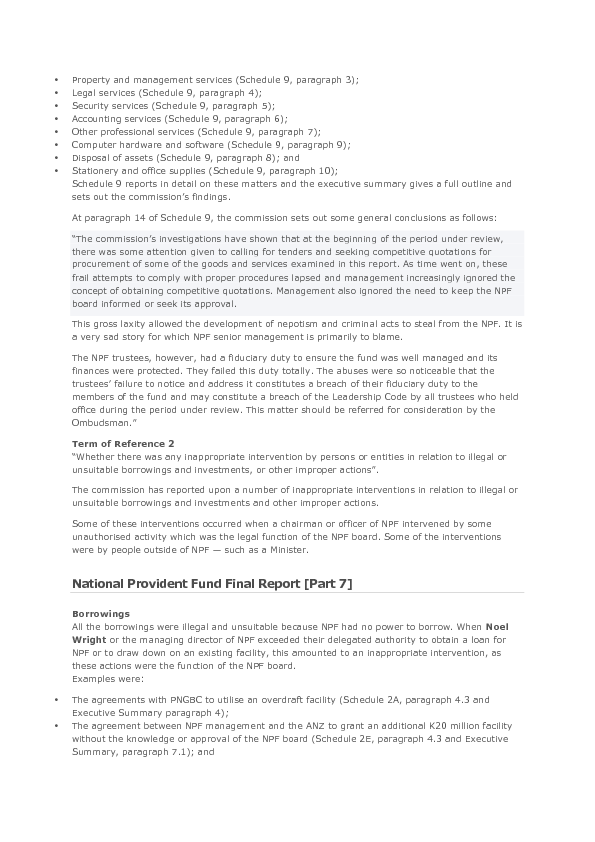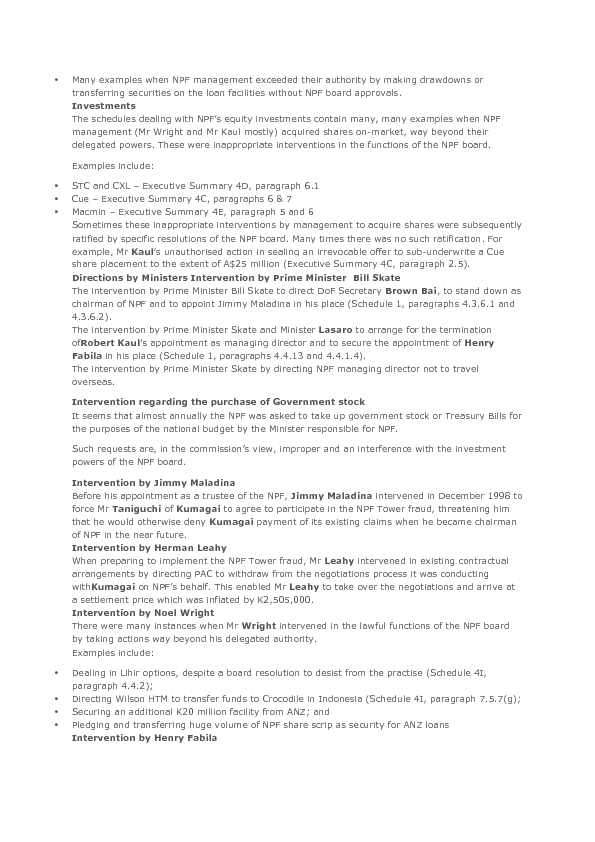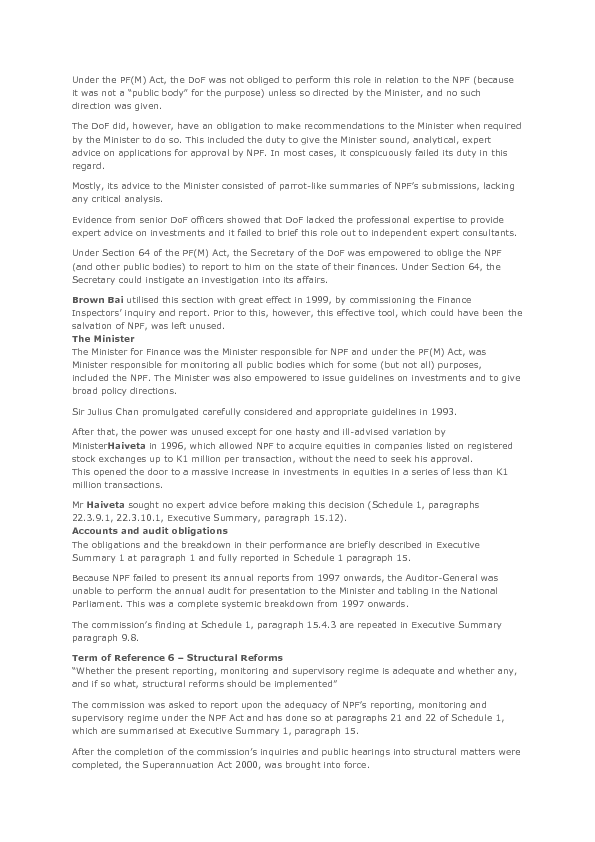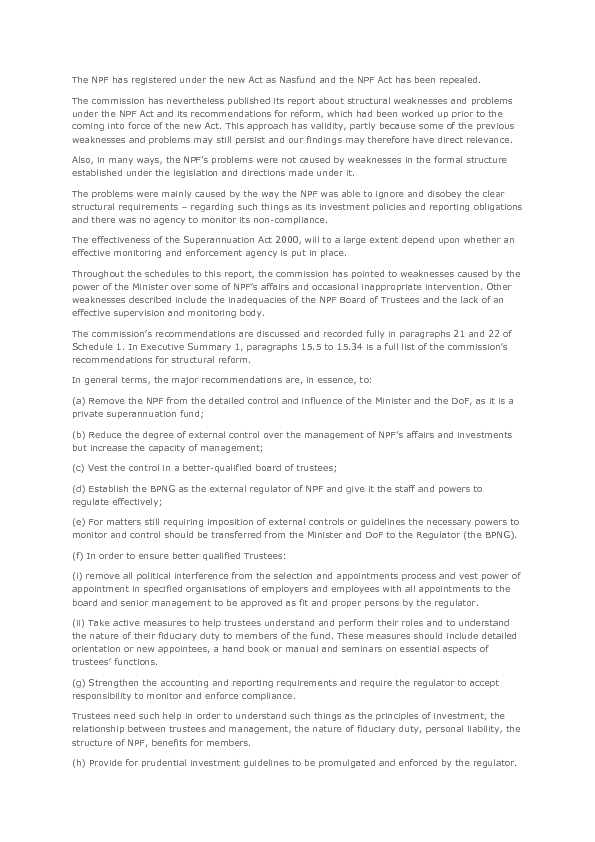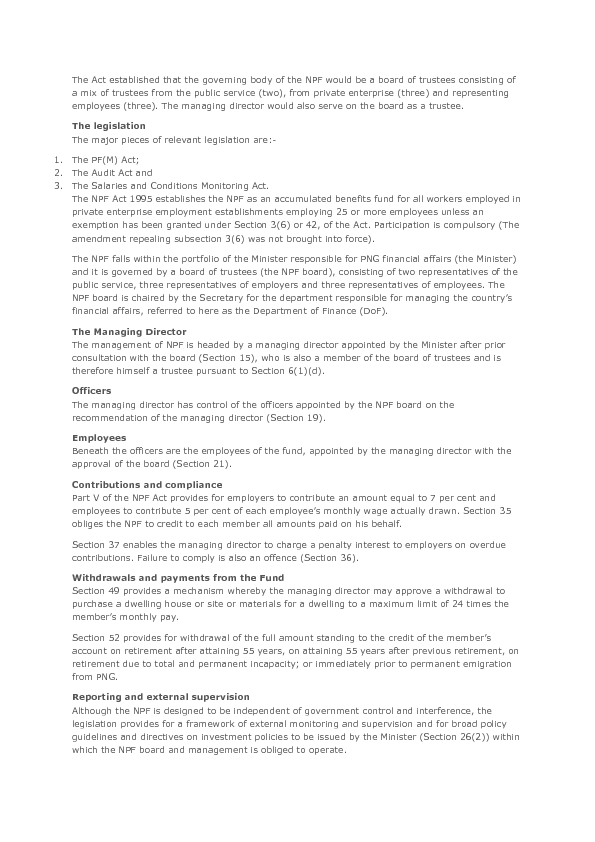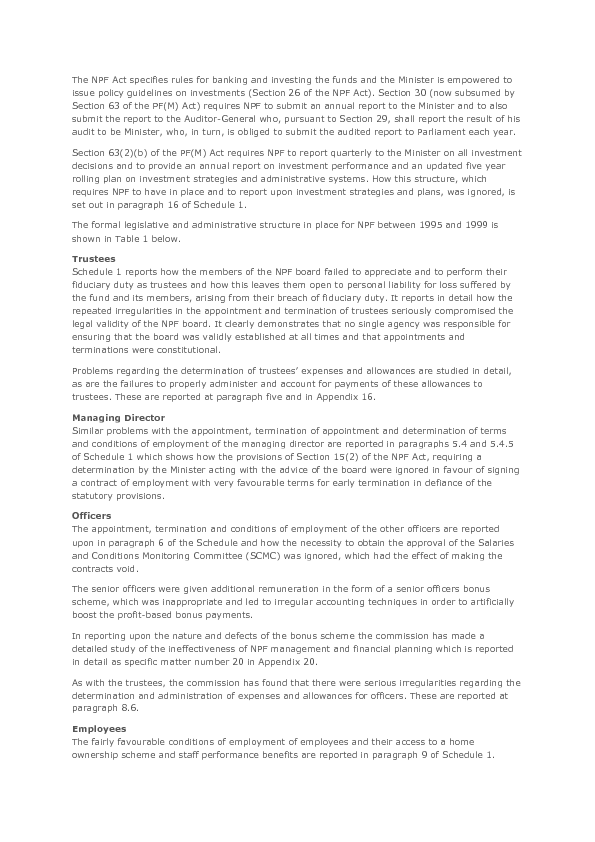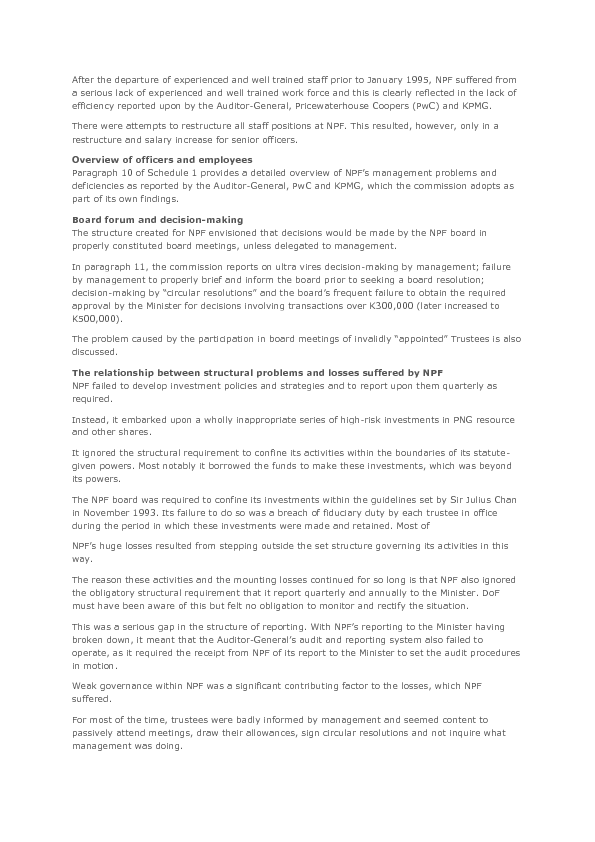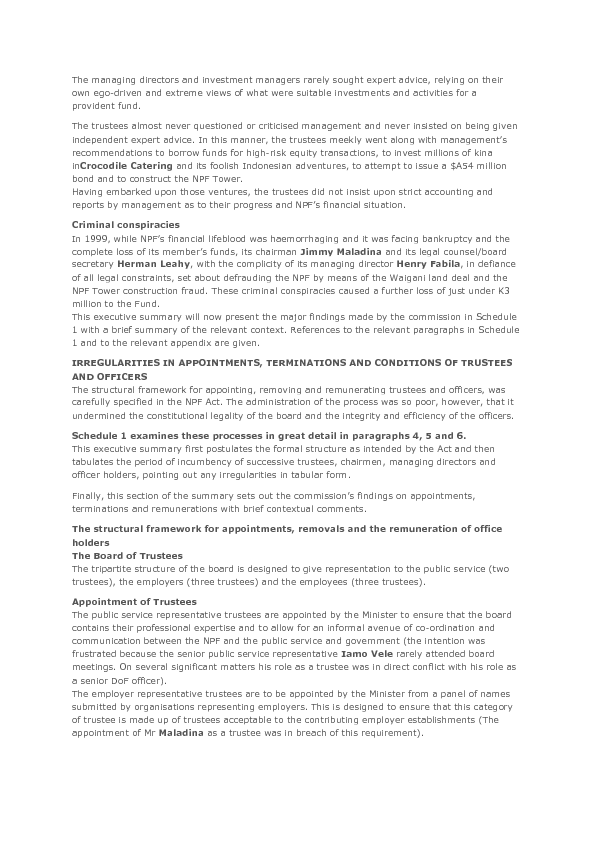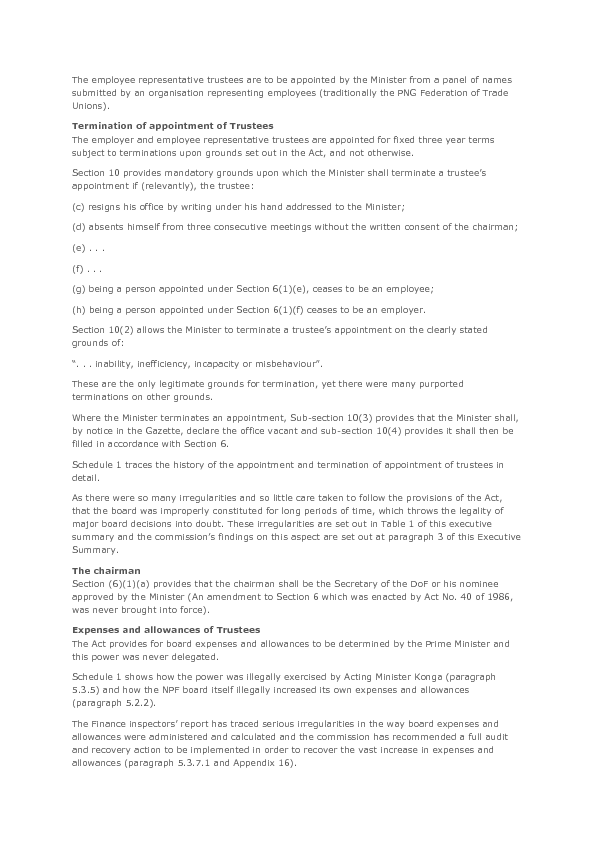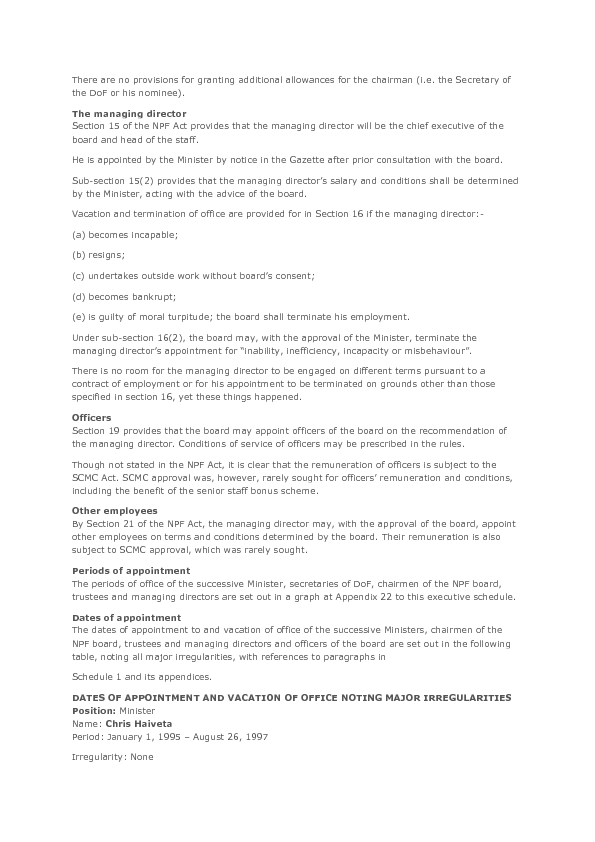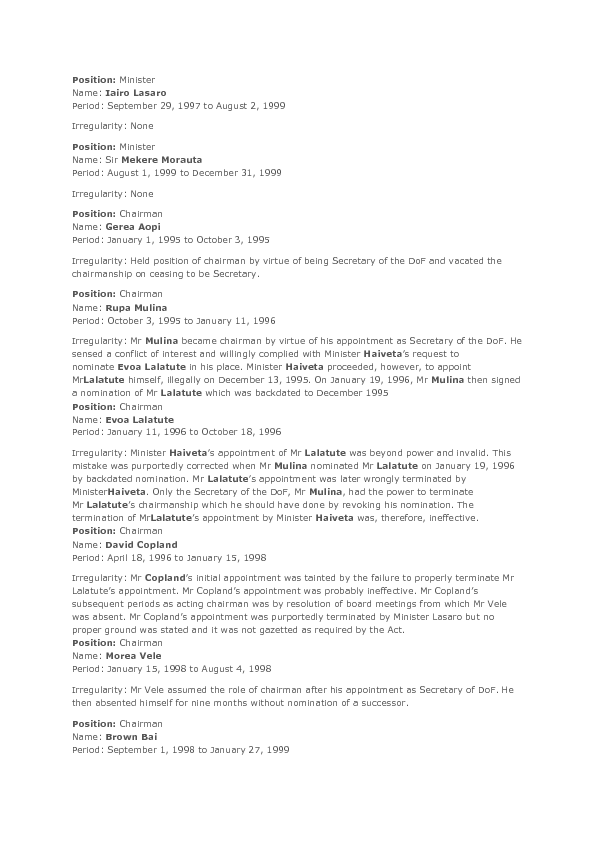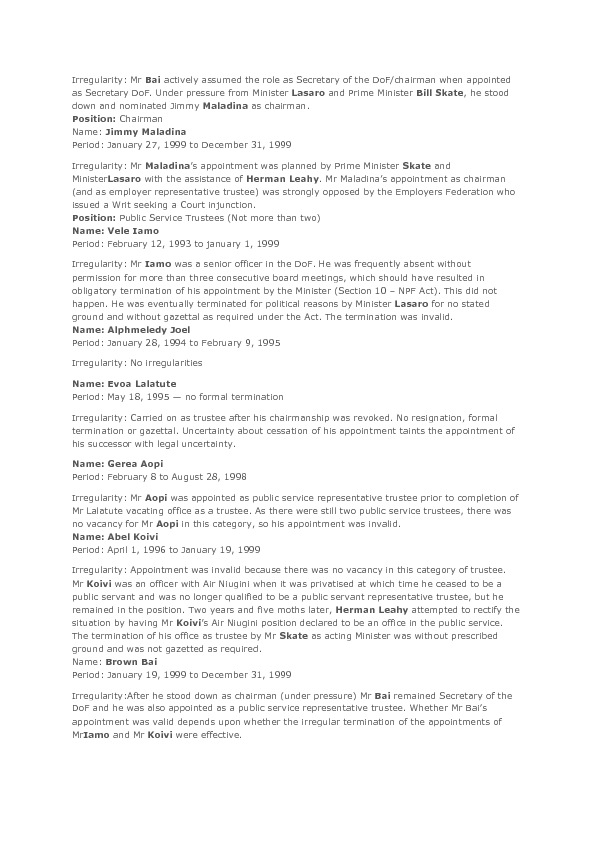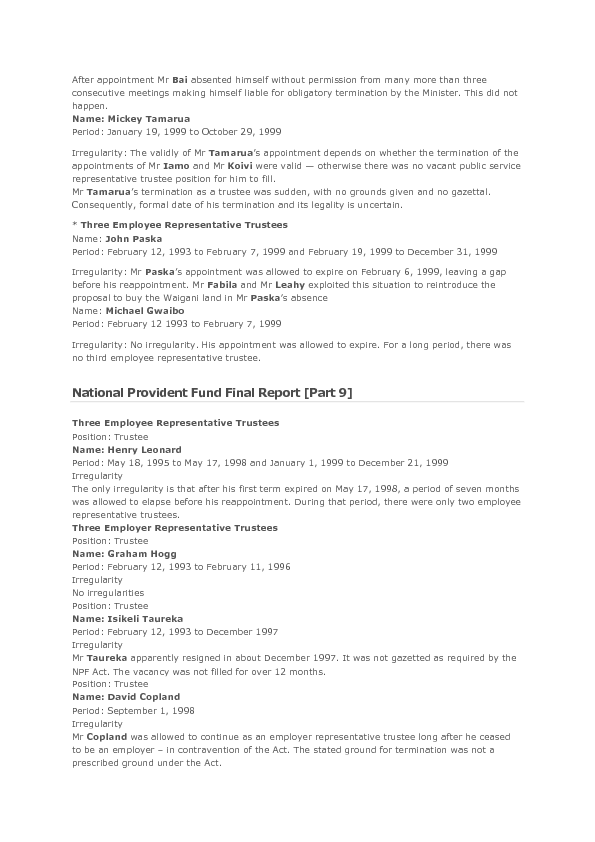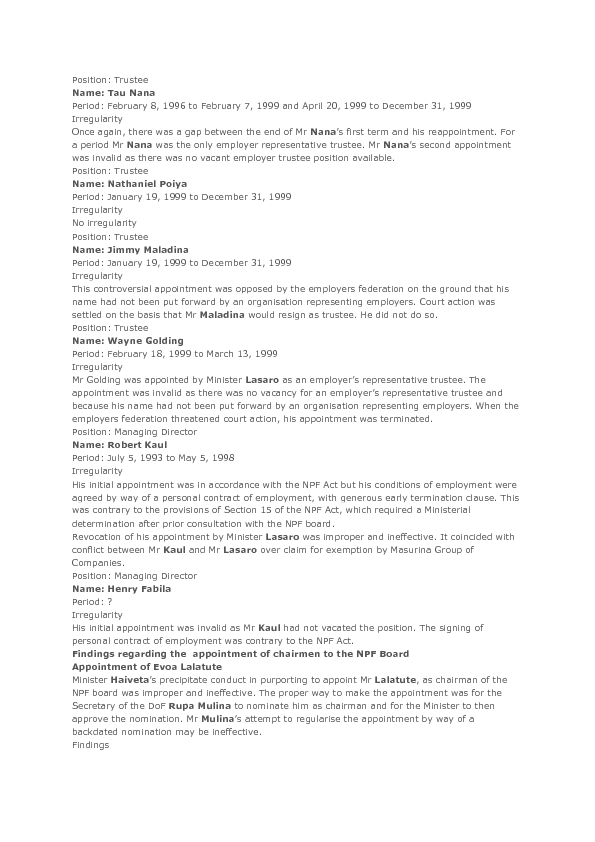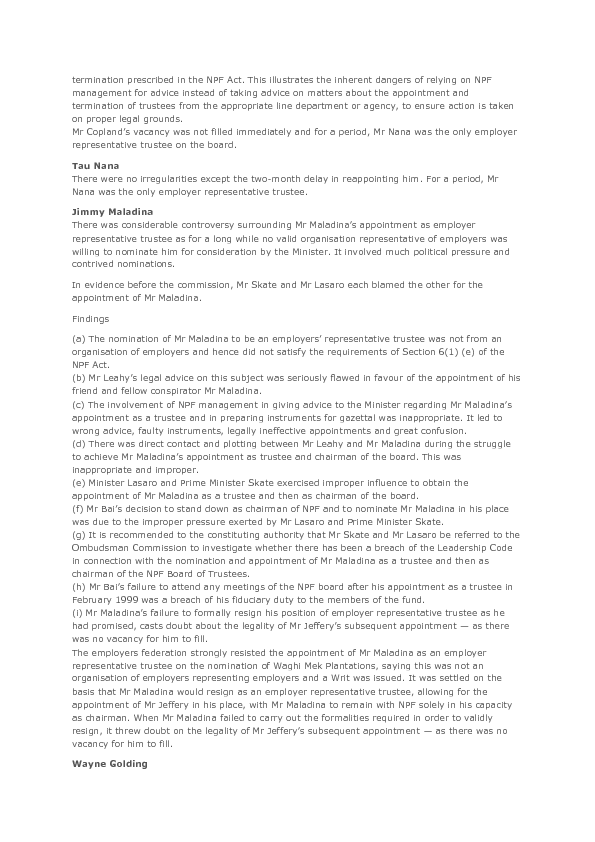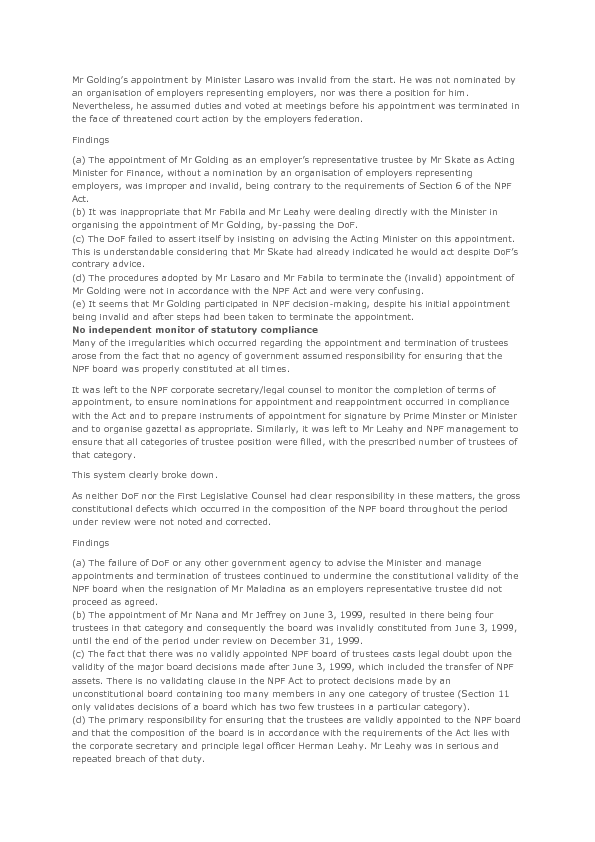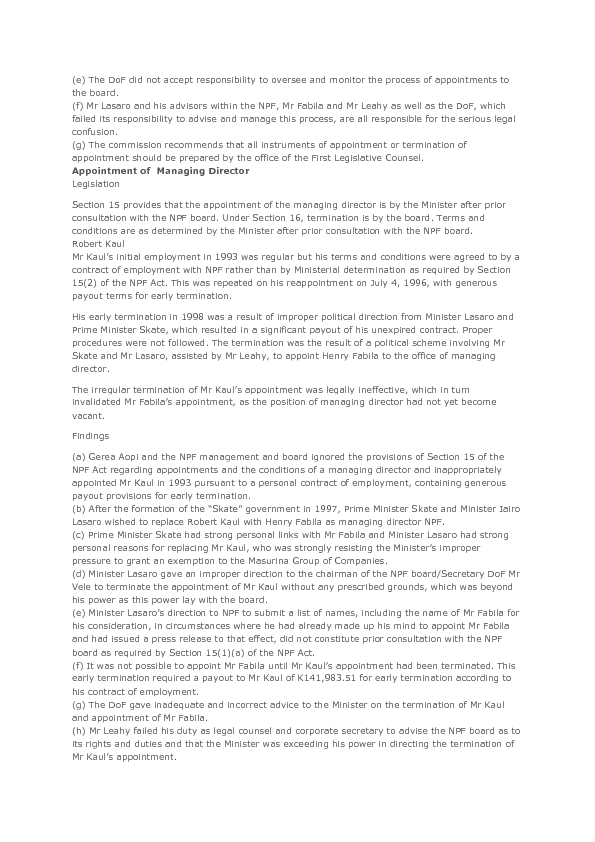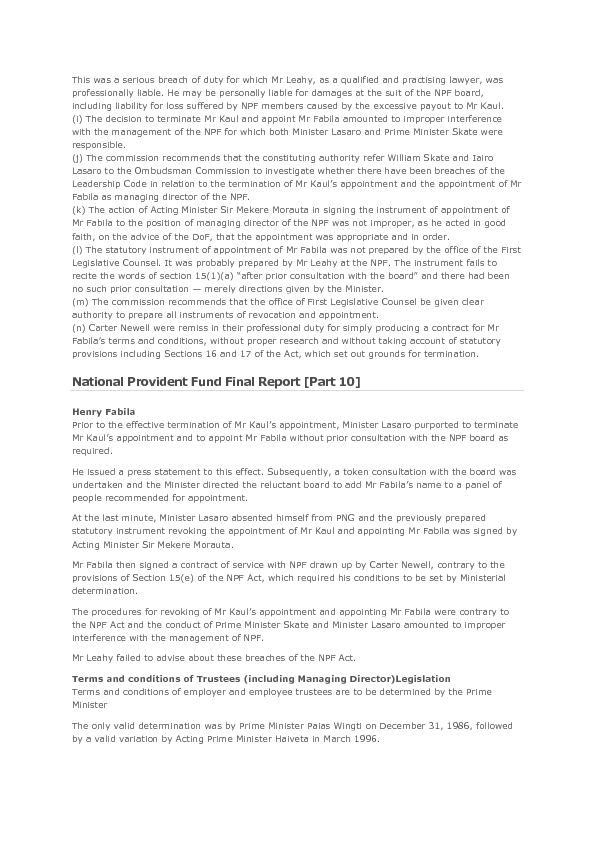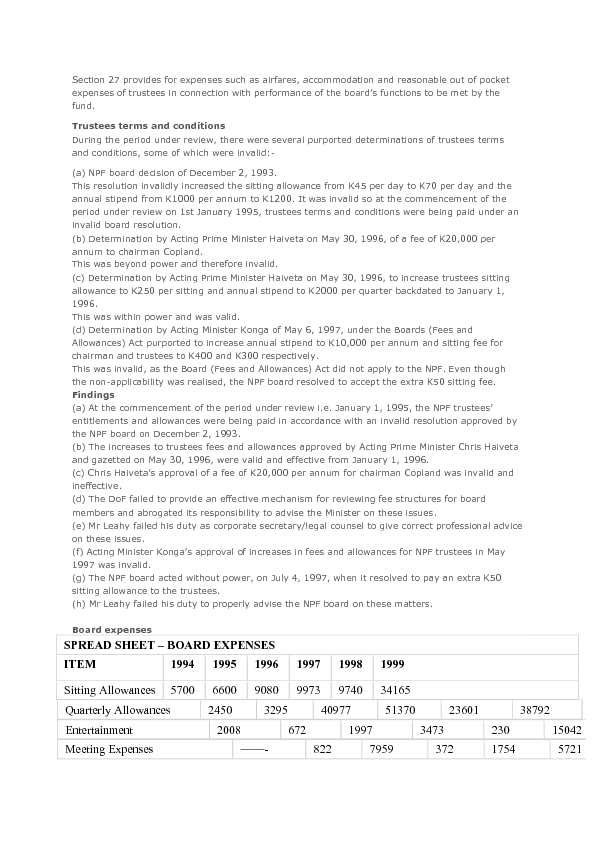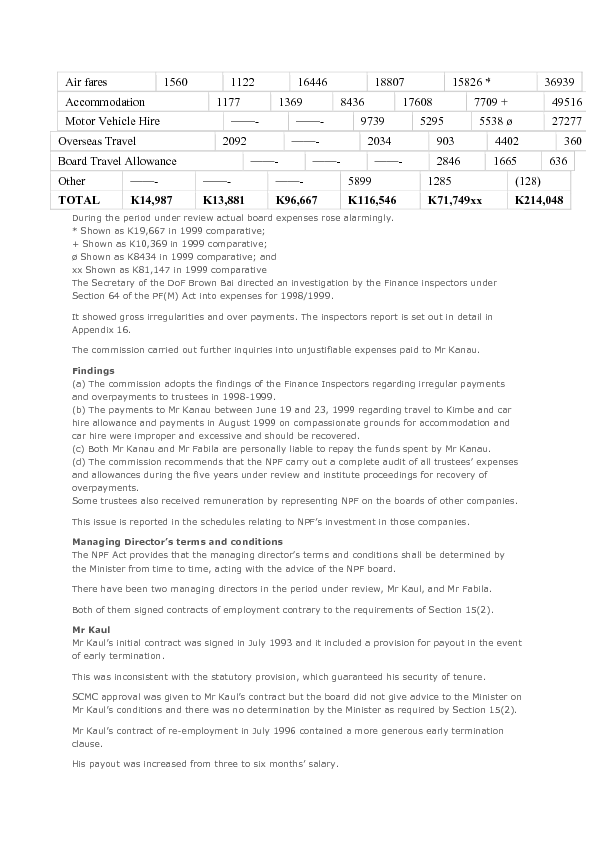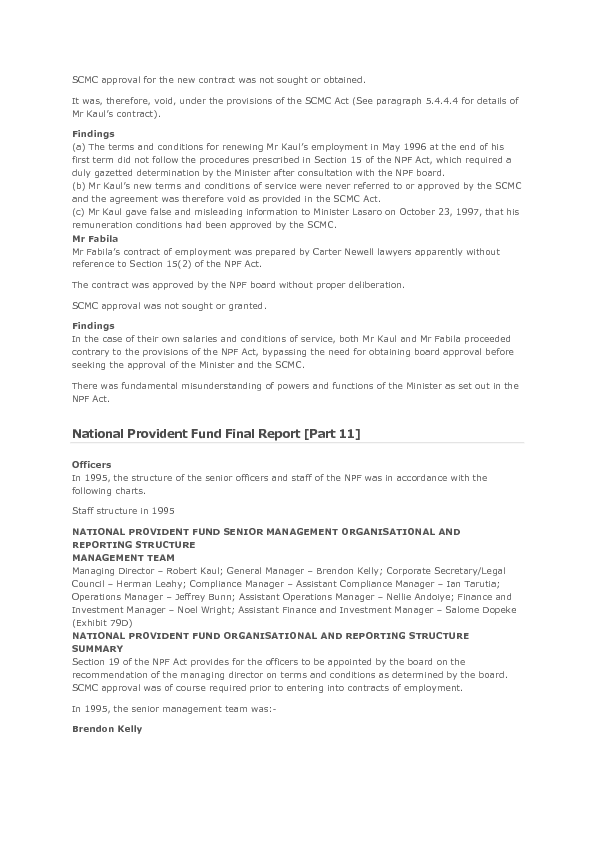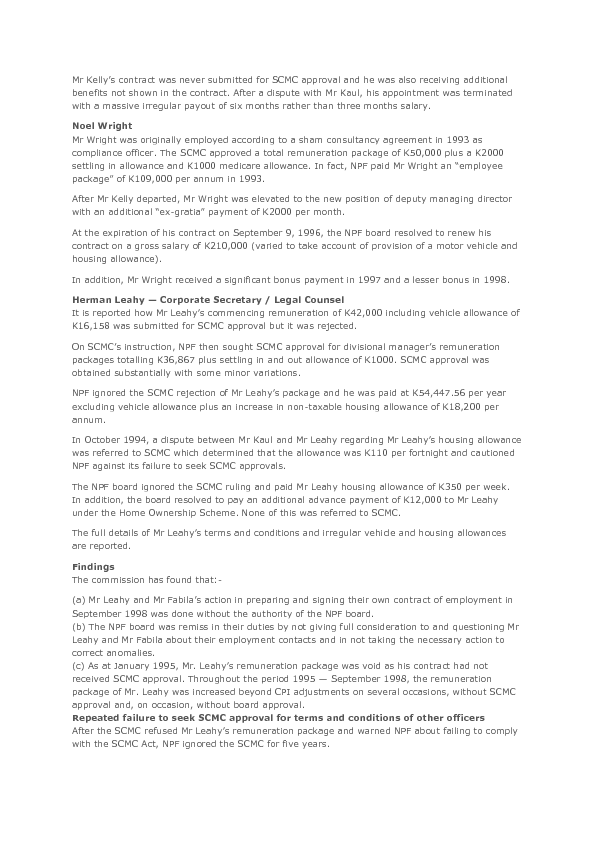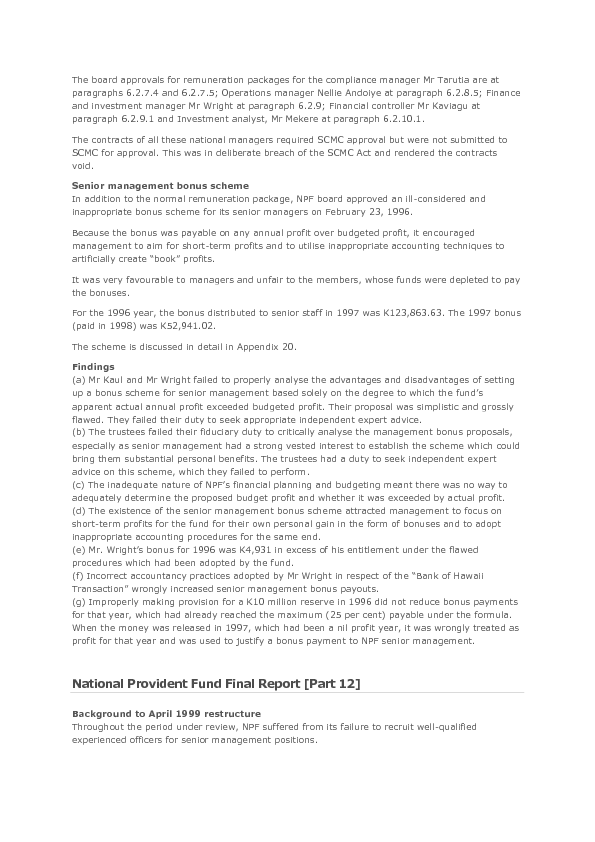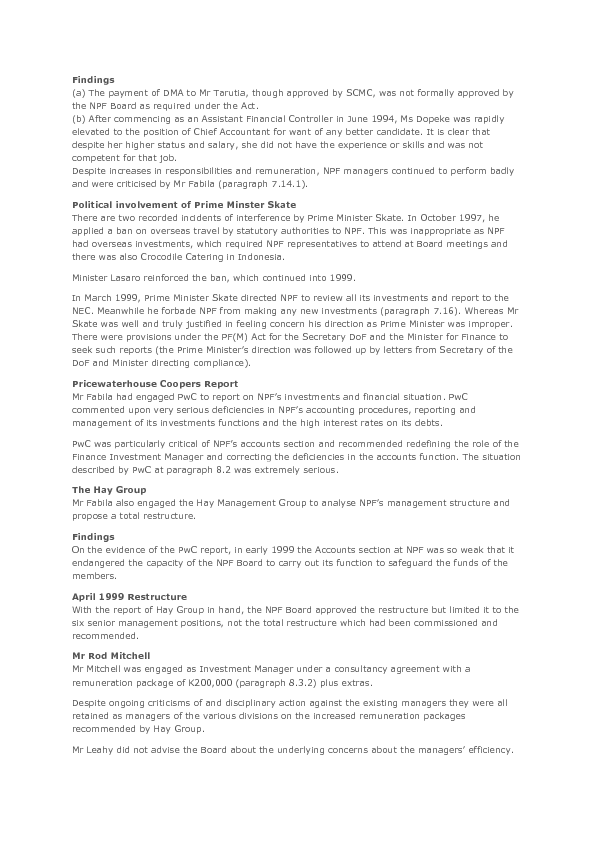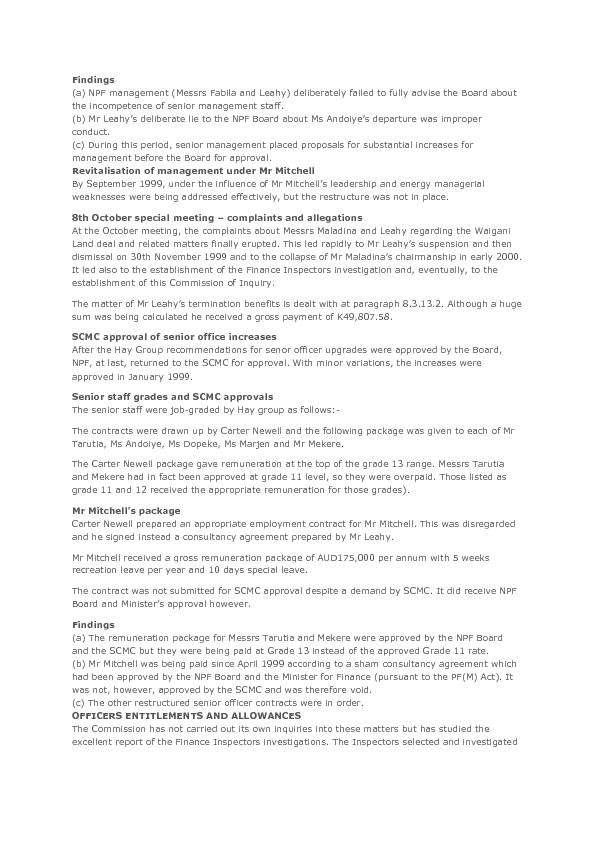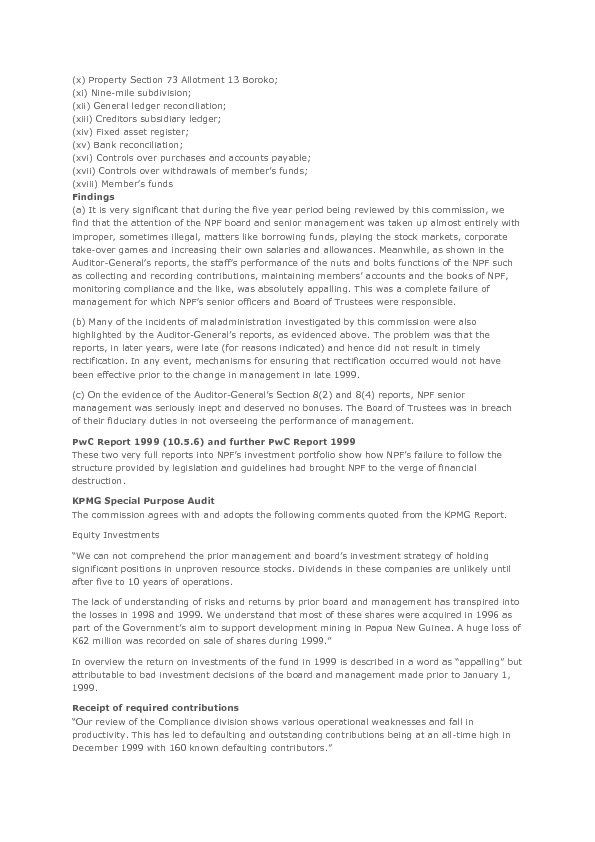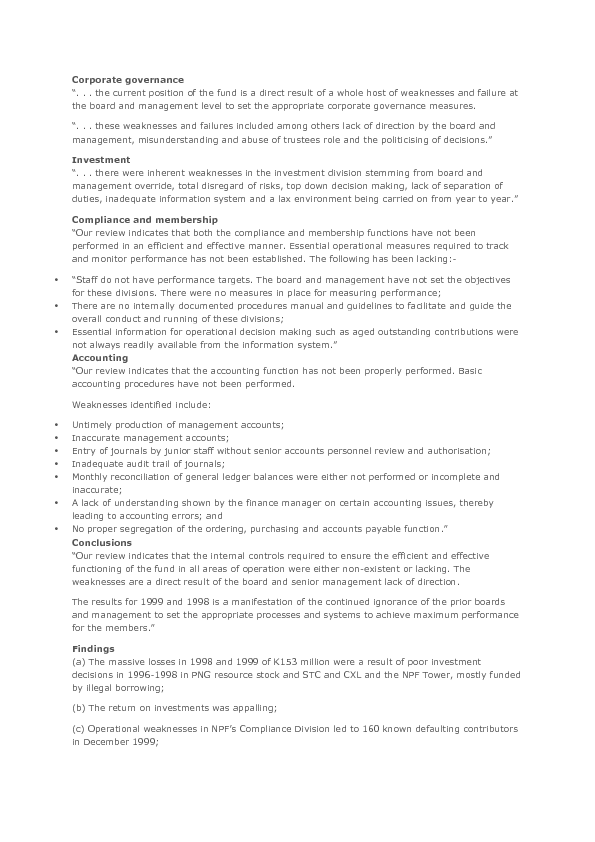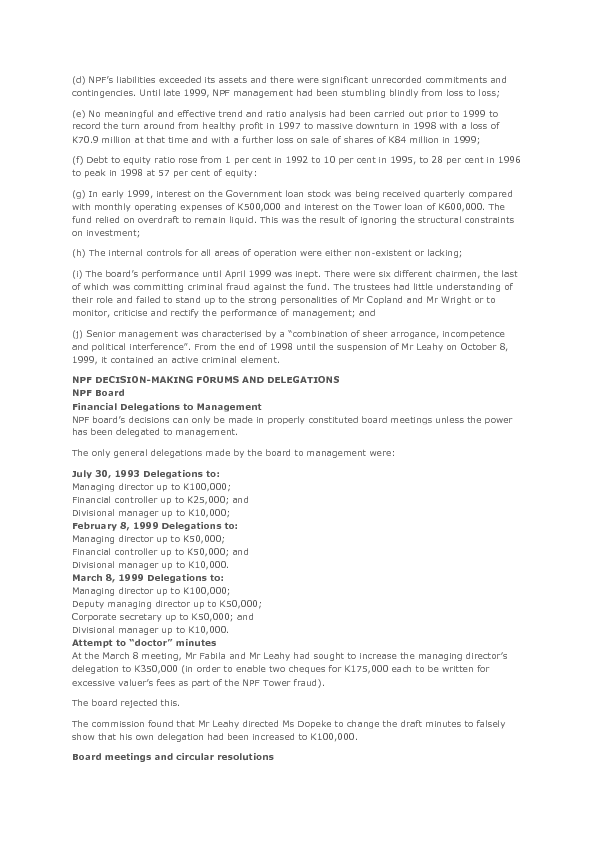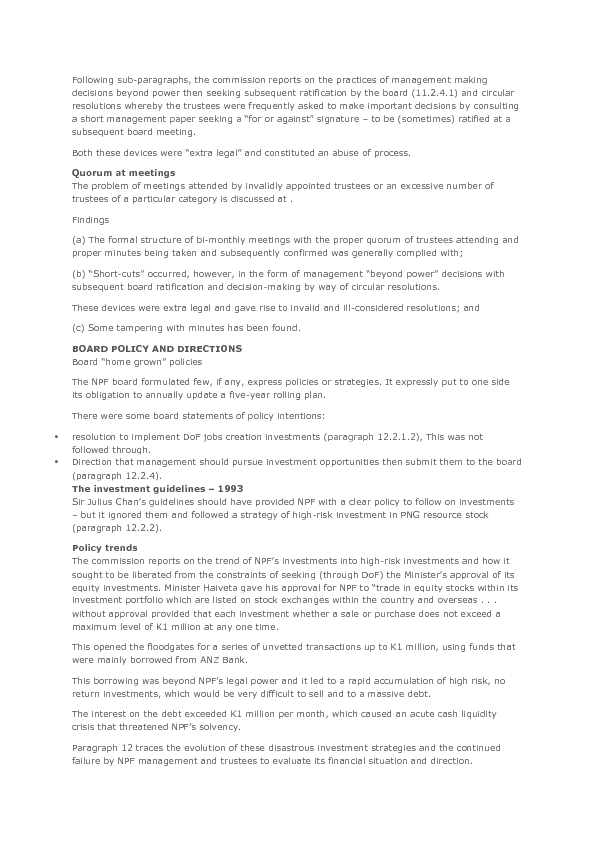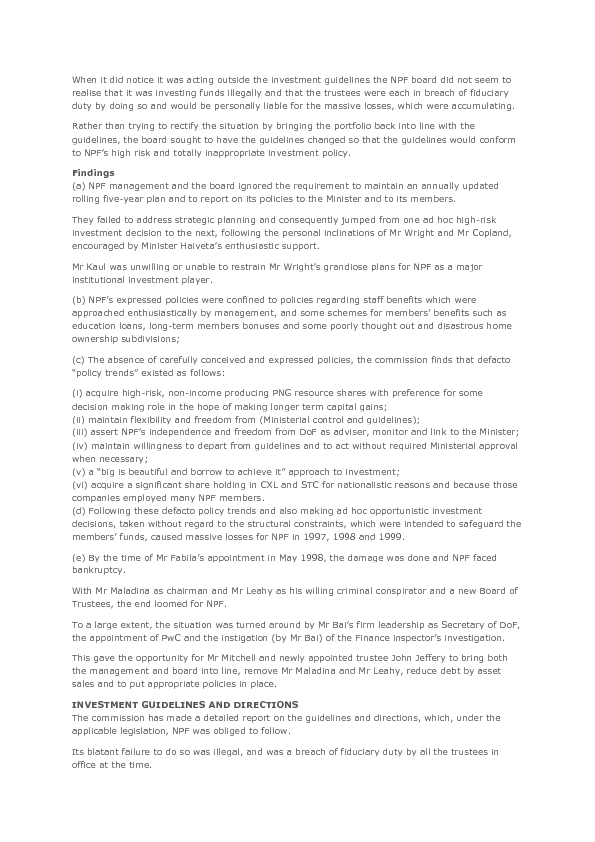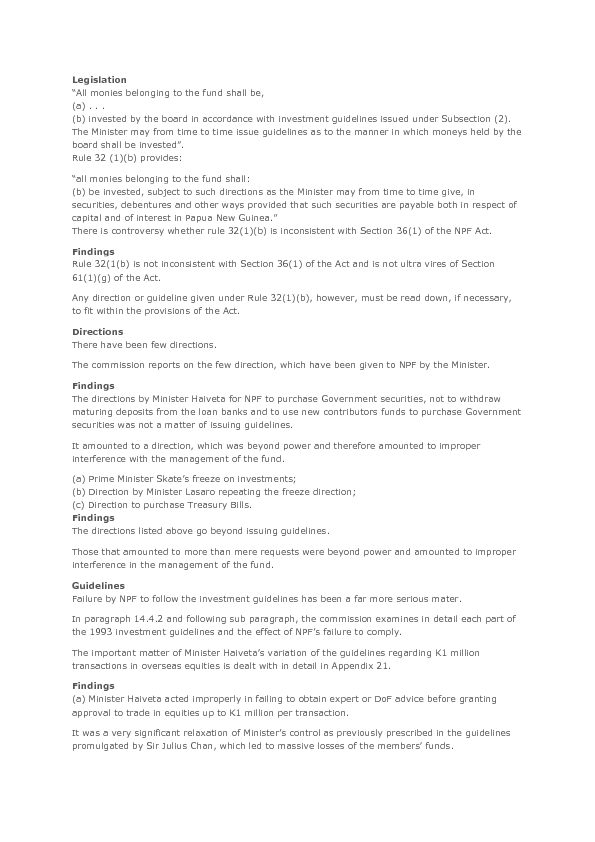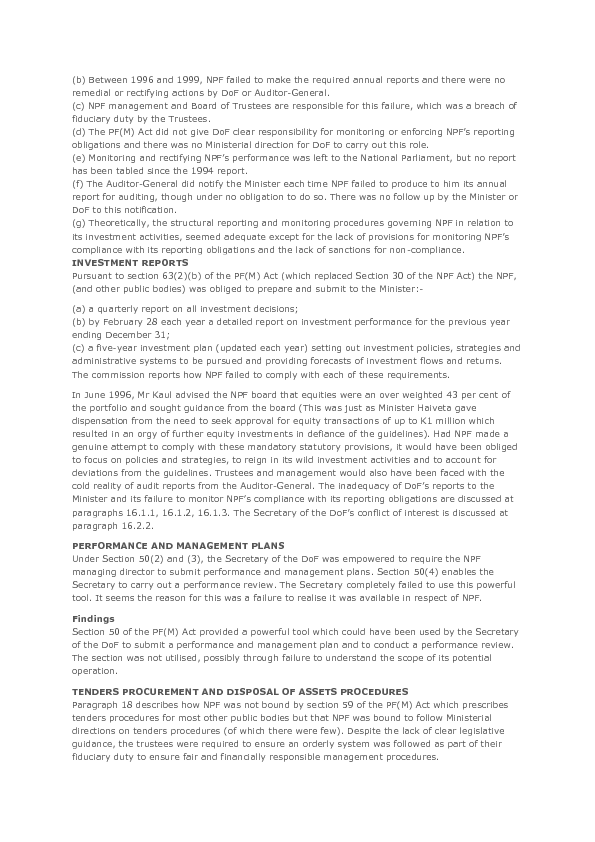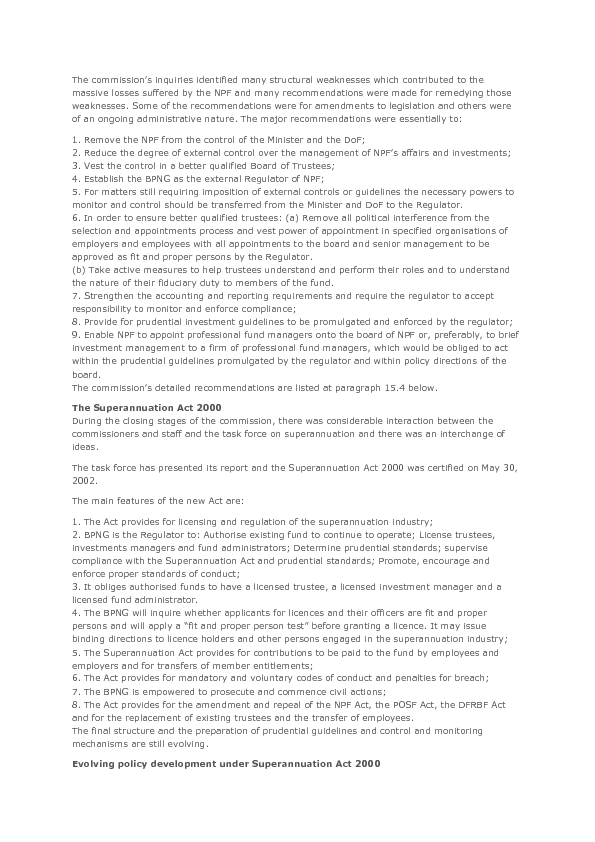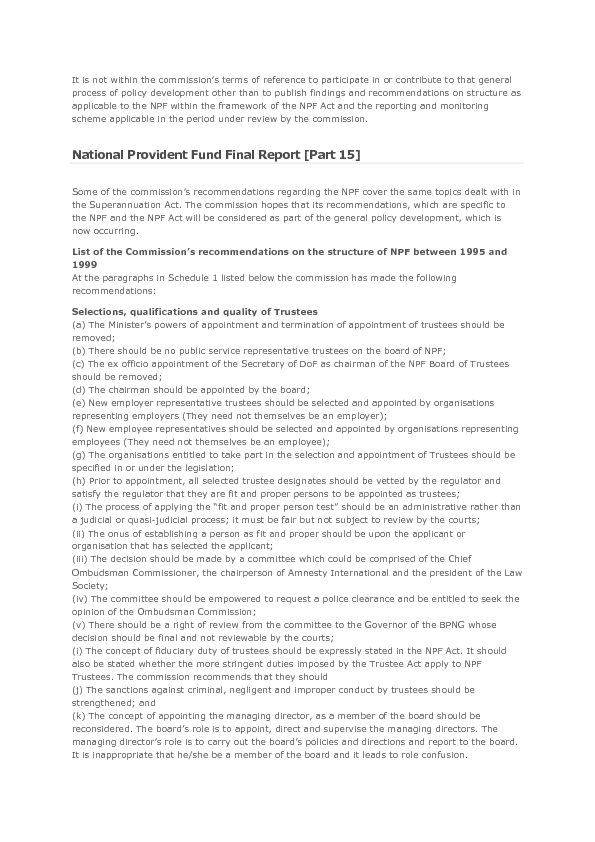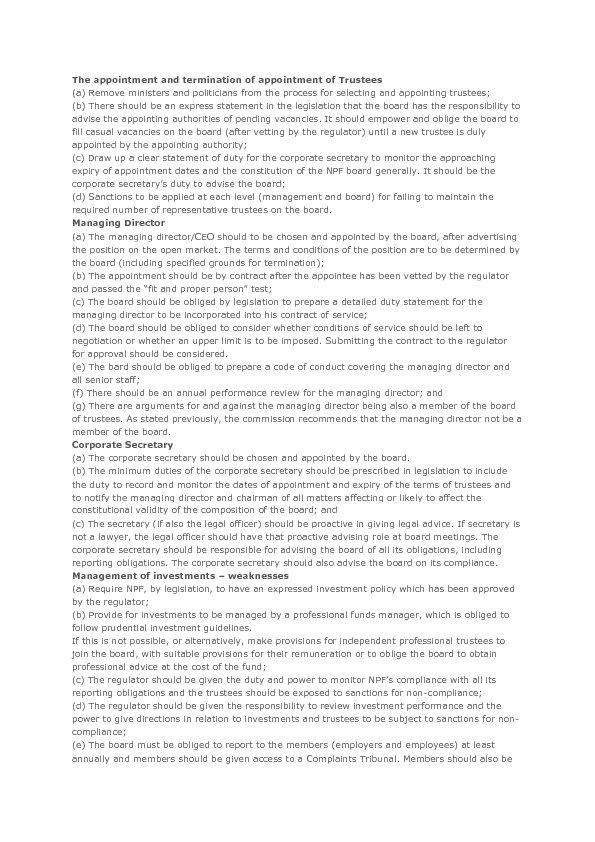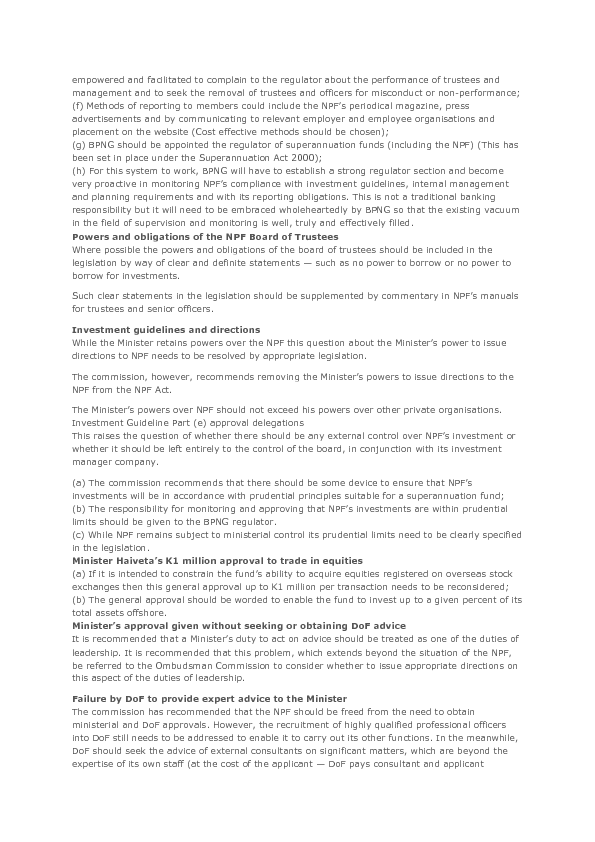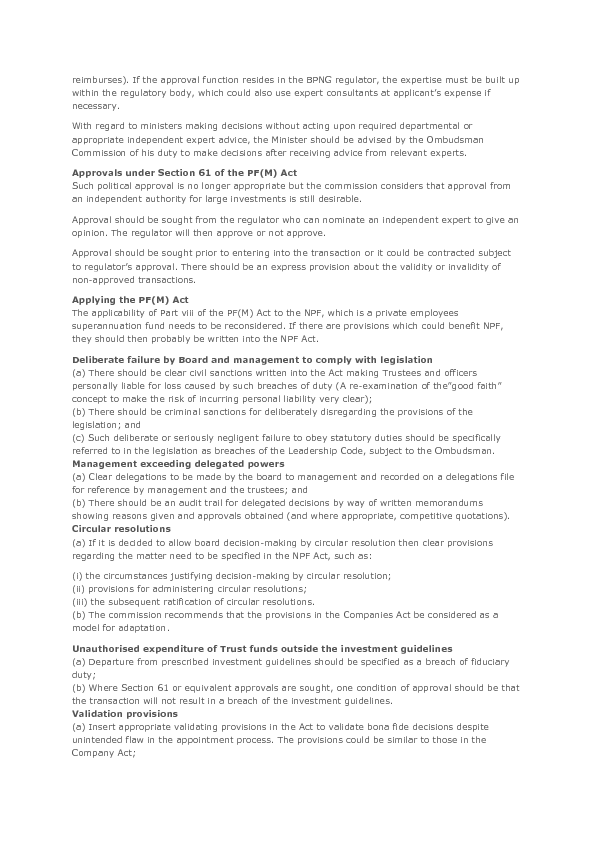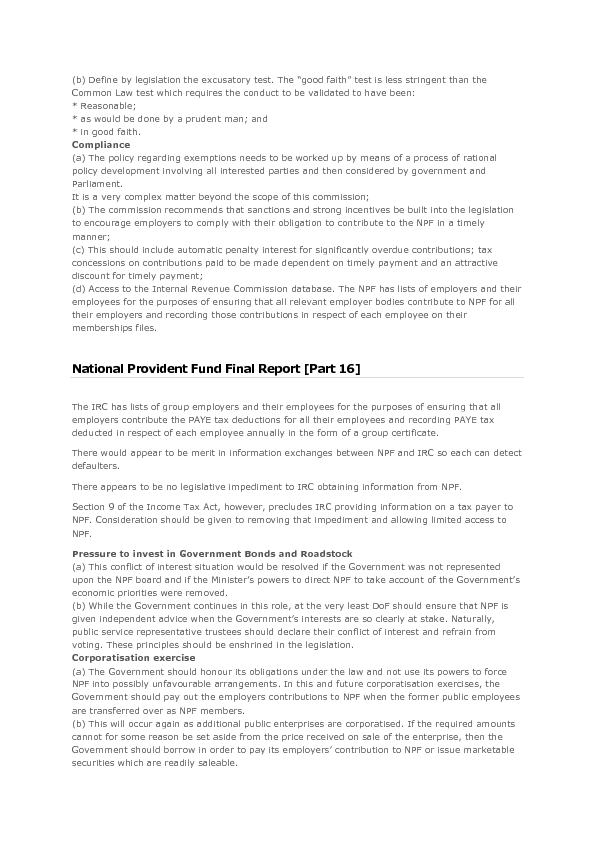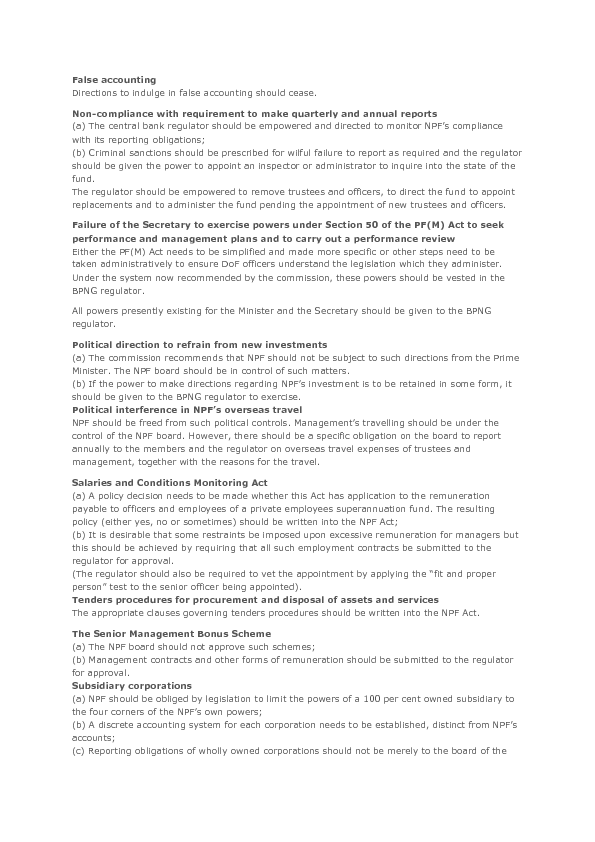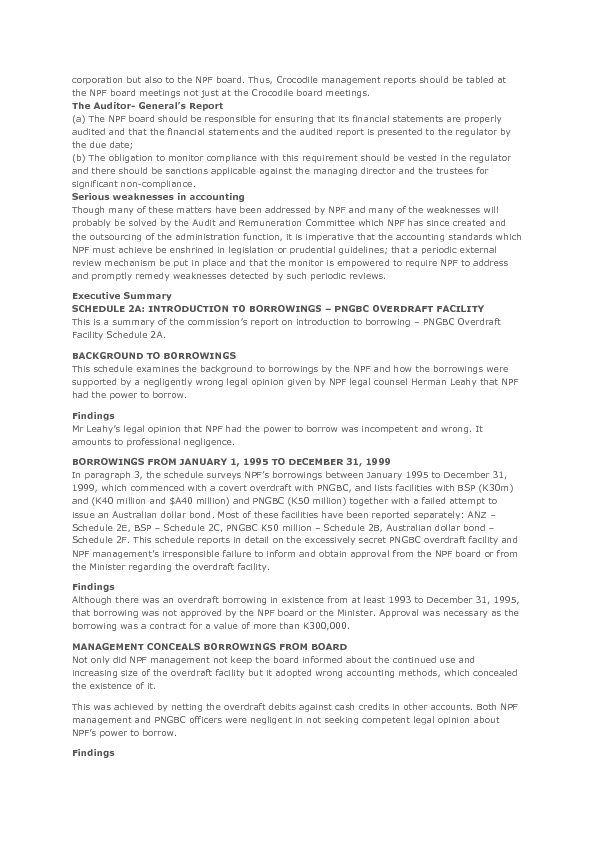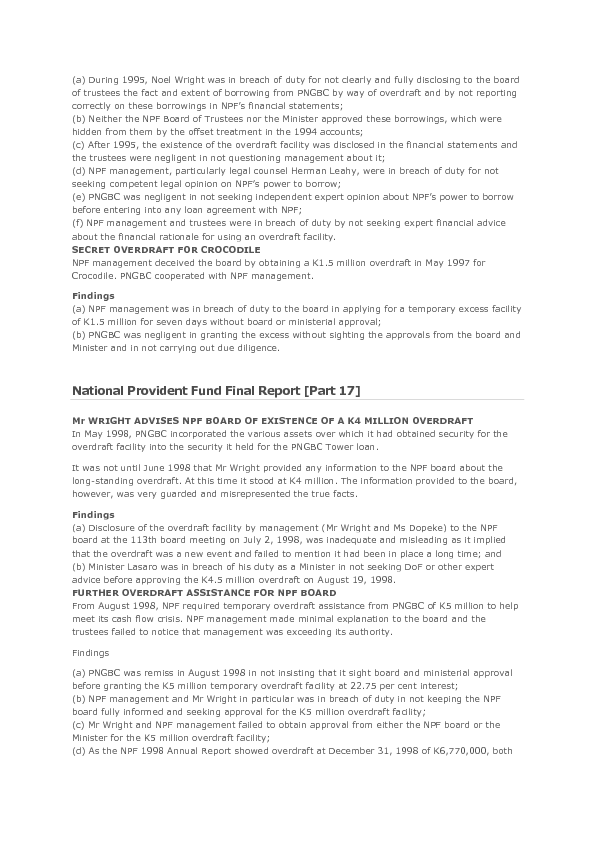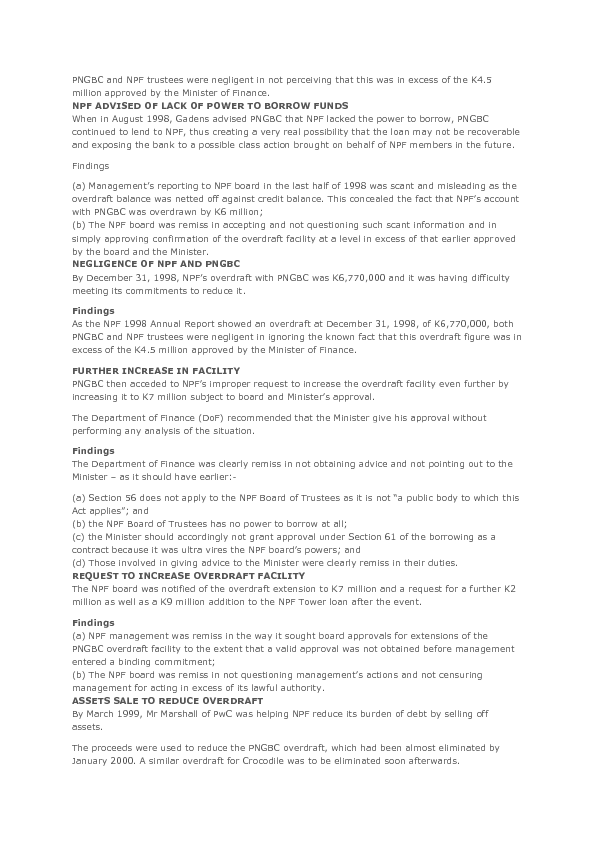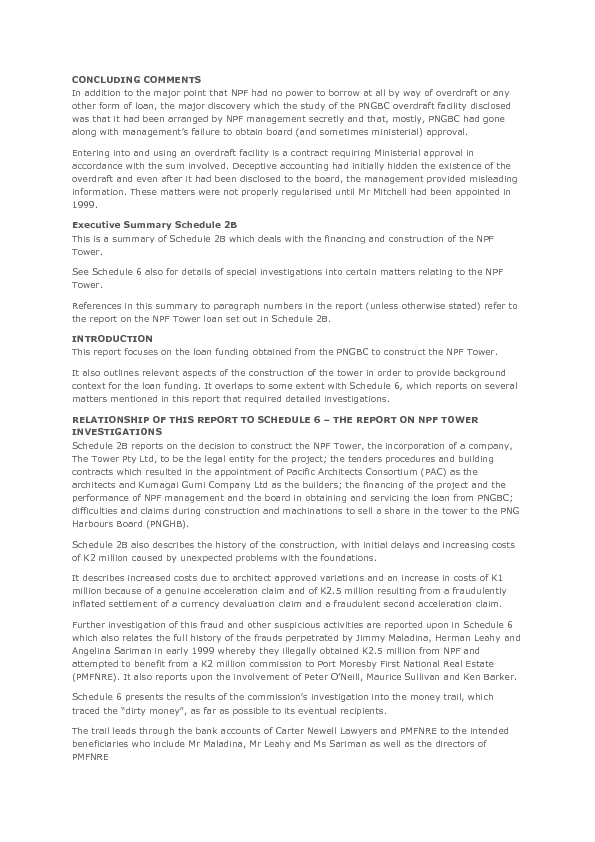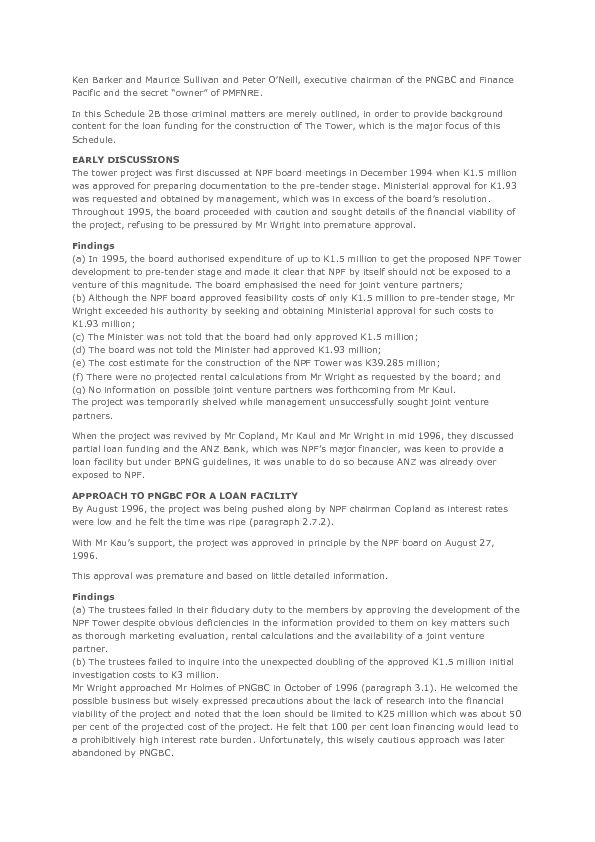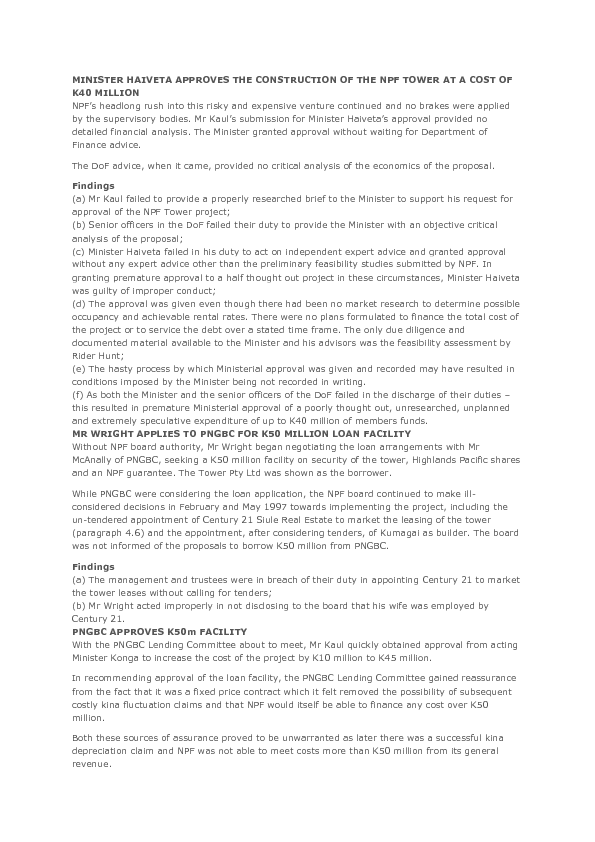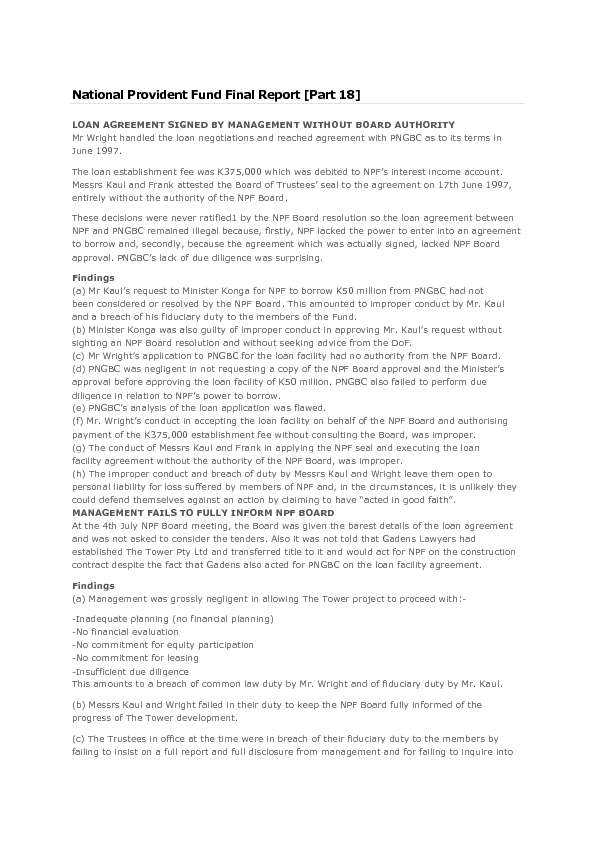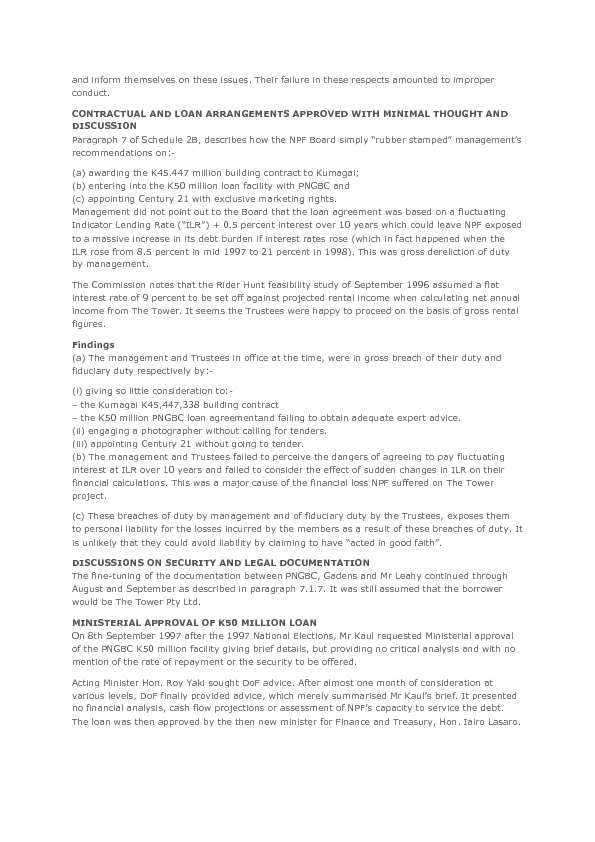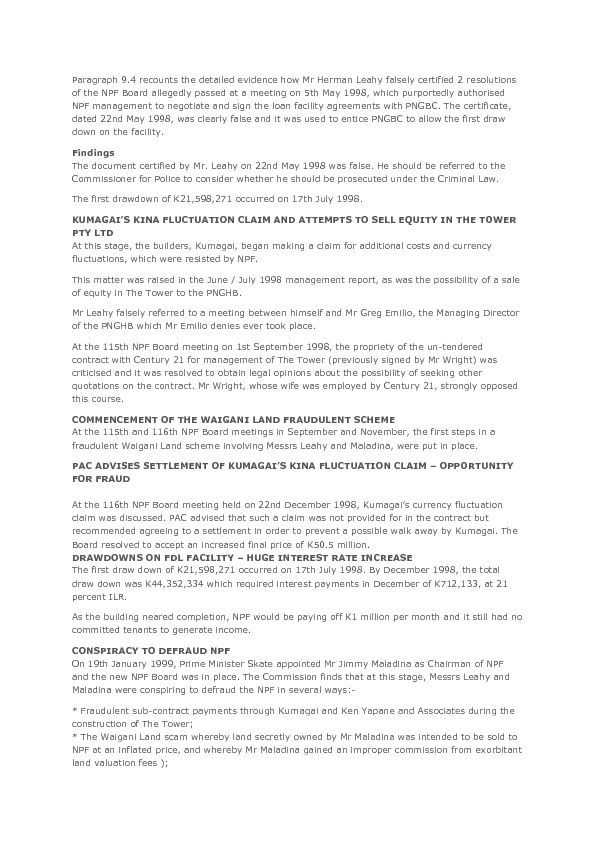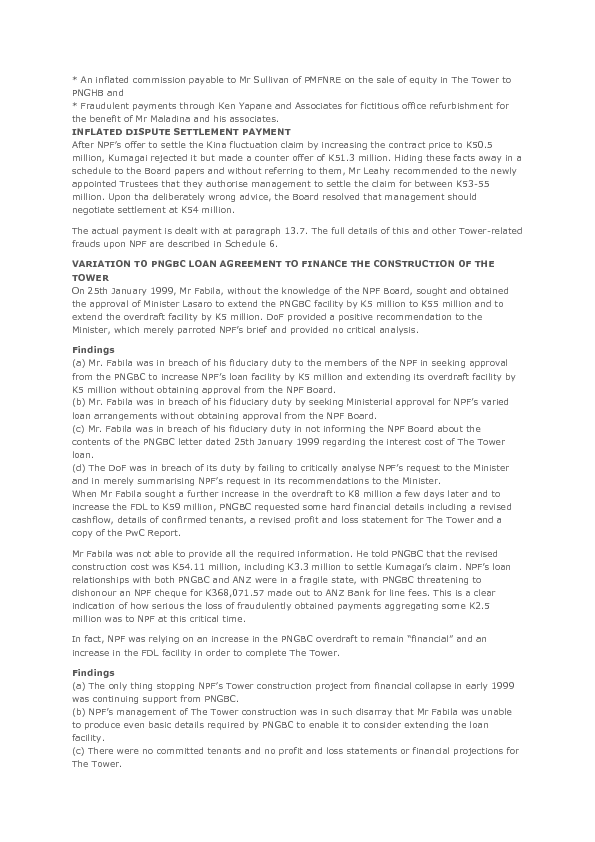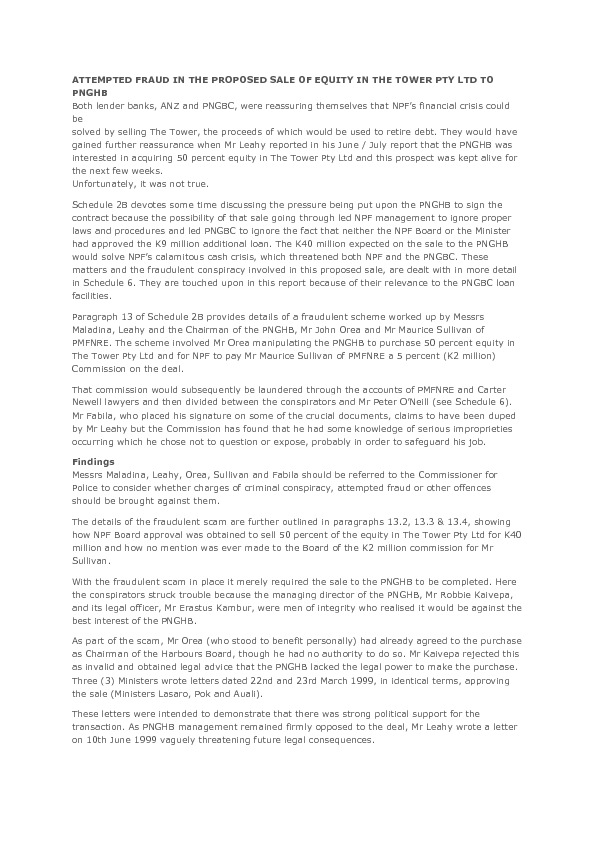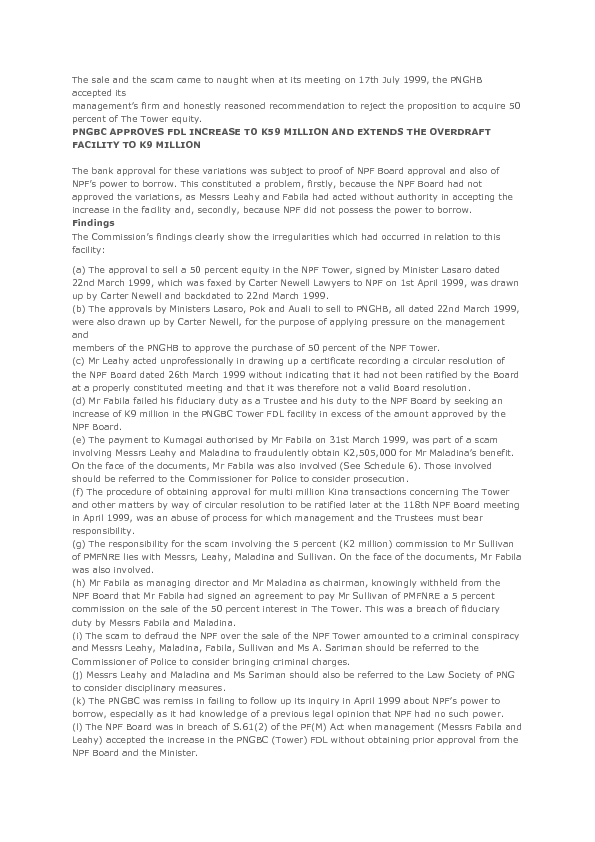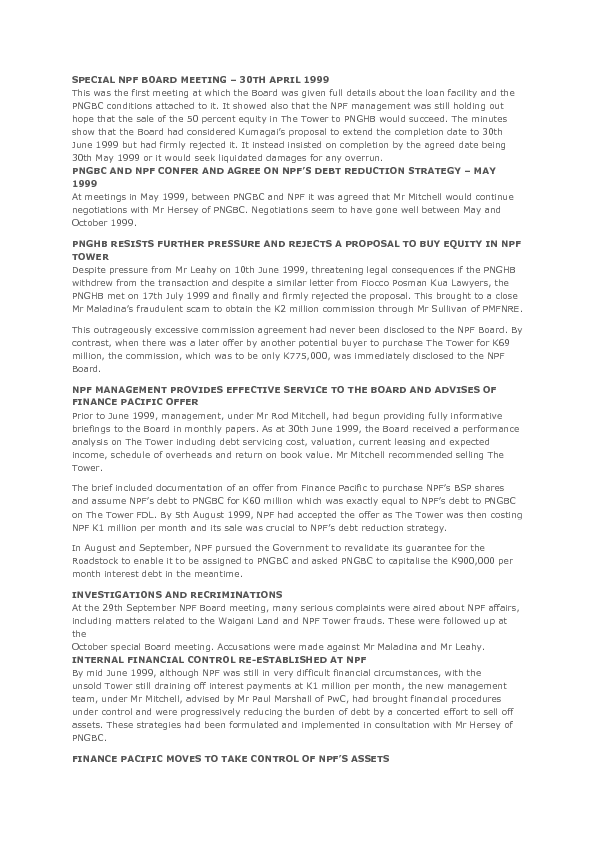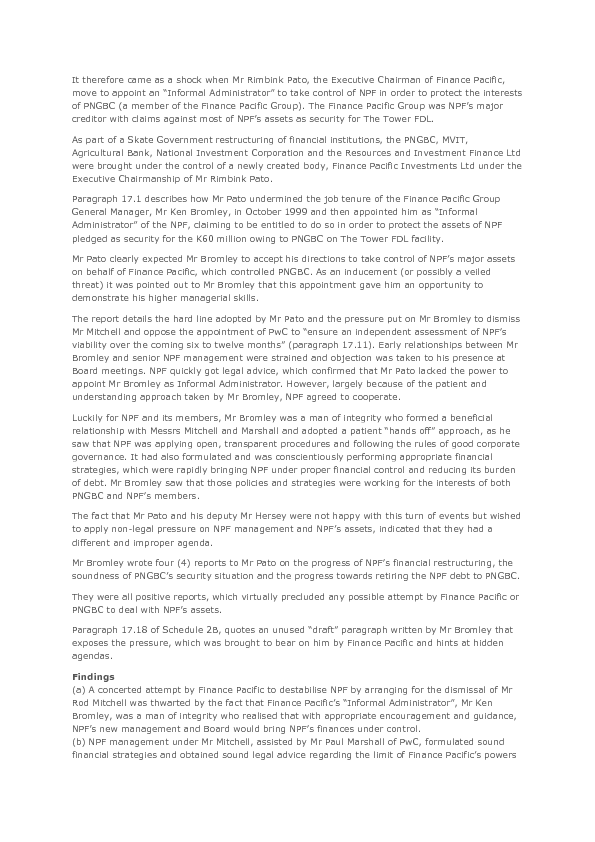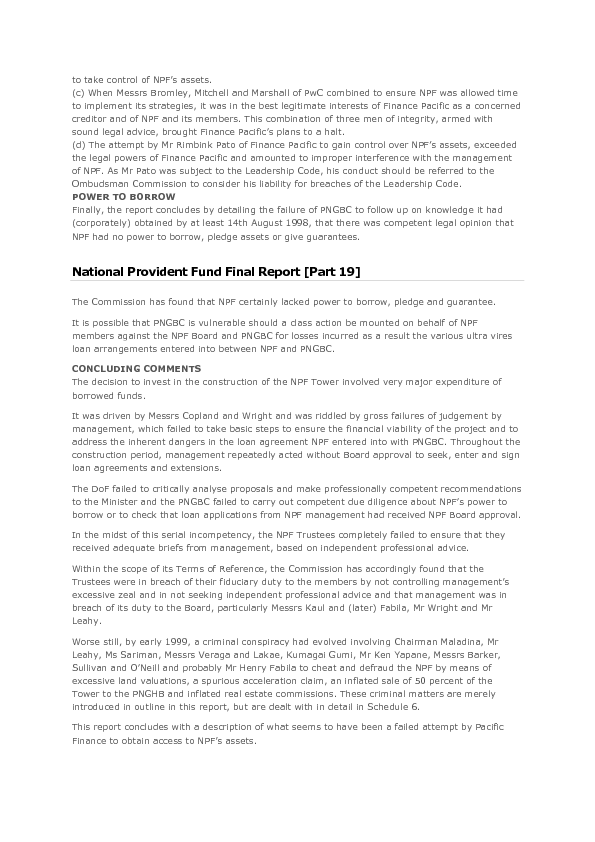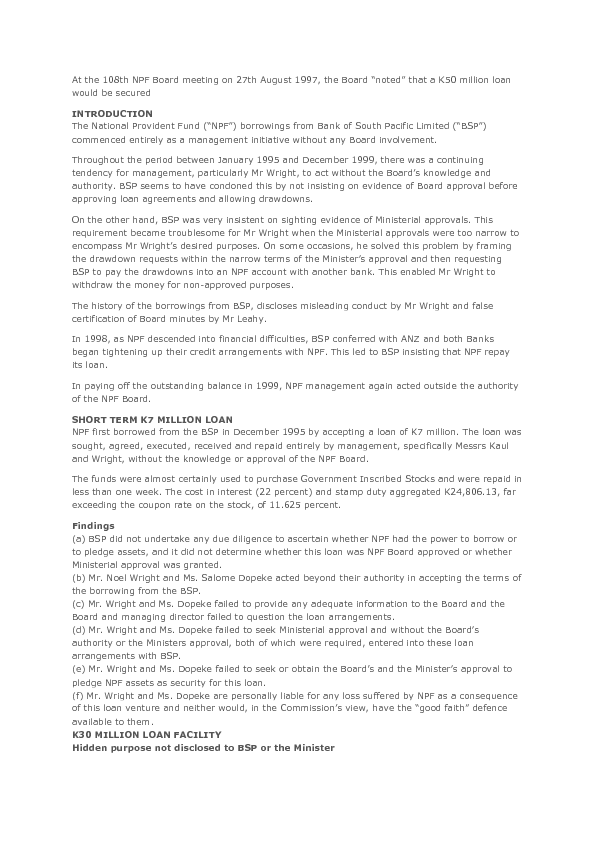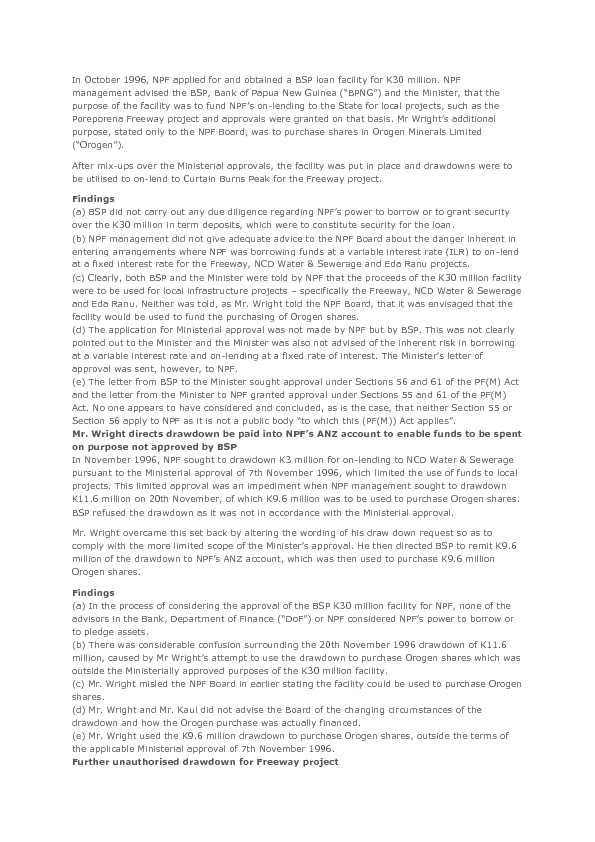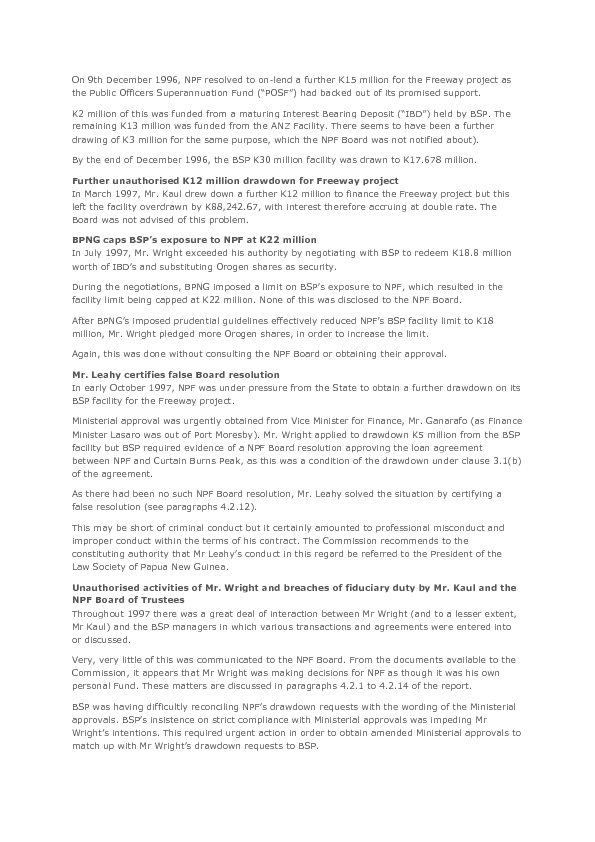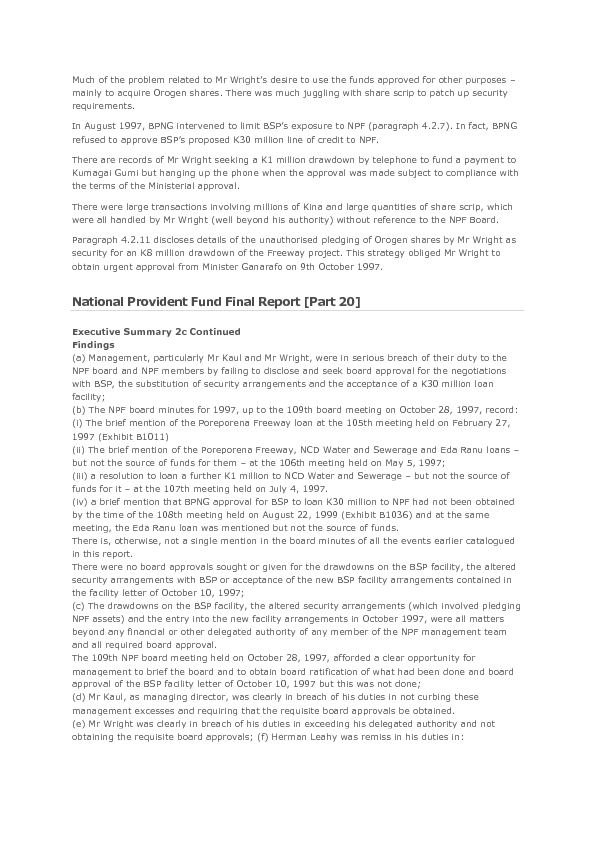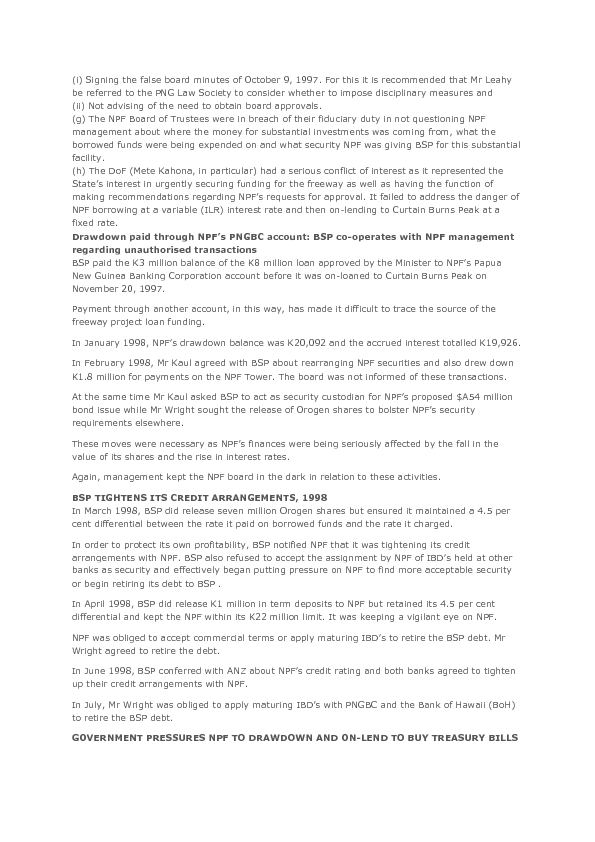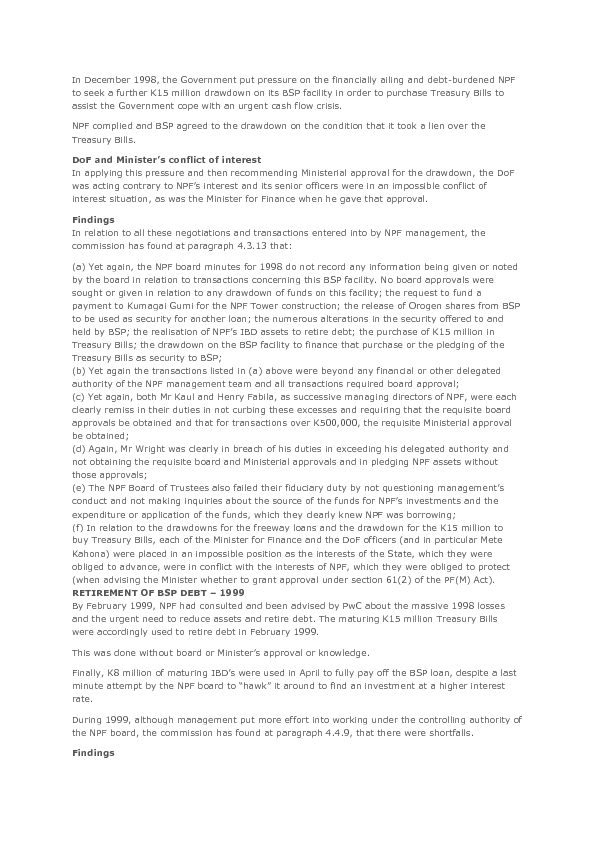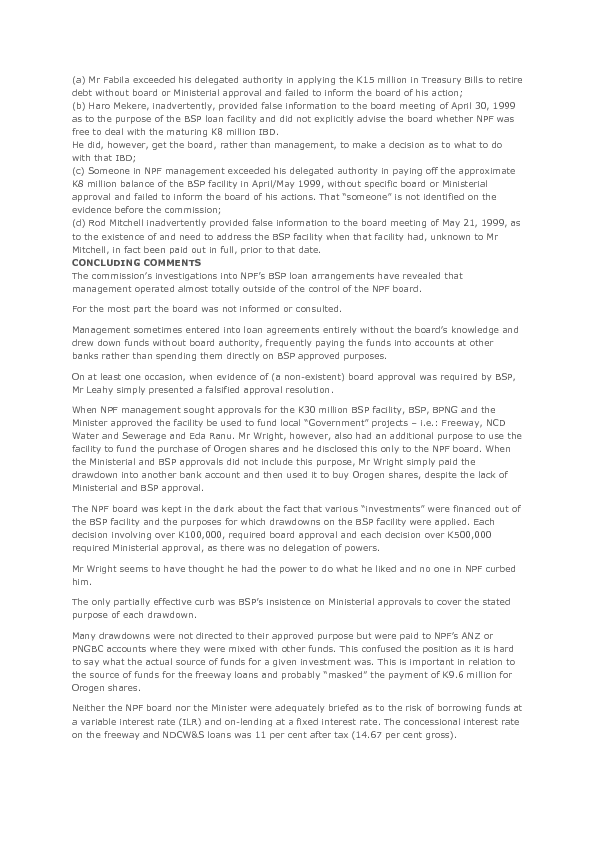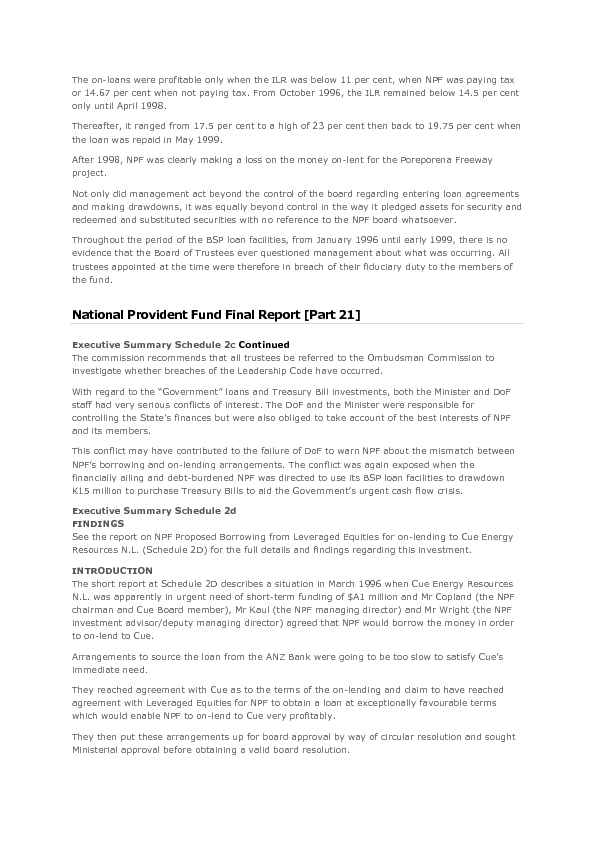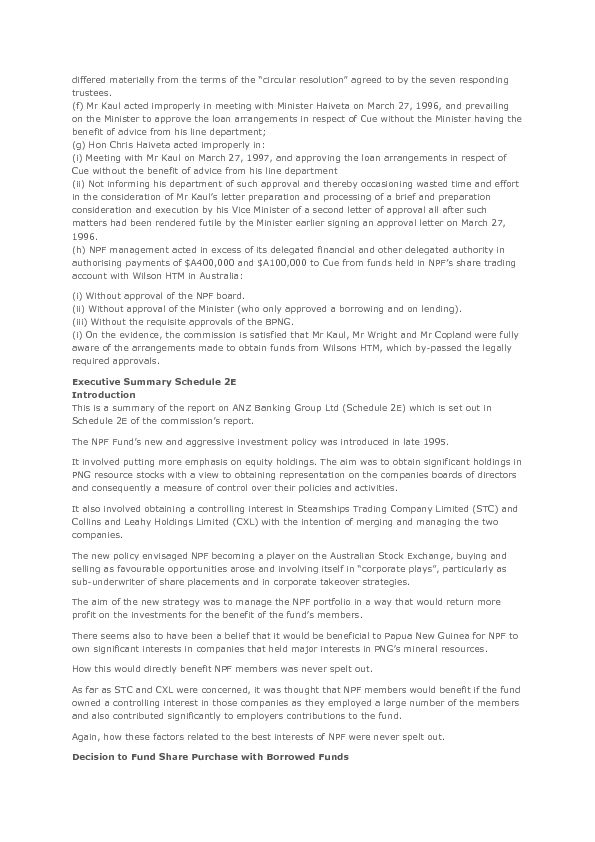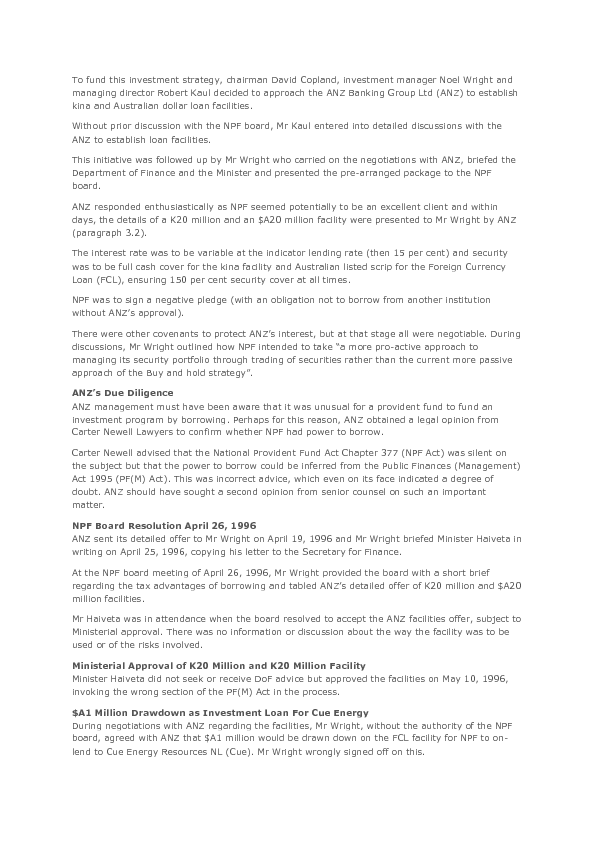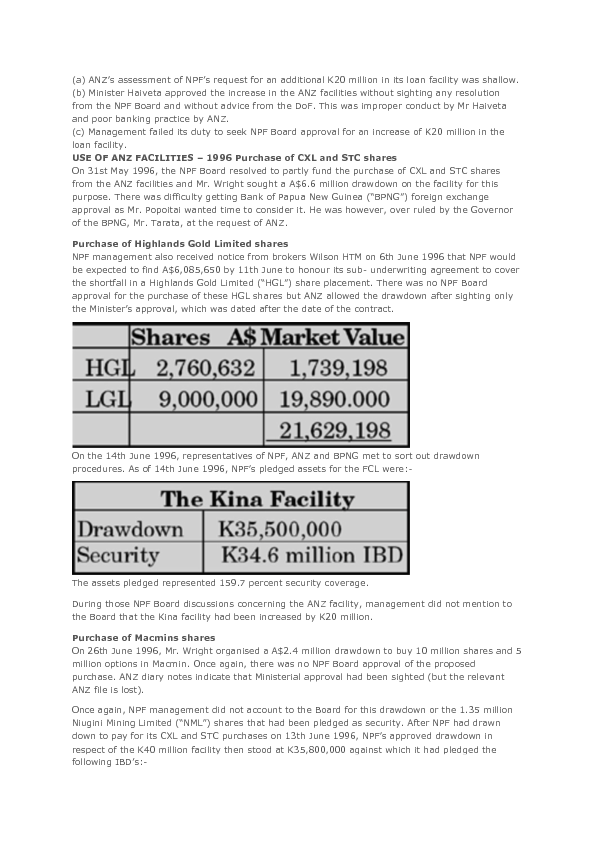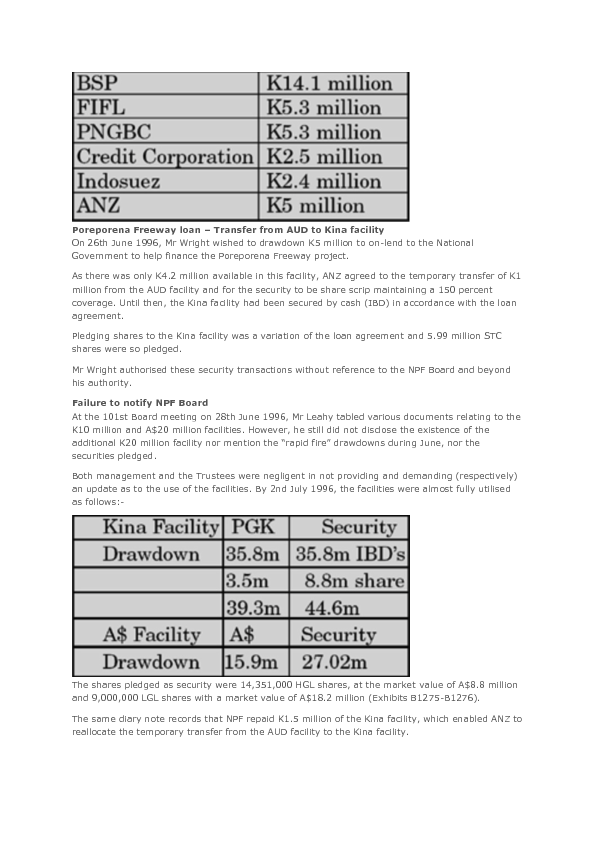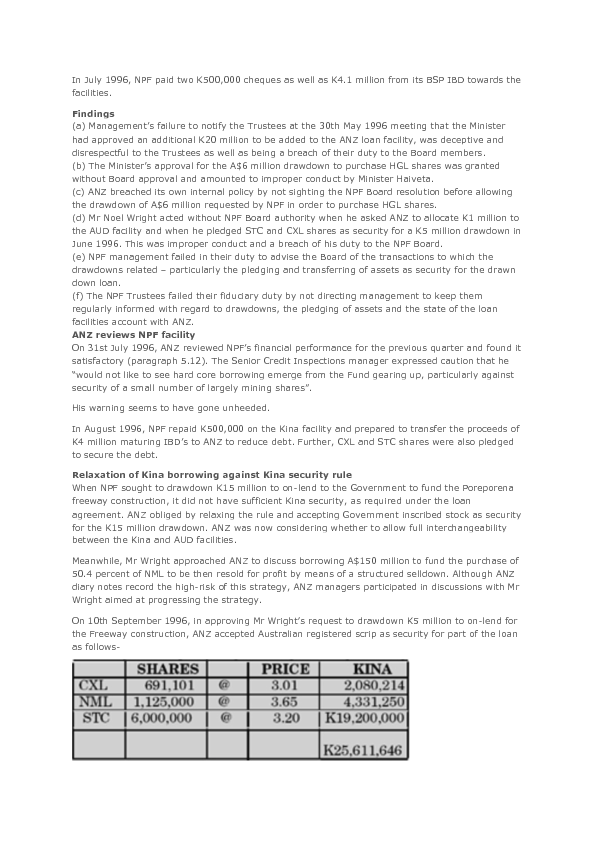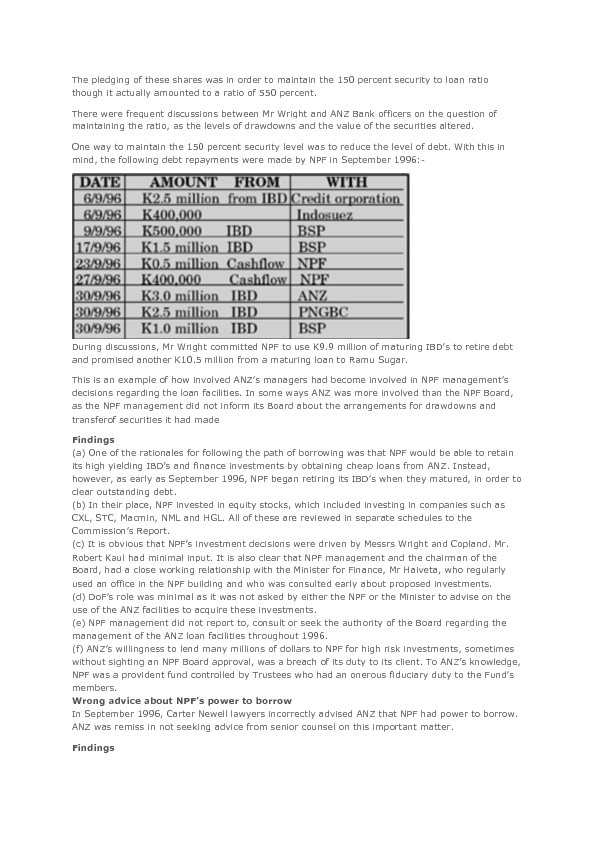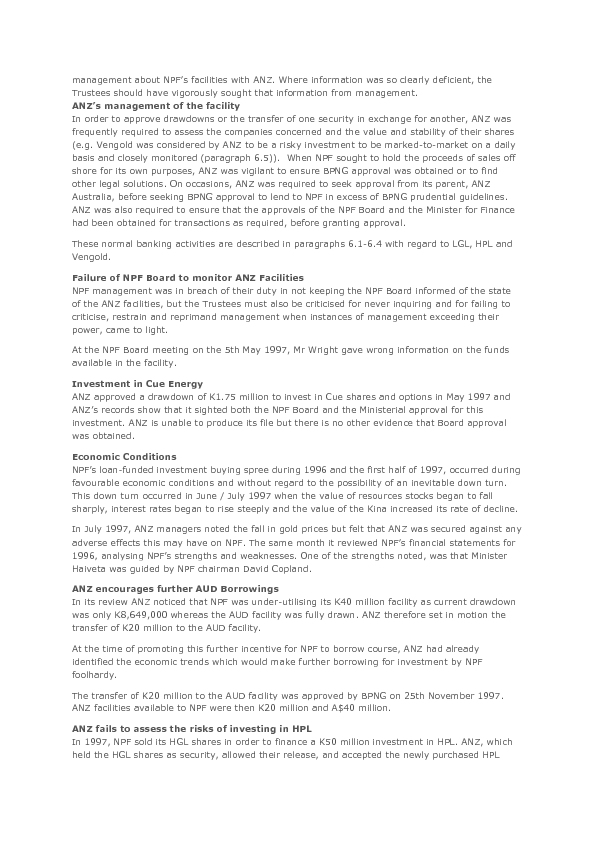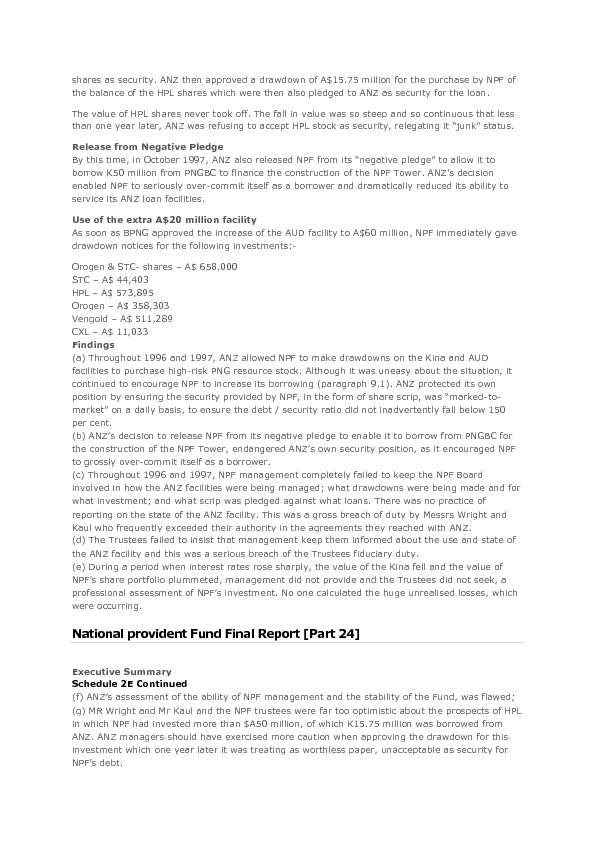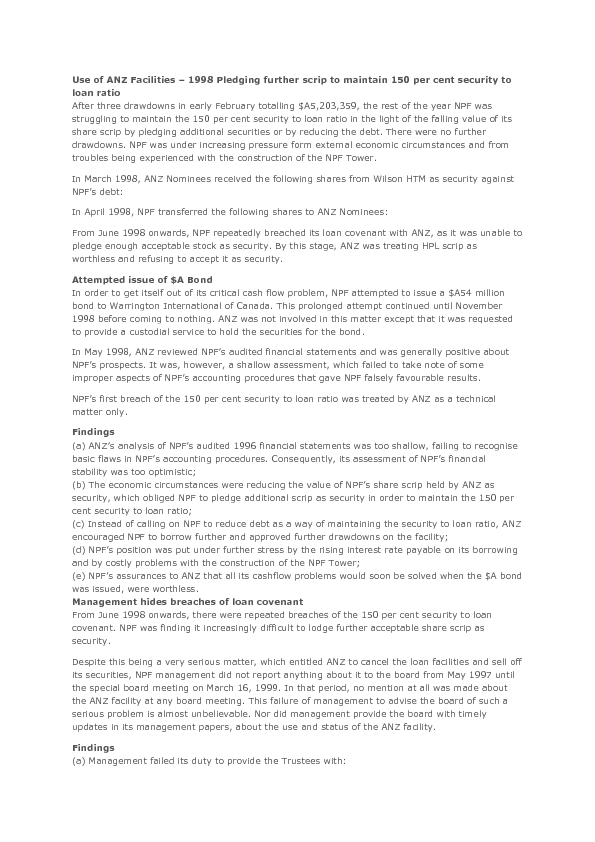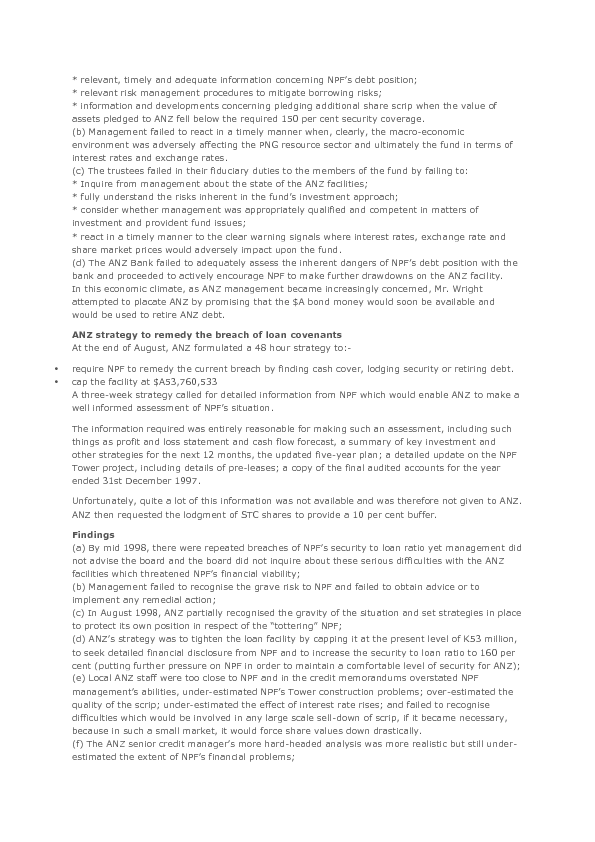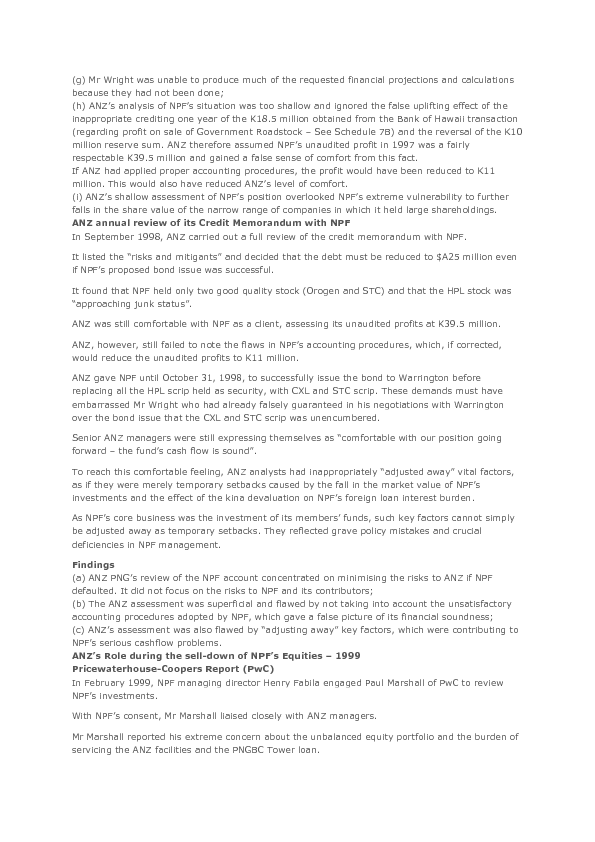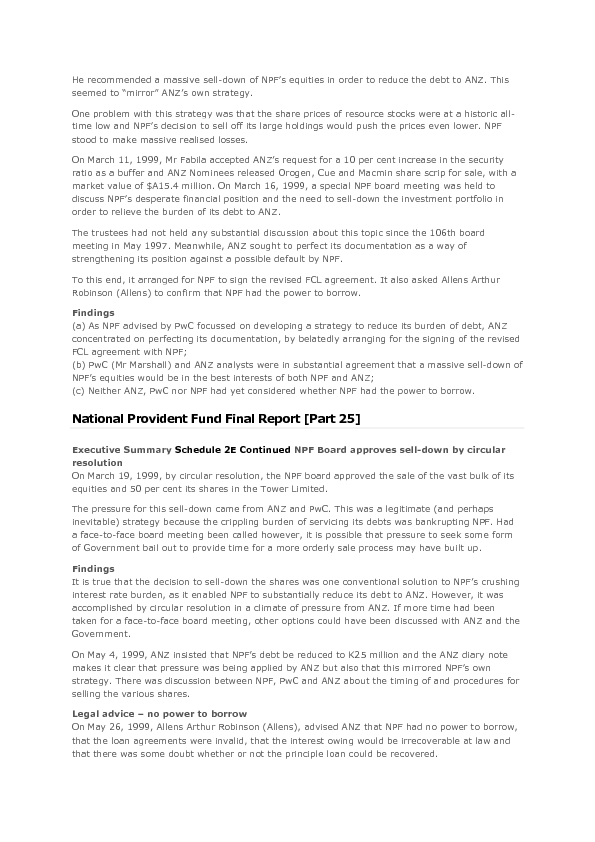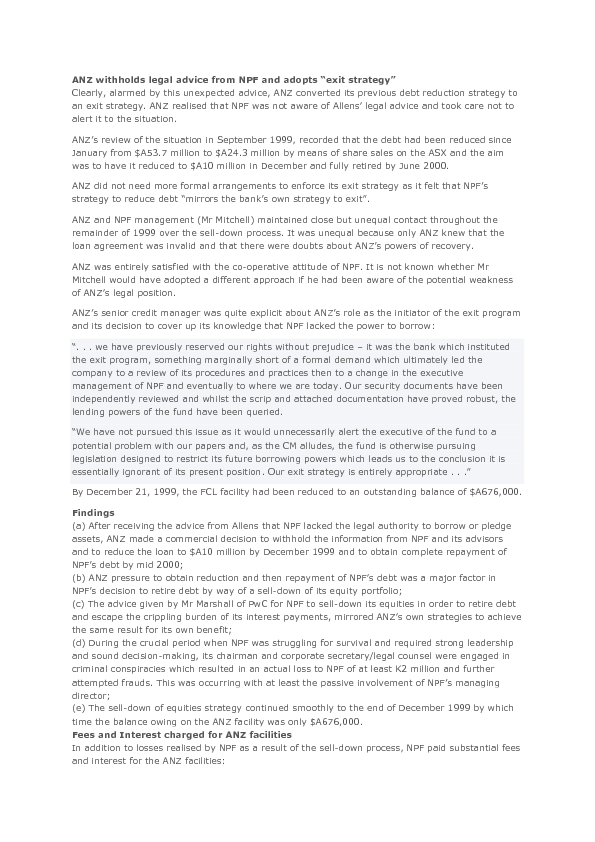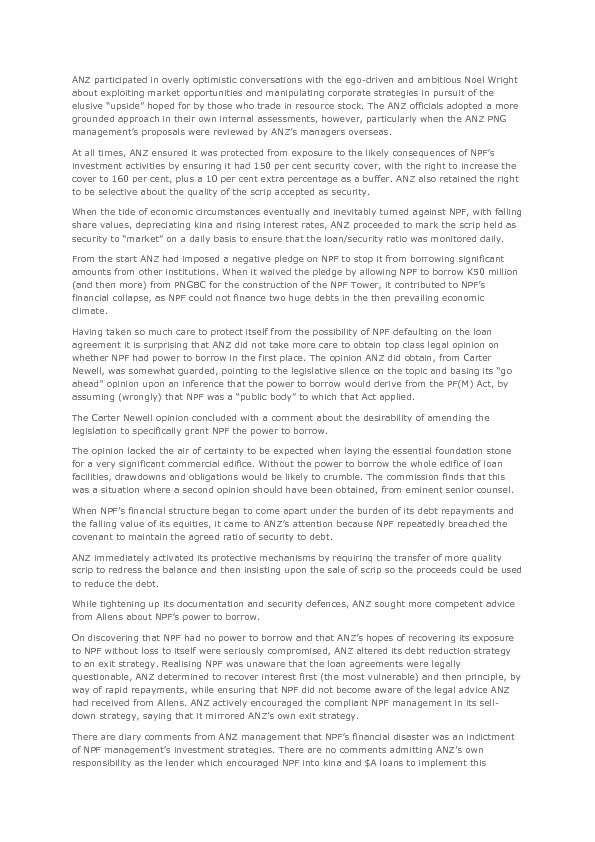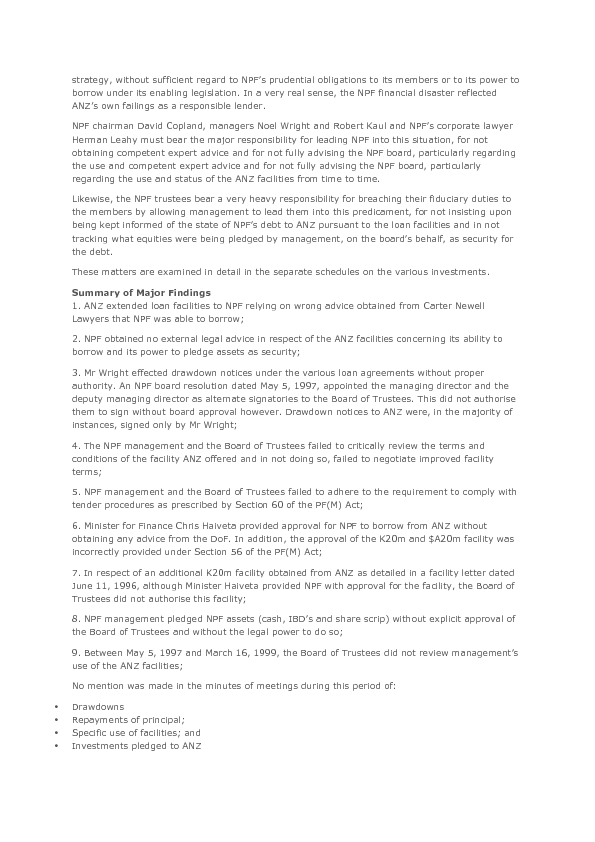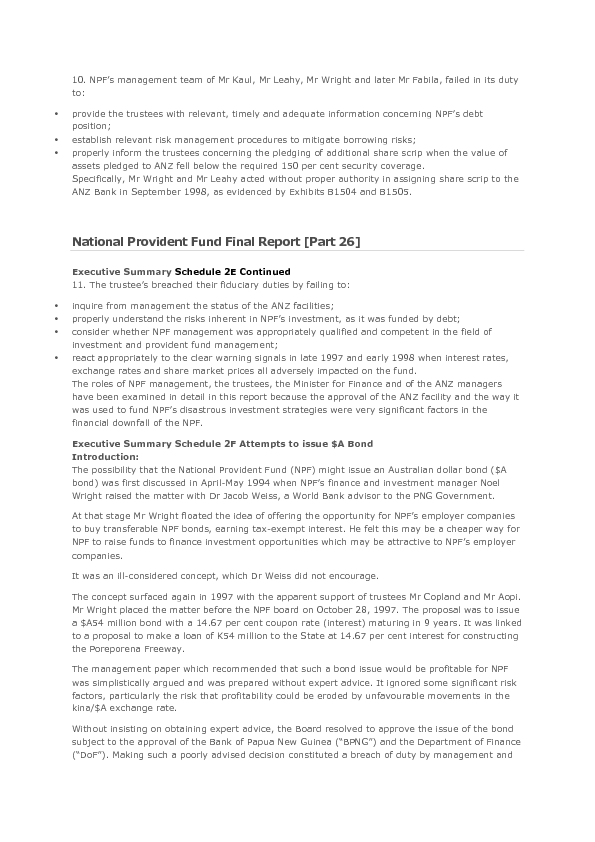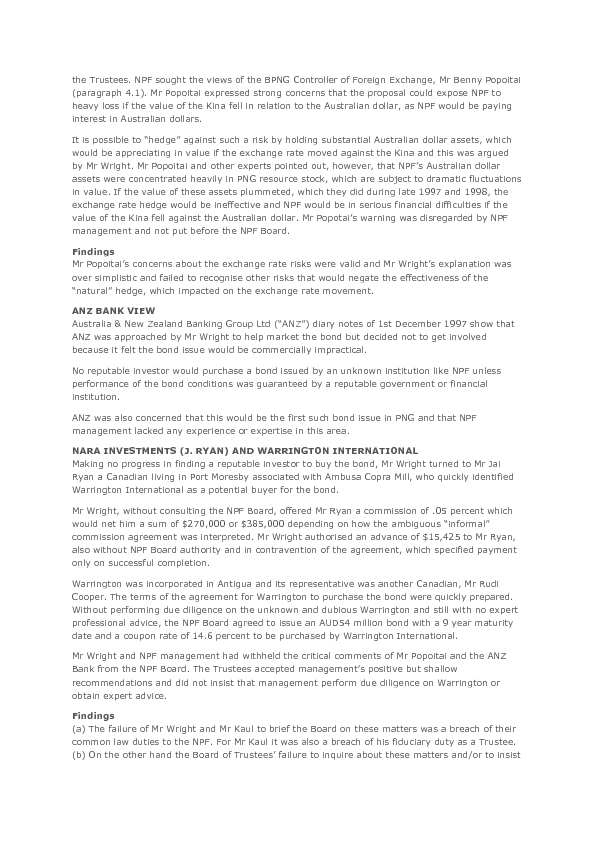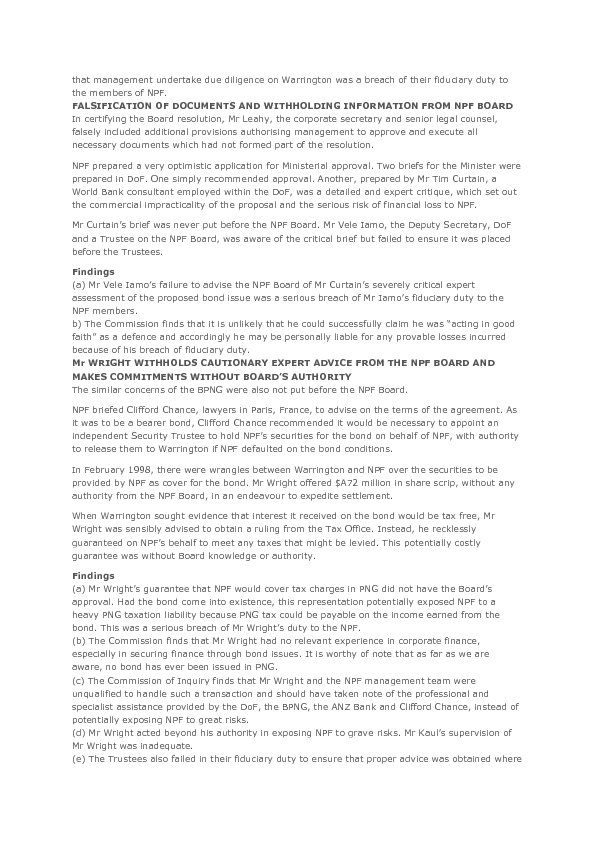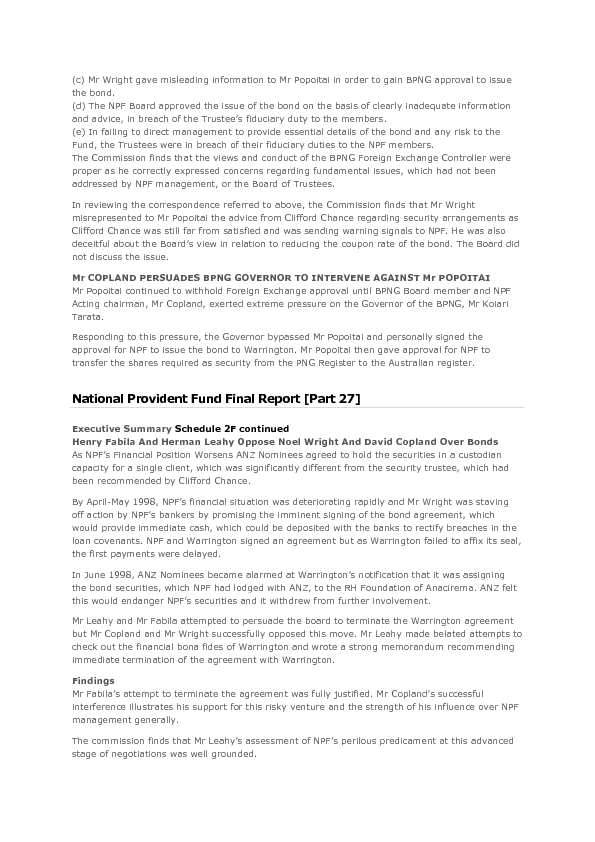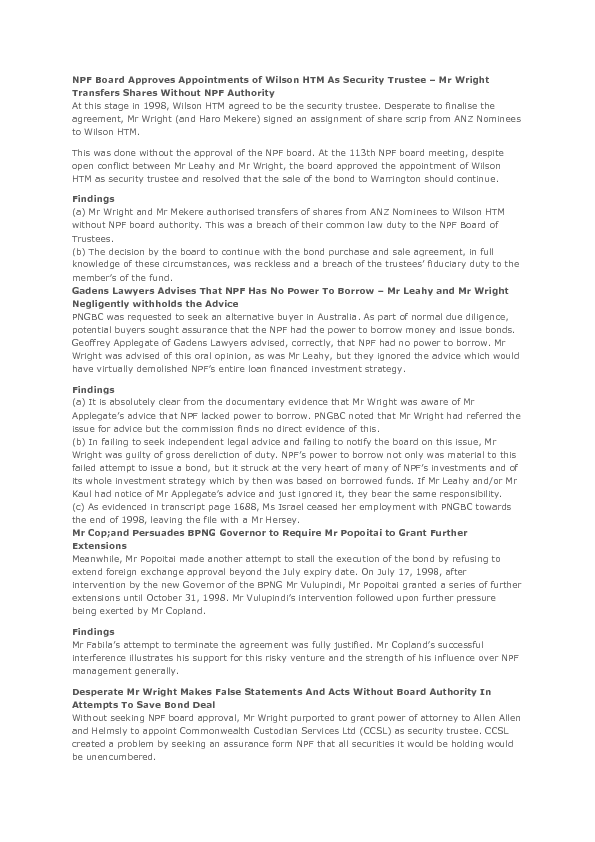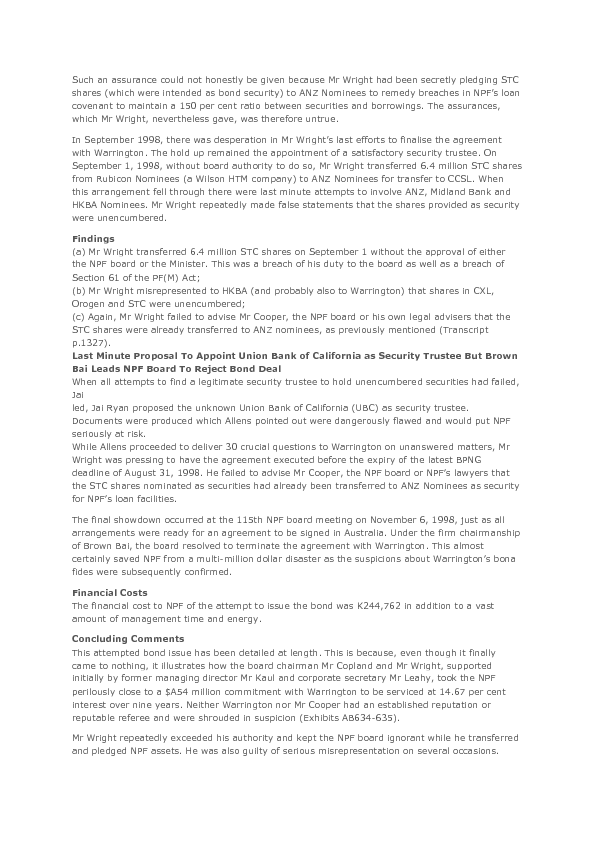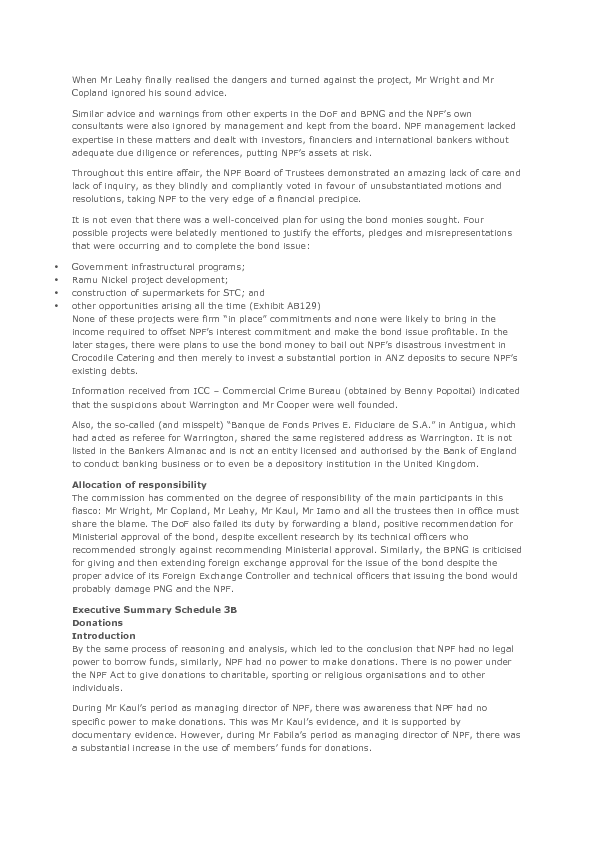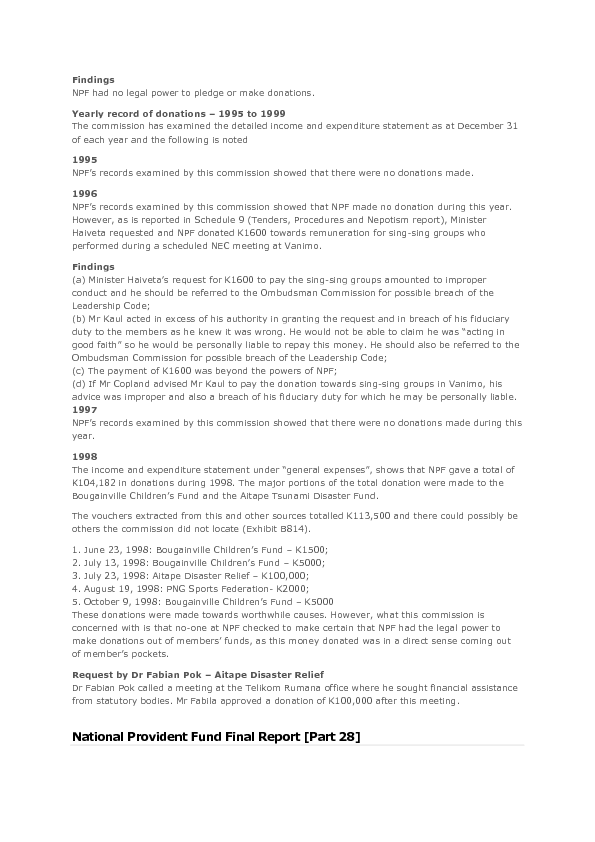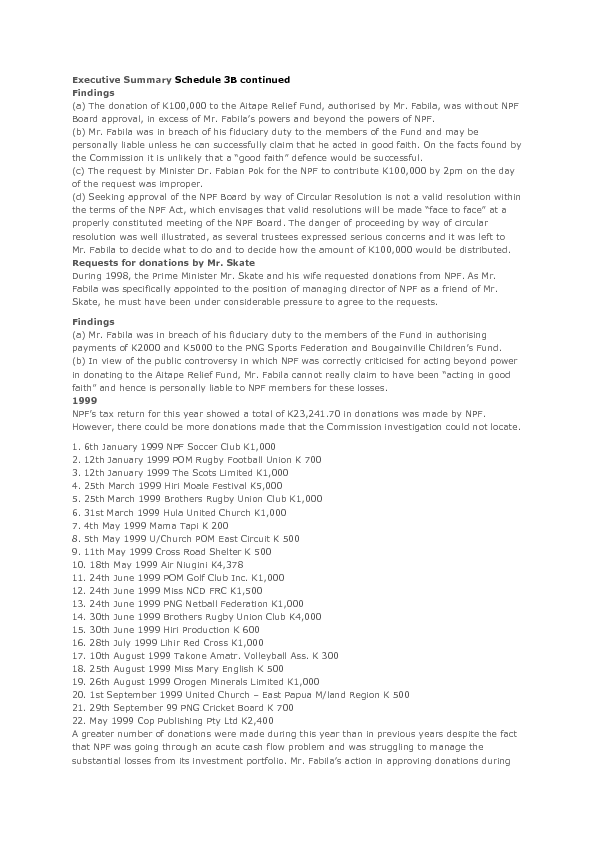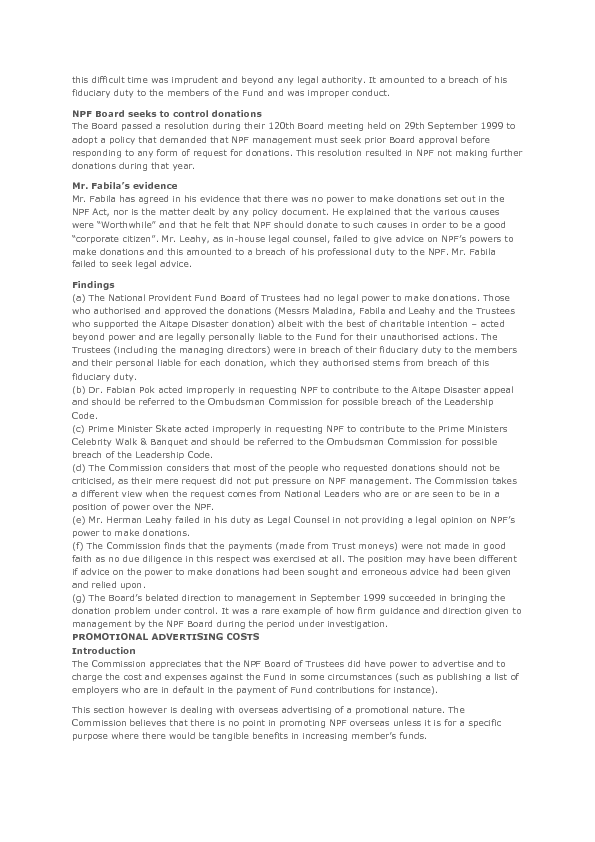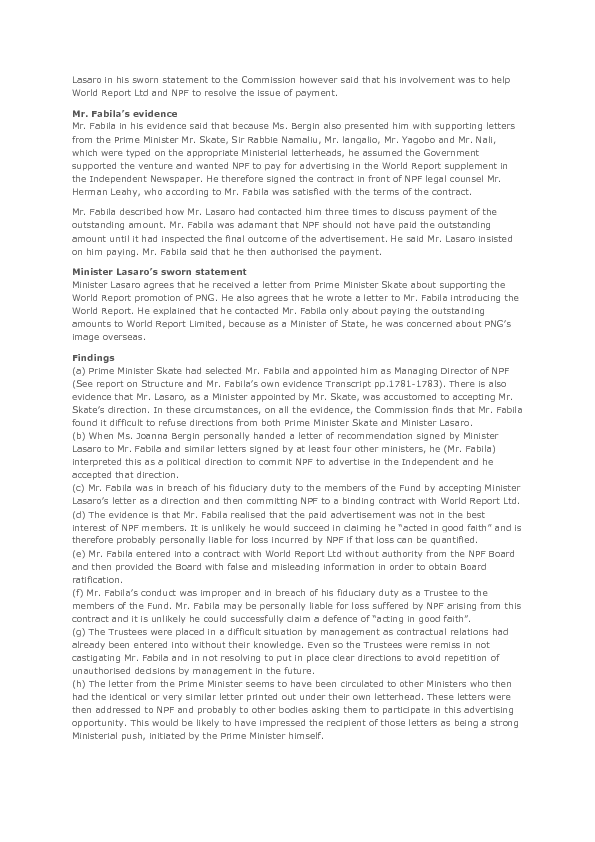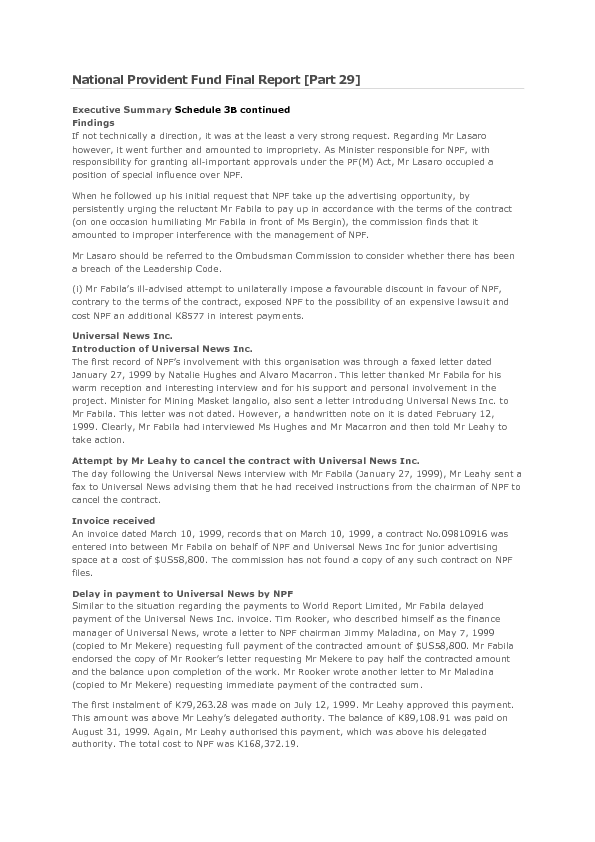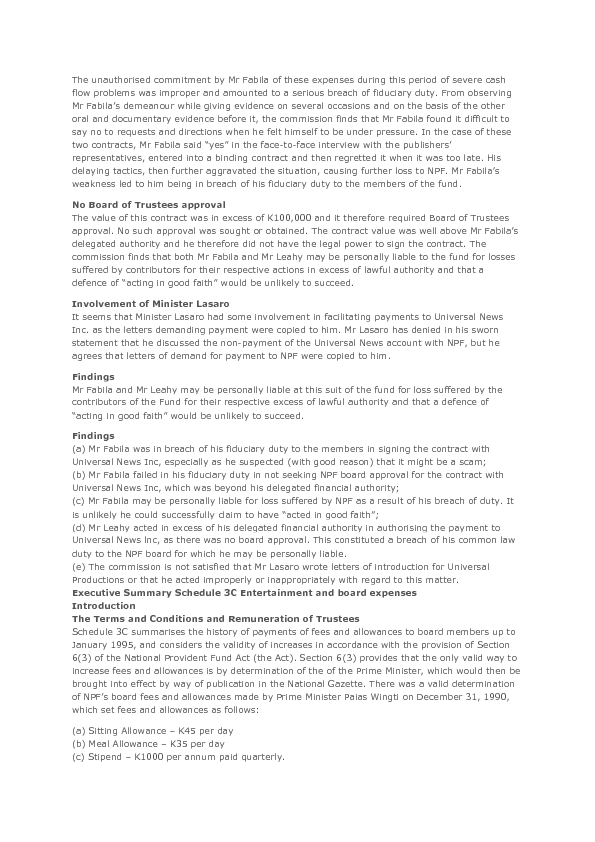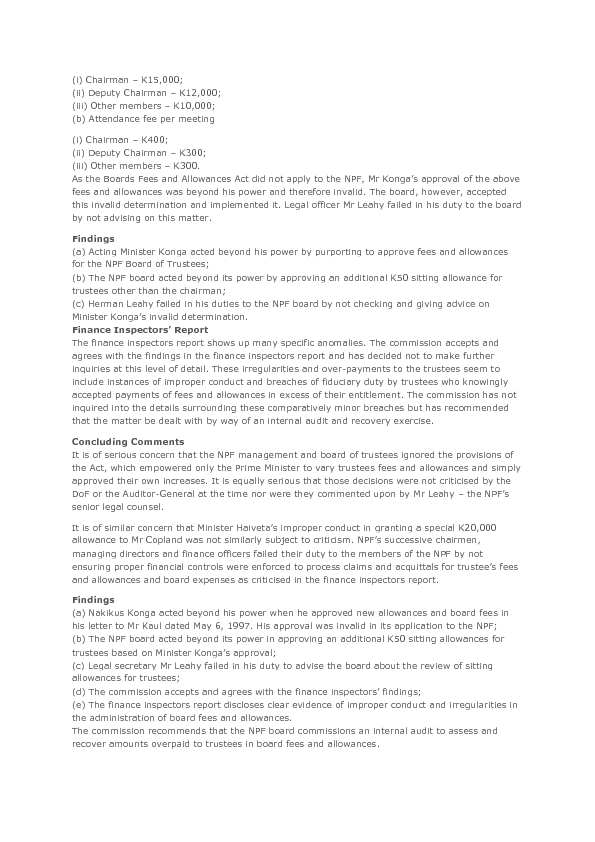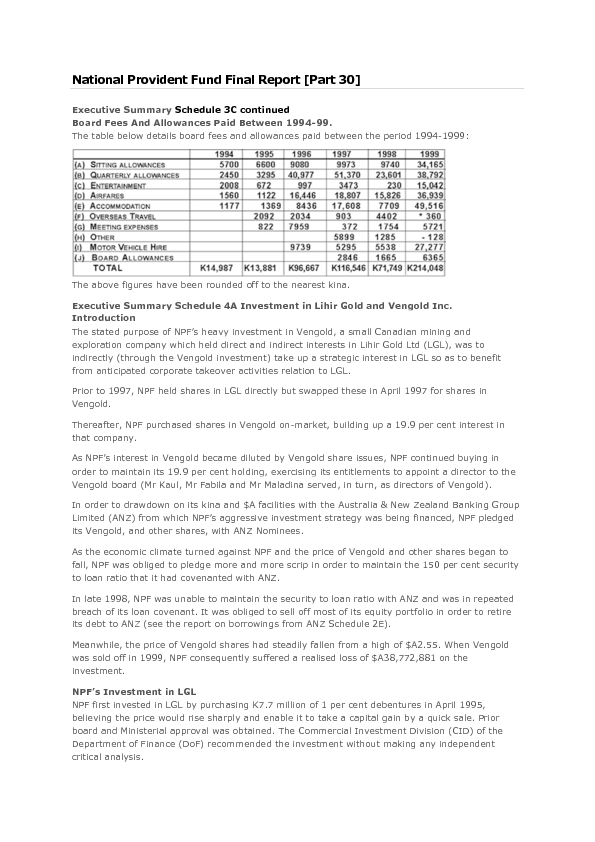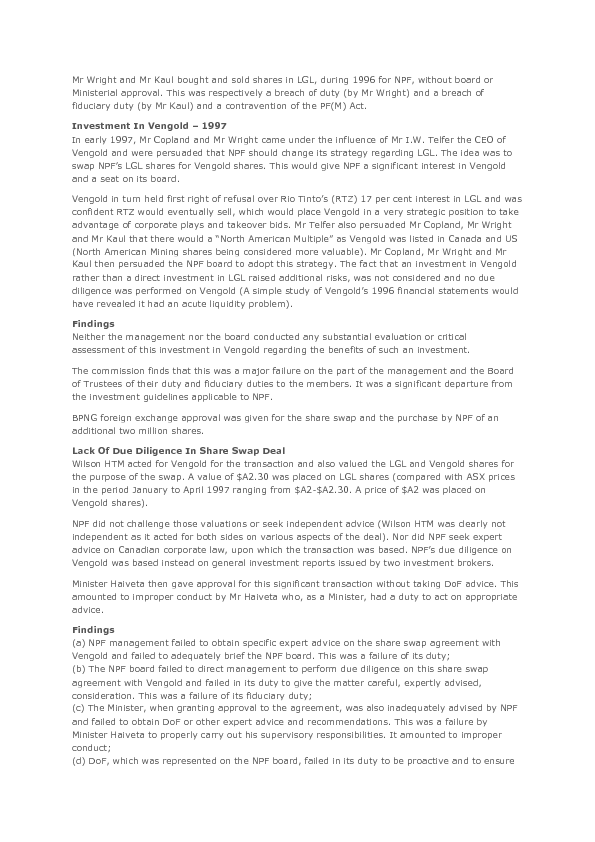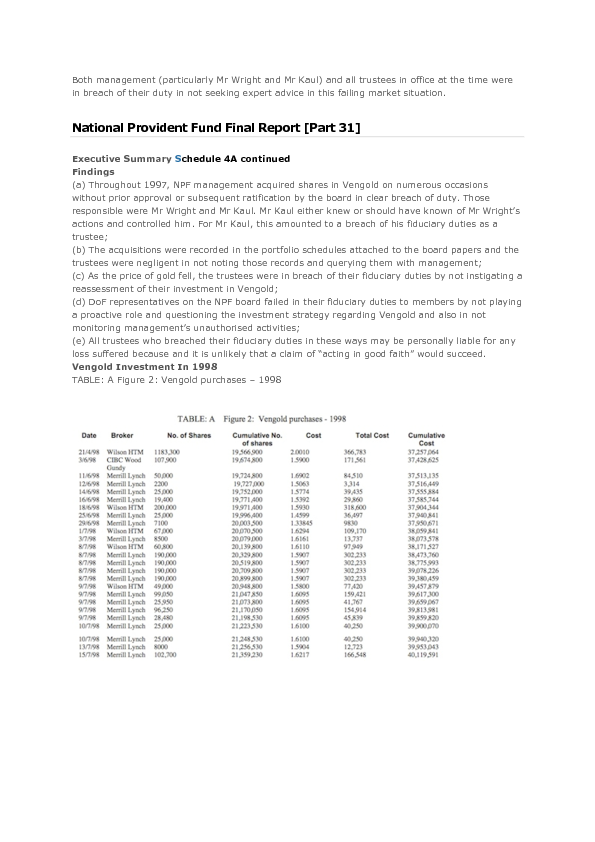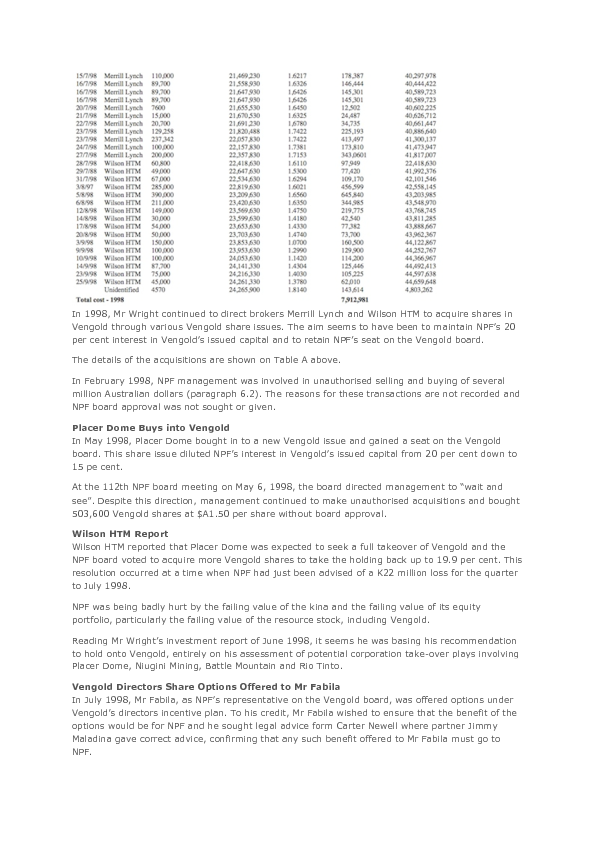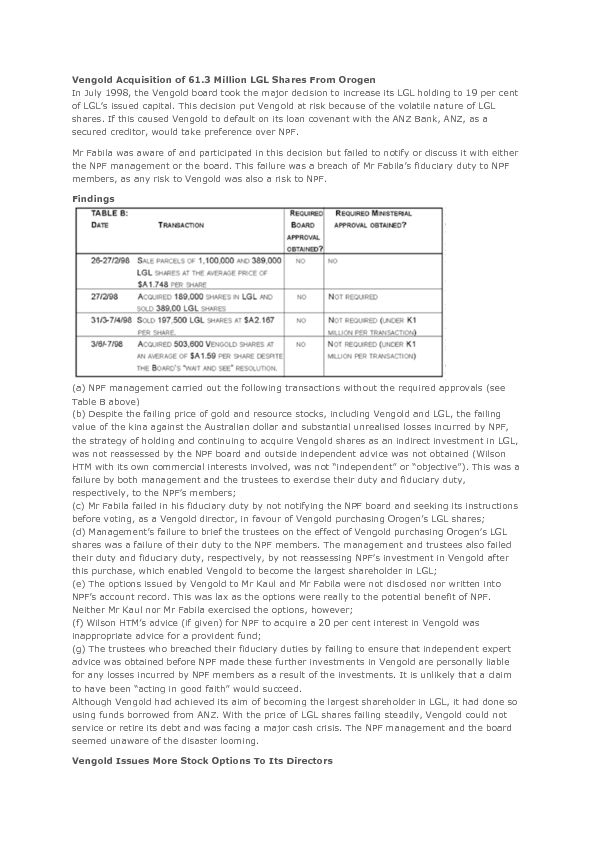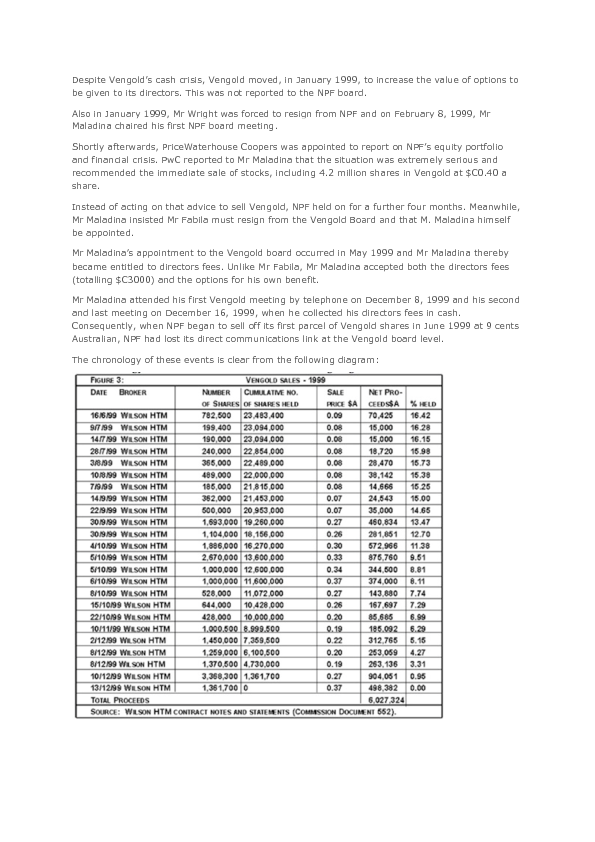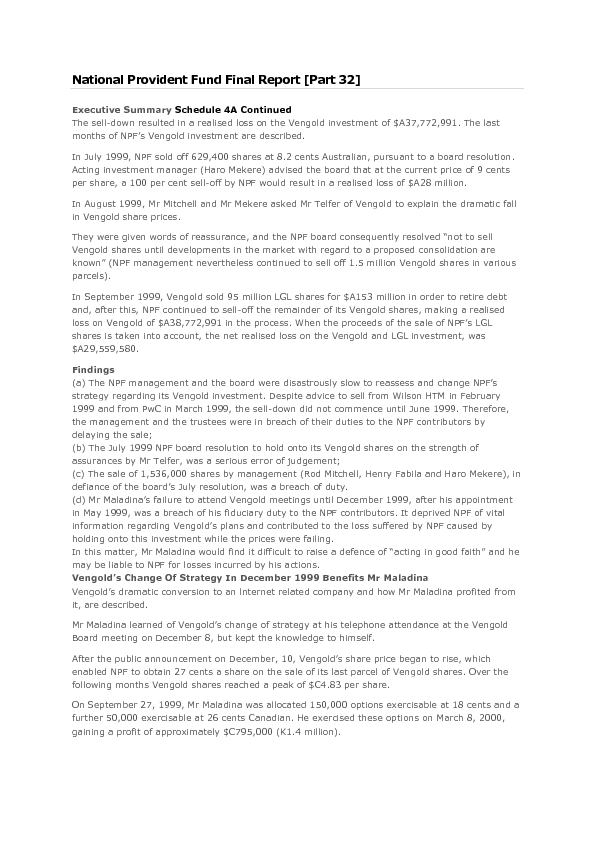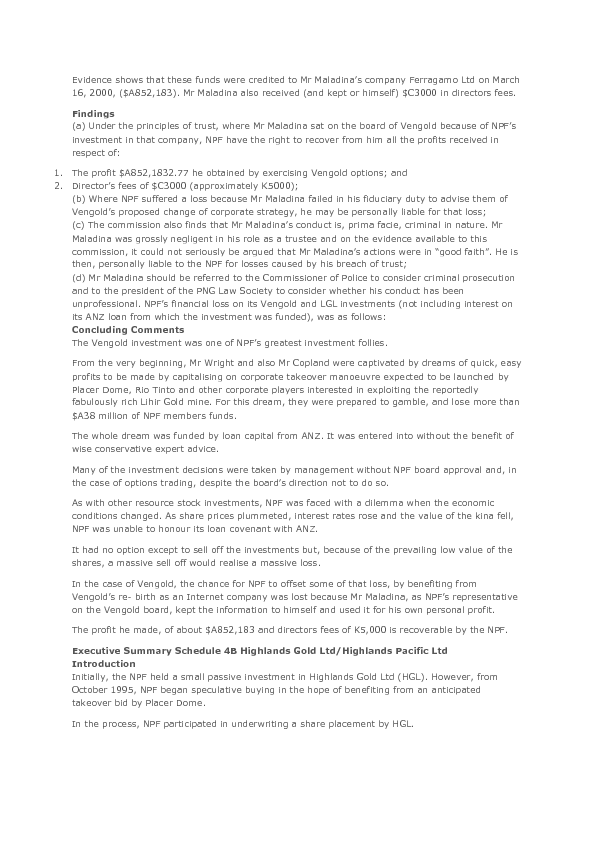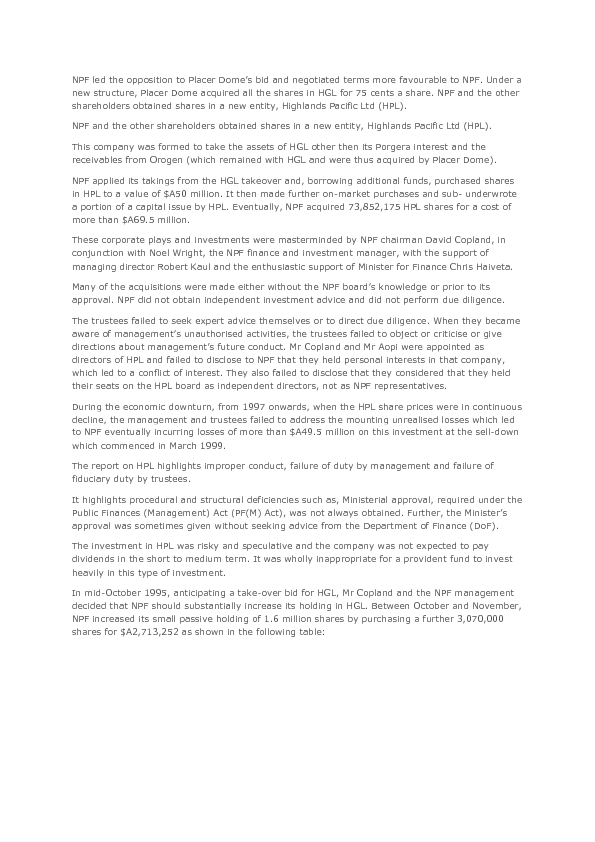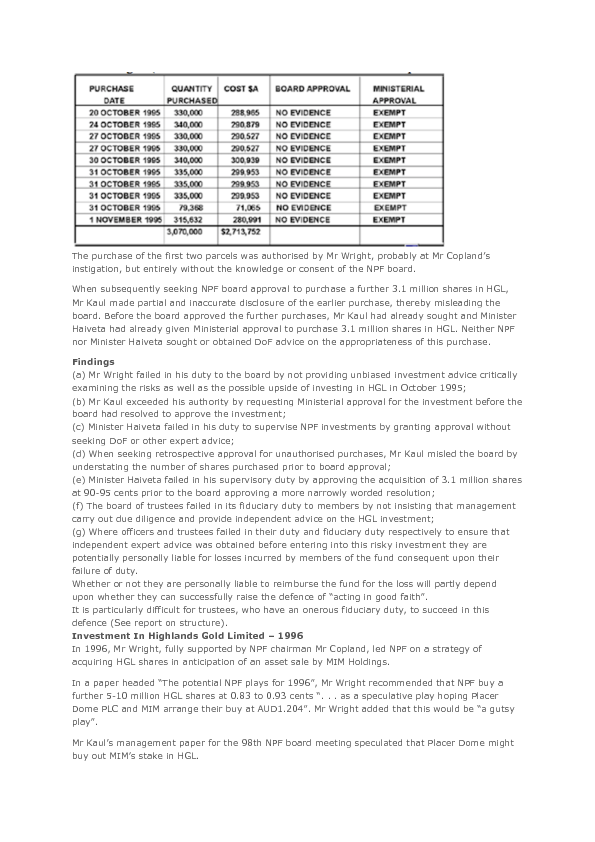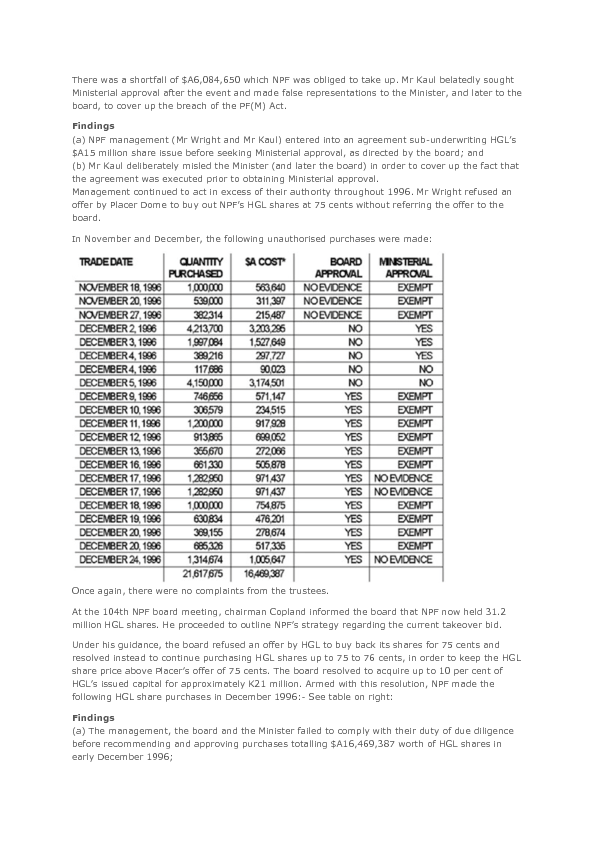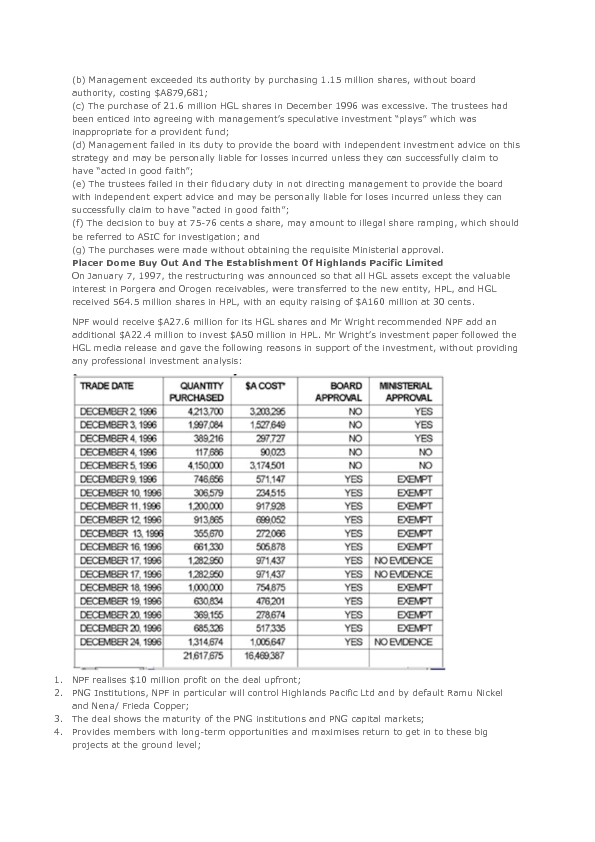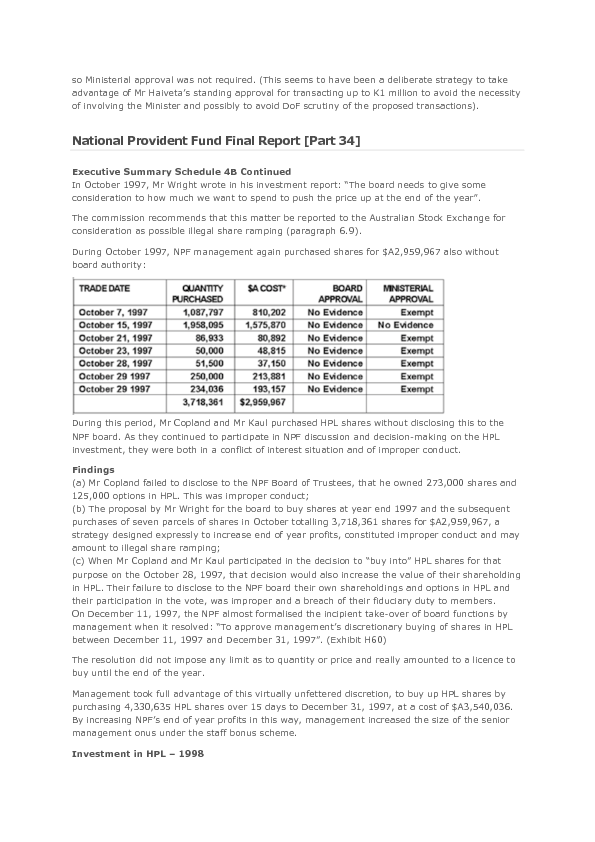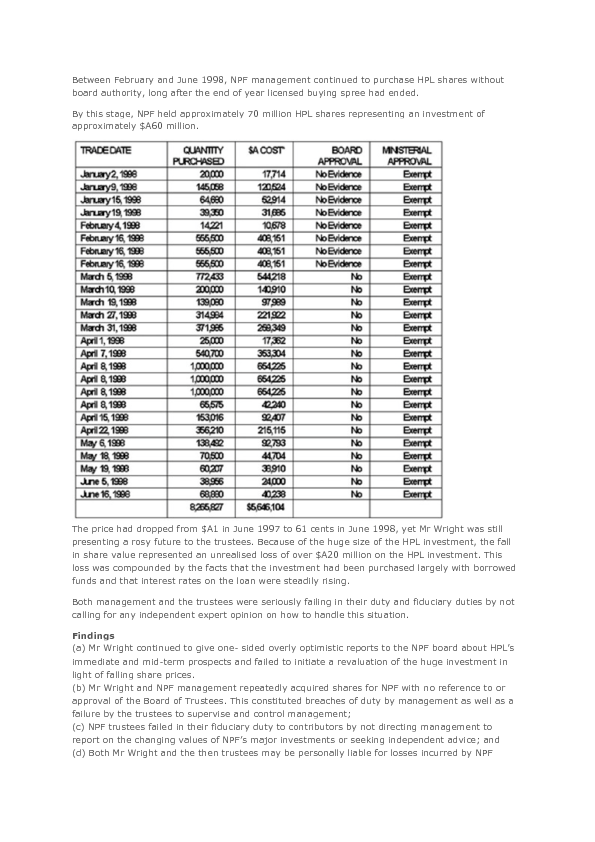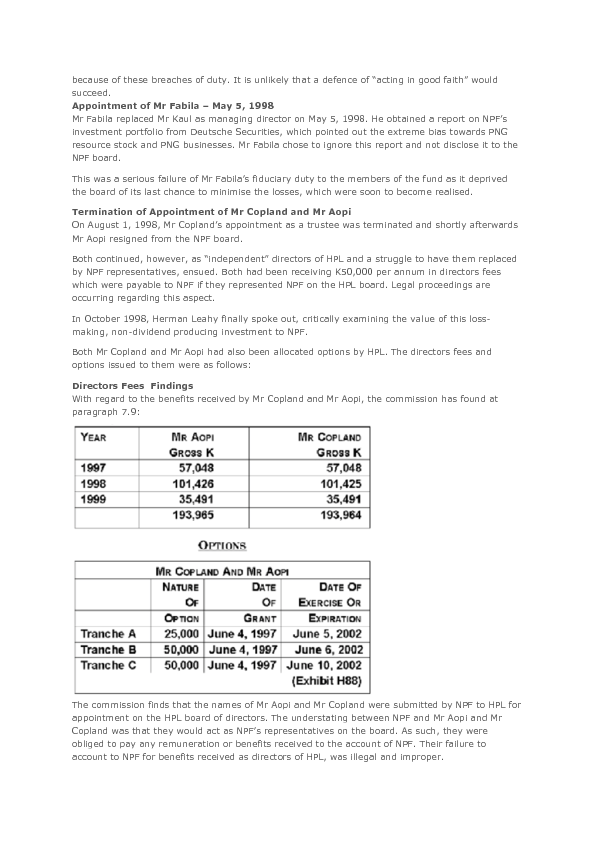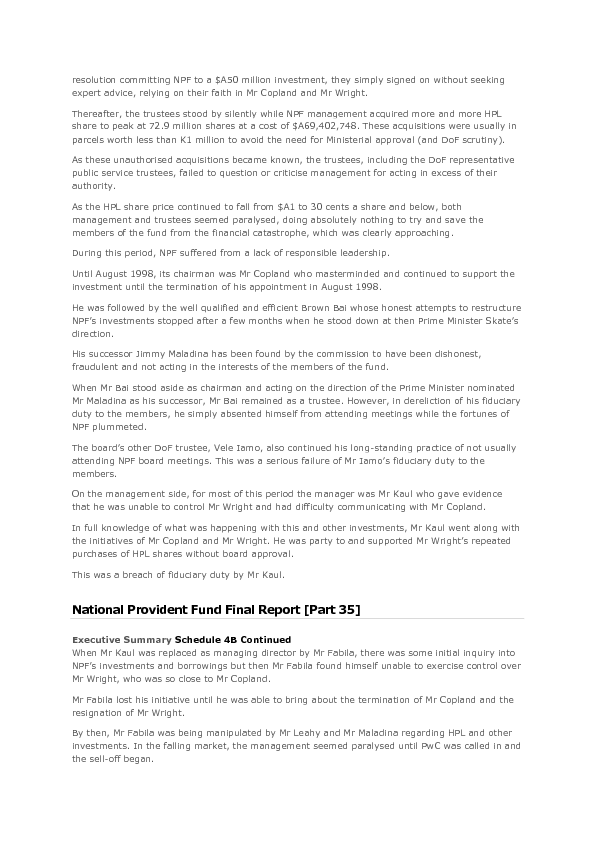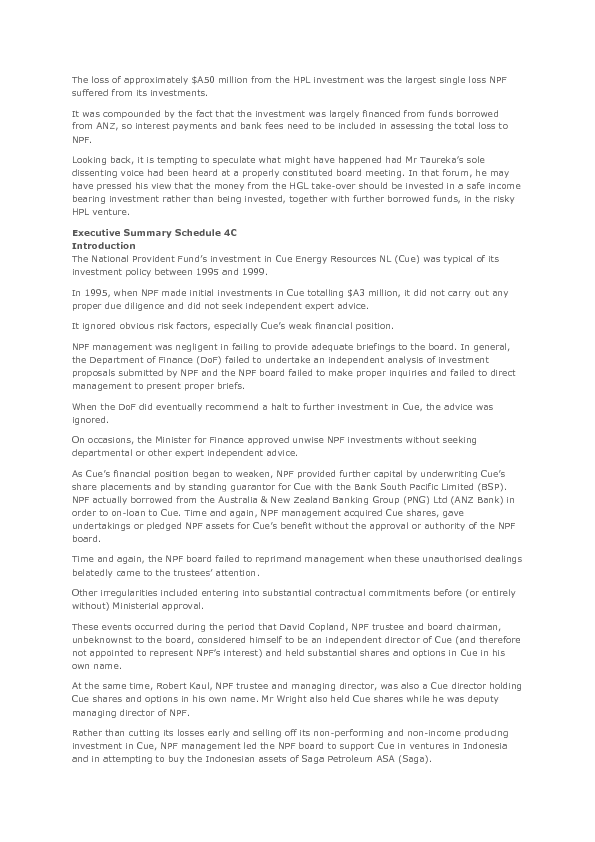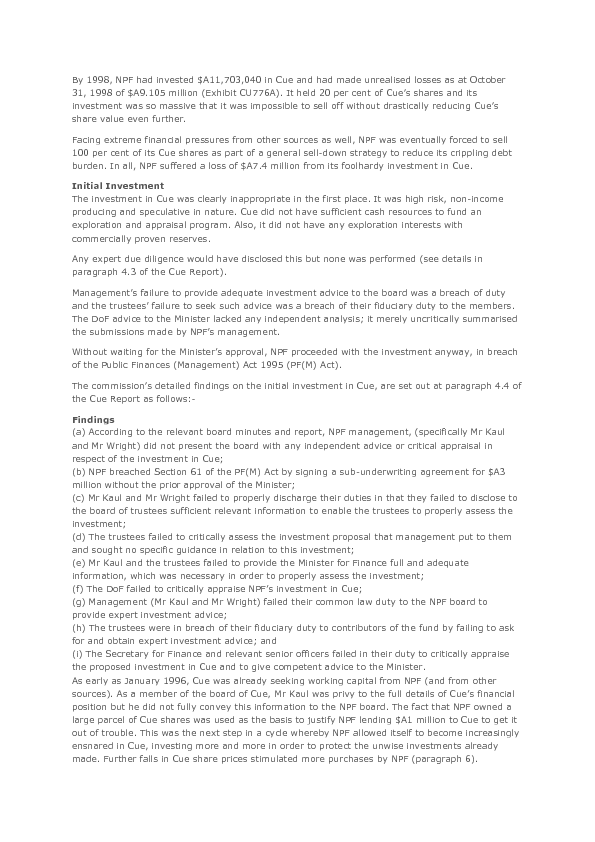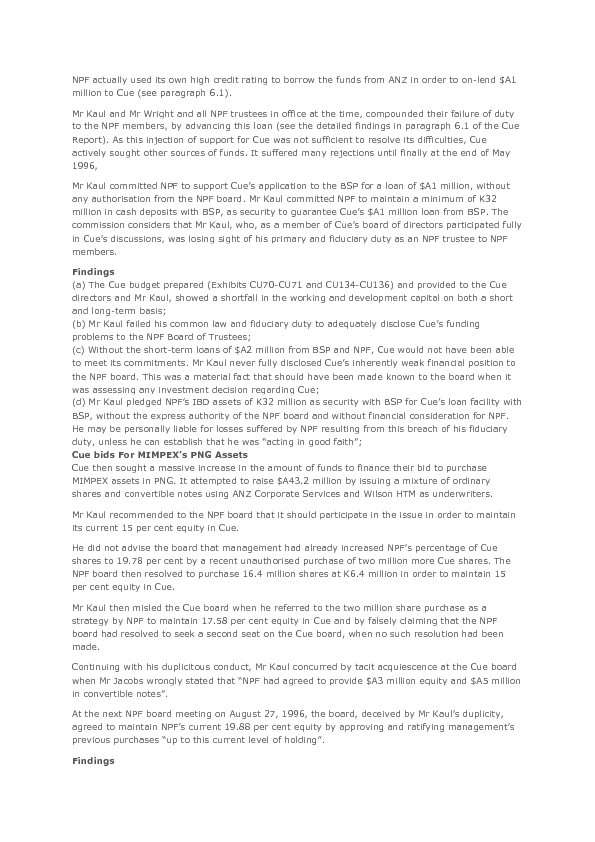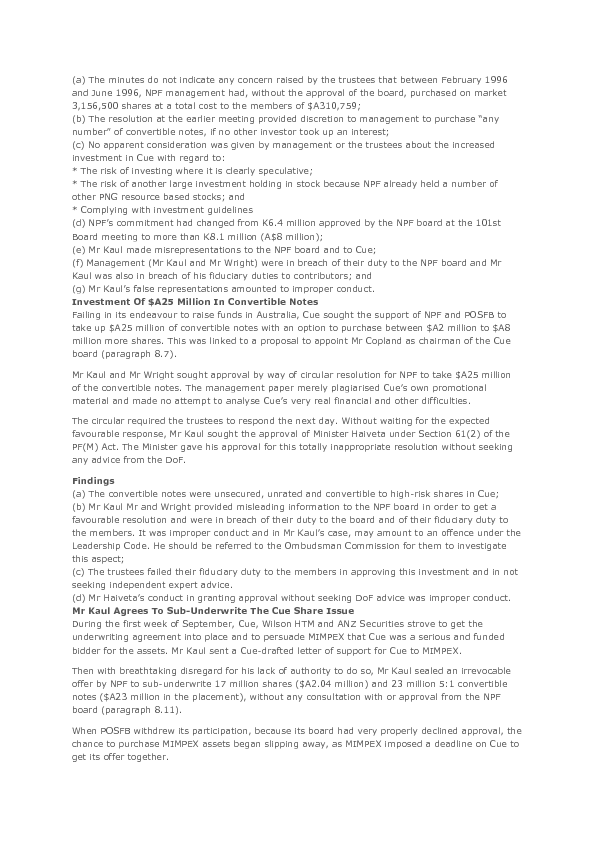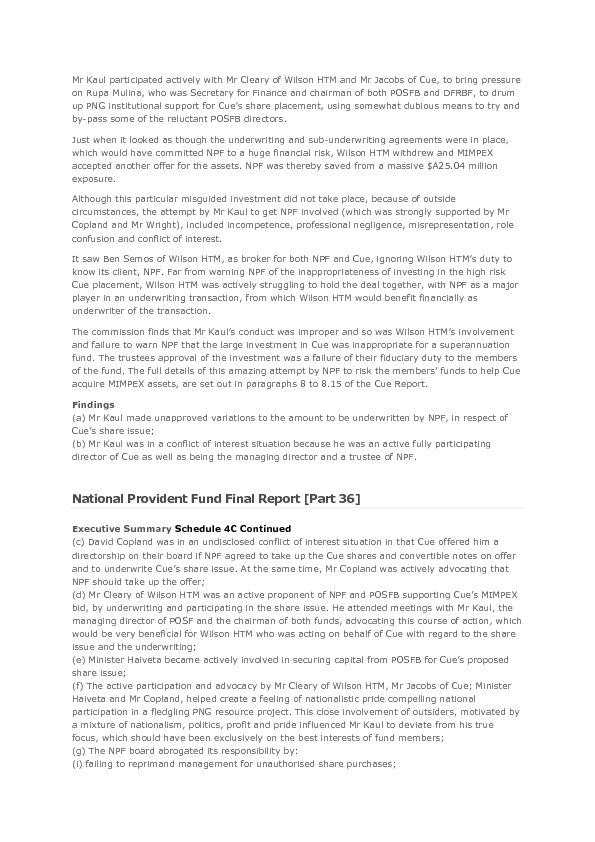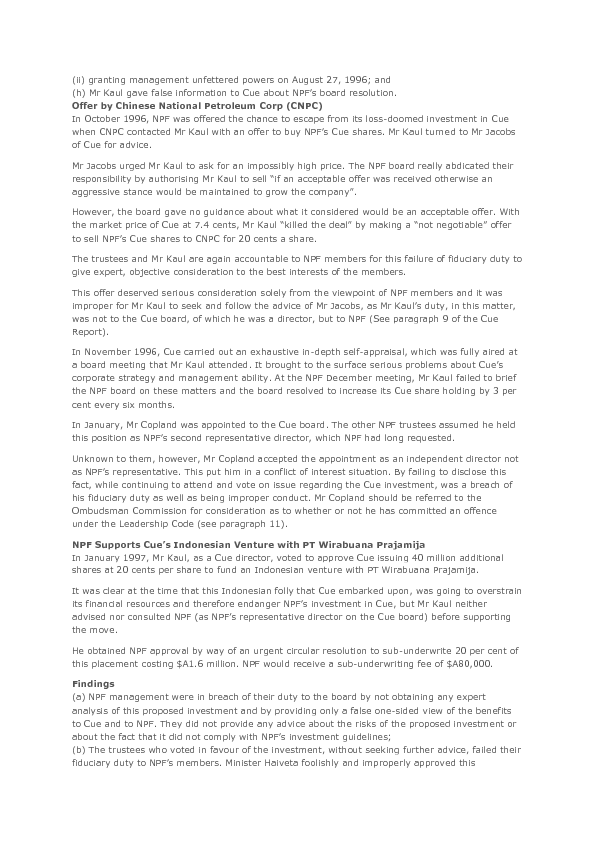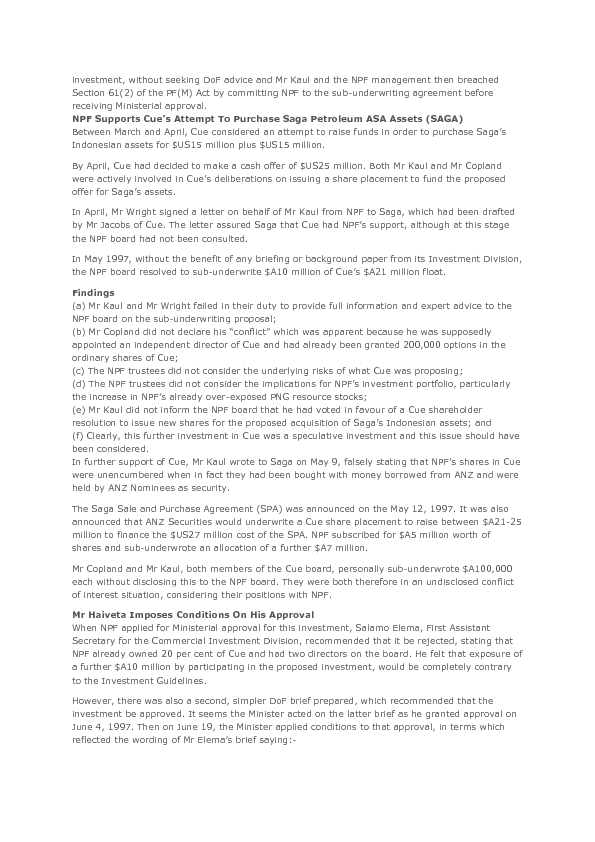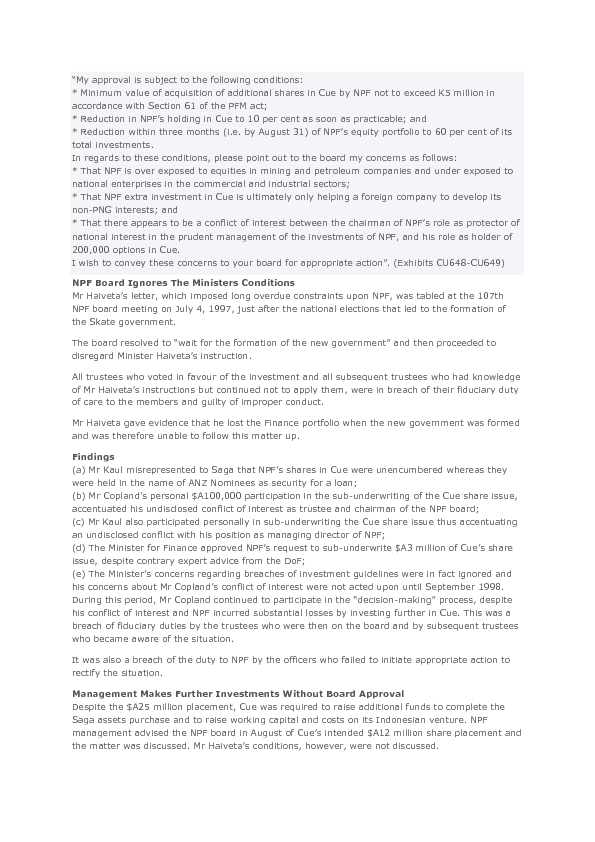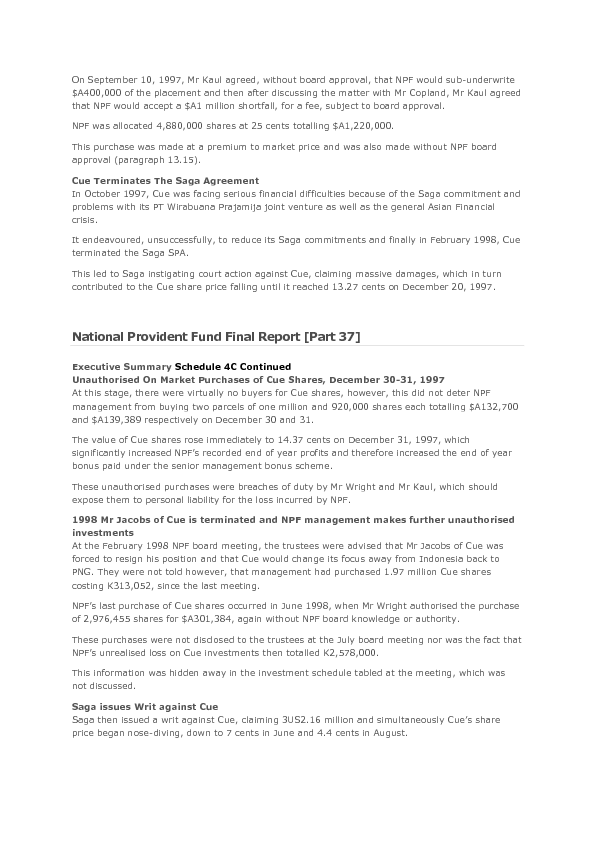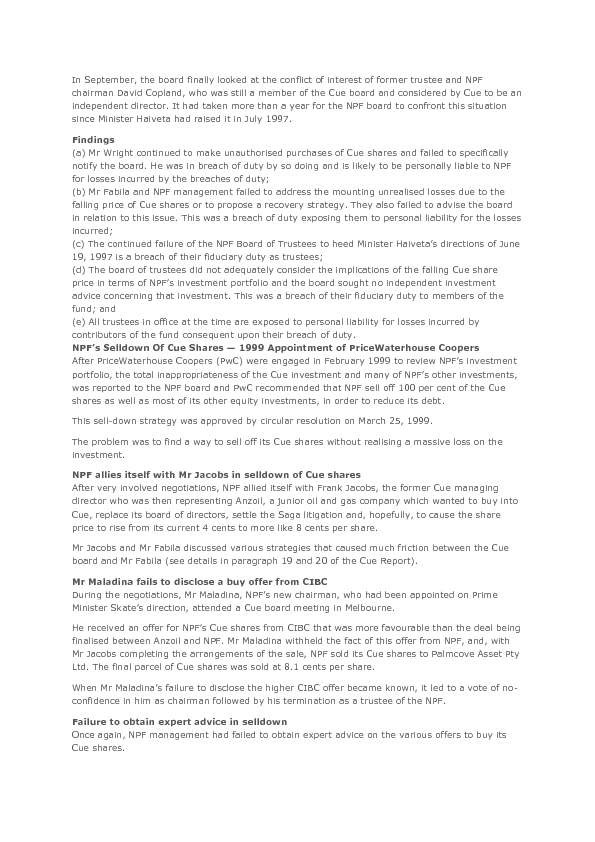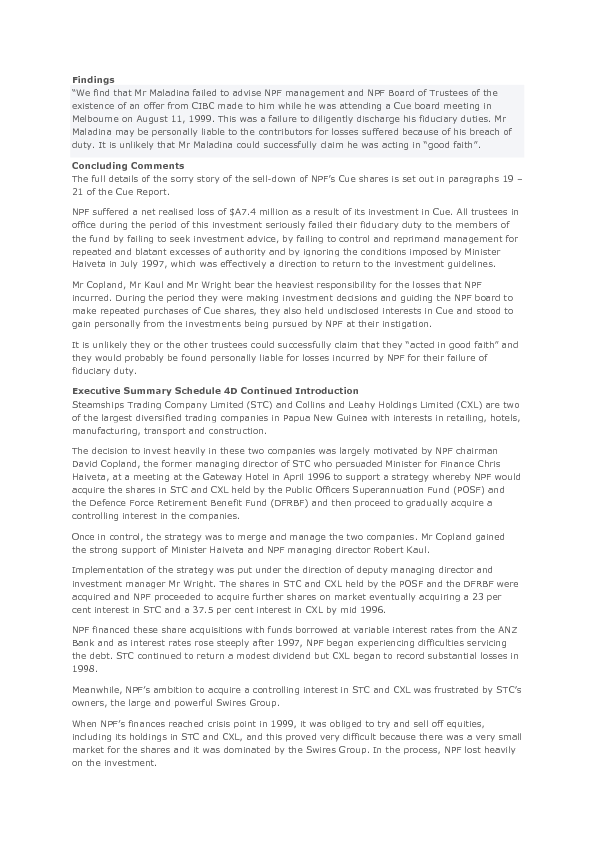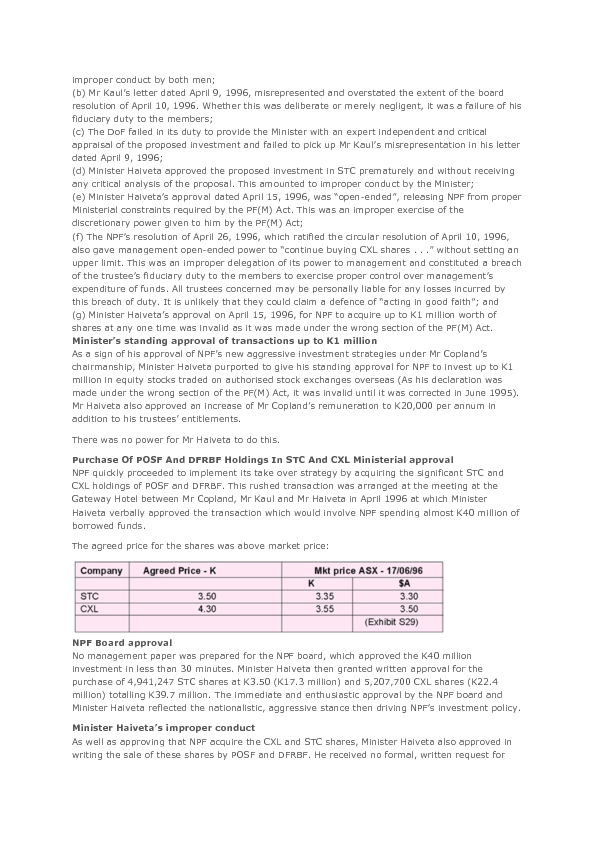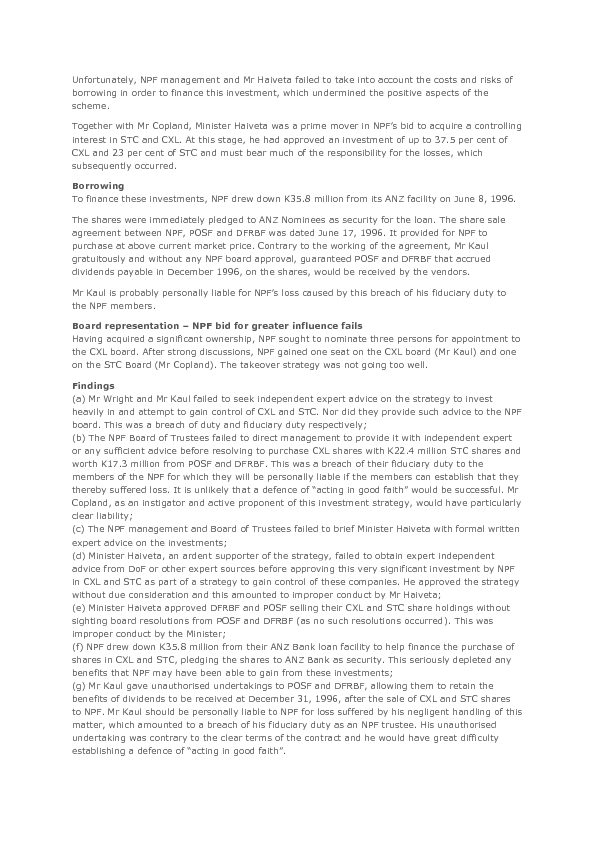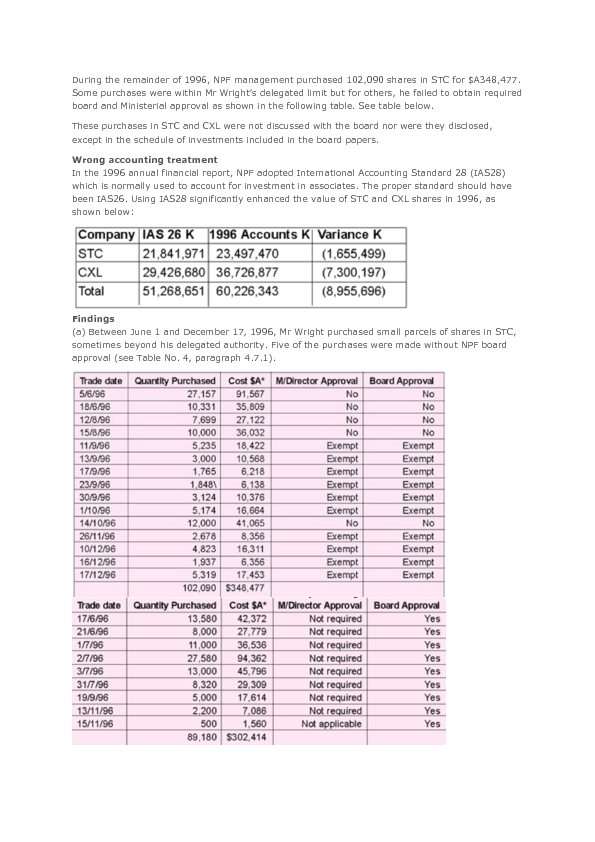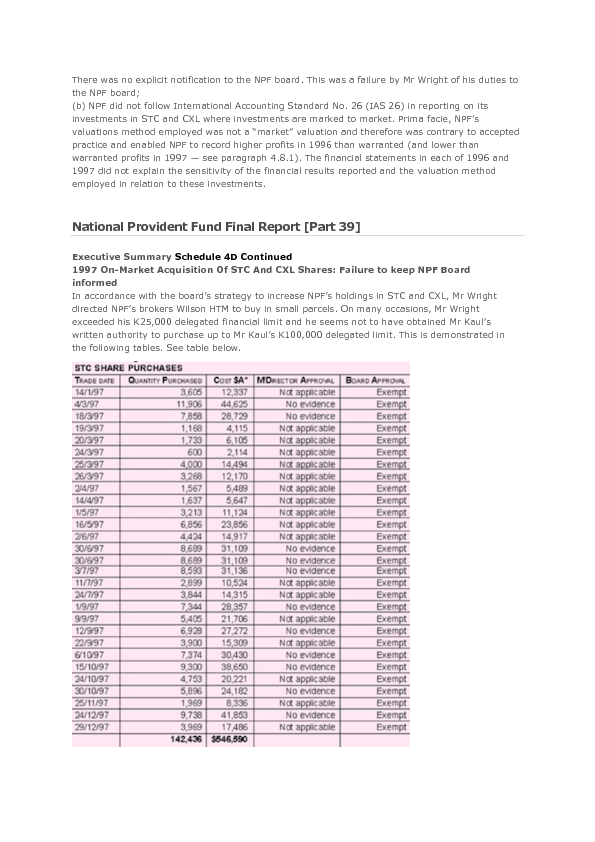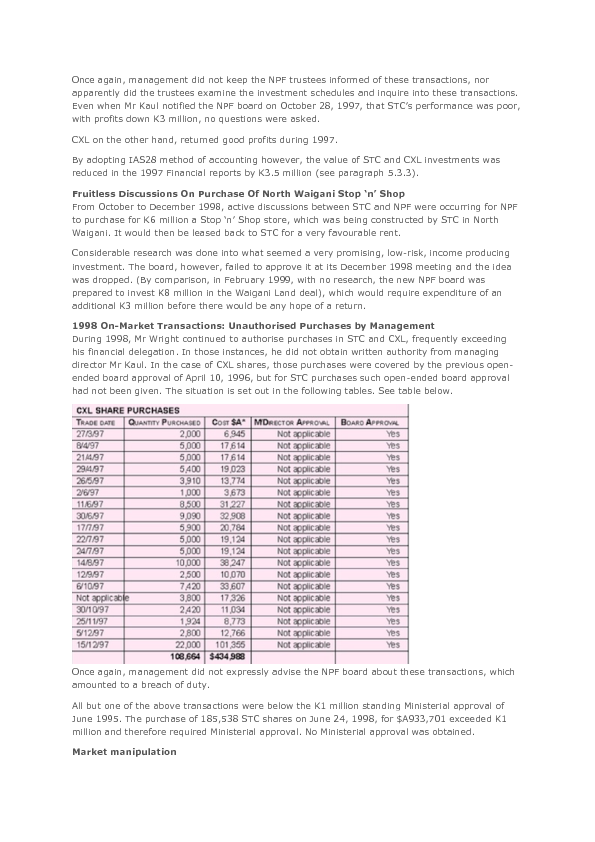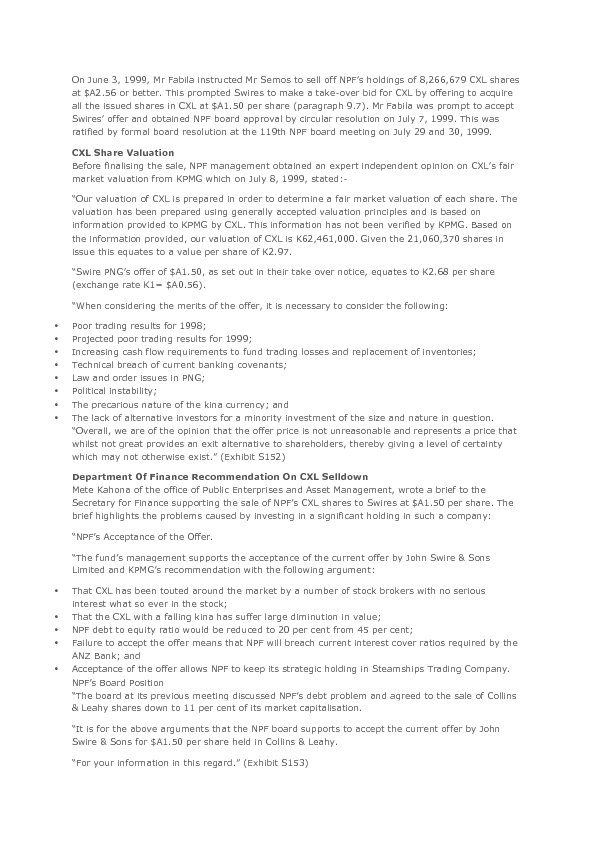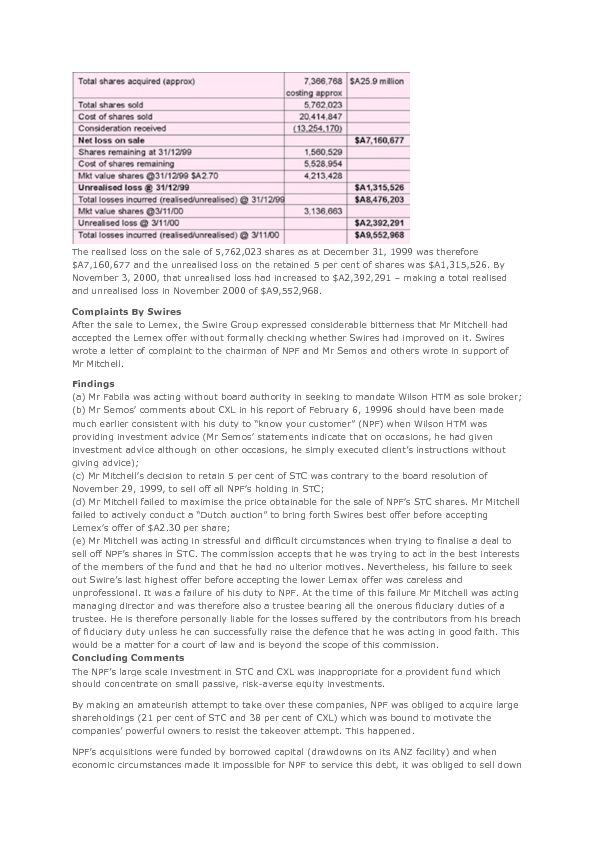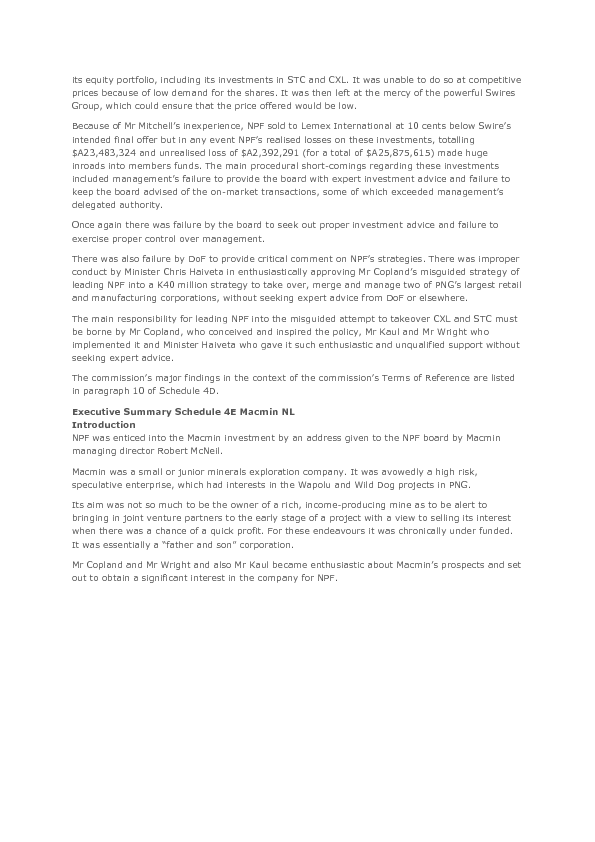National Provident Fund Commission of Inquiry Final Report (Serialization Parts 1-40)
Mentions of people and company names in this document
It is not suggested or implied that simply because a person, company or other entity is mentioned in the documents in the database that they have broken the law or otherwise acted improperly. Read our full disclaimer
Document content
-
National Provident Fund Final Report [Part 1]
SUMMARY OF EVENTS – 1995-1999 Pre 1995 – background The NPF commenced operations in 1980. After troubles with the management of the fund in the late 1980’s involving unauthorised expenditure by management and serious cost blowouts, the management of operations and investments was contracted in 1988 to Niugini Asset Management, a subsidiary of McIntosh Securities Ltd for a five-year period.
At the end of the contract period in 1993, the period of external management ceased and NPF carried on as a self-managing entity. According to the Five-Year Development Plan 1995-99 (Schedule 1, paragraph 6.1) the Niugini Asset Management regime had stabilised the fund and introduced good corporate governance, with management reporting properly to the NPF Board and being properly supervised by the board.
It had been intended that senior management positions would be staffed by experienced expatriates tasked with training nationals as middle-level management to replace them when ready.
NPF was unable to recruit and hold the expatriate senior managers. In July 1993, Robert Kaul was appointed as managing director with expatriates Brendan Kelly and Jeffery Bunn as general manager and operations manager, respectively.
Noel Wright, a former employee of Niugini Asset Management, stayed on as finance and investment manager. The chairman of the board was the experienced secretary of the DoF, Gerea Aopi.
The other members of the management team were Herman Leahy as corporate secretary/legal counsel and the following inexperienced officers, Ian Tarutia (assistance compliance manager), Nellie Andoiye (assistant operations manager) and Salome Dopeke (assistant finance and investment manager).
Appointment of new management team — 1995 This team did not last because Mr Kelly and Mr Bunn departed the NPF before the end of 1995. Mr Wright was soon promoted to deputy general manager and Mrs Andoiye, Ms Dopeke and Mr Tarutia were promoted into senior management positions for which they did not have the training, skills or experience. Mr Aopi ceased to be Secretary of the DoF and chairman of NPF on October 3, 1995, and was succeeded in both roles by Rupa Mulina on October 4, 1995. Mr Mulina preferred not to act as chairman of the NPF (perceiving a conflict of interest in the two roles of Secretary of the DoF and chairman of the NPF Board).
Mr Mulina agreed to be replaced as chairman by Evoa Lalatute who was irregularly appointed by Minister Chris Haiveta on January 11, 1996 (Schedule 1, paragraph 4.3.3.2.1 and paragraph 1 in Appendix 1). Mr Lalatute chaired only one meeting before his appointment was revoked by Minister Haiveta who wished to appoint Trustee David Copland as chairman.
DoF Secretary Mulina gave evidence that he co-operated willingly and nominated Mr Copland as chairman and this was promptly approved by Minister Haiveta on April 18, 1996 (Schedule 1 paragraph 4.3.4.1 and Appendix 2, Paragraph 2).
1996 team with Mr Copland as Chairman Thus, by April 18, 1996, the key players in the management of the NPF were Mr Copland (former managing director of Steamships Trading Company Limited (STC) as chairman of the Board of Trustees, Mr Kaul as managing director, Mr Wright as deputy general manager/ investment manager and Mr Leahy as corporate secretary/legal counsel.
-
Page 2 of 196
-
This team had a close relationship with Minister Chris Haiveta, who frequently used an office in the NPF premises (The names of the Trustees at any time can be ascertained from the table set out at paragraph 5.1.1 above) or from the graph at Schedule 1, Appendix 22 (Also at Appendix of this report).
Prior to this date, NPF was following a conservative investment strategy and its only borrowing was that it operated on a K6.5 million-overdraft facility granted by the PNGBC (Schedule 2A, paragraph 2.4). There was no power for NPF to operate on overdraft and this overdraft had never been disclosed to or approved by the NPF Board. See the opinion of Allens Arthur Robinson at Schedule 2E, Appendix 6 referred to at Schedule 2E paragraph 14.6 and the Commission’s findings at Schedule 2E paragraph 18.3.
New investment strategy approved by Minister Haiveta The new NPF team of Mr Copland, Mr Kaul, Mr Wright and Mr Leahy prepared a strategy to increase the growth of the fund by investing in PNG resource stock, which could be sold off profitably to make a tax-free capital gain.
They also determined to take advantage of an imminent sale by the Defence Force Retirement Benefits Fund Board (DFRBF) and POSF of their holdings in STC and CXL.
This strategy was devised in order to take advantage of existing market and interest rate conditions and with a nationalistic but misguided intention to enable Papua New Guineans to be able to participate (through their NPF membership) in the resource companies with interests in PNG.
The intention was to obtain significant holdings in some of the smaller companies, so as to acquire seats on their boards and a massive holding in STC and CXL, in a bid to take them over and amalgamate and manage them as one company.
This latter aim was related to Mr Copland’s personal agenda, which was rooted in the circumstances of his departure from his former position at STC.
Rather than selling NPF’s holdings in IBD’s (which were then producing a good investment return) they opted to fund the proposed purchases of PNG equities by massive borrowings from the commercial banks, as interest rates were then favourable.
Utilising borrowed funds for this purpose had been discussed previously in 1994 and Mr Leahy had then given totally wrong advice that it was within NPF’s power to borrow (Schedule 2A paragraph 2.2).
There seems to have been no consideration that interest rates on borrowed capital might rise or that share prices might fall.
The strategy was discussed with an enthusiastic Minister Haiveta who gave immediate verbal approval at a meeting at the Gateway Hotel in April 1996.
Formal board approval was given on May 30, 1996, with no briefing papers for the board and little discussion. This was followed by immediate ministerial approval by Mr Haiveta, who did not seek the advice of the DoF. In this way, with little thought and no expert advice, the NPF board and Mr Haiveta approved the use of funds borrowed illegally from the ANZ Bank to purchase K39.7 million worth of shares in STC and CXL.
It was improper conduct for which the Commission has recommended that Mr Haiveta and the NPF Trustees in office at the time, should be referred to the Ombudsman Commission to investigate whether there has been a breach of the Leadership Code (Schedule 4D, paragraphs 4.4.1 to 4.4.6). Borrowings-based investments
-
Page 3 of 196
-
During the rest of 1996 and 1997, the NPF proceeded to increase its borrowings in order to invest in PNG resource stock and in STC and CXL.
It also invested in unlisted companies such as Crocodile Catering (Schedule 4L), BSP (Schedule 4J) and made investment loans to the State to fund the Poreporena Freeway (Schedule 7B) and Eda Ranu (Schedule 7C). In 1997, NPF borrowed K50 million from the PNGBC to construct the NPF Tower (increased to K59 million in 1999 – Schedule 2B, paragraph 13.15).
Although a few of these investments were moderately successful (namely, Schedule 4H, OML and Schedule 4F, NML) most of them resulted in massive losses for the NPF.
Failures of management Throughout the period 1995-1999, common features of the equity investments included management’s failure to keep the NPF board informed of its activities and management making decisions in excess of their delegated authority.
Management made many investments without ever specifically advising the Board of Trustees.
The main responsibility for such matters lies with the managing directors, Mr Kaul and Henry Fabila and with the deputy general manager and investment manager Mr Wright, all of whom committed frequent breaches of their fiduciary or common law duties. These events are chronicled in detail in the relevant Schedules to this Report.
Failures of the Trustees The trustees must also bear responsibility for failing to oversee and control the management. Even when the trustees were eventually informed of management’s unauthorised activities, they failed to criticise or reprimand.
Also, had they bothered to examine the schedules of investments tabled at each board meeting, the trustees could have ascertained what was going on. Their failure to do so was a breach of their fiduciary duty to the members.
Failure to report and breach of investment guidelines NPF was bound by Section 26(1) of the NPF Act to invest its funds only in accordance with the 1993 Investment Guidelines, as varied by Minister Haiveta in April 1996 (regarding overseas investment in equities listed on a stock exchange up to K1 million per transaction) (Schedule 1 paragraph 8.4 and Appendix 21). The NPF was also bound by Section 63(2)(b) of the PF(M) Act to maintain, update and report annually on a Five-Year Rolling Development Plan. It was also bound to report quarterly on all investment decisions and on investment performance annually (Executive Summary 1, paragraph 10). The NPF management and Board of Trustees failed to meet any of these requirements.
Adhering to no expressed investment policy, NPF seems to have merely followed the gambler investor’s instincts of Mr Wright and Mr Copland and invested many millions of illegally borrowed funds in high-risk, volatile, non-earning PNG resource stock. It did this without independent expert advice. The advice it sometimes received from its share broker, Wilson HTM, was not independent, as Wilson HTM was itself benefiting from NPF’s high-risk buying spree (Schedule 4B paragraph 7.6).
NPF management and trustees completely lost sight of the investment guidelines, as can be seen from the graphs and working documents appended to Schedule 1 as Appendix 24 NPF’s portfolio changed alarmingly from having only 8 per cent of its portfolio invested in high-risk equities in 1994, increasing to 20 per cent in 1995 which had risen to 58 per cent in 1996, 64 per cent in 1997 and 60 per cent in 1998.
During the same period, debt as a percentage of net assets rose from 5 per cent in 1994 to 70 per cent in 1998. By that stage, because of NPF’s heavy illegal borrowings, the debt to equity ratio was 69.9 per cent.
-
Page 4 of 196
-
There was one fleeting attempt by managing director Mr Kaul to raise the awkward question of the disregarded Investment Guidelines in April 1996 (Schedule 1 paragraph 12.3.7).
This warning was simply ignored by Mr Copland and Mr Wright, except that at the 104th board meeting in December 1996, the board resolved to seek amendments to the investment guidelines to distinguish between long term and speculative investments (paragraphs 12.3.2.1 and 12.3.7.3).
It did not bother them that their expenditure of NPF funds on investments which were outside the investment guidelines, was illegal and was also a breach of their fiduciary duty as trustees, for which they could be personally liable. When William (Bill) Skate replaced Sir Julius Chan as prime minister in July 1997, Iairo Lasaro also replaced Mr Haiveta as the Minister responsible for the NPF.
Financial crisis looming in 1998 By early 1998, there were signs that NPF was in financial trouble because of the extreme imbalance and volatility of its investment portfolio, its falling value and the increasing burden of the interest being paid on the loans.
The chronic weaknesses in NPF’s governance continued with management under the control of Mr Kaul continuing to make significant decisions beyond their delegated powers and still failing to keep the NPF board properly informed on borrowings and investments. The trustees continued to give undue deference to chairman Copland and deputy managing director Noel Wright and failed their fiduciary duty to maintain supervision over management.
As reports by the Auditor-General, PwC and KPMG (See Schedule 1 paragraphs 10.5.2 to 10.5.8) demonstrate, senior management was incompetent and failing in the basic duties of maintaining a proper system of accounts, maintaining proper records of member’s contributions and administering proper procedures for acquiring goods and services and disposing of assets (Schedule 1 and Schedule 9). There were also gross abuses of the payments of board fees and allowances (Schedule 1 paragraph 5.3.7 and 5.3.7.1 and Appendixes 16 and 19 referred to where irregularities are described in detail regarding Trustees and officers). Appointment of Mr Skate’s protégé Henry Fabila as Managing Director In May 1998, Prime Minister Skate arranged for his good friend and former colleague at the National Capital District Commission (NCDC) Henry Fabila to replace Mr Kaul as managing director, thereby invoking a substantial wrongful termination payout (Schedule 1, paragraph 4.4.1.5). Although Mr Fabila had experience as a former banker and public administrator, he did not succeed in injecting strict rules of governance and accountability into the NPF. He found himself powerless to control his deputy Mr Wright and unable to work with Mr Wright’s protector, chairman Copland.
Together with Mr Leahy, he set about obtaining the removal of both men. Mr Fabila was also beholden to Prime Minister Skate for his job, which compromised his independence as managing director and trustee of the NPF.
Meanwhile, the economic tide had turned well and truly against NPF. As described in executive summary 2E paragraph 13 and Appendix 5, the value of NPF’s substantial concentration of investments in PNG resource stock was tumbling, the interest rates were rising and the value of the kina was falling.
NPF had used borrowed funds to acquire its risky equity portfolio and was obliged to pledge more and more of its assets to the banks as security for its increasing debt burden, as it had undertaken to maintain a very high ratio of security to debt with the banks (This is described in detail in Schedule 2E, paragraphs 3.2; 5 and 6).
Banks seek to call in NPF’s debts – 1998
-
Page 5 of 196
-
The ANZ was becoming alarmed at the increasingly frequent breaches by NPF of its loan covenants and was demanding that NPF reduce the debt. The Asian economic crisis was in full swing and NPF had encumbered itself with the huge NPF Office Tower construction project, funded by a K50 million loan from the PNGBC. The project struck time-consuming trouble with the beneath ground foundations (Schedule 6, paragraphs 4.1-4.9 and executive summary 3.2) and chose to pay a K1.4 million acceleration payment to make up the lost time. Then the falling kina eroded into the profits of the construction company Kumagai Gumi Co Ltd (Kumagai), leading to a K6.6 million kina devaluation claim, which was settled by agreement at K3.3 million.
As the construction costs mounted and the completion date blew out, NPF was faced with the fact that it had not secured in advance a single tenant and the demand for office space in Port Moresby was contracting with the economic crisis (The final cost of the Tower was K59.68 million).
With the lender banks turning hostile towards the end of 1998, Mr Wright desperately sought to bring his impractical and misguided attempt for NPF to issue a $A54 million bond to completion, so as to raise much needed cash (Schedule 2F and see paragraph 9 below).
Dismissal of Mr Copland and resignation of Mr Wright In September 1998, Mr Fabila’s attempt to rid himself of Mr Copland as chairman succeeded and he was terminated because he had long ago ceased to be an employer in PNG and was therefore no longer qualified to be a trustee. He was succeeded by Brown Bai, the newly appointed Secretary of DoF, as chairman. At the 115th NPF board meeting on November 6, 1998, the new chairman, Mr Bai, jolted the NPF management and trustees out of their apparent stupor by asking if they knew what they were doing.
He asked how they intended to tell the members of the mounting losses then believed to be in excess of K40 million. The NPF Tower was incomplete and was suffering cost overruns. There was a cash crisis and Mr Wright was failing to bring the unworkable $A54 million bond to fruition. Mr Copland had gone and Mr Wright was forced to resign in January 1999.
Also in January 1999, at Mr Bai’s instigation, PwC was commissioned to report upon NPF’s financial situation. Paul Marshall of PwC soon told the NPF board about the disastrous imbalance in the investment portfolio. NPF was trapped in a vicious circle caused by the tumbling value of its equity portfolio (which required more and more scrip to be pledged as security for the bank loans) and the rising interest rate burden on NPF’s massive debts to the banks, then running at more than K1 million per month.
Even before his report was published, Mr Marshall was proactively negotiating with the banks and this led eventually to the commencement of the massive selldown of NPF’s assets agreed to by the NPF board by circular resolution in March 1999.
While these attempts to save the financially stricken NPF were under way, others had a very different agenda.
Appointment of Jimmy Maladina as Chairman of NPF orchestrated by Prime Minister Skate — January 1999 Prime Minister Skate had already decided to have Jimmy Maladina appointed as chairman of the NPF and this was known to both Mr Maladina and Mr Leahy by September 1998.
The NPF Tower and Waigani land frauds In December 1998, Mr Maladina contacted Mr Tanaguchi of Kumagai, the NPF Tower construction company and put in motion a scheme, using that company, to defraud NPF of K2.5 million. In December 1998, Mr Skate directed Mr Bai to stand down as NPF chairman and nominate Mr Maladina in his place. This was done and Mr Maladina was appointed chairman on January 27, 1999.
-
Page 6 of 196
-
Together with Mr Leahy, they immediately arranged (by trickery) for the NPF board to reverse its previous decision and it resolved to purchase the Waigani Land (by purchasing shares in Waim No. 92 Pty Ltd which held the lease). This would bring a fraudulent profit of several million kina to Mr Maladina who secretly owned the shares in Waim No. 92 Pty Ltd. Thus, even prior to his appointment to the NPF board, Mr Maladina, in criminal association with NPF’s legal officer/corporate secretary, Mr Leahy, was involved in two attempted frauds against the NPF, concerning the NPF Tower (Schedule 6) and the Waigani Land (Schedule 5) both of which are reported upon at paragraphs 15.11 and 15.12 respectively, below. When news of the proposed sale of the Waigani Land to the NPF broke in the national press, Prime Minister Skate publicly forced the NPF to pull out of the deal.
Full extent of NPF’s financial crisis emerges In February 1999, NPF engaged PwC to review its investment portfolio. In March, PwC reported on the volatile imbalance of NPF’s high-risk portfolio and the burden of the heavy borrowings.
PwC was engaged to address the cash flow crisis and by mid-March, was discussing selldown of assets with the banks. The selldown strategy was approved by circular resolution and began immediately.
The conspirators, meanwhile, were trying to sell 50 per cent of the NPF Tower to the PNG Harbours Board (PNGHB), thereby hoping to make a fraudulent commission (through Maurice Sullivan of PMFNRE) of 5 per cent aggregating K5 million (see Schedule 6, paragraph 13.1.4 and paragraph 15.11.1 below). By mid-year, Rod Mitchell had been appointed as general manager in place of Mr Wright, and John Jeffery had been newly appointed as a trustee. They were in close contact with Mr Marshall of PwC. Mr Bai, as Secretary of DoF, appointed a team of finance inspectors to inquire into the financial affairs of the NPF and to look at worrying aspects of the proposed Waigani Land deal, which were becoming public knowledge. To start with, Mr Fabila and Mr Leahy failed to co-operate with the finance inspectors, until threatened with serious consequences by Mr Bai.
Around this time, the balance of power and the atmosphere at NPF headquarters began to change.
A second PwC report was commissioned and the finance inspectors report was published and Mr Mitchell and Mr Jeffery raised questions about Mr Maladina and Mr Leahy in September 1999.
At an October meeting of the NPF board, Mr Mitchell and Mr Jeffery tabled a special report on many irregularities, including the Waigani land deal. Mr Maladina sought, unsuccessfully, to block the meeting and did not attend.
Complaints levelled at Mr Maladina and Mr Leahy Serious charges were levelled at both men, especially about their part in the Waigani land affair. This led eventually to the termination of their appointments as corporate secretary and chairman of NPF respectively. To conclude matters, KPMG were appointed by the Auditor-General to carry out an audit and report on the NPF as there was talk about a forced 50 per cent write down of members’ assets.
Assets selldown amidst confusion The selldown of assets was completed at huge realised losses to NPF in the vicinity of K150 million. As 1999 drew to a close, NPF, with Mr Fabila as managing director, was in a state of confusion and near bankruptcy. It closed down Crocodile’s Maluk Bay operation without providing a caretaker budget for the assets.
While trying to sell off assets to raise much needed cash it nevertheless continued to try and finance the doomed Ambusa Copra Oil Mill project under Mr Mekere’s insistence (Schedule 4N) and unexpectedly purchased a new motor vehicle fleet (Executive Summary 9, paragraph 2.6).
-
Page 7 of 196
-
Gradually, Mr Mitchell brought financial reality to the fore and was appointed as managing director to replace Mr Fabila on July 17, 2000.
Establishment of Commission of Inquiry Amidst great disturbance, among NPF members and significant political unrest, Sir Mekere Morauta then established this Commission of Inquiry into the affairs of the NPF in accordance with the Terms of Reference published above at paragraph 2.1, which include a requirement to recommend structural reforms.
Superannuation Taskforce Without waiting for the commission to report, the Prime Minister set up a Superannuation Taskforce to make recommendations for a new Superannuation Act. The commissioners, counsel assisting and consultants held consultations with the taskforce and the commission provided a forum by way of a seminar on the structural reform of NPF where there was a very good exchange of ideas by people with experience in the affairs of NPF and superannuation generally.
The taskforce recommendations led to the drafting of the Superannuation Bill 2000, which was enacted into law, coming into force in 2002. The commission is in general agreement with the provisions of the new Act as discussed at Schedule 1, paragraph 21.
Attempts to “cover-up” Mr Maladina’s offences and interfere with the Inquiry During the commission’s investigations into these two frauds in 2000, there were attempts made to “cover-up” the activities of Mr Maladina. These involved two lawyers, Simon Ketan and Jack Patterson, who, at Mr Maladina’s instructions, fabricated documents and removed documents from files, which had been summonsed by the commission. Both admitted the offences and have been referred to the Commissioner of Police for investigation. David Lightfoot and Barbara Perks, both of Carter Newell Lawyers, have also been referred to the Commissioner of Police to investigate their possible role in this “cover-up”. Possible similar scams to defraud other PNG institutions While investigating these matters and while examining bank accounts of the companies and persons involved, the commission located evidence that other very large sums of money were being “laundered” during that period through the books of Carter Newell and PMFNRE and that similar scams involving the Investment Corporation, the PNG Harbours Board and the DFRBF were occurring. The commission is aware and has taken judicial notice of the fact that this was the period leading up to the time when a vote of no-confidence against the Prime Minister in the National Parliament would be possible under the law. It is usual that large sums of money change hands during such times in order to obtain support from members. There was evidence that “political camps” were established and that Mr Maladina was an active political organiser at that time. Perhaps, some of the moneys raised in the two frauds against the NPF were intended for political purposes, but the commission lacks the evidence to make such a finding.
A second Commission of Inquiry has been set up to investigate the funds lost from the DFRBF and the affairs of its chairman Kelly Naru, who is one of Mr Maladina’s fellow legal partners in Carter Newell lawyers (now Pacific Legal Group).
National Provident Fund Final Report [Part 2]
Sale of the Waigani Land and tracing the proceeds The commission investigated the subsequent sale of the Waigani land to a Rimbunan Hijausubsidiary company by sale of shares in Waigani City Centre Ltd (formerly Waim No.92) and reported upon further corrupt procedures and crimes in the Lands Ministry and the Lands Board involving Dr [Fabian] Pok, Mr [Ralph] Guise and Mr [Jimmy] Maladina, for which all have
-
Page 8 of 196
-
been recommended for referral to the Police and the Ombudsman Commission (See Schedule 5, paragraph 31.4 and the list of referrals below at paragraph 15.6). The commission also traced the way the moneys obtained by the NPF Tower fraud were “laundered” through the books of Carter Newell and PMFNRE. This showed up the involvement of Peter O’Neill as one of those who benefitted from the Waigani Land and NPF Tower frauds.
The investments that caused the greatest losses and those which illustrate outstanding examples of corporate maladministration will be examined briefly below in paragraph 10.
BORROWINGS Commissioner Manoa’s conflict of interest From the mid 1990s to 2000, Commissioner Manoa was a member of the Board of ANZ. He declared this to the commission at a public hearing on August 9, 2000 (Transcript p.1352) and thereafter took no part in hearing or deliberations involving the ANZ.
Features of the borrowings Each of the main borrowings (from PNGBC, ANZ and BSP) is reported upon in the Schedules in category 2. The features common to all the borrowings include:-
(a) The banks failed to perform adequate due diligence and so entered into loan facility agreements without ascertaining that NPF lacked the power to borrow or to pledge its assets (Schedules 2A, 2B and 2C). ANZ eventually obtained this advice from Allens Arthur Robinson on May 26, 1999, (Schedule 2E paragraph 19.6 – Appendix 6).
Being ultra vires the NPF Act, the loans were invalid and it is doubtful whether interest was payable. As a result of the loans, which were advanced for specified purposes agreed between the banks and the NPF, money was spent on those purposes, interest payments were made and, during 1999, the NPF was obliged to sell off shares and other assets at a massive loss in order to repay the banks. This applied particularly to the ANZ, which obliged NPF to transfer share scrip as securities and to embark upon the big asset selldown.
It is possible that ANZ would be vulnerable to a suit brought by or on behalf of the NPF members directly for losses suffered by way of interest and bank charges and possibly for losses incurred as a result of ANZ’s pressure on NPF to sell off its assets at a loss (Schedule 2E see discussions at paragraph 11.2 and the criticisms of ANZ in paragraph 17).
The NPF Trustees were also in breach of their fiduciary duty to the members by entering the loan agreements with the various banks without obtaining independent expert advice about NPF’s power to borrow. They also could be liable to the members for losses suffered by their breach of duty (unless they can establish that they acted in good faith). If such an action was brought by the members as a class action against the NPF board, the bank could perhaps be joined as a third party (Executive Summary 2E, paragraphs 10.5, 13).
(b) On many occasions, management failed its duty to fully inform the board and seek approval before entering the loan facility agreements and before making drawdowns (Schedule 2A, paragraph 8.4,
Schedule 2E, paragraph 5.10 and paragraph 5.21 and 6.2). For instance, the PNGBC overdraft, which had risen to K6.77 million by 1998, had been in existence for several years before management made even partial disclosure of its existence to the board. In fact, its existence had been hidden in the NPF books of account by incorrect accounting procedures (Schedule 2A, paragraphs 4.1.9 & 4.3).
(c) There were several instances when loans were agreed or drawdowns were approved by the bank concerned without required ministerial approval (Schedule 2A, paragraph 9.3 and Schedule 2E, paragraph 5.15).
-
Page 9 of 196
-
(d) NPF management rarely kept the board informed about the state of the loan accounts (Schedule 2E, paragraph 5.10 failure to advise board of additional K20 million facility obtained from ANZ; Executive Summary, paragraph 8.5.1). It was normal, for instance, that ANZ managers had far more knowledge of NPF management’s plans and strategies for using the drawdowns than had been disclosed to the NPF Board.
(e) Mr [Noel] Wright frequently pledged large parcels of share scrip to banks as security without consulting or advising the NPF board (Executive Summary 2E, paragraph 8.5.1(d)). (f) The DoF was rarely consulted by NPF or the Minister and provided minimal input (Executive Summary 2E, paragraph 8.7.1).
(g) The ANZ’s review of the loan facilities extended to NPF were often superficial, without considering obvious risk factors (Executive Summary 2E, paragraph 8.10).
ATTEMPT TO ISSUE $A54m BOND Management fails to advise NPF Board about negative expert advice
In October 1997, Mr [David] Copland and Mr Wright supported by then chairman Gerea Aopi, proposed issuing an $A54 million bond. If this happened, it would be the first such bond issue in PNG and NPF management lacked the necessary skills. It was also commercially impractical. Expert advice from Consultant Jacob Weiss, BPNG and the ANZ opposed the idea, believing NPF could lose heavily if the kina depreciated in value. Mr Copland and Mr Wright persevered, however, and gained the NPF board’s immediate approval of the idea on a simplistic board submission, without disclosing the cautionary advice from the experts. The board accepted the idea enthusiastically, without insisting on expert opinion. The dubious Canadian Jai Ryan (associated with Ambusa Sawmill) introduced an even more dubious Canadian Rudi Cooper, of Warrington International, a company registered in the tax haven of Antigua. Warrington became the proposed purchaser of the bond. Every inquiry and every step taken raised further suspicion about Warrington, which was pointed out by NPF’s international lawyer, Clifford Chance. However, Mr Copland and Mr Wright kept up the pressure to proceed with the bond. Governor of the BPNG intervenes under pressure For a while the BPNG delayed the scheme when its Foreign Exchange Controller Benny Popoitai withheld essential approvals. This blockage was removed when Mr Copland, using his influence as a former director on the BPNG board, approached the Governor of the BPNG Mr Taratadirectly and applied pressure. Mr Popoitai was then overruled by the Governor, who signed the approval papers himself (Schedule 2F, paragraphs 14.15, 13.1 and 13.2). Similar pressure was later brought successfully on Mr Tarata’s successor as Governor, John Vulupindi, when NPF was seeking an extension of the approval given by Mr Tarata (Schedule 2F, paragraph 14.15). Mr Wright acts without authority Negotiations to complete the agreement with Warrington proceeded for many months. During this process, Mr Wright frequently exceeded his authority in his desperate endeavours to complete the deal (He needed the money to pay outstanding interest on NPF’s debts and to provide more securities for the banks). Mr Wright’s unauthorised actions included- • Approaching Nara Investments (Mr Ryan) and granting a 5 per cent commission (Schedule 2F, paragraph 6.1); • Paying Mr Ryan an unauthorised advance of $US15,000 (Schedule 2F, paragraph 6.3); • Assuring Warrington that its profits would be tax free and giving a guarantee that NPF would itself meet any tax liability imposed on Warrington • Offering NPF share scrip worth $A77 million as security for the bond (Schedule 2F, paragraph 11.3) and transferring share scrip without authority (Schedule 2F, paragraph 14.3 & 14.8). Advised by Clifford Chance, NPF’s lawyers held out against Warrington’s pressure by insisting that an appropriate security guarantor must be found.
Brown Bai leads NPF to terminate negotiations
-
Page 10 of 196
-
When Warrington notified NPF it intended to assign NPF’s securities to a shady entity known as the RH Foundation of Anacirema, Mr Leahy and Mr Fabila confronted Mr Wright and Mr Coplandin an endeavour to have NPF withdraw from the negotiations. Eventually, on the eve of the signing of the agreement, Mr Bai, who had recently become chairman of NPF, guided the NPF board to terminate the agreement with Warrington at the 115th NPF board meeting on November 6, 1998. It had, however, been a wild and giddy ride and Mr Wright and Mr Copland almost succeeded in exposing NPF to a dubious international organisation, which may well have been involved in illegal activities and money laundering. Had the bond been issued, there seems no way that NPF could have met the $A54 million bond plus 14.67 per cent interest in nine years time. This would have endangered NPF assets.
Mr Wright, Mr Copland and Mr Leahy and all NPF Trustees at the time were in serious breach of fiduciary duty to the members of the Fund (See comments and findings Schedule 2F, paragraph 16 titled concluding comments and paragraph 17 which discusses the roles and responsibility of the major participants). Fortunately, it did not succeed but in the process it showed the BPNG can be moved by insistent lobbying. The attempt to issue the bond cost the NPF K244,762 in legal fees and a great deal of management time and effort.
The commission has found that Mr Wright was guilty of improper conduct by making false representation and by exceeding his authority on many occasions. There were numerous serious breaches of fiduciary duty by the trustees and by Mr Leahy, who failed to advise the trustees that NPF had no power to borrow or issue a bond and by Mr Wright for not passing on Gadens lawyers advice that NPF lacked the power to borrow. FUNDING THE STATE Occasions arose throughout the period under review when the NPF was called upon to provide money to the State to fund infrastructure projects and to meet other requirements or obligations of the State. Occurrences of this nature which the commission was asked to investigate were the:
• Loans to fund the Poreporena Freeway (Schedule 7B) • NCD Water and Sewerage loan (Schedule 7C) • K17 million Southern Highlands 4 Roads Project (Schedule 7D) and • Niugini Insurance Corporation K2 million loan (Schedule 7A). There was also a loan component associated with the transfer of former POSF members to NPF upon the corporatisation of Air Niugini, PostPNG Ltd and Telikom PNG Ltd. This was because the State was unable to fund its obligation to pay its unpaid employer’s contributions and, in effect, NPF “loaned” back the K24.4 million due to NPF at a commercial rate of interest (Schedule 8).
In each of these loan to the State projects, there were common features:
(a) The Government’s need was great and considerable political pressure was therefore applied to NPF to provide the funds.
(b) NPF had to borrow the funds from the commercial banks at a commercial rate of interest in order to be able to on-lend to the State.
(c) There were serious conflicts of interest when senior DoF officials made recommendations to the Minister advising the Minister to approve loans from NPF to the State. Both the Minister and the public servants had duties to consider the interest of the State as well as to the NPF.
The conflicts of interest were particularly acute for the Secretary of DoF, who was also the chairman or nominator of the chairman of NPF as well as being responsible for administering the finances of the State. Vele Iamo as Deputy Secretary for DoF and a very long time Trustee of the NPF had a similar conflict. (d) The loan arrangements and even the ministerial approvals were often put in place between DoF officers and NPF management prior to consultations with the NPF board.
-
Page 11 of 196
-
(e) NPF management failed to keep the NPF board properly informed and to always obtain board approval.
(f) NPF management and trustees failed to seek independent expert advice outside of DoF (which in these situations was biased in favour of the State and unable to give truly independent advice to NPF).
(g) There was a mismatch between the arrangements between NPF and the lending banks on the one hand, which were at variable rate of interest repayable at call and the arrangements between NPF and the State on the other hand, which were at a fixed interest rate for a fixed term of years. There was thus a potential risk for NPF if interest rates payable by NPF to the bank rose, as it would erode the profit on its fixed rate of interest from the State.
This potential risk eventuated and these “investment loans” became less and less profitable for NPF.
There was also the problem that the so called “road stock”, which NPF acquired through the Poreporena Freeway loans aggregating K62 million, were not readily assignable, as the State guarantee was not transferable.
(i) Because of Government pressure for NPF to provide funding in this way NPF distorted the balance of its portfolio in favour of this government “stock”.
(j) Despite these problems these investment loans were “safe” and provided a reasonable return, in marked contrast to most of NPF’s other investments.
Each of these loans to the State is reported upon in detail in a separate schedule. The executive summaries provide easy access to the schedules by stating main themes and giving references to relevant paragraphs in the schedules.
The transfer of members from POSF to NPF described in Schedule 8, raises many other issues as well as the issue of the loan which NPF was reluctantly obliged to provide.
The whole transfer process was badly planned and it started before basic political and administrative decisions had been made. The State had not been paying its employer contributions to POSF so members transferring to NPF were justifiably anxious about their entitlements and did not trust the State’s intention or ability to pay them. This stimulated demands for extra-legal payouts of entitlements under threat of industrial action. NPF was pressured by the Sate to agree to payouts to some employees, which were contrary to the NPF Act. This raised serious questions of improper political interference (Schedule 8, paragraphs 4.22, 4.22.1). Having reluctantly organised the lending of K24.4 million of borrowed funds to the State, NPF management was negligent in administering the loan, causing a loss of K4 million.
As further corporatisation of public institutions is likely, these issues need to be addressed. See concluding comments (Executive Summary 8, paragraph 33).
THE BIG LOSS-MAKING EQUITY INVESTMENTS — STC and CXL – Schedule 4D Acquisition of STC shares “on-market”:
NPF commenced to buy STC and CXL shares on-market in March 1996. The NPF board had approved by circular resolution, the purchase of K1 million worth of STC shares in 100,000 share lots for a price between $A2.85 and $A3 per share. Mr [Robert] Kaul, however, misrepresented this resolution and obtained Minister [Chris] Haiveta’s approval to buy one million shares at that price. He also failed to mention the limitation on the size of the parcels, which had been imposed by the board. Mr Haiveta approved the application without seeking or obtaining DoF or any other expert advice. Management then proceeded to buy one million shares in larger sized parcels. This was far more shares and at far greater cost than the board had authorised.
-
Page 12 of 196
-
The authorisation had been by circular resolution, which was not a valid means of decision- making. The purchase was not subsequently ratified by the board at a face-to-face meeting. This single approval demonstrated many of the faults which plagued NPF investments throughout the period:
(a) It was a risky and inappropriate investment.
(b) The NPF board approved the resolution by way of illegal circular resolution with little briefing by management and no expert financial advice.
(c) Management then misrepresented the limited nature of the board’s approval and obtained ministerial approval for the expenditure of a far larger sum
(d) Mr Haiveta neither sought nor received expert advice from DoF or elsewhere before granting the excessive approval. (e) Management then purchased the excessive number of shares at prices, which sometimes exceeded the maximum price approved by the board
(f) the circular resolution was not ratified by a subsequent face-to-face board meeting
(g) The NPF Board of Trustees did not criticise or reprimand management for failing its duty to the board by exceeding their authority
(h) BPNG foreign currency exchange approval was not obtained for all of the transactions (Schedule 4D, paragraphs 4.1 and 4.2).
Acquisition of CXL shares “on-market” Also in April, the NPF approved, by circular resolution, the purchase of up to K1 million worth of CXL shares. Again, Mr Kaul twisted the wording of the board’s resolution and obtained Mr Haiveta’s approval to buy one million CXL shares. This time the DoF did provide a recommendation to the Minister. However, it contained no critical analysis of NPF’s request but merely repeated the points made by NPF. Mr Haiveta then gave an open-ended approval for NPF to acquire CXL shares for prices between $A2.20 and $A2.50 in 100,000 share lots without setting a total purchase limit. Again, management acquired many more shares than authorised by the board for significantly more cost.
National Provident Fund Final Report [Part 3]
Approval to mount take-over attempt of STC and CXL In early April 1996, Mr [Robert] Kaul and Mr [David} Copland met with Minister [Chris] Haiveta at the Gateway Hotel (Schedule 4D, paragraph 4.4.1) and obtained the Minister’s instant verbal approval to mount a campaign to buy a controlling interest in STC and CXL and to then amalgamate and manage the two companies. This would require the expenditure of approximately K40 million of funds borrowed from the ANZ to buy the STC and CXL shares then on offer from the DFRBF and the POSF. Incredibly, the NPF board approved the purchase after only 30 minutes discussion. There were no briefing papers and the board took no expert advice.
The boards of DFRBF and POSF did not even meet face-to-face to discuss the proposed sale to NPF and Minister Haiveta approved the sales by DFRBF and POSF and the purchase by NPF without seeking or receiving DoF or other expert advice (Schedule 4D, paragraph 4.4.1). It seems the Minister was not even given a written brief on these transactions, which he had already approved verbally at the Islander Hotel. Both POSF and DFRBF approved the sale by circular resolution and Minister Haiveta gave his immediate approval without even waiting for a request.
-
Page 13 of 196
-
Clearly, Minister Haiveta was very proud of his achievement in promoting these transactions as demonstrated in his self-congratulatory letter to Prime Minister Sir Julius Chan on June 4, 1996, and in his explanation to Parliament on July 30, 1996 (Schedule 4D, paragraphs 4.4.5 and 4.4.6). Minister Haiveta’s improper conduct and referral The commission, however, finds that Minister Haiveta’s active role in these matters, his instant approvals and total failure to seek expert advice amounts to improper conduct and may constitute a breach of the Leadership Code. Similarly, the trustees who voted for this circular resolution to spend K39.7 million of borrowed funds, without seeking any independent expert advice, were guilty of a gross breach of their fiduciary duty to the members of the fund, for which they may be personally liable. Breach of fiduciary duties by all Trustees When considered together with their many other similar breaches of fiduciary duty, the commission has recommended that all trustees, with the exception of John Jeffery, who was only appointed late in 1999, should also be referred to the Ombudsman Commission to consider whether they were in breach of the Leadership Code (Schedule 1, paragraphs 10.5.5 & 18.5(c)). As trustees of the NPF board, they were subject, as leaders, to the Leadership Code. Some are still leaders in some other leadership position whereas some are no longer leaders. If any of the former trustees are being considered for subsequent leadership positions, however, their previous failure of fiduciary duty to the NPF members should be taken into account and assessed by the Ombudsman Commission. Continued “on-market” purchases without Board approval The NPF continued to purchase STC and CXL shares during 1997, often not informing the trustees.
In 1998, Mr [Noel] Wright continued to purchase STC and CXL shares on market. The STC purchases were frequently without board approval and totalled $A4.1 million. The CXL purchases which totalled $A793,839 did not require specific NPF board approval because of the its previous open-ended approval (Executive Summary 4D, paragraph 4.1). Referral of Ben Semos and Mr Wright to ASIC At Schedule 4D, paragraph 8.3, the commission recommends the referral of Mr [Ben] Semos of Wilson HTM and Mr Wright to Australian Securities and Investment Commission (ASIC) to investigate whether they acted to manipulate the share prices of STC and CXL. During 1997 and 1998, NPF was the major buyer of CXL and STC shares on the Australian Stock Exchange (ASX) and no doubt helped to maintain the price above its natural level (Schedule 4D, paragraph 8.3.3).
Mr Wright fails to review investment as share prices fall By July 1998, CXL performance was poor. At that stage, NPF owned 38 per cent of the equity in CXL.
Mr Wright should therefore, have reviewed CXL’s results and instigated a reconsideration of NPF’s takeover strategy. In November 1998, CXL’s profits were still very low and falling. Instead of reconsidering the investment, Mr Wright purchased an additional 43,280 shares at $A5 per share. By the end of 1998, NPF held 38 per cent of CXL’s share capital and 21 per cent of STC and the profitability of both companies was under pressure. Their share prices were being maintained by NPF’s own acquisitions. NPF management and trustees remained inactive despite CXL’s rapidly deteriorating performance. This amounted to a paralysis of management, which plagued NPF’s management regarding all its investments during this time of financial crisis.
In January 1999, NPF was facing up to its own serious unrealised losses caused mainly by the crippling burden of interest payments on its huge debts to PNGBC and ANZ, the fall in the value of the kina and in the value of its non-producing investments in PNG resource stock. Mr Semosrecommended the sale of NPF’s CXL holdings and a partial sale of STC. Attempts to sell STC and CXL shares as price falls
-
Page 14 of 196
-
The hopeless march to take over STC and CXL was now put into reverse because of NPF’s own financial crisis. Having such large holdings in both these relatively small companies, however, was making it very hard for NPF to selldown without promoting a significant fall in the market share price. Meanwhile, John Swire and Sons (Swires), which owned STC and CXL, sat and waited until it could buy back NPF’s holdings in its companies at rock bottom prices. There seemed to be no other potential buyers.
In March 1999, NPF was under extreme pressure from ANZ to sell equities in order to repay debt, as it was repeatedly in breach of its agreement to maintain a 160 per cent security cover. By July 1999, NPF’s unsuccessful attempts to sell its CXL holdings had brought the price down and prompted a take over bid by John Swire and Sons at $A1.50 per share. NPF obtained an independent opinion from KPMG in favour of accepting the Swire offer. NPF then sold its CXL holdings to John Swire and Sons making a realised loss of $A16,322,647 as follows:-
Total shares acquired 8,236,179 Total shares sold 8,236,179 Cost of shares sold 28,676,916 Consideration received (12,354,269) Total loss on sale $A16,322,647 (Schedule 4D, paragraph 9.7.6) NPF experienced similar problems selling off its STC holdings. Its test of the market in September 1999, indicated a market price of $A2.50 per share.
By November 2000, NPF had sold all but 5 per cent of its STC shares to Lemex International Ltd for a realised and unrealised loss of $A9,552,968 as follows: (on the table below).
The sale to Lemex International Ltd attracted complaints by Mr Pratt of John Swire and Sons against Rod Mitchell for failing to accept a better price from Swires. These complaints are reported in Executive Summary 4D at paragraphs 10.5 and 10.6. Responsibility for K25,875,615 loss The commission finds that it was a combination of Mr Copland’s personal agenda against STC, Minister Haiveta’s misguided enthusiasm for the nationalistic “big picture” approach, MrWright’s egotistic and misplaced over-confidence and the trustee’s complacent reliance on MrCopland’s reputation as an expert in commercial and financial matters which led NPF into this foolish and risky endeavour to acquire, amalgamate and manage STC’s multi-faceted trading enterprise, which caused a loss of K25,875,615 in NPF members’ assets. Highlands Pacific Ltd – Schedule 4B The heaviest single loss
NPF suffered a realised loss of $A27.3 million from its investment in HPL and an unrealised loss on shares still held at December 31,1999, of $A19 million for a total loss of $A42,296,654. It was NPF’s single biggest equity investment loss.
This investment was largely motivated by a misguided sense of PNG nationalism and was driven by Mr Copland, Mr Wright and Mr Kaul, with the very enthusiastic support of Minister Haiveta. These people formed a plan in 1995 to increase NPF’s small passive holding in Highlands Gold Ltd (“HGL”) with the hope of benefiting from an expected takeover bid for HGL by Placer Dome. Evidence of share ramping During its investigations, the commission uncovered evidence of share ramping in December 1996 directed at raising the price of HGL shares at year-end and thereby increasing the end of year bonus payable to NPF senior management. The commission recommended that this matter be referred to ASIC for investigation (Schedule 4B, paragraph 5.11).
In January 1997, during the takeover transaction, Placer Dome retained HGL’s Porgera interests and Oregon receivables and the new entity Highlands Pacific Ltd (“HPL”) was established to acquire and hold HGL’s other, less valuable and non-income producing interests.
-
Page 15 of 196
-
NPF leads PNG consortium to acquire HPL In January 1997, (Schedule 4B, paragraph 5.14.3) NPF led a consortium of PNG institutions to acquire HPL. NPF applied its takings from the sale of its HGL shares, together with $A22.4 million borrowed from its ANZ facility, to acquire $A50 million worth of HPL shares in January 1996. During 1996 and 1997, NPF purchased further HPL shares on-market for a total investment of $A69.5 million, despite the fact that the market value of HPL shares was steadily falling.
Possible liability of Wilson HTM for recommending high-risk HPL investment This was an extremely high-risk, speculative investment, with no hope of any income return in the medium term future and it was acquired mainly with borrowed funds, which attracted a rising interest rate, as the ILR rose in succeeding years. It was a totally inappropriate investment for a superannuation fund and well outside the 1993 investment guidelines. The commission finds at Schedule 4B, paragraph 7.1, that NPF’s share brokers, Wilson HTM, who advised NPF to make this thoroughly unsuitable investment may have liability at common law or under Australian Security law, for not giving suitable advice to its client, NPF, which it knew was a superannuation fund.
Irregularities in acquisition of HPL shares The initial investment of $A50 million in HPL was decided by the NPF board by way of an illegal circular resolution with only Trustee Taureka voting against it. No independent expert advice was given or sought by the trustees before this so called resolution (Had the matter been considered at a proper face-to-face board meeting, there is a chance that Trustee Taureka’s well founded reasons may have prevailed).
-
Page 16 of 196
-
As described in Schedule 4B, many of the subsequent acquisitions of HPL shares were either without the NPF board’s knowledge or occurred prior to its approval. Mr Wright and Mr Kaul were in breach of duty in making these unapproved purchases. No expert investment advice was obtained (Paragraph 6.7, Schedule 4B).
Responsibility of Trustees and Minister Haiveta The trustees passively acquiesced in these unauthorised purchases by management and failed to criticise, reprimand or endeavour to restrain management once they became aware of the unauthorised acquisitions after the event. They were thus in serious breach of their fiduciary duty to the members of the fund. Once again, Minister Haiveta’s conduct in granting approval to massive expenditure on HPL shares, without seeking DoF or other expert advice, was improper conduct and, possibly, a breach of the Leadership Code. All trustees who approved or acquiesced in these acquisitions without insisting that management obtain expert advice and who failed to control management’s unauthorised share acquisitions, were in breach of their fiduciary duty to the members (See Schedule 4B, paragraphs 4.3, 5.2 & 5.9).
Conflict of interest of Mr Copland and Mr Aopi Initially, Mr Copland and Mr Aopi were appointed as NPF’s trustees on the board of HPL. They, however, took the view that they were appointed in their own right as independent directors. This placed them in a conflict of interest situation (Schedule 4B, paragraphs 6.4 & 6.5(a)). They both received directors’ fees and options which they improperly retained for their personal benefit (Schedule 4B, paragraph 6.8). NPF’s acquisitions in HPL commenced at $A1 per share and the HPL share price fell steadily thereafter to a low of $A0.30 per share in 1999.
Management paralysis as value of investment falls NPF management and trustees seemed paralysed in the face of this looming financial disaster. By the end of 1998, the HPL shares had so little value that the ANZ refused to accept them as security for the loan facility, describing them as having virtually “junk bond status” (Schedule 2E, paragraphs 12.3.1). In August 1998, Deutsche Securities reported very critically upon NPF’s unbalanced portfolio and concentration in PNG related investments, but no action was taken.
Sell-down at huge realised loss In March 1999, PwC recommended the sale of NPF’s loss-incurring HPL shares and in May 1999, NPF sold one million HPL shares at 30 cents per share. The board attempted to sell a further 19 per cent of its HPL holdings but this proved very difficult to achieve (Schedule 4B, paragraph 13.11.2).
At December 31, 1999, NPF had suffered a net loss on HPL share sales of $A27,322,554 and an unrealised loss on HPL shares
-
Page 17 of 196
-
Investment in Vengold Foolish investment This investment was one of NPF’s greatest follies.
It was driven by the desires of Mr Copland and Mr Wright and the easily persuadable Robert Kaul to place NPF in a position where it could benefit from a possible takeover bid by Placer Dome, which was trying to maximise its interests in the Lihir Gold Mining venture. Advised and encouraged by Ben Semos of Wilson HTM, NPF swapped its LGL shares for shares in Vengold Inc, a small Canadian mining and mineral exploration company. NPF then invested heavily in Vengold by on-market share purchases. Vengold held significant shares in LGL and this increased NPF’s LGL interests through its significant Vengold holding.
NPF acquired $A45 million worth of shares in Vengold between April 1997 and September 1998 (Schedule 4A, paragraph 6).
It thereby achieved and maintained a 19.9 per cent share of Vengold’s capital and a seat on the Vengold board of directors. NPF’s initial Vengold director was Robert Kaul who was followed byHenry Fabila. These directors very properly paid their directors fees into an NPF account. When Mr [Jimmy] Maladina was appointed to the Vengold board in 1999, on his own insistence, he retained the directors’ fees and options paid to him and also exercised the options making an illegal profit of approximately $A852,183 and directors fees of K5000, which is recoverable by NPF (Schedule 4A, paragraph 8). Trustees fail to reprimand management for unauthorised acquisitions
-
Page 18 of 196
-
The NPF management’s acquisition of Vengold shares was often without the approval of the NPF Board of Trustees and, once again, the trustees failed to reprimand and control management for exceeding its authority and failing to keep the board informed (Executive Summary paragraph 8 and Schedule 4A, paragraph 5.16).
This continued into 1998, despite the falling gold price and falling value of Vengold shares (Schedule 4A, paragraph 6.12).
At no stage did management provide the NPF board with expert advice about this investment and the board failed to seek it, thereby breaching its fiduciary duty to the NPF members (Schedule 4A, paragraphs 6.11 & 6.12).
This investment advice was badly needed as Vengold was making share issues, which diluted NPF’s holding. Vengold also purchased 61.3 million LGL shares from Orogen, which increased the risk to Vengold because of the volatile nature of LGL shares.
Also during this period, Placer Dome bought heavily into Vengold. Despite all this activity regarding Vengold, NPF just adopted a “wait and see” attitude, when it really needed sound expert advice (Schedule 4A, paragraph 6.12(d)).
Mr Wright’s illegal trade in LGL options During the period October 1995 to November 1997, Noel Wright illegally traded in LGL options through the Wilson HTM overseas account. He continued to do this even after a NPF board direction to cease the practice (Schedule 4I). Mr Maladina’s profits from directorship of Vengold — referred to Police Commissioner Mr Maladina was appointed chairman of the NPF board in January 1999 and he quickly arranged for himself to replace Mr Fabila as NPF’s director on the Vengold board. By February 1999, Wilson HTM advised NPF to sell 4.2 million Vengold shares, then trading at $A0.50 cents. NPF held onto the shares for a further four months. During this period, MrMaladina was appointed to the Vengold board but failed to attend several meetings and Vengold share value dropped to between 7 and 10 cents. The company was close to bankruptcy but paid directors fees and distributed options to directors, as it planned to change its focus from mining to an information technology company (Schedule 4A, paragraph 7.4). Mr Maladina attended his first Vengold board meeting in December 1999. He collected his fees but failed to notify the NPF, which was desperately selling off its Vengold holdings at 7 to 8 cents, that Vengold was being transformed in a way, which may revitalise its share price. NPF’s sale of the last of Vengold shares was at 27 cents per share, as the price was beginning to rise. Mr Maladina converted his options and then sold his shares when Vengold share price had risen to Canadian $4.50. He made a profit of K1.4 million from the sale, which he did not pass on to NPF. The money was banked to his company Ferragamo Ltd (Schedule 4A, paragraph 8). NPF made a realised net loss of $A29,559,580 from its investment in Vengold (after taking account of the profits from selling off its LGL shares) (Schedule 4A, paragraph 7.11; Executive Summary paragraphs 15 and 15.1).
The commission has found that Mr Maladina’s conduct in these regards was criminal in nature and has recommended that he be referred to the Commissioner for Police for investigation (Schedule 4A, paragraph 7.11; Executive Summary paragraphs 15 and 15.1 and 16). The full details of the Vengold investment are given in Schedule 4A which also has a comprehensive Executive Summary.
SMALLER LOSS MAKING EQUITY INVESTMENTS The other loss making equity investments were Cue Energy Resources Ltd (“Cue”) reported on in Schedule 4C and Macmin NL (“Macmin”) in Schedule 4E.
-
Page 19 of 196
-
In both, these small companies, NPF made significant investments and obtained seats on the board of directors in order to influence company policy.
They were high-risk investments in non-income earning companies and quite inappropriate for a superannuation fund.
With Cue, NPF management went to extreme lengths to support the cash hungry company, even borrowing in order to on-loan to Cue.
Mr Copland, Mr Kaul and Mr Wright all held undisclosed interests in Cue. As Cue made unwise investment decisions in Indonesia, the NPF increased its support for Cue when it should have been selling down the investment in order to protect members’ funds. At one stage, acting on the self-interested advice from Mr Semos of Wilson HTM, Mr Kaulexposed $A25 million of NPF member’s funds to help Cue acquire assets in Indonesia, by sealing an irrevocable underwriting offer (Executive Summary 4C, paragraph 2.5).
National Provident Fund Final Report [Part 4]
These two investments demonstrated all the flaws detailed above. However, as the investments were less massive, the losses as at December 31, 1999, were smaller:
• in Macmin NPF invested $A4,370,349 and made a realised and unrealised loss of $A3,469,977 • In Cue, NPF invested $A11.7 million and made a net realised loss of $A7.4 million (Executive Summary 4C, paragraph 2.5). PROFITABLE PASSIVE EQUITY INVESTMENTS In contrast to the above loss-making, high-risk, aggressively active equity investments in companies listed on registered stock exchanges, NPF also held passive investments in large income earning companies, which were reasonably profitable. They would have been appropriate investments for a superannuation fund if they had formed part of a balanced portfolio. These included Oil Search Limited (OSL), Schedule 4G, Niugini Mining Limited (NML) Schedule 4F and Orogen Minerals Limited (Orogen) Schedule 4H.
NPF sold off its OSL shares at a modest profit to finance the purchase of shares in NML, which were in turn sold off at a modest profit so that NPF could invest more aggressively in LGL and Vengold. NPF’s K29.5 million investment in Orogen resulted in a realised capital gain of K9.9 million when it was sold off between April and June 1999. Dividends of K2.5 million were also received.
INVESTMENT IN UNLISTED ENTITIES During the period under review, NPF also invested in some unlisted entities. Some of these were passive investments in well run companies such as the Bank South Pacific (Schedule 4J), Westpac bank PNG Ltd, SP Holdings and Toyota Tsusho PNG (Schedule 4K) and Amalgamated Packaging / Amalpak (Schedule 4M).
These were all safe, profitable and appropriate investments for a superannuation fund.
There were also investments in four plantation companies described in Schedule 4O. These had been acquired well before 1995 and for reasons beyond NPF’s control, were now non-productive loss-making investments. NPF disposed of them in the best way possible in the circumstances.
There were also two foolish investments undertaken and mishandled during the period under review. The first was Crocodile Catering PNG Pty Ltd (Crocodile), which is the subject of separate findings pursuant to Terms of Reference 1(l) and 1(m). The second was Ambusa Copra Oil Mill Ltd – see paragraph 3.5.4 at page 11 above and Schedule 4L and its Executive Summary.
-
Page 20 of 196
-
Ambusa was an investment where, prompted by newly appointed investment advisor Haro Mekere and without due diligence NPF entered a joint venture with Ambusa Pty Ltd to operate a Copra Oil Mill to be constructed by a Canadian Company Odata Pty Ltd. NPF lost K1.1 million which had largely been transferred to the project in an unplanned way. Despite NPF’s financial crises in 1999, it guaranteed a K3,150,000 loan from BSP — Executive Summary 4L, paragraph 13. Mr Mekere’s motive for supporting this inappropriate investment with such fervour may have been influenced by the fact that his wife had been appointed to the Board of Odata (PNG) Ltd, and this fact had not been disclosed (Executive Summary 4L, paragraph 12). REPORT ON THE COMMISSION’S SPECIFIC TERMS OF REFERENCE Term of Reference 1 “Whether in connection with the management of the fund, there has been any illegal or improper conduct by any person, business, company, legal entity or agency between 1995 and 1999”
The commission has interpreted “illegal conduct” to mean conduct which is prescribed or forbidden according to a law in force in PNG, which includes the NPF Act, the PF(M) Act, the Criminal Code, the Organic Law on the Duties and Responsibilities of Leadership (the Leadership Code) and the Trustee Act and the Common Law as adopted at independence.
“Improper conduct” includes any conduct forbidden by law (criminal conduct) but also conduct, which is a breach of a person’s fiduciary or common law duty or a leader’s failure to conduct himself in accordance with the requirements of the Organic Law on the Duties and Responsibilities of Leadership. Thus, a Trustees breach of fiduciary duty (as governed by the Common Law or the Trustee Act) may also amount to improper conduct.
When therefore the NPF board borrowed money from a bank the commission has found that was ultra vires the NPF Act. That is an example of illegal conduct by an entity, the NPF. The trustees who resolved to approve the borrowing and pledge NPF’s assets, without seeking expert advice on, or even thinking about, NPF’s power to borrow are in breach of their fiduciary duty to members of the fund. Repeated, reckless breaches of fiduciary duty is considered as improper conduct to be referred to the Ombudsman Commission as a breach of the Leadership Code. In the commission’s view, the banks which repeatedly lent money to the NPF to enable it to fund its share acquisitions, without obtaining competent legal advice about whether NPF had the power to borrow, and knowing that NPF was a superannuation fund, are guilty of improper conduct and may in fact have civil liability to NPF members for losses the members have suffered from the bank’s negligent failure to carry out due diligence in this respect.
Other examples of illegal or improper conduct include the criminal offences described in Schedules 5 and 6; making false claims and misrepresentations to the NPF board or the Minister; falsifying minutes of proceedings; creating false invoices; the appointment by Mr [Jimmy] Maladina of Mr Petroulas and Mr Barredo to Crocodile (Schedule 4L, paragraph 11.1.8) and transferring funds illegally through the Wilson HTM account. At the end of each schedule, the commission provides a final paragraph headed “Findings in Context of the Terms of Reference”. This paragraph has a separate sub-paragraph for each term of reference, which groups together all findings in the body of the report regarding the relevant term of reference. Sub-paragraph 1 deals with illegal and improper conduct and major instances of such conduct are referred to.
Sub paragraph 2 deals with breaches of fiduciary duty and there is some overlap between sub paragraphs 1 and 2. Instances when the commission has recommenced referral to another authority are listed in the subparagraph dealing with Term of Reference 3. Instances of personal liability for loss are listed under Term of Reference 4 and so on.
The Terms of Reference then list specific conduct, activities or situations where such illegal or improper conduct may have occurred and into which the commission is directed to inquire, such as (a) the failure of the trustees and management to carry out the expected fiduciary duties of trustees and management under the NPF Act. These are listed as 1(a) to 1(o). Specific findings on
-
Page 21 of 196
-
these matters are also listed in “Findings in Context of the Terms of Reference” paragraph at the rear of each schedule. Terms of Reference 2, 3, 4, 5 and 6 are reported upon in the same way in the schedules.
Term of Reference 1(a) “The failure to carry out the expected fiduciary duties of trustees and management under the National Provident Fund Act”.
A fiduciary duty is a duty owed by a trustee to the beneficiary of a trust. In this context, the trustees of the NPF Board of Trustees owed a fiduciary duty to the members of the fund. At law, it is a very onerous duty governed by the Trustees Act and the Common Law. The officers of the NPF are not trustees (except the managing director who is a trustee by virtue of being a member of the board). Officers owed a Common Law duty to the NPF board by virtue of their contract of employment.
Each schedule is liberally sprinkled with findings on breaches of fiduciary duties to members of the fund by trustees and of common law breaches of duty to the NPF board by officers of the NPF (often referred to generically as “management”).
When the breach is specific to an individual trustee or officer the person is usually named. It would not be meaningful to name each specific breach here in the main report, outside the context in which the breach occurred, so this section deals with such breaches in general and the general consequences of the breaches as a whole. Each individual breach of duty is, however, dealt with in its context in the schedules to this report by way of findings paragraph by paragraph. In the paragraph “Findings in Context of the Terms of Reference”, at the end of each topic schedule, these breaches of duty pursuant to Term of Reference 1(a) are listed with reference to the relevant paragraph where the breach is described and the finding is made.
Frequently, breaches by “management” or individual officers are described first – such as acting in excess of delegated authority (such as unauthorised transactions; failing to obtain required ministerial approval; failing to keep the NPF board informed, failing to perform due diligence; failing to obtain expert advice . . . etc).
These findings will often be followed by related findings against the trustees for the same failures or for failing to reprimand and control management, failing to insist that management obtain independent expert advice . . . etc.
Some findings are made against individual trustees for their personal conduct while other findings are made against all trustees in office at a particular time or all trustees who supported a particular resolution.
For some matters, the failure by the trustees to address an issue over a long period – for instance the trustees’ continuing failure to address management repeatedly acting in excess of its authority – is found by the commission to amount to improper conduct by the trustees. When management’s serious breaches of duty have been repeatedly brought to the trustees’ attention and they have repeatedly not addressed the matter, the commission has found that it is not only improper conduct but it should be referred to the Ombudsman as a breach of the Leadership Code (to which all NPF trustees were subject (For example see Schedule 4B, paragraphs 5.12(e); 5.14.2(e); 6.3 & 6.7(b); Schedule 1 paragraph 14.4.4.5) – where the trustees deliberately chose to acquire shares outside the investment guidelines it was not only a breach of fiduciary duty to the members but was illegal and improper conduct amounting to a breach of the Leadership Code for which the commission recommended that they be referred to the Ombudsman Commission). In these instances, the conduct is listed as a breach of fiduciary duty and also under the subparagraph dealing with Term of Reference 3 – referral to other authority (Schedule 1 paragraph 14.4.4.2).
-
Page 22 of 196
-
Similarly, the trustees’ longstanding failure to notice and rectify management’s failure to follow appropriate tender procedures has been referred to the Ombudsman Commission as a possible breach of the Leadership Code (Schedule 9, paragraph 14).
Some terms of reference encompass conduct which is relevant to more than one term of reference, thus, the same action might be a breach of duty, a failure to disclose a conflict of interest and benefiting from the trust property. It could also be an offence or breach of statutory duty (Schedule 1, paragraph 14 provides a full report on breach of duty and leadership offences regarding repeated, blatant and deliberate breaches of investment guidelines).
Term of Reference 1(b) “Breaches of the Act and National Provident Fund Rules relating to borrowings and placement of charges over members’ asset”
It is quite clear that the NPF had no power to borrow or pledge members’ assets, as these powers are not granted to it under the NPF Act or any other law. As NPF was created by statute it possesses only those powers expressly given to it. The legal opinion of Allen Arthur Robinson, with which the commission is in full agreement, is set out at Appendix 6 to Schedule 2E (The erroneous opinion of Herman Leahy, which concluded there was a power to borrow, is reported at Schedule 2E paragraphs 3.9 and 3.10(i)). Carter Newell’s inadequate and incorrect opinion is at Schedule 2E, paragraph 3.4. There being no power to borrow or pledge assets, the following breaches of the NPF Act with regard to borrowing occurred:
• Overdraft with the PNGBC which peaked at K6 million (Schedule 2A); • The ANZ loan facilities which peaked at $A20 million and K40 million fully drawn (Schedule 2E); and • The BSP loan facility of K30 million fully drawn (Schedule 2C). As a condition to these loans, NPF was obliged to pledge its assets in the form of share scrip and to maintain an agreed security to loan ratio. As the value of the scrip fell over the years, more and more assets had to be pledged in order to maintain the security to loan ratio.
All these loans and pledges were in breach of the NPF Act and were therefore ultra vires.
The commission believes that the banks were in serious dereliction of their duty by not performing due diligence before entering into the loan agreements to assure themselves that NPF had the power to borrow, especially as the banks were well aware that NPF was a superannuation fund and that it was therefore inherently likely that it would not have power to borrow. The banks were also aware of the purposes for which NPF intended to draw upon the loan funds. The ANZ, for instance, was fully aware of NPF’s intention to use the borrowed funds to finance its massive investments in volatile, risky, non-income producing PNG resource stocks. When it finally obtained competent legal opinion from Allens that NPF lacked the power to borrow it kept that information from NPF and aggressively called in the debt, forcing NPF to sell off assets at a loss (Schedule 2E, paragraph 13). NPF members suffered losses in excess of K100,000,000 as a result of those investments. In addition to the losses on the investments, NPF members suffered the loss of many millions of kina in interest and bank fees and charges. For instance, interest and bank fees on the ANZ loan facilities alone amounted to K14,102,276.09 (Schedule 2E, paragraph 12).
NPF members may have rights to recover some of these losses in a class action brought against the NPF board and against individual trustees who were in breach of their fiduciary duties to the members by entering into these loan agreements. The members may have similar rights against the banks concerned (These possibilities are discussed in Schedule 2E paragraph 17 and Executive Summary paragraph 13).
-
Page 23 of 196
-
Term of Reference 1(c) “Provision of false or misleading information provided by or to trustees and management, including over the financial state of the funds in relation to the provision of the year end performance bonuses”
Misleading silence The investigations disclosed many instances when particular officers, or management generally, provided false or misleading information to the NPF board on a variety of topics. Equally importantly, perhaps, was management’s misleading silence with regard to things that should have been disclosed.
This includes silence about unauthorised overdrafts (Schedule 2A), drawdowns, (Schedule 2E, paragraph 13.3) acquisitions, (Executive Summary 4D, paragraph 4.1) agreements and commitments (Executive Summary 2E, paragraph 7.7.1).
False and misleading information generally Specific instances of giving false and misleading information can be examined by consulting the “Findings in the context of the Terms of Reference” at the rear of each schedule under Term of Reference 1(c). Examples include:-
• false information about obtaining SCMC approval (Schedule 1 paragraph 5.4.4.5); • Mr Leahy lied to the NPF board about Mrs Andoiye’s departure from NPF (Schedule 1 paragraph 20.1); • Concealing from the NPF board the existence of an unauthorised PNGBC overdraft by adopting misleading accounting procedures and netting the overdraft against credits in other accounts (Schedule 2A paragraph 4.3); • Mr Wright falsely told both the BSP and the Minister that the proceeds of a K30 million drawdown were to be used for local infrastructure projects. He did not disclose the intention to use the loan money to purchase Orogen shares (Schedule 2C paragraphs 4.1.4 and 4.1.5(c)); • Mr [Robert] Kaul falsely advised the NPF board that the board had previously approved a K30 million ANZ facility whereas the approval had really been for K20 million (Schedule 2E paragraphs 5.23 & 5.24); • Misleading information given by Mr Wright to the NPF board about the profits to be expected from issuing the Australian dollar bond (Schedule 2F paragraphs 5.1; 7; 7.1 & 7.2); • False information given by Mr Wright to the BPNG about by NPF board’s approved use for the Australian dollar bond money (Schedule 2F paragraphs 11.10; 11.12(b) and (c)); Management provided overly optimistic briefings on Vengold without referring to the risks involved (Schedule 4A paragraph 10.4); • Mr Kaul misled the NPF board and the Minister about the date he signed the HPL sub-underwriting agreement (Schedule 4B paragraphs 5.3 and 5.4(b)); • Mr Kaul gave false information to the NPF board understating the number of unauthorised HPL shares that had been acquired (Schedule 4B paragraphs 4.2 and 4.3(d)); • Mr Leahy falsely advised the newly appointed NPF board members that the proposal to purchase the Waigani Land had been raised at the previous board meeting but not resolved – whereas the proposal had been rejected (Schedule 5 paragraph 21.2.7); • Management provided false information to the NPF board about the purchase of a motor vehicle for the managing director (Schedule 9 paragraphs 4.4.3; 4.4.4(a) and 4.4.4(d)); • Mr Leahy requested the board to approve the Tower management contract with PMFNRE without disclosing the contract had already been agreed by management (Schedule 9 paragraphs 5.8 and 5.10(i)); False information specifically about the financial state of the Fund and end of year performance bonuses The two main examples of this type of false information were:-
-
Page 24 of 196
-
• Bank of Hawaii transaction. The accounts drawn up by Mr Wright for the 1997 year included the whole of the K18.5 million received from the Bank of Hawaii transaction as profit in 1997 instead of spreading it over the lifetime of the loan. This false reporting resulted in senior management receiving an undeserved end of year bonus based on a falsely reported profit (Schedule 1 Appendix 20 – paragraph 20.7.2.1 – end of year bonus); • K10 million “reserve” provision: Management set aside a K10 million reserve in 1996, contrary to International Accounting Standard AS26. This reserve was utilised in 1997 thereby showing a false profit with the result that an undeserved end of year bonus was paid to senior management (Schedule 1 Appendix 20 – paragraph 20.7.2.2); Concealing relevant information on the state of the Fund The commission’s inquiries have disclosed many instances when NPF management concealed relevant information on investments. This regularly occurred when management had made unauthorised acquisitions or sales of shares and then failed to specifically mention this at subsequent board meetings. For most meetings, however, management-briefing papers would be distributed in advance to trustees, which would usually include a schedule of investments.
This was a list of NPF’s investments so a really conscientious trustee who took the time, should have been able to work out recent transactions by comparing the amount in the schedule of investments with the previous schedule.
Evidence from the trustees indicates that few, if any, trustees checked out the investment schedules, so management succeeded in concealing information about these investments (Often, the schedules were several months out of date anyway).
Further concealment of relevant information consisted in the endemic failure by management to keep the Board of Trustees informed of the state of the various loan accounts with the NPF’s lender banks. This non-disclosure constituted a failure of management’s common law duty to make open disclosure to the board. The main offenders would be the managing director, who had ultimate responsibility for management’s performance and Noel Wright who was in charge of finance and investments.
Term of Reference 1(d) This Term of Reference was repealed. Term of Reference 1(e) “The failure to adhere to prescribed Investment Guidelines” After NPF adopted its new aggressive investment strategy in 1995 with firm guidance from Mr[David] Copland and his protégé Mr Wright, NPF departed further and further from the investment guidelines proclaimed by Sir Julius Chan in 1993. The story is told in Schedule 1, paragraphs 14.1 to 14.5.1 and Executive Summary 1, paragraphs 8 to 8.4.1. The departure from the guidelines was pointed out by Mr Kaul in 1996 but the trustees and management determined to proceed with the strategy of acquiring the high-risk PNG resource stock, using borrowed funds to do so (Schedule 1, paragraph 14.5.1(e)). When the board became aware that NPF was seriously in breach of the guidelines, particularly in having its portfolio weighted heavily in favour of the high-risk equities, the Board of Trustees resolved to try and get the guidelines changed, but to continue with their foolhardy strategy in any event (Schedule 1, paragraph 14.5.1(e)).
The result was that the expenditure of NPF’s funds in this way was illegal and the trustees who permitted this to occur were all in breach of their fiduciary duty to the NPF members. Given their awareness of what they were doing and their conscious decision to continue, it is likely that the trustees would be personally liable for the huge losses suffered by the members from the trustees’ breach of fiduciary duty. It is very unlikely they could succeed in a defence of “acting in good faith”. (Executive Summary, paragraph 8.5 and Schedule 1, paragraphs 14.4.4.1 to 14.4.4.5).
-
Page 25 of 196
-
It was NPF’s failure to adhere to the investment guidelines and its strategy of borrowing funds to finance these high-risk investments, which accounted for by far the greatest proportion of the K150 million losses suffered by NPF.
Term of Reference 1(f) “The failure to adhere to prescribed foreign exchange regulations under the Central Banking Act, particularly with respect to the investment in Maluk Bay Resort in Indonesia”
The NPF management found it convenient at times to utilise unorthodox methods of making payments overseas.
The prime example of this was providing funds to support the activities of Crocodile in Indonesia, particularly the construction of the resort at Maluk Bay. Crocodile was not properly registered to carry on business in Indonesia and was therefore unable to operate an Indonesian bank account. Also, the NPF board had never considered a comprehensive strategy for fundingCrocodile and that process was occurring on an ad hoc basis, often behind the back of the NPF and Crocodile boards. Mr Wright utilised the fact that NPF’s sharebroker, Wilson HTM, held money in its accounts for NPF from proceeds of share sales and dividend payments. Rather than account for the money in PNG, as he should have, Mr Wright arranged for Wilson HTM to make payments from this account directly to Crocodile’s overseas contractors and creditors. Approximately $US891,773 was transferred in this way (Executive Summary 4L, paragraph 12, Schedule 4L, paragraphs 7.5.5, 7.5.6, 7.5.7 and 7.7.4). NPF management also made payment of $A40,282 to Odata for construction of the Ambusa Copra Oil Mill through its account with Wilson HTM (Executive Summary 4N, paragraph 7, Schedule 4N, paragraphs 5.6 and 5.7). Using the Wilson HTM account to make overseas payments in this way had two advantages for Mr Wright. Firstly, it enabled him to avoid the time-consuming inconvenience of seeking approval from BPNG’s controller of Foreign Exchange (In the $A54 million bond affair, the Controller Mr Popoitai delayed granting foreign exchange approval because of his well-founded concerns about the proposed purchaser of the bond, Warrington International. Mr Copland brought pressure on the Governor of the BPNG to obtain foreign exchange approval (Schedule 2F, paragraphs 13.2, 13.3 and Executive Summary, paragraph 8). Secondly, it enabled Mr Wright to make overseas payments “behind the back” of the NPF board more easily. It is likely that NPF management made other overseas transactions through Wilson HTM in breach of foreign exchange regulations and this should be checked by the BPNG.
National Provident Fund Final Report [Part 5]
Term of Reference 1(g) “All investment transactions including those relating to Highlands Pacific Limited, Itemus Inc. (formerly Vengold Inc.), Lihir Gold Limited, Cue Energy Resources N.L., Macmin N.L., Steamships Trading Company Limited and Collins & Leahy Limited and the failure to inform the full Board of Trustees of the transaction”
Each of these investment is reported upon in a separate schedule to this report, each of which has its own executive summary. The major loss making investments of STC and CXL, HPL and Vengold are briefly covered also in this report at paragraph 11 above, as are the smaller investments in Macmin and Cue. As pointed out repeatedly in the schedules, the failure by management to inform the full Board of Trustees of the transactions was endemic. This is illustrated by the tables in the schedules.
Term of Reference 1(h)
-
Page 26 of 196
-
“The decision to finance the Poreporena Freeway, and the role of any trustee or officer or employee of the fund or of any other person or entity in reaching this decision”
Creation of intermediary company Curtain Burns Peak The full report on the loans provided by NPF to finance the construction of the Poreporena Freeway is set out in Schedule 7B. The executive summary is quite comprehensive and refers to relevant paragraphs in the schedule.
It describes how the State initially intended to borrow the necessary funds offshore but faced opposition from the World Bank.
To overcome this opposition, it decided to set up a company to be jointly owned by the State and the construction company (Curtain Bros Papua New Guinea) to be called Curtain Burns Peak Pty Ltd, which would then borrow the funds and finance the construction work, with the State providing a guarantee to the lender.
The State sought loans from DFRBF, POSF and NPF. It was a difficult situation for the State, which had recently failed in a lawsuit with Curtain Bros.
The other superannuation funds refused to be involved because their lawyers pointed to possible constitutional problems with the way the State proposed to fund the construction by off-budget, non-appropriated payments through Curtain Burns Peak Pty Ltd as an intermediary.
Blake Dawson Waldron had advised POSF and DFRBF that this method of funding, with a guarantee being given by the State, violated Section 209(1) of the Constitution.
State applies pressure despite conflict of Interest The Minister for Finance Mr [Chris] Haiveta, the Secretary of DoF Gerea Aopi, and the First Secretary of DoF’s Commercial Investments Division Vele Iamo were all actively seeking funds to commence the troubled venture and NPF effectively became the banker of last resort. Mr Aopi and Mr Iamo were also chairman and Public Service representative trustee of NPF respectively, so their conflict of interest was acute. The first loan agreement for K3 million was worked out in discussions between Mr Aopi and NPF managing director Robert Kaul.
From then on, it was clear that the State was pushing hard for NPF to provide further funding. The next K10 million loan was approved by Minister Haiveta even before the NPF board had resolved to seek it. This was a large commitment for NPF, which rose eventually to a loan of K62 million. There were real doubts about the constitutional validity of the loan and whether the way the loan was structured could eventually be disadvantageous to NPF, as there was a mismatch between the terms of the loan agreement between the NPF and the lender bank (ANZ) and the terms on which NPF on-lent to Curtain Burns Peak.
The NPF board was divided whether to provide the loan or not.
Contrary Legal opinion withheld from NPF Board The Blake Dawson Waldron opinion was provided to NPF management and it then sought and obtained a contrary legal opinion from John Batch on November 7. Although Mr Batch felt the loan was not unconstitutional, he pointed out that if the court decided otherwise, the loan would not be repayable to NPF nor would the State guarantee be enforceable in favour of NPF.
When the NPF board deliberated on the matter, management did not advise it of the very worrying Blake Dawson Waldron opinion. Nor was any expert investment advice given to, or sought by the NPF board.
Mr Aopi and Mr Iamo played an active part in the NPF board’s deliberations, without disclosing the conflicting double role they were playing. The employee representatives, Mr Paska, Mr Gwaibo
-
Page 27 of 196
-
and Mr Leonard, voted against providing the loan. Had Mr Aopi and Mr Iamo refrained from voting because of their conflict of interest, as they should have, the resolution may not have been carried. The key players in initiating this loan were Mr Aopi and Mr Iamo, both of whom were in breach of their fiduciary duties to NPF members by taking part in the vote and by not disclosing their conflict of interest. Another key player was managing director Robert Kaul who must have witnessed that conflict of interest in action yet failed to seek independent investment advice for the Board of Trustees. Noel Wright also failed to advise the NPF that there was senior legal opinion that the loan would be unconstitutional and that NPF risked losing the amount of the loan and the interest owing. Advantages and disadvantages of the investment As reported in Schedule 7B, successive loans raised the amount to K62 million and it seriously distorted NPF’s investment portfolio by creating an over exposure to the State. When economic conditions turned against NPF, it proved difficult to “sell” the loan as the State guarantee was not transferable. As the “mismatch” problem did eventuate, making the loan no longer favourable to NPF, it was eventually transferred to the Bank of Hawaii, at a discounted profit. Later again, the Bank of Hawaii transaction had to be unravelled.
In fairness to those who supported these loans to the State, it needs to be said that they genuinely believed that NPF was getting a good deal. In fact, these Freeway loans turned out to be far more profitable than most of NPF’s investments.
All these matters are fully reported in Schedule 7B and its Executive Summary.
Term of Reference 1(i) “Whether there was any manipulation or attempted manipulation of the fund’s financial results or its financial position and whether any such transaction benefited any trustee, officer or employee of the fund or any other person or entity”
The two main instances of manipulating the funds financial results have been discussed above under term of reference 1(c) namely the:-
• Bank of Hawaii transaction when the K18.5 million profit was all brought to book in 1997, thereby contributing to the payment of a bonus to senior management (Schedule 1 Appendix 20 paragraph 20.7.2.1) and; The K10 million “reserve” provision where, by using incorrect accounting, K10 million of the 1996 large profit was taken out of the 1996 accounts (when maximum bonus was already payable) and brought to account in the less profitable 1997 accounting year which boosted the book value of the 1987 end of profit. This enabled the payment of a bonus of K52,941 for senior management which would not otherwise have been payable. This contributed to an increase in senior staff bonus payments (Schedule 1 Appendix 20 for a detailed discussion of problems associated with the bonus scheme. The K10 million reserve is reported at paragraph 20.6.4(d)(vi) and findings at paragraph 20.7.2).
Term of Reference 1(j) “The construction, contract negotiations and renegotiations of the Tower building and the role of any trustee or officer or employee of the fund or of any other person or entity”
The commission’s investigations into the NPF Tower were greatly facilitated by an excellent report provided by the DoF Finance inspectors who had previously investigated many matters connected with the construction of the Tower.
They pointed the way for this commission to follow, using its greater powers of investigation. Schedule 2B and 6 contain different topics of the report on the Tower.
Schedule 2B – NPF Tower Financing and Construction
-
Page 28 of 196
-
Schedule 2B reports on the decision to construct the NPF Tower, the construction contracts and the PNGBC loan facility which financed its construction. The decision to borrow K50 million for this purpose was taken by the NPF board on a very poor briefing by management, which failed to explore the commercial viability of the large project.
NPF went into this project with no expert advice about the demand for office space in Port Moresby, no pre-agreed “signed-up” tenants and no expert advice about the dangers inherent in the terms of the loan agreement.
The PNGBC entered the agreement without carrying out adequate due diligence into those matters and above all, without assuring itself that NPF had the power to borrow funds for this purpose.
It was initially intended that PNGBC would lend funds to the Tower Ltd, a company incorporated by NPF to build and own the Tower building. At the last moment, however, the loan agreement was signed with the NPF itself and this invalidated the agreement because NPF had no power to borrow.
Schedule 2B reports upon management’s poor performance in reporting to the board on the administration of the loan and in particular its failure to obtain board approval for increases in the loan facility, which eventually expanded to more than K59 million. The schedule introduces six (6) suspicious matters, which the Finance inspectors thought required special investigations. The commission’s investigation into those matters is reported at Schedule 6.
The executive summary provides a detailed summary of the main themes and paragraph references to Schedule 2B.
Schedule 6 – NPF Tower Investigations Schedule 6 reports upon the six matters, which the Finance inspectors had reported required specific investigation, as follows:-
In-ground works variation costs of K3,006,270.26 These costs were incurred on top of the agreed construction cost because of engineering problems in the foundations caused by the difficult soil substrata on the building site.
The commission concluded that the costs were genuine and recommended no further action.
Builders and other works variations The commission accepted the professional opinion of Rider Hunt and Pacific Architects Consortium (PAC) and found that the variation costs were genuine and recommended no further action.
The first acceleration fee – K1.4 million This fee of K1.4 million was paid in order to speed up the work in order to recover time lost because of the in-ground work delays.
Though there is reason to doubt whether NPF gained much benefit from this expenditure, the commission is satisfied that the decision to seek the acceleration was genuinely made and that the acceleration costs agreed upon were within reasonable bounds.
Professional fees The commission investigated to see whether NPF had been overcharged pursuant to the consultancy agreement for professional fees. It found that there is ambiguity in the terminology used in the 23-page consultancy agreement and its appendices on the one hand and the wording in an appendix to a letter dated August 23, 1994, which is referred to in the consultancy agreement. The ambiguity has caused a difference of opinion about whether or not NPF has been overcharged for professional services.
The commission finds that it is a genuine dispute, common to such projects, which may need to be resolved through court processes.
-
Page 29 of 196
-
A Kina fluctuation claim A second acceleration claim The contract was a fixed cost agreement with no provision to vary it because of fluctuations in the value of the kina.
The kina did, however, undergo significant devaluation, which seriously eroded the builders profit margin.
NPF’s consulting engineers, Rider Hunt, and PAC, advised NPF that it would be advisable to payKumagai an appropriate amount to compensate for the kina devaluation as otherwise it could mean cessation of work on the project. Negotiations occurred which made it clear that an increase in the contract price to K51.5 million would satisfy Kumagai. At that stage, however, Mr [Jimmy] Maladina and Mr [Herman] Leahy removed PAC from the negotiations, and discussions continued between them and Kumagai direct. At this stage also a spurious second acceleration claim was introduced. After hearing evidence from the senior managers of Kumagai and PAC and after thoroughly studying the relevant correspondence and documentation, the commission found that Mr Leahydeliberately misled the (newly appointed) NPF board members to agree to a settlement price between K53 million and K55 million to settle both the kina devaluation and the second acceleration claim; when K51.5 million was on record as being Kumagai’s agreed settlement price. The result was that an extra K2.5 million of NPF’s funds was paid to Kumagai. This had previously been agreed by Kumagai management at the insistence of Mr Maladina just prior to his appointment to the NPF Board of Trustees. He had threatened to deny Kumagai the currency depreciation payment (after his expected appointment) unless they co-operated. The agreement between Mr Maladina and Mr Leahy withKumagai managers was that Kumagai would return the extra K2.5 million of NPF funds to MrMaladina plus an extra K150,000 of Kumagai’s own money as Mr Maladina’s personal “commission”. An elaborate scheme was put in place, including the fabrication of false documents, so thatKumagai’s return payments to Mr Maladina could be laundered through the personal account ofKen Yapane and the account of his company Ken Yapane and Associates. The pretext for these payments was to be a spurious sub-contract between Kumagai and Ken Yapane and Associates whereby Mr Yapane would pretend to provide extra labour and to do fictitious on-site work. Kumagai duly received the “padded” K2.5 million as settlement of its kina devaluation/second acceleration claim and in return, made six progress payments for Mr Maladina’s benefit. The first four payments were to Mr Yapane or his firm. The last two payments went directly to Mr Maladina’s law firm Carter Newell (After Mr Yapane refused to allow his bank account to be used to launder these payments). The “cover-up” After the Commission of Inquiry was established in April 2000, there was an attempt to “cover-up” what had occurred by fabricating false documents and correspondence between Kumagaiand Ken Yapane and concealing Mr Maladina’s involvement. Ms [Barbara] Perks and David Lightfoot of Carter Newell were involved in providing false documents to the commission and they have been referred to the Commissioner of Police to investigate whether their involvement was criminal. Mr Lightfoot has also been referred to the PNG Law Society. Mr Yapane initially gave false evidence to the commission in support of these false arrangements. When confronted with the consequences of his statements, and after receiving good legal advice, Mr Yapane changed his testimony and disclosed what had really happened. The commission has recommended that he be referred to the Commissioner for Police to investigate his part in the fraud committed against the NPF. The money trail
-
Page 30 of 196
-
The commission embarked upon an intensely detailed exercise to trace the money paid byKumagai’s six progress “payments”, totalling K2,649,999.70 to the ultimate recipients. The tracing is described in paragraphs 7.1 to 7.6.2 in Schedule 6 and is also depicted diagrammatically by charts, which are attached to both Schedule 6 and its executive summary.
In essence, the commission has found that the money was “laundered” through the books of account of Carter Newell Lawyers and PMFNRE. The investigations showed that PMFNRE is actually beneficially owned by Peter O’Neill and that he and Mr Maladina obtained substantial benefits from the proceeds of the NPF Tower frauds, either personally or through their companies and families. Other beneficiaries of the NPF Tower fraud money can be ascertained by following the money trail on the NPF Tower charts, which are attached to Schedule 6 and its executive summary.
Term of Reference 1(k) “The Waigani land proposal, and the role of any trustee or officer or employee of the fund or of any other person or entity taking account of the Department of Finance and Treasury inspectors’ recent investigation report”
By Term of Reference 1(k), the commission was specifically directed to investigate the attempted sale of land at Allotment 2 Section 429 Hohola, referred to here as the Waigani Land.
It was a long and difficult investigation, which was made more difficult by the “cover-up” activities of the parties involved and lawyers acting on their behalf.
Allocation of Waigani Land lease to Waim No.92 Pty Ltd At Schedule 5, the commission reports how Mr Maladina before and during the time he was chairman of NPF, was the secret owner of Waim No.92 Pty Ltd the shares of which he initially owned through his wife Janet Karl, and an accountant Phillip Eludeme. Ms Karl’s share was later transferred to Phillip Mamando who resided at the Mr Maladina’s residence.
Mr Maladina was responsible for bribing Land Board chairman Ralph Guise and Lands MinisterViviso Seravo, to ensure Waim No.92 was granted the lease of the Waigani Land on very favourable terms. Part of the bribe was the performance by Mr Eludeme of free professional services for Mr Seravo prior to the allocation of the lease in order to obtain the Minister’s support. Inflated land valuations and valuation fees Mr Maladina then organised two inflated valuations of the land from valuers Mariano Lakae andIori Veraga. He arranged for NPF to pay the valuers a “double fee” which he then shared with them.
Mr Maladina’s secret commission on the valuation fees, amounting to K60,000, was paid into the account of Carter Newell and subsequently paid for his own benefit and to pay off Mr Guise and Mr Seravo and for the benefit of Herman Leahy, his co-conspirator. At approximately the same time, Mr Maladina was also using the same two valuers to obtain inflated valuations of the NPF Tower as part of a scheme to sell off 50 per cent of the Tower (Schedule 6). He organised for NPF to pay them double fees for the Tower valuations and took half of it for himself, amounting to K175,000.00. Mr Maladina’s was laundered through the accounts of Carter Newell and PMFNRE. The Tower valuation fees are reported in Schedule 5, along with the Waigani Land valuation fees.
National Provident Fund Final Report [Part 6]
Failed attempt to sel-Waigani land shares to NPF
-
Page 31 of 196
-
Jimmy Maladina and Herman Leahy then attempted to sel-the shares in Waim No.92 to NPF and other PNG institutions. To reverse an unfavourable decision by NPF, Mr Maladina brought about or took advantage of changes made in the membership of the NPF board to re-submit the proposa-to buy the Waigani land. He was assisted in this scheme by Mr Leahy and Henry Fabila who arranged the meeting so that two trustees, John Paska and Mr Nana who had previously opposed the purchase, were unable to attend. The NPF board approved the purchase of the Waigani land at an exorbitant price but before it progressed much further, the news of the purchase broke in the press and it was called off at the direction of then Prime Minister Bil-Skate.
Sale of Waigani land share to Trinco No. 6 Pty Ltd Having failed to sell-the Waigani land to the NPF or any other PNG institution the shares of the land holding company (now known as Waigani City Centre Ltd), Mr Maladina utilised the services of Simon Ketan of Ketan Lawyers to sell-to Trinco No.6 Pty Ltd (a company owned by theRimbunan Hijau group). The sale was agreed, subject to certain conditions attached to the lease document being modified. To organise this, Mr Maladina arranged for Land Board chairman Mr Guise to be bribed as wel-as the new Lands Minister Dr Fabian Pok. By this means, he arranged for minutes of a former Land Board hearing to be altered to achieve the desired alterations to the lease conditions, which the Lands Minister Dr Pok, duly approved (Dr Pok subsequently received the benefit of a motor vehicle and the sums of K10,000 (paragraph 32.8.4.2) for his part in this fraudulent scheme (Schedule 5, paragraph 32.8.9)). DrPok also appears to have received the sum of K220,000 to his company, Biga Holdings, which was received from Mr Maladina’s Niugini Aviation Consultants company in Hong Kong (which payment should be referred to the Ombudsman Commission for investigation). “Cover-up” activities When the commission commenced investigating these matters, Mr Maladina and Mr Eludemeboth left PNG to reside in Australia (Mr Eludeme returned much later and gave evidence under summons on February 19 and 20, 2002 (Transcript pp. 10346-10404 & 10407- 10444). MrMaladina has not returned and has given no evidence). At Mr Maladina’s instruction, lawyers Jack Patterson and Simon Ketan both concealed and fabricated documents on Mr Maladina’s instruction in order to protect Mr Maladina. They have been referred to the Commissioner for Police to consider prosecution for fabricating documents contrary to Section 122 of the Crimina-Code. Mr Eludeme and Mr Lightfoot and Ms Perks of Carter Newel-(now Pacific Lega-Group) have also been referred to the Commissioner for Police to consider their part in the cover-up. The ful- details of these direct referrals directed by the commission are set out at Executive Summary 5, paragraph 2.7, Section B. The Waigani land fraud deprived the NPF of only K120,000 for the valuations and lega-costs because the sale of the WCC Ltd shares to the NPF was stopped before money changed hands. It is significant though because it clearly revealed the crimina-intentions and conduct of MrMaladina and Mr Leahy and the depth of corruption in the Lands Ministry. Term of Reference 1(l) and 1(m) Term of Reference 1(l) “The purchase of Crocodile Catering and the role of any trustee or manager of the fund or of any other person or entity” These two terms of reference are reported upon as one item as there is so much overlap between them.
Crocodile was a fully owned subsidiary of Crocodile (Australia) Pty Ltd. Its business was to provide catering services to the canteens of mining and exploration companies in remote areas of the PNG mainland.
-
Page 32 of 196
-
When NPF acquired the shares in Crocodile, it was operating pursuant to severa-catering contracts, such as the Porgera Joint Venture in the Enga Province and Tolukuma Gold Mine in the Goilala region of the Centra-Province. Crocodile Catering The purchase of Crocodile Catering is reported upon fully in Schedule 4L. Easy access to the commission’s deliberations and findings is accessible through the executive summary to Schedule 4L, which summarises the main points, with references to paragraphs in the schedule for a more detailed report. The executive summary also reproduces the main findings of the commission concerningCrocodile Catering. The main feature of the purchase of Crocodile was its folly. It was never going to be a good idea for NPF to buy 100 per cent of the shares in a remote catering business and then seek to run it. NPF management had absolutely no experience or skil-in the difficult task of catering for a series of mining camp messes in remote areas. The idea seems to have been strongly supported by trustee Copland and Mr Wright and MrKaul. It was not a flourishing and profitable business when NPF acquired the company from its near bankrupt Australian parent company. There was a serious failure of due diligence by NPF management into the profitability of Crocodile’s existing contracts or how Crocodile was to be funded. NPF was aware that Crocodile had an obligation to build a warehouse at Paiam in the Enga Province as an incident of its catering contract with the Porgera Joint Venture. They assumed that the cost of construction would be funded by the former owners and failed to ascertain the scale of the project. Consequently, Crocodile was unexpectedly obliged to itself fund the construction of a warehouse at a cost of K4 million which had not been allowed for in the budget. No consideration was given to how Crocodile’s future funding would be organised or from whence it would come. Without assessing Mr Jewiss’ qualifications or manageria-skills or his previous performance as a manager of Crocodile in PNG, the Crocodile board simply appointed Mr Jewiss as managing director of Crocodile. He was a very unsuitable appointment as he was a very poor manager who failed to establish and maintain even a proper system for recording Crocodile’s accounts or for planning its business and financia-future. His reporting to the Crocodile board and the NPF board was seriously over optimistic, misleading and dishonest. Within two months of his appointment, he relocated himself and family to live on Bali Island so he could seek business for Crocodile in Indonesia. He unsuccessfully tried to manage Crocodile’s PNG mainland projects from Bali. He soon became distracted by the dream of constructing a large resort complex at Maluk Bay on nearby Sumbawa Island.
At paragraph 2.1, of Executive Summary 4-and at paragraph 4.2 of Schedule 4L, the commission sets out its findings condemning Mr Wright for his failure to perform due diligence and al-the trustees for breaching their fiduciary duty to the members of the NPF by not critically assessing this proposal, not seeking expert advice, not checking out the Crocodile management team and for not determining where future funds were to come from. Allowing Mr Jewiss to remain in Bali as his headquarters was a major failing of the NPF andCrocodile boards. At Executive Summary 4L, paragraph 4, the commission criticises NPF management, particularly Mr Kau-and Mr Wright for secretly organising transfer of capita-and loan funds from NPF toCrocodile without NPF board approval. The trustees were in breach of duty to the members by meekly ratifying these unauthorised transfers or funds without reprimanding management or bringing them under board contro-(See forma-findings at Executive Summary paragraph 5.1; Schedule 4L).
When Mr Wright provided $US2 million bridging finance to Crocodile without board knowledge or approval, it was a serious breach of duty and it was an illega-exercise of power, of which
-
Page 33 of 196
-
MrCopland must have been aware, as he was the very actively involved chairman of both NPF and Crocodile boards (See Schedule 4L, paragraph 4.7.3). Mr Maladina makes unauthorised appointments As chairman of NPF from January 1999, Mr Maladina abused and exceeded his power by appointing Ram Business Consultants as investigators and interna-auditors of Crocodile in early 1999 (Executive Summary paragraphs 9 and 9.1 and Schedule 4L, paragraph 4.9.6). He also exceeded and abused his authority as chairman in Apri-1999 by appointing his friend,Peter Petroulas of Precise Strategies to perform an interna-review of Crocodile in Indonesia and by appointing another friend, Ray Barredo, as managing director of Crocodile in Apri-1999 and personally approving and illegally sealing his contract conditions, which included annua-transfers of 150,000 Crocodile shares in an attempt to give Mr Barredo ownership of Crocodilewithin a few years. NPF suffered a loss of K7.4 million as a result of poor management decisions and breaches by al- trustees of their fiduciary duties. They may be personally liable for some of these losses.
Term of Reference 1(m) “The participation in the resort complex in Indonesia, and the role of any trustee or officer or employee of the fund or of any other person or entity”
Maluk Bay Resort Prompted by friends employed by PT Cikoba Konseptama Bangunmutra on Sumbawa Island near Bali, Mr Jewiss somehow persuaded the Crocodile board of the merits of constructing a smal-bar and gril-complex, with simple cabin type accommodation at Maluk Bay on Sumbawa Island to service the rest and recreation needs of the employees of the nearby mining company. The germ of this idea spread in Mr Jewiss’s imagination unti-it became a plan to build a major 70- room resort complex at Maluk Bay with his friends, Patrick Goodfellow and Keith Wilson, in charge of construction and the training of loca-staff. Mr Jewiss’ accounting records, his estimates of cost and time of construction, of future occupancy rates and profitability were so flawed that they may wel-have been figments of his imagination. They were sufficient, however, to persuade the Crocodile board and the interlinked NPF board to go along with the idea. Pursuing this dream of constructing, owning and managing a major resort on a tropica-island in Indonesia was a serious distraction of Crocodile management’s focus away from its catering contracts in Papua New Guinea. Crocodile did not even have title to the land at Maluk Bay when construction started, it had no source of funds for the venture except NPF and it had no Indonesian bank account or legitimate means of transferring funds to Indonesia to finance this unregistered venture, which was illega- under Indonesian law. How “informal” and illega-methods of funding the Indonesian venture were arranged on an ad hoc basis, through travellers cheques, persona-bank accounts and transfers from NPF’s overseas account with its stockbrokers Wilson HTM are described in detail in Schedule 4L, paragraphs 8 and Executive Summary, paragraphs 11 and 12. The story is set out in broad outline in the Executive Summary 4L. Both the schedule and its executive summary are presented in two parts: the first dealing withCrocodile’s PNG operations and the administrative and financial relationship between the boards of NPF and Crocodile and the second part dealing specifically with the financial and managerial morass of the Maluk Bay project. The two aspects are, however, inextricably related. The failure to define clear legal and financial boundaries between NPF (the legal entity which was established to invest and safeguard members’ funds) and Crocodile (a trading enterprise acquired to make profit from PNG catering contracts, which was now wafting into an Indonesian island resort dream) would seriously endanger the assets of NPF which NPF management and trustees were obliged to protect. Term of Reference 1(n)
-
Page 34 of 196
-
“Whether there was any non-disclosure of a conflict of interest by a trustee or officer or employee of the fund in respect of any investment or transaction to which the fund or the any of the subsidiary companies was a party”
Many instances of non-disclosure of a conflict of interest can be discovered by studying this term of reference in the “Findings in the Context of the Terms of Reference” paragraph at the end of each Schedule.
The most serious examples of such non-disclosure included:-
• Mr Maladina’s failure to disclose his interest in Waim No.92 Pty Ltd when the company was trying to sell the Waigani Land to the NPF. • The failure by NPF’s purchasing officer Simon Wanji to disclose the interest of himself and his wife in the stationery companies that were selling stationery to NPF (Schedule 9, paragraph 13.5 and Executive Summary paragraph 10); • The failure by Mr Copland to disclose that he was sitting as an independent member of the board of Cue (Schedule 4C, paragraph 11); • The failure by Mr Copland, Mr Kaul and Mr Wright to disclose that they held personal interests in Cue Energy N.L. and Vengold (Schedule 4C, paragraph 13.8); • The failure by trustee Vele Iamo and other public service representative trustees to disclose the extent of their conflict of interest when continuing to participate in NPF board deliberations on transactions with DoF, with which they were intricately involved, as part of their service as DoF officers. In some instances, their undisclosed conflict of interest was acute (Executive Summary 7B, paragraph 4.1). The employee representative trustees voted against lending to the State for the freeway — Mr Aopi and Mr Iamo, who were intimately involved as DoF officers in securing the loan for the State, did not disclose their conflict of interest and voted as NPF trustees for NPF to agree to the loan. Without their vote, the motion would have been lost. • David Copland’s failure to always disclose his conflict of interest as managing director of Steamships and his failure to withdraw from NPF board deliberations on the purchase of motor vehicles from Toba Motors — a STC company. At one stage, virtually all new vehicles were being purchased from Toba Motors with no proper system of open tenders in place (Schedule 9, paragraph 4.7 and Executive Summary paragraph 2.7).
Term of Reference 1(o) “The failure to comply with prescribed tendering processes, and whether such failure benefited any person and if so who, and the role of any trustee or officer or employee of the fund or of any other person or entity”
As pointed out in Schedule 9, NPF was not subject to the tenders procedures applied to the public service and most other public bodies under the Public Finances (Management) Act (PF(M) Act).
The NPF Board of Trustees did, however, have a duty to ensure that management was applying appropriate procedures to control the purchase of goods and services and the disposal of assets. In order to be even-handed, fair and cost effective and to avoid nepotism, it was necessary therefore, to administer a well run tenders system.
As late as 1993-94, NPF had a tenders committee and NPF managers (incorrectly) believed they were subject to the public service tenders regime.
By 1995, however, the tenders committee had ceased to function and there was no coherent and consistent system of tenders in place.
The commission examined the situation in the following fields of activity, reported in Schedule 9:-
• Acquisition and disposal of motor vehicles (Schedule 9, paragraph 2);
-
Page 35 of 196
-
• Property and management services (Schedule 9, paragraph 3); • Legal services (Schedule 9, paragraph 4); • Security services (Schedule 9, paragraph 5); • Accounting services (Schedule 9, paragraph 6); • Other professional services (Schedule 9, paragraph 7); • Computer hardware and software (Schedule 9, paragraph 9); • Disposal of assets (Schedule 9, paragraph 8); and • Stationery and office supplies (Schedule 9, paragraph 10); Schedule 9 reports in detail on these matters and the executive summary gives a full outline and sets out the commission’s findings.
At paragraph 14 of Schedule 9, the commission sets out some general conclusions as follows:
“The commission’s investigations have shown that at the beginning of the period under review, there was some attention given to calling for tenders and seeking competitive quotations for procurement of some of the goods and services examined in this report. As time went on, these frail attempts to comply with proper procedures lapsed and management increasingly ignored the concept of obtaining competitive quotations. Management also ignored the need to keep the NPF board informed or seek its approval.
This gross laxity allowed the development of nepotism and criminal acts to steal from the NPF. It is a very sad story for which NPF senior management is primarily to blame.
The NPF trustees, however, had a fiduciary duty to ensure the fund was well managed and its finances were protected. They failed this duty totally. The abuses were so noticeable that the trustees’ failure to notice and address it constitutes a breach of their fiduciary duty to the members of the fund and may constitute a breach of the Leadership Code by all trustees who held office during the period under review. This matter should be referred for consideration by the Ombudsman.”
Term of Reference 2 “Whether there was any inappropriate intervention by persons or entities in relation to illegal or unsuitable borrowings and investments, or other improper actions”.
The commission has reported upon a number of inappropriate interventions in relation to illegal or unsuitable borrowings and investments and other improper actions.
Some of these interventions occurred when a chairman or officer of NPF intervened by some unauthorised activity which was the legal function of the NPF board. Some of the interventions were by people outside of NPF — such as a Minister.
National Provident Fund Final Report [Part 7]
Borrowings All the borrowings were illegal and unsuitable because NPF had no power to borrow. When Noel Wright or the managing director of NPF exceeded their delegated authority to obtain a loan for NPF or to draw down on an existing facility, this amounted to an inappropriate intervention, as these actions were the function of the NPF board. Examples were:
• The agreements with PNGBC to utilise an overdraft facility (Schedule 2A, paragraph 4.3 and Executive Summary paragraph 4); • The agreement between NPF management and the ANZ to grant an additional K20 million facility without the knowledge or approval of the NPF board (Schedule 2E, paragraph 4.3 and Executive Summary, paragraph 7.1); and
-
Page 36 of 196
-
• Many examples when NPF management exceeded their authority by making drawdowns or transferring securities on the loan facilities without NPF board approvals. Investments The schedules dealing with NPF’s equity investments contain many, many examples when NPF management (Mr Wright and Mr Kaul mostly) acquired shares on-market, way beyond their delegated powers. These were inappropriate interventions in the functions of the NPF board.
Examples include:
• STC and CXL – Executive Summary 4D, paragraph 6.1 • Cue – Executive Summary 4C, paragraphs 6 & 7 • Macmin – Executive Summary 4E, paragraph 5 and 6 Sometimes these inappropriate interventions by management to acquire shares were subsequently ratified by specific resolutions of the NPF board. Many times there was no such ratification. For example, Mr Kaul’s unauthorised action in sealing an irrevocable offer to sub-underwrite a Cue share placement to the extent of A$25 million (Executive Summary 4C, paragraph 2.5). Directions by Ministers Intervention by Prime Minister Bill Skate The intervention by Prime Minister Bill Skate to direct DoF Secretary Brown Bai, to stand down as chairman of NPF and to appoint Jimmy Maladina in his place (Schedule 1, paragraphs 4.3.6.1 and 4.3.6.2). The intervention by Prime Minister Skate and Minister Lasaro to arrange for the termination ofRobert Kaul’s appointment as managing director and to secure the appointment of Henry Fabila in his place (Schedule 1, paragraphs 4.4.13 and 4.4.1.4). The intervention by Prime Minister Skate by directing NPF managing director not to travel overseas.
Intervention regarding the purchase of Government stock It seems that almost annually the NPF was asked to take up government stock or Treasury Bills for the purposes of the national budget by the Minister responsible for NPF.
Such requests are, in the commission’s view, improper and an interference with the investment powers of the NPF board.
Intervention by Jimmy Maladina Before his appointment as a trustee of the NPF, Jimmy Maladina intervened in December 1998 to force Mr Taniguchi of Kumagai to agree to participate in the NPF Tower fraud, threatening him that he would otherwise deny Kumagai payment of its existing claims when he became chairman of NPF in the near future. Intervention by Herman Leahy When preparing to implement the NPF Tower fraud, Mr Leahy intervened in existing contractual arrangements by directing PAC to withdraw from the negotiations process it was conducting withKumagai on NPF’s behalf. This enabled Mr Leahy to take over the negotiations and arrive at a settlement price which was inflated by K2,505,000. Intervention by Noel Wright There were many instances when Mr Wright intervened in the lawful functions of the NPF board by taking actions way beyond his delegated authority. Examples include:
• Dealing in Lihir options, despite a board resolution to desist from the practise (Schedule 4I, paragraph 4.4.2); • Directing Wilson HTM to transfer funds to Crocodile in Indonesia (Schedule 4I, paragraph 7.5.7(g); • Securing an additional K20 million facility from ANZ; and • Pledging and transferring huge volume of NPF share scrip as security for ANZ loans Intervention by Henry Fabila
-
Page 37 of 196
-
Mr Fabila and Mr Leahy intervened in the lawful tender process for awarding contracts for managing NPF properties, which included awarding the lucrative contract to manage the NPF Tower to PMFNRE (Schedule 9, paragraph 5.6.1(c). Agreeing to appoint PMFNRE as NPF’s agent to sell 50 per cent of the NPF Tower to the Papua New Guinea Harbours Board (PNGHB) and to pay a 5 per cent commission worth K2 million to MrSullivan – without the knowledge or approval of the NPF board (Schedule 6, paragraphs 13 to 13.1.4). Term of Reference 3 “Whether in connection with action or failure to act of any trustee, officer or employee of the fund or any other person should be referred to the relevant authorities for investigation with a view to criminal prosecution or other action”
To the Ombudsman Commission Throughout its investigation, the commission has made many findings about the conduct of trustees and other leaders, which it considers constitutes a breach of the Leadership Code, which has been promulgated pursuant to the Organic Law on the Duties and Responsibilities of Leadership.
In many cases, this has led the commission to recommend to the Prime Minister that those leaders be referred to the Ombudsman Commission. In some cases, the leader is referred to by name for a particular failure by that leader personally. In some cases, the referral has been in respect of all trustees in office at the time because the failure has been a collective failure of such magnitude that it constitutes a breach of the Leadership Code, not merely a breach of fiduciary duties to the members of the fund. Examples of individual referrals to the Ombudsman Commission include:
• Minister Haiveta’s repeated failure to obtain expert independent advice from DoF or elsewhere before granting approvals for transactions having a significant impact on the affairs of NPF. For example general approval for NPF to invest in companies registered on stock exchanges up to K1 million per transaction (Schedule 1, paragraphs 14.4.3 and 14.4.4.1(a). Approval for NPF to invest in STC and CXL up to K40 million as part of a take over strategy (Schedule 4D, paragraph 4.4.1).
• Trustee Nathaniel Poiya’s acceptance of K150,000 paid to him personally (Schedule 6 paragraph 12) and another payment of K100,000 to the company Mecca No.36 Ltd (Schedule 6 paragraph 12.4.9.2.7(v), which was jointly owned by himself and Peter O’Neill, was from proceeds of the NPF fraud. Examples of the trustees being referred to the Ombudsman Commission as a group include their repeated failure to supervise, reprimand and control NPF management’s unauthorised activities.
To the professional regulatory bodies When people have been guilty of professional misconduct as a lawyer, accountant, valuer, etc, the commission has recommended that they be referred to the body responsible for investigating professional misconduct – such as the PNG Law Society and the PNG Institute of Accountants.
To the Commissioner for Police If the commission finds that there is substantial evidence that a person has committed a crime it has recommended that the Prime Minister refer that person to the Commissioner for Police for investigation and to determine whether the person should be charged with a criminal offence.
Direct referrals In cases where a person has committed an offence, in effect, against the commission itself – such as fabricating documents, committing perjury and generally interfering with the investigation, contrary to the Commission’s of Inquiry Act or the Criminal Code, the commission itself, through counsel assisting, has referred the matter directly to the Commissioner for Police or other relevant authority.
-
Page 38 of 196
-
Method of reporting referrals Each of the referrals is reported in the schedule, which deals with the topic under investigation. The referrals are therefore listed in the body of the schedule as a “finding”. They are also mentioned in the paragraph at the rear of the schedule, which brings together all findings in the context of the commission’s terms of reference. These referrals are listed in those paragraphs under the heading of Term of Reference 3.
An attempt has been made to list all people who have been referred from the schedules in the following Table of Referrals. Part 1 lists referrals recommended to the Prime Minster by the commission. Part 2 lists referrals made by the commission itself to the relevant authority.
Term of Reference 4 “Whether in connection with any failure to act in good faith, any trustee or officer or employee of the fund or any other person should be held personally responsible for decisions and outcomes”
If a trustee fails in a fiduciary duty or an officer fails a common law duty to the NPF board, that person may face personal liability for any loss caused by that failure of duty depending upon the circumstances. It may be a defence to an action claiming personal liability brought by the NPF board or members of the fund, if the trustee or officer can establish that he or she acted in good faith.
Throughout the schedules, the commission has found many, many instances where management as a whole, individual officers, the trustees as a whole and individual trustees, were in breach of fiduciary or common law duty. The commission has noted that fact.
In instances where the failure of duty has led to loss suffered by the fund and by its members, this is pointed out by the commission in the text and in the findings.
The commission has not, however, proceeded to determine whether or not there is personal liability or whether a defence of “acting in good faith” would succeed. This matter is left for the current NPF board, individual members and the membership as a “class” to consider.
There may be circumstances where it would be appropriate to institute court proceedings but it is not the commission’s role to make findings about personal liability.
Term of Reference 5 “Whether, under the Constitution or any Act, the responsible government agencies, including the Department of Finance and Treasury and the Auditor-General and failed in their regulatory, supervisory or reporting responsibilities, and what was the extent of this failure”
This matter has been fully reported in Schedule 1, paragraph 15 and it is outlined in Executive Summary 1, paragraphs 9 and 15.
By legislation, the NPF was obliged to invest only in accordance with the investment guidelines and had strict obligations to make quarterly and annual reports and to maintain and work to a five- year plan updated annually.
It failed to perform on all these obligations throughout the five-year period under review.
The fact that these failures persisted unrectified for five years enabled the NPF to pursue its reckless investment policies to the brink of financial ruin and somewhat over the brink, in that it suffered losses in excess of K150 million.
No agency of Government accepted the clear responsibility to supervise, report on and enforce NPF’s compliance with its planning, investing and reporting obligations.
Department of Finance
-
Page 39 of 196
-
Under the PF(M) Act, the DoF was not obliged to perform this role in relation to the NPF (because it was not a “public body” for the purpose) unless so directed by the Minister, and no such direction was given.
The DoF did, however, have an obligation to make recommendations to the Minister when required by the Minister to do so. This included the duty to give the Minister sound, analytical, expert advice on applications for approval by NPF. In most cases, it conspicuously failed its duty in this regard.
Mostly, its advice to the Minister consisted of parrot-like summaries of NPF’s submissions, lacking any critical analysis.
Evidence from senior DoF officers showed that DoF lacked the professional expertise to provide expert advice on investments and it failed to brief this role out to independent expert consultants.
Under Section 64 of the PF(M) Act, the Secretary of the DoF was empowered to oblige the NPF (and other public bodies) to report to him on the state of their finances. Under Section 64, the Secretary could instigate an investigation into its affairs.
Brown Bai utilised this section with great effect in 1999, by commissioning the Finance Inspectors’ inquiry and report. Prior to this, however, this effective tool, which could have been the salvation of NPF, was left unused. The Minister The Minister for Finance was the Minister responsible for NPF and under the PF(M) Act, was Minister responsible for monitoring all public bodies which for some (but not all) purposes, included the NPF. The Minister was also empowered to issue guidelines on investments and to give broad policy directions.
Sir Julius Chan promulgated carefully considered and appropriate guidelines in 1993.
After that, the power was unused except for one hasty and ill-advised variation by MinisterHaiveta in 1996, which allowed NPF to acquire equities in companies listed on registered stock exchanges up to K1 million per transaction, without the need to seek his approval. This opened the door to a massive increase in investments in equities in a series of less than K1 million transactions.
Mr Haiveta sought no expert advice before making this decision (Schedule 1, paragraphs 22.3.9.1, 22.3.10.1, Executive Summary, paragraph 15.12). Accounts and audit obligations The obligations and the breakdown in their performance are briefly described in Executive Summary 1 at paragraph 1 and fully reported in Schedule 1 paragraph 15.
Because NPF failed to present its annual reports from 1997 onwards, the Auditor-General was unable to perform the annual audit for presentation to the Minister and tabling in the National Parliament. This was a complete systemic breakdown from 1997 onwards.
The commission’s finding at Schedule 1, paragraph 15.4.3 are repeated in Executive Summary paragraph 9.8.
Term of Reference 6 – Structural Reforms “Whether the present reporting, monitoring and supervisory regime is adequate and whether any, and if so what, structural reforms should be implemented”
The commission was asked to report upon the adequacy of NPF’s reporting, monitoring and supervisory regime under the NPF Act and has done so at paragraphs 21 and 22 of Schedule 1, which are summarised at Executive Summary 1, paragraph 15.
After the completion of the commission’s inquiries and public hearings into structural matters were completed, the Superannuation Act 2000, was brought into force.
-
Page 40 of 196
-
The NPF has registered under the new Act as Nasfund and the NPF Act has been repealed.
The commission has nevertheless published its report about structural weaknesses and problems under the NPF Act and its recommendations for reform, which had been worked up prior to the coming into force of the new Act. This approach has validity, partly because some of the previous weaknesses and problems may still persist and our findings may therefore have direct relevance.
Also, in many ways, the NPF’s problems were not caused by weaknesses in the formal structure established under the legislation and directions made under it.
The problems were mainly caused by the way the NPF was able to ignore and disobey the clear structural requirements – regarding such things as its investment policies and reporting obligations and there was no agency to monitor its non-compliance.
The effectiveness of the Superannuation Act 2000, will to a large extent depend upon whether an effective monitoring and enforcement agency is put in place.
Throughout the schedules to this report, the commission has pointed to weaknesses caused by the power of the Minister over some of NPF’s affairs and occasional inappropriate intervention. Other weaknesses described include the inadequacies of the NPF Board of Trustees and the lack of an effective supervision and monitoring body.
The commission’s recommendations are discussed and recorded fully in paragraphs 21 and 22 of Schedule 1. In Executive Summary 1, paragraphs 15.5 to 15.34 is a full list of the commission’s recommendations for structural reform.
In general terms, the major recommendations are, in essence, to:
(a) Remove the NPF from the detailed control and influence of the Minister and the DoF, as it is a private superannuation fund;
(b) Reduce the degree of external control over the management of NPF’s affairs and investments but increase the capacity of management;
(c) Vest the control in a better-qualified board of trustees;
(d) Establish the BPNG as the external regulator of NPF and give it the staff and powers to regulate effectively;
(e) For matters still requiring imposition of external controls or guidelines the necessary powers to monitor and control should be transferred from the Minister and DoF to the Regulator (the BPNG).
(f) In order to ensure better qualified Trustees:
(i) remove all political interference from the selection and appointments process and vest power of appointment in specified organisations of employers and employees with all appointments to the board and senior management to be approved as fit and proper persons by the regulator.
(ii) Take active measures to help trustees understand and perform their roles and to understand the nature of their fiduciary duty to members of the fund. These measures should include detailed orientation or new appointees, a hand book or manual and seminars on essential aspects of trustees’ functions.
(g) Strengthen the accounting and reporting requirements and require the regulator to accept responsibility to monitor and enforce compliance.
Trustees need such help in order to understand such things as the principles of investment, the relationship between trustees and management, the nature of fiduciary duty, personal liability, the structure of NPF, benefits for members.
(h) Provide for prudential investment guidelines to be promulgated and enforced by the regulator.
-
Page 41 of 196
-
(i) Enable NPF to appoint professional fund managers onto the board of NPF or, preferably, to brief investment management to a firm of professional fund managers, which would be obliged to act within the prudential guidelines promulgated by the regulator and within policy directions of the board.
(j) Strengthen and facilitate two-way communication between members and management so that an active and informed membership can find ways to monitor the conduct and performance of management and to monitor the fund’s investment policies and strategies.
CONCLUDING COMMENTS To a very large extent, the crisis which befell the NPF was caused by a dramatic departure from the normal prudential guidelines applicable to superannuation funds, which had been spelled out explicitly in the 1993 Investment Guidelines. The reasons why this occurred lay in the personalities of the fund’s chairmen, trustees and managers in 1996 to 1999, the reckless high-risk investment strategy they pursued and the fact that they financed the investments with borrowed funds.
When the inevitable down turn in economic conditions occurred in 1997-1998, NPF was trapped.
The rapid fall in the value of its equities meant more and more scrip needed to be pledged to the banks as security for the loans.
As interest rates rose and the value of the kina fell NPF’s interest rate burden, of more than K1 million per month became unbearable. Inevitably, NPF began to default on its loan agreements with the banks and the banks then required the loans to be reduced.
This in turn required NPF’s equity assets to be sold off at a time when they had very little value – leading to massive realised losses in the members’ assets.
More than K150 million of NPF’s funds were lost in this way.
This recipe for financial disaster continued un-remedied for so long because NPF management totally failed to meet its reporting obligations and the board of trustees failed their fiduciary duties to monitor and control management.
On top of this, when NPF was at its lowest point, those charged with its management, namely its chairman Jimmy Maladina its corporate secretary/ legal officer Herman Leahy and to a lesser extent its managing director the late Henry Fabila, were involved in a criminal conspiracy and other criminal conduct. They succeeded in defrauding the NPF of millions of kina by means of excessive valuation fees, a fraudulent second acceleration claim on the NPF Tower, payment of a currency fluctuation claim on the NPF Tower, which was not legally payable and Mr Maladina’s retention of the proceeds of sale of shares in Vengold. DoF Secretary Brown Bai started the investigation and clean-up process in early 1999 and the new manager Rod Mitchell started to impose appropriate financial and managerial controls by mid- year. NPF then quickly began to address its problems. With good advice from PwC and KPMG, a rescue package was worked out.
This involved government assistance and increased employer contributions. It also involved members foregoing entitlements.
NPF then commenced the climb back to profitability, which it appears now to have been achieved as “Nasfund” under the regime created by the Superannuation Act 2000.
National Provident Fund Final Report [Part 8]
INTRODUCTION AND OVERVIEW
-
Page 42 of 196
-
Schedule 1 reports upon the legislative and policy framework within which it was intended that the National Provident Fund (NPF) should operate.
It records how NPF management and trustees frequently operated outside of that structure and how, by 1999, that structure had, to a significant extent, broken down in key areas, such as the constitutional integrity of the NPF board, internal governance, accounting, compliance by contributors, investment strategies, reporting obligations and external monitoring and controls. Specific matters, which received detailed investigation, are reported upon in Appendices 1 to 21 that are attached to Schedule 1.
On August 11 and 15, 2000, the commission conducted a seminar in the form of a public hearing to seek the views of 78 participants about the effectiveness of the legislative and administrative structure for the NPF. The proceedings were recorded at transcript pp. 1-121. The report on the seminar is included as Appendix 23 to Schedule 1.
Just prior to presenting this report, the new Superannuation Act 2000 was brought into force and NPF restructured itself and was licensed under the new Act under the name of Nasfund. The NPF Act was then repealed in its entirety and Nasfund now operates under the provisions of the Superannuation Act 2000.
In this schedule, the commission presents its findings and recommendations regarding the legislative structure which applied to the NPF in the years January 1, 1995 to December 31, 1999. Despite the fact that the Act has been repealed, the schedule continues to talk about the NPF and the NPF Act in the present tense, as if the NPF Act and the NPF still exist.
This is partly to ensure that the commission’s report is faithful to its terms of reference and partly because it will be of current benefit to understand how the previous structure was largely by- passed by the former trustees and management with impunity and to consider whether the new structure put in place under the Superannuation Act 2000 successfully overcomes the previous weaknesses.
NPF Act and Rules NPF is given corporate status and its powers and functions are strictly defined under the NPF Act.
Expenditure of funds is limited to NPF’s objectives and powers as defined in the NPF Act, or other legislation. It is, for instance and importantly, not given the power to borrow or pledge its assets.
It was naturally assumed that NPF’s governing board of trustees would be properly constituted in accordance with the provisions of the Act so that its decisions would be legally valid.
The Act established the NPF as an accumulated benefits superannuation fund for private sector employees. All private employment establishments employing 25 or more employees are required to join the fund, with employers and employees all contributing a percentage of the employee’s wages to be received by the fund and credited to the member’s account. NPF’s funds must be properly accounted for and deposited into a certified bank and invested in accordance with guidelines promulgated by the Minister.
The Act provides that the Minister with responsibility for financial matters, have portfolio responsibility for NPF, with powers regarding appointments to the managing board and some powers regarding termination of appointments.
Under the Public Finances (Management) Act 1995 (PF(M) Act 1995), the Minister was given powers to approve major transactions and investments. Under Section 26 of the NPF Act, the Minister is empowered to promulgate guidelines for NPF’s investments.
It was envisaged that the Minister would receive reports and financial statements on the progress and health of the fund and that these reports and statements would be audited by the Auditor- General and tabled in Parliament.
-
Page 43 of 196
-
The Act established that the governing body of the NPF would be a board of trustees consisting of a mix of trustees from the public service (two), from private enterprise (three) and representing employees (three). The managing director would also serve on the board as a trustee.
The legislation The major pieces of relevant legislation are:-
1. The PF(M) Act; 2. The Audit Act and 3. The Salaries and Conditions Monitoring Act. The NPF Act 1995 establishes the NPF as an accumulated benefits fund for all workers employed in private enterprise employment establishments employing 25 or more employees unless an exemption has been granted under Section 3(6) or 42, of the Act. Participation is compulsory (The amendment repealing subsection 3(6) was not brought into force).
The NPF falls within the portfolio of the Minister responsible for PNG financial affairs (the Minister) and it is governed by a board of trustees (the NPF board), consisting of two representatives of the public service, three representatives of employers and three representatives of employees. The NPF board is chaired by the Secretary for the department responsible for managing the country’s financial affairs, referred to here as the Department of Finance (DoF).
The Managing Director The management of NPF is headed by a managing director appointed by the Minister after prior consultation with the board (Section 15), who is also a member of the board of trustees and is therefore himself a trustee pursuant to Section 6(1)(d).
Officers The managing director has control of the officers appointed by the NPF board on the recommendation of the managing director (Section 19).
Employees Beneath the officers are the employees of the fund, appointed by the managing director with the approval of the board (Section 21).
Contributions and compliance Part V of the NPF Act provides for employers to contribute an amount equal to 7 per cent and employees to contribute 5 per cent of each employee’s monthly wage actually drawn. Section 35 obliges the NPF to credit to each member all amounts paid on his behalf.
Section 37 enables the managing director to charge a penalty interest to employers on overdue contributions. Failure to comply is also an offence (Section 36).
Withdrawals and payments from the Fund Section 49 provides a mechanism whereby the managing director may approve a withdrawal to purchase a dwelling house or site or materials for a dwelling to a maximum limit of 24 times the member’s monthly pay.
Section 52 provides for withdrawal of the full amount standing to the credit of the member’s account on retirement after attaining 55 years, on attaining 55 years after previous retirement, on retirement due to total and permanent incapacity; or immediately prior to permanent emigration from PNG.
Reporting and external supervision Although the NPF is designed to be independent of government control and interference, the legislation provides for a framework of external monitoring and supervision and for broad policy guidelines and directives on investment policies to be issued by the Minister (Section 26(2)) within which the NPF board and management is obliged to operate.
-
Page 44 of 196
-
The NPF Act specifies rules for banking and investing the funds and the Minister is empowered to issue policy guidelines on investments (Section 26 of the NPF Act). Section 30 (now subsumed by Section 63 of the PF(M) Act) requires NPF to submit an annual report to the Minister and to also submit the report to the Auditor-General who, pursuant to Section 29, shall report the result of his audit to be Minister, who, in turn, is obliged to submit the audited report to Parliament each year.
Section 63(2)(b) of the PF(M) Act requires NPF to report quarterly to the Minister on all investment decisions and to provide an annual report on investment performance and an updated five year rolling plan on investment strategies and administrative systems. How this structure, which requires NPF to have in place and to report upon investment strategies and plans, was ignored, is set out in paragraph 16 of Schedule 1.
The formal legislative and administrative structure in place for NPF between 1995 and 1999 is shown in Table 1 below.
Trustees Schedule 1 reports how the members of the NPF board failed to appreciate and to perform their fiduciary duty as trustees and how this leaves them open to personal liability for loss suffered by the fund and its members, arising from their breach of fiduciary duty. It reports in detail how the repeated irregularities in the appointment and termination of trustees seriously compromised the legal validity of the NPF board. It clearly demonstrates that no single agency was responsible for ensuring that the board was validly established at all times and that appointments and terminations were constitutional.
Problems regarding the determination of trustees’ expenses and allowances are studied in detail, as are the failures to properly administer and account for payments of these allowances to trustees. These are reported at paragraph five and in Appendix 16.
Managing Director Similar problems with the appointment, termination of appointment and determination of terms and conditions of employment of the managing director are reported in paragraphs 5.4 and 5.4.5 of Schedule 1 which shows how the provisions of Section 15(2) of the NPF Act, requiring a determination by the Minister acting with the advice of the board were ignored in favour of signing a contract of employment with very favourable terms for early termination in defiance of the statutory provisions.
Officers The appointment, termination and conditions of employment of the other officers are reported upon in paragraph 6 of the Schedule and how the necessity to obtain the approval of the Salaries and Conditions Monitoring Committee (SCMC) was ignored, which had the effect of making the contracts void.
The senior officers were given additional remuneration in the form of a senior officers bonus scheme, which was inappropriate and led to irregular accounting techniques in order to artificially boost the profit-based bonus payments.
In reporting upon the nature and defects of the bonus scheme the commission has made a detailed study of the ineffectiveness of NPF management and financial planning which is reported in detail as specific matter number 20 in Appendix 20.
As with the trustees, the commission has found that there were serious irregularities regarding the determination and administration of expenses and allowances for officers. These are reported at paragraph 8.6.
Employees The fairly favourable conditions of employment of employees and their access to a home ownership scheme and staff performance benefits are reported in paragraph 9 of Schedule 1.
-
Page 45 of 196
-
After the departure of experienced and well trained staff prior to January 1995, NPF suffered from a serious lack of experienced and well trained work force and this is clearly reflected in the lack of efficiency reported upon by the Auditor-General, Pricewaterhouse Coopers (PwC) and KPMG.
There were attempts to restructure all staff positions at NPF. This resulted, however, only in a restructure and salary increase for senior officers.
Overview of officers and employees Paragraph 10 of Schedule 1 provides a detailed overview of NPF’s management problems and deficiencies as reported by the Auditor-General, PwC and KPMG, which the commission adopts as part of its own findings.
Board forum and decision-making The structure created for NPF envisioned that decisions would be made by the NPF board in properly constituted board meetings, unless delegated to management.
In paragraph 11, the commission reports on ultra vires decision-making by management; failure by management to properly brief and inform the board prior to seeking a board resolution; decision-making by “circular resolutions” and the board’s frequent failure to obtain the required approval by the Minister for decisions involving transactions over K300,000 (later increased to K500,000).
The problem caused by the participation in board meetings of invalidly “appointed” Trustees is also discussed.
The relationship between structural problems and losses suffered by NPF NPF failed to develop investment policies and strategies and to report upon them quarterly as required.
Instead, it embarked upon a wholly inappropriate series of high-risk investments in PNG resource and other shares.
It ignored the structural requirement to confine its activities within the boundaries of its statute- given powers. Most notably it borrowed the funds to make these investments, which was beyond its powers.
The NPF board was required to confine its investments within the guidelines set by Sir Julius Chan in November 1993. Its failure to do so was a breach of fiduciary duty by each trustee in office during the period in which these investments were made and retained. Most of
NPF’s huge losses resulted from stepping outside the set structure governing its activities in this way.
The reason these activities and the mounting losses continued for so long is that NPF also ignored the obligatory structural requirement that it report quarterly and annually to the Minister. DoF must have been aware of this but felt no obligation to monitor and rectify the situation.
This was a serious gap in the structure of reporting. With NPF’s reporting to the Minister having broken down, it meant that the Auditor-General’s audit and reporting system also failed to operate, as it required the receipt from NPF of its report to the Minister to set the audit procedures in motion.
Weak governance within NPF was a significant contributing factor to the losses, which NPF suffered.
For most of the time, trustees were badly informed by management and seemed content to passively attend meetings, draw their allowances, sign circular resolutions and not inquire what management was doing.
-
Page 46 of 196
-
The managing directors and investment managers rarely sought expert advice, relying on their own ego-driven and extreme views of what were suitable investments and activities for a provident fund.
The trustees almost never questioned or criticised management and never insisted on being given independent expert advice. In this manner, the trustees meekly went along with management’s recommendations to borrow funds for high-risk equity transactions, to invest millions of kina inCrocodile Catering and its foolish Indonesian adventures, to attempt to issue a $A54 million bond and to construct the NPF Tower. Having embarked upon those ventures, the trustees did not insist upon strict accounting and reports by management as to their progress and NPF’s financial situation.
Criminal conspiracies In 1999, while NPF’s financial lifeblood was haemorrhaging and it was facing bankruptcy and the complete loss of its member’s funds, its chairman Jimmy Maladina and its legal counsel/board secretary Herman Leahy, with the complicity of its managing director Henry Fabila, in defiance of all legal constraints, set about defrauding the NPF by means of the Waigani land deal and the NPF Tower construction fraud. These criminal conspiracies caused a further loss of just under K3 million to the Fund. This executive summary will now present the major findings made by the commission in Schedule 1 with a brief summary of the relevant context. References to the relevant paragraphs in Schedule 1 and to the relevant appendix are given.
IRREGULARITIES IN APPOINTMENTS, TERMINATIONS AND CONDITIONS OF TRUSTEES AND OFFICERS The structural framework for appointing, removing and remunerating trustees and officers, was carefully specified in the NPF Act. The administration of the process was so poor, however, that it undermined the constitutional legality of the board and the integrity and efficiency of the officers.
Schedule 1 examines these processes in great detail in paragraphs 4, 5 and 6. This executive summary first postulates the formal structure as intended by the Act and then tabulates the period of incumbency of successive trustees, chairmen, managing directors and officer holders, pointing out any irregularities in tabular form.
Finally, this section of the summary sets out the commission’s findings on appointments, terminations and remunerations with brief contextual comments.
The structural framework for appointments, removals and the remuneration of office holders The Board of Trustees The tripartite structure of the board is designed to give representation to the public service (two trustees), the employers (three trustees) and the employees (three trustees).
Appointment of Trustees The public service representative trustees are appointed by the Minister to ensure that the board contains their professional expertise and to allow for an informal avenue of co-ordination and communication between the NPF and the public service and government (the intention was frustrated because the senior public service representative Iamo Vele rarely attended board meetings. On several significant matters his role as a trustee was in direct conflict with his role as a senior DoF officer). The employer representative trustees are to be appointed by the Minister from a panel of names submitted by organisations representing employers. This is designed to ensure that this category of trustee is made up of trustees acceptable to the contributing employer establishments (The appointment of Mr Maladina as a trustee was in breach of this requirement).
-
Page 47 of 196
-
The employee representative trustees are to be appointed by the Minister from a panel of names submitted by an organisation representing employees (traditionally the PNG Federation of Trade Unions).
Termination of appointment of Trustees The employer and employee representative trustees are appointed for fixed three year terms subject to terminations upon grounds set out in the Act, and not otherwise.
Section 10 provides mandatory grounds upon which the Minister shall terminate a trustee’s appointment if (relevantly), the trustee:
(c) resigns his office by writing under his hand addressed to the Minister;
(d) absents himself from three consecutive meetings without the written consent of the chairman;
(e) . . .
(f) . . .
(g) being a person appointed under Section 6(1)(e), ceases to be an employee;
(h) being a person appointed under Section 6(1)(f) ceases to be an employer.
Section 10(2) allows the Minister to terminate a trustee’s appointment on the clearly stated grounds of:
“. . . inability, inefficiency, incapacity or misbehaviour”.
These are the only legitimate grounds for termination, yet there were many purported terminations on other grounds.
Where the Minister terminates an appointment, Sub-section 10(3) provides that the Minister shall, by notice in the Gazette, declare the office vacant and sub-section 10(4) provides it shall then be filled in accordance with Section 6.
Schedule 1 traces the history of the appointment and termination of appointment of trustees in detail.
As there were so many irregularities and so little care taken to follow the provisions of the Act, that the board was improperly constituted for long periods of time, which throws the legality of major board decisions into doubt. These irregularities are set out in Table 1 of this executive summary and the commission’s findings on this aspect are set out at paragraph 3 of this Executive Summary.
The chairman Section (6)(1)(a) provides that the chairman shall be the Secretary of the DoF or his nominee approved by the Minister (An amendment to Section 6 which was enacted by Act No. 40 of 1986, was never brought into force).
Expenses and allowances of Trustees The Act provides for board expenses and allowances to be determined by the Prime Minister and this power was never delegated.
Schedule 1 shows how the power was illegally exercised by Acting Minister Konga (paragraph 5.3.5) and how the NPF board itself illegally increased its own expenses and allowances (paragraph 5.2.2).
The Finance inspectors’ report has traced serious irregularities in the way board expenses and allowances were administered and calculated and the commission has recommended a full audit and recovery action to be implemented in order to recover the vast increase in expenses and allowances (paragraph 5.3.7.1 and Appendix 16).
-
Page 48 of 196
-
There are no provisions for granting additional allowances for the chairman (i.e. the Secretary of the DoF or his nominee).
The managing director Section 15 of the NPF Act provides that the managing director will be the chief executive of the board and head of the staff.
He is appointed by the Minister by notice in the Gazette after prior consultation with the board.
Sub-section 15(2) provides that the managing director’s salary and conditions shall be determined by the Minister, acting with the advice of the board.
Vacation and termination of office are provided for in Section 16 if the managing director:-
(a) becomes incapable;
(b) resigns;
(c) undertakes outside work without board’s consent;
(d) becomes bankrupt;
(e) is guilty of moral turpitude; the board shall terminate his employment.
Under sub-section 16(2), the board may, with the approval of the Minister, terminate the managing director’s appointment for “inability, inefficiency, incapacity or misbehaviour”.
There is no room for the managing director to be engaged on different terms pursuant to a contract of employment or for his appointment to be terminated on grounds other than those specified in section 16, yet these things happened.
Officers Section 19 provides that the board may appoint officers of the board on the recommendation of the managing director. Conditions of service of officers may be prescribed in the rules.
Though not stated in the NPF Act, it is clear that the remuneration of officers is subject to the SCMC Act. SCMC approval was, however, rarely sought for officers’ remuneration and conditions, including the benefit of the senior staff bonus scheme.
Other employees By Section 21 of the NPF Act, the managing director may, with the approval of the board, appoint other employees on terms and conditions determined by the board. Their remuneration is also subject to SCMC approval, which was rarely sought.
Periods of appointment The periods of office of the successive Minister, secretaries of DoF, chairmen of the NPF board, trustees and managing directors are set out in a graph at Appendix 22 to this executive schedule.
Dates of appointment The dates of appointment to and vacation of office of the successive Ministers, chairmen of the NPF board, trustees and managing directors and officers of the board are set out in the following table, noting all major irregularities, with references to paragraphs in
Schedule 1 and its appendices.
DATES OF APPOINTMENT AND VACATION OF OFFICE NOTING MAJOR IRREGULARITIES Position: Minister Name: Chris Haiveta Period: January 1, 1995 – August 26, 1997
Irregularity: None
-
Page 49 of 196
-
Position: Minister Name: Iairo Lasaro Period: September 29, 1997 to August 2, 1999
Irregularity: None
Position: Minister Name: Sir Mekere Morauta Period: August 1, 1999 to December 31, 1999
Irregularity: None
Position: Chairman Name: Gerea Aopi Period: January 1, 1995 to October 3, 1995
Irregularity: Held position of chairman by virtue of being Secretary of the DoF and vacated the chairmanship on ceasing to be Secretary.
Position: Chairman Name: Rupa Mulina Period: October 3, 1995 to January 11, 1996
Irregularity: Mr Mulina became chairman by virtue of his appointment as Secretary of the DoF. He sensed a conflict of interest and willingly complied with Minister Haiveta’s request to nominate Evoa Lalatute in his place. Minister Haiveta proceeded, however, to appoint MrLalatute himself, illegally on December 13, 1995. On January 19, 1996, Mr Mulina then signed a nomination of Mr Lalatute which was backdated to December 1995 Position: Chairman Name: Evoa Lalatute Period: January 11, 1996 to October 18, 1996
Irregularity: Minister Haiveta’s appointment of Mr Lalatute was beyond power and invalid. This mistake was purportedly corrected when Mr Mulina nominated Mr Lalatute on January 19, 1996 by backdated nomination. Mr Lalatute’s appointment was later wrongly terminated by MinisterHaiveta. Only the Secretary of the DoF, Mr Mulina, had the power to terminate Mr Lalatute’s chairmanship which he should have done by revoking his nomination. The termination of MrLalatute’s appointment by Minister Haiveta was, therefore, ineffective. Position: Chairman Name: David Copland Period: April 18, 1996 to January 15, 1998
Irregularity: Mr Copland’s initial appointment was tainted by the failure to properly terminate Mr Lalatute’s appointment. Mr Copland’s appointment was probably ineffective. Mr Copland’s subsequent periods as acting chairman was by resolution of board meetings from which Mr Vele was absent. Mr Copland’s appointment was purportedly terminated by Minister Lasaro but no proper ground was stated and it was not gazetted as required by the Act. Position: Chairman Name: Morea Vele Period: January 15, 1998 to August 4, 1998
Irregularity: Mr Vele assumed the role of chairman after his appointment as Secretary of DoF. He then absented himself for nine months without nomination of a successor.
Position: Chairman Name: Brown Bai Period: September 1, 1998 to January 27, 1999
-
Page 50 of 196
-
Irregularity: Mr Bai actively assumed the role as Secretary of the DoF/chairman when appointed as Secretary DoF. Under pressure from Minister Lasaro and Prime Minister Bill Skate, he stood down and nominated Jimmy Maladina as chairman. Position: Chairman Name: Jimmy Maladina Period: January 27, 1999 to December 31, 1999
Irregularity: Mr Maladina’s appointment was planned by Prime Minister Skate and MinisterLasaro with the assistance of Herman Leahy. Mr Maladina’s appointment as chairman (and as employer representative trustee) was strongly opposed by the Employers Federation who issued a Writ seeking a Court injunction. Position: Public Service Trustees (Not more than two) Name: Vele Iamo Period: February 12, 1993 to january 1, 1999
Irregularity: Mr Iamo was a senior officer in the DoF. He was frequently absent without permission for more than three consecutive board meetings, which should have resulted in obligatory termination of his appointment by the Minister (Section 10 – NPF Act). This did not happen. He was eventually terminated for political reasons by Minister Lasaro for no stated ground and without gazettal as required under the Act. The termination was invalid. Name: Alphmeledy Joel Period: January 28, 1994 to February 9, 1995
Irregularity: No irregularities
Name: Evoa Lalatute Period: May 18, 1995 — no formal termination
Irregularity: Carried on as trustee after his chairmanship was revoked. No resignation, formal termination or gazettal. Uncertainty about cessation of his appointment taints the appointment of his successor with legal uncertainty.
Name: Gerea Aopi Period: February 8 to August 28, 1998
Irregularity: Mr Aopi was appointed as public service representative trustee prior to completion of Mr Lalatute vacating office as a trustee. As there were still two public service trustees, there was no vacancy for Mr Aopi in this category, so his appointment was invalid. Name: Abel Koivi Period: April 1, 1996 to January 19, 1999
Irregularity: Appointment was invalid because there was no vacancy in this category of trustee. Mr Koivi was an officer with Air Niugini when it was privatised at which time he ceased to be a public servant and was no longer qualified to be a public servant representative trustee, but he remained in the position. Two years and five moths later, Herman Leahy attempted to rectify the situation by having Mr Koivi’s Air Niugini position declared to be an office in the public service. The termination of his office as trustee by Mr Skate as acting Minister was without prescribed ground and was not gazetted as required. Name: Brown Bai Period: January 19, 1999 to December 31, 1999
Irregularity:After he stood down as chairman (under pressure) Mr Bai remained Secretary of the DoF and he was also appointed as a public service representative trustee. Whether Mr Bai’s appointment was valid depends upon whether the irregular termination of the appointments of MrIamo and Mr Koivi were effective.
-
Page 51 of 196
-
After appointment Mr Bai absented himself without permission from many more than three consecutive meetings making himself liable for obligatory termination by the Minister. This did not happen. Name: Mickey Tamarua Period: January 19, 1999 to October 29, 1999
Irregularity: The validly of Mr Tamarua’s appointment depends on whether the termination of the appointments of Mr Iamo and Mr Koivi were valid — otherwise there was no vacant public service representative trustee position for him to fill. Mr Tamarua’s termination as a trustee was sudden, with no grounds given and no gazettal. Consequently, formal date of his termination and its legality is uncertain.
* Three Employee Representative Trustees Name: John Paska Period: February 12, 1993 to February 7, 1999 and February 19, 1999 to December 31, 1999
Irregularity: Mr Paska’s appointment was allowed to expire on February 6, 1999, leaving a gap before his reappointment. Mr Fabila and Mr Leahy exploited this situation to reintroduce the proposal to buy the Waigani land in Mr Paska’s absence Name: Michael Gwaibo Period: February 12 1993 to February 7, 1999
Irregularity: No irregularity. His appointment was allowed to expire. For a long period, there was no third employee representative trustee.
National Provident Fund Final Report [Part 9]
Three Employee Representative Trustees Position: Trustee Name: Henry Leonard Period: May 18, 1995 to May 17, 1998 and January 1, 1999 to December 21, 1999 Irregularity The only irregularity is that after his first term expired on May 17, 1998, a period of seven months was allowed to elapse before his reappointment. During that period, there were only two employee representative trustees. Three Employer Representative Trustees Position: Trustee Name: Graham Hogg Period: February 12, 1993 to February 11, 1996 Irregularity No irregularities Position: Trustee Name: Isikeli Taureka Period: February 12, 1993 to December 1997 Irregularity Mr Taureka apparently resigned in about December 1997. It was not gazetted as required by the NPF Act. The vacancy was not filled for over 12 months. Position: Trustee Name: David Copland Period: September 1, 1998 Irregularity Mr Copland was allowed to continue as an employer representative trustee long after he ceased to be an employer – in contravention of the Act. The stated ground for termination was not a prescribed ground under the Act.
-
Page 52 of 196
-
Position: Trustee Name: Tau Nana Period: February 8, 1996 to February 7, 1999 and April 20, 1999 to December 31, 1999 Irregularity Once again, there was a gap between the end of Mr Nana’s first term and his reappointment. For a period Mr Nana was the only employer representative trustee. Mr Nana’s second appointment was invalid as there was no vacant employer trustee position available. Position: Trustee Name: Nathaniel Poiya Period: January 19, 1999 to December 31, 1999 Irregularity No irregularity Position: Trustee Name: Jimmy Maladina Period: January 19, 1999 to December 31, 1999 Irregularity This controversial appointment was opposed by the employers federation on the ground that his name had not been put forward by an organisation representing employers. Court action was settled on the basis that Mr Maladina would resign as trustee. He did not do so. Position: Trustee Name: Wayne Golding Period: February 18, 1999 to March 13, 1999 Irregularity Mr Golding was appointed by Minister Lasaro as an employer’s representative trustee. The appointment was invalid as there was no vacancy for an employer’s representative trustee and because his name had not been put forward by an organisation representing employers. When the employers federation threatened court action, his appointment was terminated. Position: Managing Director Name: Robert Kaul Period: July 5, 1993 to May 5, 1998 Irregularity His initial appointment was in accordance with the NPF Act but his conditions of employment were agreed by way of a personal contract of employment, with generous early termination clause. This was contrary to the provisions of Section 15 of the NPF Act, which required a Ministerial determination after prior consultation with the NPF board. Revocation of his appointment by Minister Lasaro was improper and ineffective. It coincided with conflict between Mr Kaul and Mr Lasaro over claim for exemption by Masurina Group of Companies. Position: Managing Director Name: Henry Fabila Period: ? Irregularity His initial appointment was invalid as Mr Kaul had not vacated the position. The signing of personal contract of employment was contrary to the NPF Act. Findings regarding the appointment of chairmen to the NPF Board Appointment of Evoa Lalatute Minister Haiveta’s precipitate conduct in purporting to appoint Mr Lalatute, as chairman of the NPF board was improper and ineffective. The proper way to make the appointment was for the Secretary of the DoF Rupa Mulina to nominate him as chairman and for the Minister to then approve the nomination. Mr Mulina’s attempt to regularise the appointment by way of a backdated nomination may be ineffective. Findings
-
Page 53 of 196
-
(a) Minister Haiveta had no legal power to appoint a chairman to the NPF board. His appointment of Mr Lalatute as chairman on December 13, 1995 was therefore illegal and improper. (b) It is not appropriate for NPF management to be involved in giving advice to the Minister and DoF on the appointment of a trustee and to draft the required legal documents. (c) The improper appointment resulted from Mr Haiveta’s enthusiasm for achieving results by exercising power and because DoF and Mr Mulina did not insist on asserting DoF’s primary role as Ministerial advisor and implementer of Minister’s decisions. There was nothing sinister in the replacement of Mr Mulina by Mr Lalatute, however. (d) In an attempt to regularise Mr Lalatute’s appointment, Mr Mulina nominated MrLalatute to replace himself as chairman on January 19, 1996 pursuant to Section 6(1)(b) of the NPF Act. The instrument of nomination was however, backdated to December 1, 1996, in order to give the appearance that the initial appointment of Mr Lalatute had been done in accordance with the Act. The validity of Mr Lalatute’s appointment is questionable.
Revocation of Mr Lalatute’s appointment as Chairman The proper way to revoke this appointment was for Mr Lalatute to resign or else for the Secretary of the DoF Mr Mulina, to withdraw his nomination. Instead, Minister Haiveta purported to rescind the appointment and published a notice in the Gazette approving the revocation of Mr Lalatute’s appointment as chairman.
Mr Mulina did not withdraw Mr Lalatute’s nomination as chairman and there is no documentary evidence that Mr Lalatute ever resigned in writing given to the Minister, as required by the Act. No termination of Mr Lalatute’s appointment was ever gazetted. Nor is there evidence that MrLalatute’s appointment as a trustee was ever properly terminated. The uncertainty about Mr Lalatute’s termination as a public service representative trustee and as chairman throws up doubts about the legality of the appointments of his successors as chairman and trustee. Findings
(a) Mr Lalatute’s appointment as chairman of the NPF board on the nomination of the previous chairman Rupa Mulina was never properly revoked or otherwise terminated prior to the appointment of his replacement as chairman – David Copland. (b) The appointment of Mr Copland as chairman of the NPF board was not valid as the position was not vacant. (c) The appointment of Mr Lalatute as a trustee representing the public service was not validly terminated. (d) The appointment of Gerea Aopi to replace Mr Lalatute as a public service representative trustee was not valid as there was no vacancy in that category of trustee position at that time. (e) The managing director of NPF had no power to recommend trustees to the Minister and DoF to be appointed to the NPF board. (f) DoF failed to assert itself as the prime authority to advise and support the Minister in these matters. This left a bureaucratic vacuum, which NPF management attempted to fill. (g) In consequence there is serious doubt about the legality of Mr Lalatute’s vacating the office of chairman and consequently there is also doubt about the validity of Mr Copland’s appointment as chairman. Role of Morea Vele The new Secretary of the DoF assumed the role of chairman by revoking Mr Copland’s nomination but then failed to attend meetings. Findings
(a) Mr Vele’s failure for a period of almost six months (February 15 to August 4, 1998) to attend to his duties as NPF chairman or, alternatively, to nominate a person to occupy the position of chairman at and between meetings was a breach of his fiduciary duty to the members of the fund. (b) There is no evidence that Mr Vele was under any political or other external pressure to not perform his role as chairman.
-
Page 54 of 196
-
David Copland – termination of appointment as a Trustee In the absence of Mr Vele from meetings, Mr Copland was repeatedly appointed acting chairman, even after he ceased to be an employer. When he was finally terminated as a trustee no valid ground was stated. The correct grounds for terminating Mr Copland should have been under Section 10(1)(h) of the Act (ceasing to be an employer). Findings
(a) After Mr Copland ceased to be a representative employer in PNG he was allowed to continue as a trustee in contravention of Section 10(1)(h) of the NPF Act. (b) The reason given in the letter to Mr Copland for his termination was not one of the reasons for termination prescribed in the NPF Act. This illustrates the inherent dangers of relying on NPF management for advice instead of taking advice on matters about the appointment and termination of trustees from the appropriate line department or agency, to ensure action is taken on proper legal grounds. Brown Bai After Mr Bai became Secretary of the DoF on September 1, 1998, he performed actively as chairman of the NPF board. He stood down reluctantly and nominated Jimmy Maladina as chairman under pressure from Minister Lasaro and Prime Minister Bill Skate, who exerted strong and improper pressure to have Mr Maladina appointed as a trustee and as chairman. Findings
(a) The nomination of Mr Maladina to be an employers’ representative trustee was not from an organisation of employers and hence did not satisfy the requirements of Section 6(1)(e) of the NPF Act. (b) Mr Leahy’s legal advice on this subject was seriously flawed in favour of the appointment of his friend and fellow conspirator, Mr Maladina. (c) The involvement of NPF management in giving advice to the Minister regarding Mr Maladina’s appointment as a trustee and in preparing instruments for gazettal was inappropriate. It led to wrong advice, faulty instruments, legally ineffective appointments and great confusion. (d) There was direct contact and plotting between Mr Leahy and Mr Maladina during the struggle to achieve Mr Maladina’s appointment as trustee and chairman of the board. This was inappropriate and improper. (e) Minister Lasaro and Prime Minister Skate exercised improper influence to obtain the appointment of Mr Maladina as a trustee and then as chairman of the board. (f) Mr Bai’s decision to stand down as chairman of NPF and to nominate Mr Maladina in his place was due to the improper pressure exerted by Minister Lasaro and Prime MinisterSkate. (g) It is recommended to the constituting authority that Mr Skate and Mr Lasaro be referred to the Ombudsman Commission to investigate whether there has been a breach of the Leadership Code in connection with the nomination and appointment of Mr Maladina as a trustee and then as chairman of the NPF Board of Trustees. (h) Mr Bai’s failure to attend meetings of the NPF board after his appointment as a trustee in February 1999 was a breach of his fiduciary duty to the members of the fund. (i) Mr Maladina’s failure to formally resign his position of employer representative trustee, as he had promised, casts doubt about the legality of Mr Jeffery’s subsequent appointment, as there was no vacancy for him to fill. Findings regarding appointments of Trustees to the NPF Board
Vele Iamo Mr Iamo’s repeated absences from NPF board meetings deprived the board of the benefit of his expertise. Even though it was caused by pressure of other important work it was a breach of his fiduciary duty to the members of the fund. After absenting himself without permission of the chairman for more than three consecutive meetings, it was obligatory for the Minister to terminate Mr Vele’s appointment. This did not happen for several years. The belated termination of Mr Iamo’s office of trustee was irregular.
-
Page 55 of 196
-
Findings
(a) Mr Iamo failed in his fiduciary duty to NPF when he failed to regularly attend board meetings. (b) Mr Frank and Mr Leahy failed in their fiduciary duties by not advising the board about the legal position concerning Mr Iamo’s continuous absences from board meetings. (c) Minister Lasaro failed to make a clear-cut and publicly gazetted termination of Mr Iamo’s appointment, before advertising for applications to fill the non-existing vacancy in his position. (d) Mr Iamo’s frequent absences from NPF board meetings were because of his extremely busy schedule as a senior officer of the DoF, which obliged him to attend a great many board and other meetings. Expecting senior officers to hold responsible positions on so many boards amounted to a structural weakness in the NPF Act. (e) There were many instances where Mr Iamo’s role as a senior officer of DoF was in direct conflict with his role as a trustee of NPF, especially when he was promoting the Government’s interests while advising/requesting NPF to assist the State by, for instance, purchasing Government bonds or road stock. Evoa Lalatute There was confusion about Mr Lalatute’s position as a trustee after he ceased to be chairman because proper procedures were not followed.
Findings
As Mr Lalatute never resigned as a trustee and as his appointment was never formally terminated, it throws legal doubt about the subsequent appointment of Gerea Aopi as a public service representative trustee, as there was no vacancy in that category of trustee at the time of his purported appointment. Gerea Aopi Mr Aopi’s appointment as a public service trustee occurred before there was a vacancy, as Mr Lalatute was still a public service trustee. There were, therefore, too many public service trustees for over 21/2 years, from February 8, 1996 until August 28, 1998.
Findings
(a) The failure to follow the prescribed procedures in the NPF Act regarding appointment and termination of trustees continued to undermine the constitutional validity of the NPF Board of Trustees up until Mr Aopi’s resignation on August 28, 1998. (b) Primary responsibility for this situation is the failure of DoF to accept responsibility for managing these changes to the NPF board and Mr Leahy’s failure to proactively provide timely and professional advice as legal counsel and corporate secretary. (c) It seems there was more than the maximum allowed number of public service representative trustees for more than 21/2 years throwing doubt on the legality of the NPF board and all its decisions in that period. Abel Koivi Mr Koivi was appointed as a public service representative trustee because he held a position with Air Niugini when it was Government owned. The appointment was invalid because there was no vacancy for a public service representative trustee at that time.
When Air Niugini was privatised, Mr Koivi was no longer a public servant and therefore he was not qualified to hold this position.
Mr Leahy attempted to “qualify” him by arranging for his job with Air Niugini to be declared an office in the public service.
Findings
(a) Mr Koivi was initially appointed to the NPF board on April 1, 1996, when there was no vacancy for a public service representative trustee and without following prescribed procedures. His appointment was therefore invalid.
-
Page 56 of 196
-
(b) This irregularity became known to Mr Leahy who on August 5, 1997, advised managing director Kaul of the fact and the legal consequences, but did not pursue the matter to rectification. (c) When an attempt was made to regularise Mr Koivi’s appointment as a public service representative trustee he was no longer in the public service. (d) Following Mr Leahy’s advice, NPF management sought to overcome this impediment by declaring the position to be a public service office by declaration under Section 3(5) of the Interpretation Act. This was done surreptitiously, without notifying DoF or the Minister about the reasons for this deft legal manoeuvre. It is not certain whether or not this finally regularised Mr Koivi’s appointment, two years and five months after it had been made. (e) When it was decided to terminate Mr Koivi’s appointment, he was given no notice and it was done by Prime Minister and Acting Minister Skate, irregularly and not upon any grounds specified under Section 10 of the NPF Act, as required. The effectiveness of the formal termination of appointment is therefore in doubt. Brown Bai When appointed a trustee after he stood down as chairman, Mr Bai continuously failed to attend meetings. His appointment was not terminated as required by Section 10(1)(d) of the NPF Act.
Findings
(a) Because of slackness in the way appointments and terminations of office of trustees were handled, the NPF board of trustees was improperly constituted for almost two years and five months from early 1996 until August 28, 1998. (b) This situation was known by Mr Vele, Mr Kaul, Mr Fabila and mr Leahy. (c) It raises doubts about the legality of NPF board decisions and contracts during a period when there were very significant transactions involving many millions of kina. (d) Mr Leahy failed in his duties by not taking immediate and appropriate action to ensure the board was properly constituted as far as public service trustees are concerned. (e) The DoF failed in its duties by not ensuring that the matter of the constitution of the NPF board under Section 6(1)(c) of the NPF Act was properly managed. (f) The commission recommends that the monitoring of the constitutional integrity of statutory corporations should be the responsibility of a single agency and that the statutory instruments should always be prepared in the office of the First Legislative Counsel. Findings regarding the appointments of three employee representative Trustees There were no substantial irregularities in the appointment and terminations of appointment of the employee representative trustees — Mr Paska, Mr Gwaibo and Mr Leonard. The only serious irregularity was that for substantial periods, there were only two employee representative trustees instead of the prescribed three.
Findings regarding the appointments of three employer representative Trustees Graham Hogg There were no irregularities. Isikeli Taureka Mr Taureka resigned for personal reasons about December 1997. There is an air of uncertainty, as his resignation was not gazetted as required under Section 10(3) of the NPF Act. The vacancy caused by his departure was allowed to remain vacant for 12 months.
David Copland After being illegally allowed to continue as an employer representative trustee, after ceasing to be an employer, Mr Copland’s appointment was terminated on a ground, which was not prescribed in Section 10 of the NPF Act.
Findings
(a) After Mr Copland ceased to be a representative employer in PNG, he was allowed to continue as a trustee in contravention of Section 10(1)(h) of the NPF Act. (b) The reason given in the letter to Mr Copland for his termination was not one of the reasons for
-
Page 57 of 196
-
termination prescribed in the NPF Act. This illustrates the inherent dangers of relying on NPF management for advice instead of taking advice on matters about the appointment and termination of trustees from the appropriate line department or agency, to ensure action is taken on proper legal grounds. Mr Copland’s vacancy was not filled immediately and for a period, Mr Nana was the only employer representative trustee on the board.
Tau Nana There were no irregularities except the two-month delay in reappointing him. For a period, Mr Nana was the only employer representative trustee.
Jimmy Maladina There was considerable controversy surrounding Mr Maladina’s appointment as employer representative trustee as for a long while no valid organisation representative of employers was willing to nominate him for consideration by the Minister. It involved much political pressure and contrived nominations.
In evidence before the commission, Mr Skate and Mr Lasaro each blamed the other for the appointment of Mr Maladina.
Findings
(a) The nomination of Mr Maladina to be an employers’ representative trustee was not from an organisation of employers and hence did not satisfy the requirements of Section 6(1) (e) of the NPF Act. (b) Mr Leahy’s legal advice on this subject was seriously flawed in favour of the appointment of his friend and fellow conspirator Mr Maladina. (c) The involvement of NPF management in giving advice to the Minister regarding Mr Maladina’s appointment as a trustee and in preparing instruments for gazettal was inappropriate. It led to wrong advice, faulty instruments, legally ineffective appointments and great confusion. (d) There was direct contact and plotting between Mr Leahy and Mr Maladina during the struggle to achieve Mr Maladina’s appointment as trustee and chairman of the board. This was inappropriate and improper. (e) Minister Lasaro and Prime Minister Skate exercised improper influence to obtain the appointment of Mr Maladina as a trustee and then as chairman of the board. (f) Mr Bai’s decision to stand down as chairman of NPF and to nominate Mr Maladina in his place was due to the improper pressure exerted by Mr Lasaro and Prime Minister Skate. (g) It is recommended to the constituting authority that Mr Skate and Mr Lasaro be referred to the Ombudsman Commission to investigate whether there has been a breach of the Leadership Code in connection with the nomination and appointment of Mr Maladina as a trustee and then as chairman of the NPF Board of Trustees. (h) Mr Bai’s failure to attend any meetings of the NPF board after his appointment as a trustee in February 1999 was a breach of his fiduciary duty to the members of the fund. (i) Mr Maladina’s failure to formally resign his position of employer representative trustee as he had promised, casts doubt about the legality of Mr Jeffery’s subsequent appointment — as there was no vacancy for him to fill. The employers federation strongly resisted the appointment of Mr Maladina as an employer representative trustee on the nomination of Waghi Mek Plantations, saying this was not an organisation of employers representing employers and a Writ was issued. It was settled on the basis that Mr Maladina would resign as an employer representative trustee, allowing for the appointment of Mr Jeffery in his place, with Mr Maladina to remain with NPF solely in his capacity as chairman. When Mr Maladina failed to carry out the formalities required in order to validly resign, it threw doubt on the legality of Mr Jeffery’s subsequent appointment — as there was no vacancy for him to fill.
Wayne Golding
-
Page 58 of 196
-
Mr Golding’s appointment by Minister Lasaro was invalid from the start. He was not nominated by an organisation of employers representing employers, nor was there a position for him. Nevertheless, he assumed duties and voted at meetings before his appointment was terminated in the face of threatened court action by the employers federation.
Findings
(a) The appointment of Mr Golding as an employer’s representative trustee by Mr Skate as Acting Minister for Finance, without a nomination by an organisation of employers representing employers, was improper and invalid, being contrary to the requirements of Section 6 of the NPF Act. (b) It was inappropriate that Mr Fabila and Mr Leahy were dealing directly with the Minister in organising the appointment of Mr Golding, by-passing the DoF. (c) The DoF failed to assert itself by insisting on advising the Acting Minister on this appointment. This is understandable considering that Mr Skate had already indicated he would act despite DoF’s contrary advice. (d) The procedures adopted by Mr Lasaro and Mr Fabila to terminate the (invalid) appointment of Mr Golding were not in accordance with the NPF Act and were very confusing. (e) It seems that Mr Golding participated in NPF decision-making, despite his initial appointment being invalid and after steps had been taken to terminate the appointment. No independent monitor of statutory compliance Many of the irregularities which occurred regarding the appointment and termination of trustees arose from the fact that no agency of government assumed responsibility for ensuring that the NPF board was properly constituted at all times.
It was left to the NPF corporate secretary/legal counsel to monitor the completion of terms of appointment, to ensure nominations for appointment and reappointment occurred in compliance with the Act and to prepare instruments of appointment for signature by Prime Minster or Minister and to organise gazettal as appropriate. Similarly, it was left to Mr Leahy and NPF management to ensure that all categories of trustee position were filled, with the prescribed number of trustees of that category.
This system clearly broke down.
As neither DoF nor the First Legislative Counsel had clear responsibility in these matters, the gross constitutional defects which occurred in the composition of the NPF board throughout the period under review were not noted and corrected.
Findings
(a) The failure of DoF or any other government agency to advise the Minister and manage appointments and termination of trustees continued to undermine the constitutional validity of the NPF board when the resignation of Mr Maladina as an employers representative trustee did not proceed as agreed. (b) The appointment of Mr Nana and Mr Jeffrey on June 3, 1999, resulted in there being four trustees in that category and consequently the board was invalidly constituted from June 3, 1999, until the end of the period under review on December 31, 1999. (c) The fact that there was no validly appointed NPF board of trustees casts legal doubt upon the validity of the major board decisions made after June 3, 1999, which included the transfer of NPF assets. There is no validating clause in the NPF Act to protect decisions made by an unconstitutional board containing too many members in any one category of trustee (Section 11 only validates decisions of a board which has two few trustees in a particular category). (d) The primary responsibility for ensuring that the trustees are validly appointed to the NPF board and that the composition of the board is in accordance with the requirements of the Act lies with the corporate secretary and principle legal officer Herman Leahy. Mr Leahy was in serious and repeated breach of that duty.
-
Page 59 of 196
-
(e) The DoF did not accept responsibility to oversee and monitor the process of appointments to the board. (f) Mr Lasaro and his advisors within the NPF, Mr Fabila and Mr Leahy as well as the DoF, which failed its responsibility to advise and manage this process, are all responsible for the serious legal confusion. (g) The commission recommends that all instruments of appointment or termination of appointment should be prepared by the office of the First Legislative Counsel. Appointment of Managing Director Legislation
Section 15 provides that the appointment of the managing director is by the Minister after prior consultation with the NPF board. Under Section 16, termination is by the board. Terms and conditions are as determined by the Minister after prior consultation with the NPF board. Robert Kaul Mr Kaul’s initial employment in 1993 was regular but his terms and conditions were agreed to by a contract of employment with NPF rather than by Ministerial determination as required by Section 15(2) of the NPF Act. This was repeated on his reappointment on July 4, 1996, with generous payout terms for early termination.
His early termination in 1998 was a result of improper political direction from Minister Lasaro and Prime Minister Skate, which resulted in a significant payout of his unexpired contract. Proper procedures were not followed. The termination was the result of a political scheme involving Mr Skate and Mr Lasaro, assisted by Mr Leahy, to appoint Henry Fabila to the office of managing director.
The irregular termination of Mr Kaul’s appointment was legally ineffective, which in turn invalidated Mr Fabila’s appointment, as the position of managing director had not yet become vacant.
Findings
(a) Gerea Aopi and the NPF management and board ignored the provisions of Section 15 of the NPF Act regarding appointments and the conditions of a managing director and inappropriately appointed Mr Kaul in 1993 pursuant to a personal contract of employment, containing generous payout provisions for early termination. (b) After the formation of the “Skate” government in 1997, Prime Minister Skate and Minister Iairo Lasaro wished to replace Robert Kaul with Henry Fabila as managing director NPF. (c) Prime Minister Skate had strong personal links with Mr Fabila and Minister Lasaro had strong personal reasons for replacing Mr Kaul, who was strongly resisting the Minister’s improper pressure to grant an exemption to the Masurina Group of Companies. (d) Minister Lasaro gave an improper direction to the chairman of the NPF board/Secretary DoF Mr Vele to terminate the appointment of Mr Kaul without any prescribed grounds, which was beyond his power as this power lay with the board. (e) Minister Lasaro’s direction to NPF to submit a list of names, including the name of Mr Fabila for his consideration, in circumstances where he had already made up his mind to appoint Mr Fabila and had issued a press release to that effect, did not constitute prior consultation with the NPF board as required by Section 15(1)(a) of the NPF Act. (f) It was not possible to appoint Mr Fabila until Mr Kaul’s appointment had been terminated. This early termination required a payout to Mr Kaul of K141,983.51 for early termination according to his contract of employment. (g) The DoF gave inadequate and incorrect advice to the Minister on the termination of Mr Kaul and appointment of Mr Fabila. (h) Mr Leahy failed his duty as legal counsel and corporate secretary to advise the NPF board as to its rights and duties and that the Minister was exceeding his power in directing the termination of Mr Kaul’s appointment.
-
Page 60 of 196
-
This was a serious breach of duty for which Mr Leahy, as a qualified and practising lawyer, was professionally liable. He may be personally liable for damages at the suit of the NPF board, including liability for loss suffered by NPF members caused by the excessive payout to Mr Kaul. (i) The decision to terminate Mr Kaul and appoint Mr Fabila amounted to improper interference with the management of the NPF for which both Minister Lasaro and Prime Minister Skate were responsible. (j) The commission recommends that the constituting authority refer William Skate and Iairo Lasaro to the Ombudsman Commission to investigate whether there have been breaches of the Leadership Code in relation to the termination of Mr Kaul’s appointment and the appointment of Mr Fabila as managing director of the NPF. (k) The action of Acting Minister Sir Mekere Morauta in signing the instrument of appointment of Mr Fabila to the position of managing director of the NPF was not improper, as he acted in good faith, on the advice of the DoF, that the appointment was appropriate and in order. (l) The statutory instrument of appointment of Mr Fabila was not prepared by the office of the First Legislative Counsel. It was probably prepared by Mr Leahy at the NPF. The instrument fails to recite the words of section 15(1)(a) “after prior consultation with the board” and there had been no such prior consultation — merely directions given by the Minister. (m) The commission recommends that the office of First Legislative Counsel be given clear authority to prepare all instruments of revocation and appointment. (n) Carter Newell were remiss in their professional duty for simply producing a contract for Mr Fabila’s terms and conditions, without proper research and without taking account of statutory provisions including Sections 16 and 17 of the Act, which set out grounds for termination.
National Provident Fund Final Report [Part 10]
Henry Fabila Prior to the effective termination of Mr Kaul’s appointment, Minister Lasaro purported to terminate Mr Kaul’s appointment and to appoint Mr Fabila without prior consultation with the NPF board as required.
He issued a press statement to this effect. Subsequently, a token consultation with the board was undertaken and the Minister directed the reluctant board to add Mr Fabila’s name to a panel of people recommended for appointment.
At the last minute, Minister Lasaro absented himself from PNG and the previously prepared statutory instrument revoking the appointment of Mr Kaul and appointing Mr Fabila was signed by Acting Minister Sir Mekere Morauta.
Mr Fabila then signed a contract of service with NPF drawn up by Carter Newell, contrary to the provisions of Section 15(e) of the NPF Act, which required his conditions to be set by Ministerial determination.
The procedures for revoking of Mr Kaul’s appointment and appointing Mr Fabila were contrary to the NPF Act and the conduct of Prime Minister Skate and Minister Lasaro amounted to improper interference with the management of NPF.
Mr Leahy failed to advise about these breaches of the NPF Act.
Terms and conditions of Trustees (including Managing Director)Legislation Terms and conditions of employer and employee trustees are to be determined by the Prime Minister
The only valid determination was by Prime Minister Paias Wingti on December 31, 1986, followed by a valid variation by Acting Prime Minister Haiveta in March 1996.
-
Page 61 of 196
-
Section 27 provides for expenses such as airfares, accommodation and reasonable out of pocket expenses of trustees in connection with performance of the board’s functions to be met by the fund.
Trustees terms and conditions During the period under review, there were several purported determinations of trustees terms and conditions, some of which were invalid:-
(a) NPF board decision of December 2, 1993. This resolution invalidly increased the sitting allowance from K45 per day to K70 per day and the annual stipend from K1000 per annum to K1200. It was invalid so at the commencement of the period under review on 1st January 1995, trustees terms and conditions were being paid under an invalid board resolution. (b) Determination by Acting Prime Minister Haiveta on May 30, 1996, of a fee of K20,000 per annum to chairman Copland. This was beyond power and therefore invalid. (c) Determination by Acting Prime Minister Haiveta on May 30, 1996, to increase trustees sitting allowance to K250 per sitting and annual stipend to K2000 per quarter backdated to January 1, 1996. This was within power and was valid. (d) Determination by Acting Minister Konga of May 6, 1997, under the Boards (Fees and Allowances) Act purported to increase annual stipend to K10,000 per annum and sitting fee for chairman and trustees to K400 and K300 respectively. This was invalid, as the Board (Fees and Allowances) Act did not apply to the NPF. Even though the non-applicability was realised, the NPF board resolved to accept the extra K50 sitting fee. Findings (a) At the commencement of the period under review i.e. January 1, 1995, the NPF trustees’ entitlements and allowances were being paid in accordance with an invalid resolution approved by the NPF board on December 2, 1993. (b) The increases to trustees fees and allowances approved by Acting Prime Minister Chris Haiveta and gazetted on May 30, 1996, were valid and effective from January 1, 1996. (c) Chris Haiveta’s approval of a fee of K20,000 per annum for chairman Copland was invalid and ineffective. (d) The DoF failed to provide an effective mechanism for reviewing fee structures for board members and abrogated its responsibility to advise the Minister on these issues. (e) Mr Leahy failed his duty as corporate secretary/legal counsel to give correct professional advice on these issues. (f) Acting Minister Konga’s approval of increases in fees and allowances for NPF trustees in May 1997 was invalid. (g) The NPF board acted without power, on July 4, 1997, when it resolved to pay an extra K50 sitting allowance to the trustees. (h) Mr Leahy failed his duty to properly advise the NPF board on these matters.
Board expenses SPREAD SHEET – BOARD EXPENSES ITEM 1994 1995 1996 1997 1998 1999
Sitting Allowances 5700 6600 9080 9973 9740 34165 Quarterly Allowances 2450 3295 40977 51370 23601 38792 Entertainment 2008 672 1997 3473 230 15042 Meeting Expenses ——- 822 7959 372 1754 5721
-
Page 62 of 196
-
Air fares 1560 1122 16446 18807 15826 * 36939 Accommodation 1177 1369 8436 17608 7709 + 49516 Motor Vehicle Hire ——- ——- 9739 5295 5538 ø 27277 Overseas Travel 2092 ——- 2034 903 4402 360 Board Travel Allowance ——- ——- ——- 2846 1665 636 Other ——- ——- ——- 5899 1285 (128) TOTAL K14,987 K13,881 K96,667 K116,546 K71,749xx K214,048 During the period under review actual board expenses rose alarmingly. * Shown as K19,667 in 1999 comparative; + Shown as K10,369 in 1999 comparative; ø Shown as K8434 in 1999 comparative; and xx Shown as K81,147 in 1999 comparative The Secretary of the DoF Brown Bai directed an investigation by the Finance inspectors under Section 64 of the PF(M) Act into expenses for 1998/1999.
It showed gross irregularities and over payments. The inspectors report is set out in detail in Appendix 16.
The commission carried out further inquiries into unjustifiable expenses paid to Mr Kanau.
Findings (a) The commission adopts the findings of the Finance Inspectors regarding irregular payments and overpayments to trustees in 1998-1999. (b) The payments to Mr Kanau between June 19 and 23, 1999 regarding travel to Kimbe and car hire allowance and payments in August 1999 on compassionate grounds for accommodation and car hire were improper and excessive and should be recovered. (c) Both Mr Kanau and Mr Fabila are personally liable to repay the funds spent by Mr Kanau. (d) The commission recommends that the NPF carry out a complete audit of all trustees’ expenses and allowances during the five years under review and institute proceedings for recovery of overpayments. Some trustees also received remuneration by representing NPF on the boards of other companies.
This issue is reported in the schedules relating to NPF’s investment in those companies.
Managing Director’s terms and conditions The NPF Act provides that the managing director’s terms and conditions shall be determined by the Minister from time to time, acting with the advice of the NPF board.
There have been two managing directors in the period under review, Mr Kaul, and Mr Fabila.
Both of them signed contracts of employment contrary to the requirements of Section 15(2).
Mr Kaul Mr Kaul’s initial contract was signed in July 1993 and it included a provision for payout in the event of early termination.
This was inconsistent with the statutory provision, which guaranteed his security of tenure.
SCMC approval was given to Mr Kaul’s contract but the board did not give advice to the Minister on Mr Kaul’s conditions and there was no determination by the Minister as required by Section 15(2).
Mr Kaul’s contract of re-employment in July 1996 contained a more generous early termination clause.
His payout was increased from three to six months’ salary.
-
Page 63 of 196
-
SCMC approval for the new contract was not sought or obtained.
It was, therefore, void, under the provisions of the SCMC Act (See paragraph 5.4.4.4 for details of Mr Kaul’s contract).
Findings (a) The terms and conditions for renewing Mr Kaul’s employment in May 1996 at the end of his first term did not follow the procedures prescribed in Section 15 of the NPF Act, which required a duly gazetted determination by the Minister after consultation with the NPF board. (b) Mr Kaul’s new terms and conditions of service were never referred to or approved by the SCMC and the agreement was therefore void as provided in the SCMC Act. (c) Mr Kaul gave false and misleading information to Minister Lasaro on October 23, 1997, that his remuneration conditions had been approved by the SCMC. Mr Fabila Mr Fabila’s contract of employment was prepared by Carter Newell lawyers apparently without reference to Section 15(2) of the NPF Act.
The contract was approved by the NPF board without proper deliberation.
SCMC approval was not sought or granted.
Findings In the case of their own salaries and conditions of service, both Mr Kaul and Mr Fabila proceeded contrary to the provisions of the NPF Act, bypassing the need for obtaining board approval before seeking the approval of the Minister and the SCMC.
There was fundamental misunderstanding of powers and functions of the Minister as set out in the NPF Act.
National Provident Fund Final Report [Part 11]
Officers In 1995, the structure of the senior officers and staff of the NPF was in accordance with the following charts.
Staff structure in 1995
NATIONAL PROVIDENT FUND SENIOR MANAGEMENT ORGANISATIONAL AND REPORTING STRUCTURE MANAGEMENT TEAM Managing Director – Robert Kaul; General Manager – Brendon Kelly; Corporate Secretary/Legal Council – Herman Leahy; Compliance Manager – Assistant Compliance Manager – Ian Tarutia; Operations Manager – Jeffrey Bunn; Assistant Operations Manager – Nellie Andoiye; Finance and Investment Manager – Noel Wright; Assistant Finance and Investment Manager – Salome Dopeke (Exhibit 79D) NATIONAL PROVIDENT FUND ORGANISATIONAL AND REPORTING STRUCTURE SUMMARY Section 19 of the NPF Act provides for the officers to be appointed by the board on the recommendation of the managing director on terms and conditions as determined by the board. SCMC approval was of course required prior to entering into contracts of employment.
In 1995, the senior management team was:-
Brendon Kelly
-
Page 64 of 196
-
Mr Kelly’s contract was never submitted for SCMC approval and he was also receiving additional benefits not shown in the contract. After a dispute with Mr Kaul, his appointment was terminated with a massive irregular payout of six months rather than three months salary.
Noel Wright Mr Wright was originally employed according to a sham consultancy agreement in 1993 as compliance officer. The SCMC approved a total remuneration package of K50,000 plus a K2000 settling in allowance and K1000 medicare allowance. In fact, NPF paid Mr Wright an “employee package” of K109,000 per annum in 1993.
After Mr Kelly departed, Mr Wright was elevated to the new position of deputy managing director with an additional “ex-gratia” payment of K2000 per month.
At the expiration of his contract on September 9, 1996, the NPF board resolved to renew his contract on a gross salary of K210,000 (varied to take account of provision of a motor vehicle and housing allowance).
In addition, Mr Wright received a significant bonus payment in 1997 and a lesser bonus in 1998.
Herman Leahy — Corporate Secretary / Legal Counsel It is reported how Mr Leahy’s commencing remuneration of K42,000 including vehicle allowance of K16,158 was submitted for SCMC approval but it was rejected.
On SCMC’s instruction, NPF then sought SCMC approval for divisional manager’s remuneration packages totalling K36,867 plus settling in and out allowance of K1000. SCMC approval was obtained substantially with some minor variations.
NPF ignored the SCMC rejection of Mr Leahy’s package and he was paid at K54,447.56 per year excluding vehicle allowance plus an increase in non-taxable housing allowance of K18,200 per annum.
In October 1994, a dispute between Mr Kaul and Mr Leahy regarding Mr Leahy’s housing allowance was referred to SCMC which determined that the allowance was K110 per fortnight and cautioned NPF against its failure to seek SCMC approvals.
The NPF board ignored the SCMC ruling and paid Mr Leahy housing allowance of K350 per week. In addition, the board resolved to pay an additional advance payment of K12,000 to Mr Leahy under the Home Ownership Scheme. None of this was referred to SCMC.
The full details of Mr Leahy’s terms and conditions and irregular vehicle and housing allowances are reported.
Findings The commission has found that:-
(a) Mr Leahy and Mr Fabila’s action in preparing and signing their own contract of employment in September 1998 was done without the authority of the NPF board. (b) The NPF board was remiss in their duties by not giving full consideration to and questioning Mr Leahy and Mr Fabila about their employment contacts and in not taking the necessary action to correct anomalies. (c) As at January 1995, Mr. Leahy’s remuneration package was void as his contract had not received SCMC approval. Throughout the period 1995 — September 1998, the remuneration package of Mr. Leahy was increased beyond CPI adjustments on several occasions, without SCMC approval and, on occasion, without board approval. Repeated failure to seek SCMC approval for terms and conditions of other officers After the SCMC refused Mr Leahy’s remuneration package and warned NPF about failing to comply with the SCMC Act, NPF ignored the SCMC for five years.
-
Page 65 of 196
-
The board approvals for remuneration packages for the compliance manager Mr Tarutia are at paragraphs 6.2.7.4 and 6.2.7.5; Operations manager Nellie Andoiye at paragraph 6.2.8.5; Finance and investment manager Mr Wright at paragraph 6.2.9; Financial controller Mr Kaviagu at paragraph 6.2.9.1 and Investment analyst, Mr Mekere at paragraph 6.2.10.1.
The contracts of all these national managers required SCMC approval but were not submitted to SCMC for approval. This was in deliberate breach of the SCMC Act and rendered the contracts void.
Senior management bonus scheme In addition to the normal remuneration package, NPF board approved an ill-considered and inappropriate bonus scheme for its senior managers on February 23, 1996.
Because the bonus was payable on any annual profit over budgeted profit, it encouraged management to aim for short-term profits and to utilise inappropriate accounting techniques to artificially create “book” profits.
It was very favourable to managers and unfair to the members, whose funds were depleted to pay the bonuses.
For the 1996 year, the bonus distributed to senior staff in 1997 was K123,863.63. The 1997 bonus (paid in 1998) was K52,941.02.
The scheme is discussed in detail in Appendix 20.
Findings (a) Mr Kaul and Mr Wright failed to properly analyse the advantages and disadvantages of setting up a bonus scheme for senior management based solely on the degree to which the fund’s apparent actual annual profit exceeded budgeted profit. Their proposal was simplistic and grossly flawed. They failed their duty to seek appropriate independent expert advice. (b) The trustees failed their fiduciary duty to critically analyse the management bonus proposals, especially as senior management had a strong vested interest to establish the scheme which could bring them substantial personal benefits. The trustees had a duty to seek independent expert advice on this scheme, which they failed to perform. (c) The inadequate nature of NPF’s financial planning and budgeting meant there was no way to adequately determine the proposed budget profit and whether it was exceeded by actual profit. (d) The existence of the senior management bonus scheme attracted management to focus on short-term profits for the fund for their own personal gain in the form of bonuses and to adopt inappropriate accounting procedures for the same end. (e) Mr. Wright’s bonus for 1996 was K4,931 in excess of his entitlement under the flawed procedures which had been adopted by the fund. (f) Incorrect accountancy practices adopted by Mr Wright in respect of the “Bank of Hawaii Transaction” wrongly increased senior management bonus payouts. (g) Improperly making provision for a K10 million reserve in 1996 did not reduce bonus payments for that year, which had already reached the maximum (25 per cent) payable under the formula. When the money was released in 1997, which had been a nil profit year, it was wrongly treated as profit for that year and was used to justify a bonus payment to NPF senior management.
National Provident Fund Final Report [Part 12]
Background to April 1999 restructure Throughout the period under review, NPF suffered from its failure to recruit well-qualified experienced officers for senior management positions.
-
Page 66 of 196
-
This may explain why it sought to be liberated from the confines of the SCMC Act (paragraph 7.3) and why it ceased applying for SCMC to approve the higher salaries it was offering to attract suitable applicants.
In paragraph 7 – Background to April 1999 Restructure – the Commission reports how despite the illegally high remuneration offered, NPF still failed to attract well quality officers. During the period 1996 – early 1999, NPF promoted existing inexperienced and unskilled staff to the manager positions at high rates of remuneration (paragraph 7.2). Their poor performance is reported at paragraph 10.5 especially at 10.5.3 and following.
During this period, the plot to remove Mr Kaul and appoint Mr Fabila as managing director succeeded in May 1998.
Mr Leahy’s new contract was presented to and approved by the NPF Board on 6th November 1998. DoF had advised that Mr Leahy’s total remuneration of K121,700 was excessive. This advice was not passed on to the NPF Board by its Chairman (DoF Secretary Bai) and the contract was approved. SCMC approval was not sought.
Findings (a) The DoF provided wrong advice to the DoF Secretary on the provisions of the NPF Act, which governed Mr Leahy’s salary. (b) Mr Bai, as Secretary of the DoF, provided this incorrect advice to the Minister. (c) Mr Bai, as chairman of the NPF Board failed his fiduciary duty to advise the Board that Mr Leahy’s proposed salary package was excessive (especially as he had already given such advice to the Minister). (d) Mr Leahy, as Senior Legal Counsel, failed his duty to the NPF Board by not pointing out the correct procedures for determining his salary under the NPF Act. (e) Mr Leahy’s contract exceeded K500,000 and thus required, but did not receive, prior Ministerial approval. (f) Messrs Leahy and Fabila’s action in preparing and signing their own contract of employment in September 1998 was done without the authority of the NPF Board. (g) The NPF Board was remiss in their duties by not giving full consideration to and questioning Messrs Leahy and Fabila about their employment contacts and in not taking the necessary action to correct anomalies. Resignation of Mr Wright Mr Wright resigned (under pressure) in January 1999 and the full extent of NPF’s losses began to become apparent. Mr Wright’s termination payments were irregular especially if it is true that he resigned voluntarily.
Findings (a) Minister Lasaro acted beyond power in his instruction to Mr. Fabila to terminate Mr. Wright’s contract. This was a function of the NPF Board not of the Minister. Mr. Fabila also had no power to carry out this function. (b) Mr. Fabila was in breach of his fiduciary duty to the members of the Fund and his duty to the Board in failing to inform the Board of his so called concerns about Mr. Wright and in manoeuvring to obtain Mr. Wright’s resignation, in secret consultations with Minister Lasaro. (c) Mr. Fabila acted illegally where he authorised extra termination pay for Mr. Wright without the authority of the NPF Board. Mr. Fabila may be personally liable to reimburse NPF for the extent of the overpayments. (d) It is very clear that political direction and interference with the administration of NPF was occurring with the willing cooperation of Mr. Fabila. PwC was engaged and reported on severe deficiencies in NPF’s management performance.
Other managers The remuneration history of Ms Andoiye (paragraph 7.8), Mr Tarutia (paragraph 7.9), Messrs Frank and Aiwa, Ms Dopeke (paragraph 7.11) and Mr Mekere (paragraph 7.1) are reported upon.
-
Page 67 of 196
-
Findings (a) The payment of DMA to Mr Tarutia, though approved by SCMC, was not formally approved by the NPF Board as required under the Act. (b) After commencing as an Assistant Financial Controller in June 1994, Ms Dopeke was rapidly elevated to the position of Chief Accountant for want of any better candidate. It is clear that despite her higher status and salary, she did not have the experience or skills and was not competent for that job. Despite increases in responsibilities and remuneration, NPF managers continued to perform badly and were criticised by Mr Fabila (paragraph 7.14.1).
Political involvement of Prime Minster Skate There are two recorded incidents of interference by Prime Minister Skate. In October 1997, he applied a ban on overseas travel by statutory authorities to NPF. This was inappropriate as NPF had overseas investments, which required NPF representatives to attend at Board meetings and there was also Crocodile Catering in Indonesia.
Minister Lasaro reinforced the ban, which continued into 1999.
In March 1999, Prime Minister Skate directed NPF to review all its investments and report to the NEC. Meanwhile he forbade NPF from making any new investments (paragraph 7.16). Whereas Mr Skate was well and truly justified in feeling concern his direction as Prime Minister was improper. There were provisions under the PF(M) Act for the Secretary DoF and the Minister for Finance to seek such reports (the Prime Minister’s direction was followed up by letters from Secretary of the DoF and Minister directing compliance).
Pricewaterhouse Coopers Report Mr Fabila had engaged PwC to report on NPF’s investments and financial situation. PwC commented upon very serious deficiencies in NPF’s accounting procedures, reporting and management of its investments functions and the high interest rates on its debts.
PwC was particularly critical of NPF’s accounts section and recommended redefining the role of the Finance Investment Manager and correcting the deficiencies in the accounts function. The situation described by PwC at paragraph 8.2 was extremely serious.
The Hay Group Mr Fabila also engaged the Hay Management Group to analyse NPF’s management structure and propose a total restructure.
Findings On the evidence of the PwC report, in early 1999 the Accounts section at NPF was so weak that it endangered the capacity of the NPF Board to carry out its function to safeguard the funds of the members.
April 1999 Restructure With the report of Hay Group in hand, the NPF Board approved the restructure but limited it to the six senior management positions, not the total restructure which had been commissioned and recommended.
Mr Rod Mitchell Mr Mitchell was engaged as Investment Manager under a consultancy agreement with a remuneration package of K200,000 (paragraph 8.3.2) plus extras.
Despite ongoing criticisms of and disciplinary action against the existing managers they were all retained as managers of the various divisions on the increased remuneration packages recommended by Hay Group.
Mr Leahy did not advise the Board about the underlying concerns about the managers’ efficiency.
-
Page 68 of 196
-
Findings (a) NPF management (Messrs Fabila and Leahy) deliberately failed to fully advise the Board about the incompetence of senior management staff. (b) Mr Leahy’s deliberate lie to the NPF Board about Ms Andoiye’s departure was improper conduct. (c) During this period, senior management placed proposals for substantial increases for management before the Board for approval. Revitalisation of management under Mr Mitchell By September 1999, under the influence of Mr Mitchell’s leadership and energy managerial weaknesses were being addressed effectively, but the restructure was not in place.
8th October special meeting – complaints and allegations At the October meeting, the complaints about Messrs Maladina and Leahy regarding the Waigani Land deal and related matters finally erupted. This led rapidly to Mr Leahy’s suspension and then dismissal on 30th November 1999 and to the collapse of Mr Maladina’s chairmanship in early 2000. It led also to the establishment of the Finance Inspectors investigation and, eventually, to the establishment of this Commission of Inquiry.
The matter of Mr Leahy’s termination benefits is dealt with at paragraph 8.3.13.2. Although a huge sum was being calculated he received a gross payment of K49,807.58.
SCMC approval of senior office increases After the Hay Group recommendations for senor officer upgrades were approved by the Board, NPF, at last, returned to the SCMC for approval. With minor variations, the increases were approved in January 1999.
Senior staff grades and SCMC approvals The senior staff were job-graded by Hay group as follows:-
The contracts were drawn up by Carter Newell and the following package was given to each of Mr Tarutia, Ms Andoiye, Ms Dopeke, Ms Marjen and Mr Mekere.
The Carter Newell package gave remuneration at the top of the grade 13 range. Messrs Tarutia and Mekere had in fact been approved at grade 11 level, so they were overpaid. Those listed as grade 11 and 12 received the appropriate remuneration for those grades).
Mr Mitchell’s package Carter Newell prepared an appropriate employment contract for Mr Mitchell. This was disregarded and he signed instead a consultancy agreement prepared by Mr Leahy.
Mr Mitchell received a gross remuneration package of AUD175,000 per annum with 5 weeks recreation leave per year and 10 days special leave.
The contract was not submitted for SCMC approval despite a demand by SCMC. It did receive NPF Board and Minister’s approval however.
Findings (a) The remuneration package for Messrs Tarutia and Mekere were approved by the NPF Board and the SCMC but they were being paid at Grade 13 instead of the approved Grade 11 rate. (b) Mr Mitchell was being paid since April 1999 according to a sham consultancy agreement which had been approved by the NPF Board and the Minister for Finance (pursuant to the PF(M) Act). It was not, however, approved by the SCMC and was therefore void. (c) The other restructured senior officer contracts were in order. OFFICERS ENTITLEMENTS AND ALLOWANCES The Commission has not carried out its own inquiries into these matters but has studied the excellent report of the Finance Inspectors investigations. The Inspectors selected and investigated
-
Page 69 of 196
-
a sample of payments and allowances to individual officers as specified in paragraph 8.6 of Schedule 1.
The Commission accepts the Inspector’s findings. It is clear that there have been major abuses, which had led to an alarming increases in expenses paid as can be seen from the following table:-
Findings (a) There were major abuses and over-payments of expenses and allowances to Trustees and senior officers in the period under review. (b) The Commission recommends that a full audit and recovery action be carried out. EMPLOYEES The fairly generous remunerations for employees is reported at paragraph 9. Some attempts to set up a bonus scheme for this level of employee were rejected by the NPF Board, which did however approve a modest scheme of staff performance benefits to be administered by the managing director.
Home Ownership Scheme The major additional benefit available to all staff, including the category of “employees” was the Home Ownership Scheme, which had been adopted in October 1993 and continued in the 5 year period under review. The rules for participating are set out at paragraph 9.2.2.
Basically a participant received an advance equal to one years gross salary for down payment on a property. The amount is progressively forgiven at the rate of 20 per cent per year. If the employee remains with NPF for 5 years no repayment will be required.
This scheme should have been, but was not, referred to SCMC for approval.
Findings During the period under review, NPF consistently failed to refer increases in NPF staff remuneration and benefits (such as the Home Ownership Scheme) to the SCMC for approval. This appears to have been deliberate defiance of the SCMC Act by senior management and the NPF Board.
Salary increases There were several “real” wage increases in the period in addition to CPI adjustments.
At the 109th NPF Board meeting on 5th May 1997 it was resolved to adopt the following policy in relation to staff salary increases:-
During the period under review, NPF consistently failed to refer increases in NPF staff remuneration and benefits (such as the Home Ownership Scheme) to the SCMC for approval. This appears to have been deliberate defiance of the SCMC Act by senior management and the NPF Board.
Throughout 1997, despite severe falls in profits, the NPF still increased benefits to staff based on performance.
When the PEA won an across-the-Board increase of 5% the NPF ruled that this could be paid to PEA members but that they must opt whether to accept that increase or remain with the NPF performance based scheme. They could not benefit from both.
Budgetary restraint At the end of the period under review, at the Special Board meeting on 8th November 1999, Mr. Mitchell indicated that the budget for 2000 would involve restricting the size of the productivity review to 5% and that local leave fares would be reviewed. Nevertheless, there was still a relaxed attitude to spending members funds as entertainment expenses would still be K5,000 for the managing director, K2,000 each for the corporate secretary and general manager and that K1,600
-
Page 70 of 196
-
would be budgeted for the staff Christmas party which included a K100 voucher for each employee at Stop and Shop.
Finding (a) The repeated failures to obtain SCMC approvals to improvements in employees’ remunerations reflected a cavalier approach to employment laws by NPF Board and management. (b) The attempt to implement the coherent total staff restructure recommended by Hay Group was restricted to 6 senior positions. (c) The total remuneration of NPF employees, including performance based percentage increases and access to the NPF home ownership scheme, compared favourably with the remuneration of similar employees in private enterprise and the public service.
National Provident Fund Final Report [Part 13]
OVERVIEW – OFFICERS AND EMPLOYEES The commission reviews the situation regarding appointment and conditions of officers and employees and analyses how the flawed Hay Group methodology resulted in excessive remuneration based on job evaluations, while ignoring the occupant of the job’s capability to fulfil the requirements of the position.
The capabilities of NPF officers is then assessed according to their performance measured by reference to the findings of three key reports:
A. Auditor-General Reports 10.5.3 to 10.5.5 B. PwC Reports 10.5.5 to 10.5.7.1 C. KPMG Special Purpose Audit Report 10.5 to 10.5 These reports provide a very useful checklist of the failures of NPF management (and trustees) to perform within the structural framework of the legislation and the envisaged reporting requirements.
It is reported under the following headings:
• Auditor-General’s section 8 reports • Audit Report Qualifications • Other Matters (a) Crocodile Catering Limited – Maluk Bay; (b) Maintenance of investment ledgers /reconciliation; (c) Eight-mile subdivision; (d) Nine-mile subdivision; (e) Interest paid; (f) Contributions bank account reconciliation; (g) Investment approach/ strategy and corporate governance; and (h) Many problems caused by structural weaknesses. Management’s response to the 1998 section 8 Auditor- General’s report This raised 18 matters investigated on a sample basis as follows:-
(i) Deficiency in members’ funds; (ii) Deloitte Tower construction costs; (iii) Tender process; (iv) Capital expenditure budget; (v) Property valuation fees; (vi) Board minutes; (vii) Investment portfolio – tax implications; (viii) Tax due to IRC; (ix) Payroll tax;
-
Page 71 of 196
-
(x) Property Section 73 Allotment 13 Boroko; (xi) Nine-mile subdivision; (xii) General ledger reconciliation; (xiii) Creditors subsidiary ledger; (xiv) Fixed asset register; (xv) Bank reconciliation; (xvi) Controls over purchases and accounts payable; (xvii) Controls over withdrawals of member’s funds; (xviii) Member’s funds Findings (a) It is very significant that during the five year period being reviewed by this commission, we find that the attention of the NPF board and senior management was taken up almost entirely with improper, sometimes illegal, matters like borrowing funds, playing the stock markets, corporate take-over games and increasing their own salaries and allowances. Meanwhile, as shown in the Auditor-General’s reports, the staff’s performance of the nuts and bolts functions of the NPF such as collecting and recording contributions, maintaining members’ accounts and the books of NPF, monitoring compliance and the like, was absolutely appalling. This was a complete failure of management for which NPF’s senior officers and Board of Trustees were responsible.
(b) Many of the incidents of maladministration investigated by this commission were also highlighted by the Auditor-General’s reports, as evidenced above. The problem was that the reports, in later years, were late (for reasons indicated) and hence did not result in timely rectification. In any event, mechanisms for ensuring that rectification occurred would not have been effective prior to the change in management in late 1999.
(c) On the evidence of the Auditor-General’s Section 8(2) and 8(4) reports, NPF senior management was seriously inept and deserved no bonuses. The Board of Trustees was in breach of their fiduciary duties in not overseeing the performance of management.
PwC Report 1999 (10.5.6) and further PwC Report 1999 These two very full reports into NPF’s investment portfolio show how NPF’s failure to follow the structure provided by legislation and guidelines had brought NPF to the verge of financial destruction.
KPMG Special Purpose Audit The commission agrees with and adopts the following comments quoted from the KPMG Report.
Equity Investments
“We can not comprehend the prior management and board’s investment strategy of holding significant positions in unproven resource stocks. Dividends in these companies are unlikely until after five to 10 years of operations.
The lack of understanding of risks and returns by prior board and management has transpired into the losses in 1998 and 1999. We understand that most of these shares were acquired in 1996 as part of the Government’s aim to support development mining in Papua New Guinea. A huge loss of K62 million was recorded on sale of shares during 1999.”
In overview the return on investments of the fund in 1999 is described in a word as “appalling” but attributable to bad investment decisions of the board and management made prior to January 1, 1999.
Receipt of required contributions “Our review of the Compliance division shows various operational weaknesses and fall in productivity. This has led to defaulting and outstanding contributions being at an all-time high in December 1999 with 160 known defaulting contributors.”
-
Page 72 of 196
-
Corporate governance “. . . the current position of the fund is a direct result of a whole host of weaknesses and failure at the board and management level to set the appropriate corporate governance measures.
“. . . these weaknesses and failures included among others lack of direction by the board and management, misunderstanding and abuse of trustees role and the politicising of decisions.”
Investment “. . . there were inherent weaknesses in the investment division stemming from board and management override, total disregard of risks, top down decision making, lack of separation of duties, inadequate information system and a lax environment being carried on from year to year.”
Compliance and membership “Our review indicates that both the compliance and membership functions have not been performed in an efficient and effective manner. Essential operational measures required to track and monitor performance has not been established. The following has been lacking:-
• “Staff do not have performance targets. The board and management have not set the objectives for these divisions. There were no measures in place for measuring performance; • There are no internally documented procedures manual and guidelines to facilitate and guide the overall conduct and running of these divisions; • Essential information for operational decision making such as aged outstanding contributions were not always readily available from the information system.” Accounting “Our review indicates that the accounting function has not been properly performed. Basic accounting procedures have not been performed.
Weaknesses identified include:
• Untimely production of management accounts; • Inaccurate management accounts; • Entry of journals by junior staff without senior accounts personnel review and authorisation; • Inadequate audit trail of journals; • Monthly reconciliation of general ledger balances were either not performed or incomplete and inaccurate; • A lack of understanding shown by the finance manager on certain accounting issues, thereby leading to accounting errors; and • No proper segregation of the ordering, purchasing and accounts payable function.” Conclusions “Our review indicates that the internal controls required to ensure the efficient and effective functioning of the fund in all areas of operation were either non-existent or lacking. The weaknesses are a direct result of the board and senior management lack of direction.
The results for 1999 and 1998 is a manifestation of the continued ignorance of the prior boards and management to set the appropriate processes and systems to achieve maximum performance for the members.”
Findings (a) The massive losses in 1998 and 1999 of K153 million were a result of poor investment decisions in 1996-1998 in PNG resource stock and STC and CXL and the NPF Tower, mostly funded by illegal borrowing;
(b) The return on investments was appalling;
(c) Operational weaknesses in NPF’s Compliance Division led to 160 known defaulting contributors in December 1999;
-
Page 73 of 196
-
(d) NPF’s liabilities exceeded its assets and there were significant unrecorded commitments and contingencies. Until late 1999, NPF management had been stumbling blindly from loss to loss;
(e) No meaningful and effective trend and ratio analysis had been carried out prior to 1999 to record the turn around from healthy profit in 1997 to massive downturn in 1998 with a loss of K70.9 million at that time and with a further loss on sale of shares of K84 million in 1999;
(f) Debt to equity ratio rose from 1 per cent in 1992 to 10 per cent in 1995, to 28 per cent in 1996 to peak in 1998 at 57 per cent of equity:
(g) In early 1999, interest on the Government loan stock was being received quarterly compared with monthly operating expenses of K500,000 and interest on the Tower loan of K600,000. The fund relied on overdraft to remain liquid. This was the result of ignoring the structural constraints on investment;
(h) The internal controls for all areas of operation were either non-existent or lacking;
(i) The board’s performance until April 1999 was inept. There were six different chairmen, the last of which was committing criminal fraud against the fund. The trustees had little understanding of their role and failed to stand up to the strong personalities of Mr Copland and Mr Wright or to monitor, criticise and rectify the performance of management; and
(j) Senior management was characterised by a “combination of sheer arrogance, incompetence and political interference”. From the end of 1998 until the suspension of Mr Leahy on October 8, 1999, it contained an active criminal element.
NPF DECISION-MAKING FORUMS AND DELEGATIONS NPF Board Financial Delegations to Management NPF board’s decisions can only be made in properly constituted board meetings unless the power has been delegated to management.
The only general delegations made by the board to management were:
July 30, 1993 Delegations to: Managing director up to K100,000; Financial controller up to K25,000; and Divisional manager up to K10,000; February 8, 1999 Delegations to: Managing director up to K50,000; Financial controller up to K50,000; and Divisional manager up to K10,000. March 8, 1999 Delegations to: Managing director up to K100,000; Deputy managing director up to K50,000; Corporate secretary up to K50,000; and Divisional manager up to K10,000. Attempt to “doctor” minutes At the March 8 meeting, Mr Fabila and Mr Leahy had sought to increase the managing director’s delegation to K350,000 (in order to enable two cheques for K175,000 each to be written for excessive valuer’s fees as part of the NPF Tower fraud).
The board rejected this.
The commission found that Mr Leahy directed Ms Dopeke to change the draft minutes to falsely show that his own delegation had been increased to K100,000.
Board meetings and circular resolutions
-
Page 74 of 196
-
Following sub-paragraphs, the commission reports on the practices of management making decisions beyond power then seeking subsequent ratification by the board (11.2.4.1) and circular resolutions whereby the trustees were frequently asked to make important decisions by consulting a short management paper seeking a “for or against” signature – to be (sometimes) ratified at a subsequent board meeting.
Both these devices were “extra legal” and constituted an abuse of process.
Quorum at meetings The problem of meetings attended by invalidly appointed trustees or an excessive number of trustees of a particular category is discussed at .
Findings
(a) The formal structure of bi-monthly meetings with the proper quorum of trustees attending and proper minutes being taken and subsequently confirmed was generally complied with;
(b) “Short-cuts” occurred, however, in the form of management “beyond power” decisions with subsequent board ratification and decision-making by way of circular resolutions.
These devices were extra legal and gave rise to invalid and ill-considered resolutions; and
(c) Some tampering with minutes has been found.
BOARD POLICY AND DIRECTIONS Board “home grown” policies
The NPF board formulated few, if any, express policies or strategies. It expressly put to one side its obligation to annually update a five-year rolling plan.
There were some board statements of policy intentions:
• resolution to implement DoF jobs creation investments (paragraph 12.2.1.2), This was not followed through. • Direction that management should pursue investment opportunities then submit them to the board (paragraph 12.2.4). The investment guidelines – 1993 Sir Julius Chan’s guidelines should have provided NPF with a clear policy to follow on investments – but it ignored them and followed a strategy of high-risk investment in PNG resource stock (paragraph 12.2.2).
Policy trends The commission reports on the trend of NPF’s investments into high-risk investments and how it sought to be liberated from the constraints of seeking (through DoF) the Minister’s approval of its equity investments. Minister Haiveta gave his approval for NPF to “trade in equity stocks within its investment portfolio which are listed on stock exchanges within the country and overseas . . . without approval provided that each investment whether a sale or purchase does not exceed a maximum level of K1 million at any one time.
This opened the floodgates for a series of unvetted transactions up to K1 million, using funds that were mainly borrowed from ANZ Bank.
This borrowing was beyond NPF’s legal power and it led to a rapid accumulation of high risk, no return investments, which would be very difficult to sell and to a massive debt.
The interest on the debt exceeded K1 million per month, which caused an acute cash liquidity crisis that threatened NPF’s solvency.
Paragraph 12 traces the evolution of these disastrous investment strategies and the continued failure by NPF management and trustees to evaluate its financial situation and direction.
-
Page 75 of 196
-
When it did notice it was acting outside the investment guidelines the NPF board did not seem to realise that it was investing funds illegally and that the trustees were each in breach of fiduciary duty by doing so and would be personally liable for the massive losses, which were accumulating.
Rather than trying to rectify the situation by bringing the portfolio back into line with the guidelines, the board sought to have the guidelines changed so that the guidelines would conform to NPF’s high risk and totally inappropriate investment policy.
Findings (a) NPF management and the board ignored the requirement to maintain an annually updated rolling five-year plan and to report on its policies to the Minister and to its members.
They failed to address strategic planning and consequently jumped from one ad hoc high-risk investment decision to the next, following the personal inclinations of Mr Wright and Mr Copland, encouraged by Minister Haiveta’s enthusiastic support.
Mr Kaul was unwilling or unable to restrain Mr Wright’s grandiose plans for NPF as a major institutional investment player.
(b) NPF’s expressed policies were confined to policies regarding staff benefits which were approached enthusiastically by management, and some schemes for members’ benefits such as education loans, long-term members bonuses and some poorly thought out and disastrous home ownership subdivisions;
(c) The absence of carefully conceived and expressed policies, the commission finds that defacto “policy trends” existed as follows:
(i) acquire high-risk, non-income producing PNG resource shares with preference for some decision making role in the hope of making longer term capital gains; (ii) maintain flexibility and freedom from (Ministerial control and guidelines); (iii) assert NPF’s independence and freedom from DoF as adviser, monitor and link to the Minister; (iv) maintain willingness to depart from guidelines and to act without required Ministerial approval when necessary; (v) a “big is beautiful and borrow to achieve it” approach to investment; (vi) acquire a significant share holding in CXL and STC for nationalistic reasons and because those companies employed many NPF members. (d) Following these defacto policy trends and also making ad hoc opportunistic investment decisions, taken without regard to the structural constraints, which were intended to safeguard the members’ funds, caused massive losses for NPF in 1997, 1998 and 1999.
(e) By the time of Mr Fabila’s appointment in May 1998, the damage was done and NPF faced bankruptcy.
With Mr Maladina as chairman and Mr Leahy as his willing criminal conspirator and a new Board of Trustees, the end loomed for NPF.
To a large extent, the situation was turned around by Mr Bai’s firm leadership as Secretary of DoF, the appointment of PwC and the instigation (by Mr Bai) of the Finance inspector’s investigation.
This gave the opportunity for Mr Mitchell and newly appointed trustee John Jeffery to bring both the management and board into line, remove Mr Maladina and Mr Leahy, reduce debt by asset sales and to put appropriate policies in place.
INVESTMENT GUIDELINES AND DIRECTIONS The commission has made a detailed report on the guidelines and directions, which, under the applicable legislation, NPF was obliged to follow.
Its blatant failure to do so was illegal, and was a breach of fiduciary duty by all the trustees in office at the time.
-
Page 76 of 196
-
Legislation “All monies belonging to the fund shall be, (a) . . . (b) invested by the board in accordance with investment guidelines issued under Subsection (2). The Minister may from time to time issue guidelines as to the manner in which moneys held by the board shall be invested”. Rule 32 (1)(b) provides:
“all monies belonging to the fund shall: (b) be invested, subject to such directions as the Minister may from time to time give, in securities, debentures and other ways provided that such securities are payable both in respect of capital and of interest in Papua New Guinea.” There is controversy whether rule 32(1)(b) is inconsistent with Section 36(1) of the NPF Act.
Findings Rule 32(1(b) is not inconsistent with Section 36(1) of the Act and is not ultra vires of Section 61(1)(g) of the Act.
Any direction or guideline given under Rule 32(1)(b), however, must be read down, if necessary, to fit within the provisions of the Act.
Directions There have been few directions.
The commission reports on the few direction, which have been given to NPF by the Minister.
Findings The directions by Minister Haiveta for NPF to purchase Government securities, not to withdraw maturing deposits from the loan banks and to use new contributors funds to purchase Government securities was not a matter of issuing guidelines.
It amounted to a direction, which was beyond power and therefore amounted to improper interference with the management of the fund.
(a) Prime Minister Skate’s freeze on investments; (b) Direction by Minister Lasaro repeating the freeze direction; (c) Direction to purchase Treasury Bills. Findings The directions listed above go beyond issuing guidelines.
Those that amounted to more than mere requests were beyond power and amounted to improper interference in the management of the fund.
Guidelines Failure by NPF to follow the investment guidelines has been a far more serious mater.
In paragraph 14.4.2 and following sub paragraph, the commission examines in detail each part of the 1993 investment guidelines and the effect of NPF’s failure to comply.
The important matter of Minister Haiveta’s variation of the guidelines regarding K1 million transactions in overseas equities is dealt with in detail in Appendix 21.
Findings (a) Minister Haiveta acted improperly in failing to obtain expert or DoF advice before granting approval to trade in equities up to K1 million per transaction.
It was a very significant relaxation of Minister’s control as previously prescribed in the guidelines promulgated by Sir Julius Chan, which led to massive losses of the members’ funds.
-
Page 77 of 196
-
(b) Minister Haiveta should be referred to the Ombudsman Commission to investigate whether his reckless failure to seek expert advice from DoF or elsewhere amounted to a breach of the Leadership Code.
National Provident Fund Final Report [Part 14]
Fiduciary duty of Trustees The commission reports on the legal position of trustees resulting from the breaches of the 1993 Investments guidelines (paragraphs 14.4.4.2; 14.4.4.3; 14.4.4.4). In paragraph 14.4.4.5, the liability of management is considered.
The extent of the variations from part (a) of the guidelines, regarding the required balance in the equity portfolio is demonstrated in the following table:
The commission has reported on the variance for each of the five years.
Findings (a) By Section 26(1) of the NPF Act, NPF was obliged to invest its funds in accordance with investment guidelines determined by the Minister. Investing outside the guidelines is a breach of fiduciary duty by the trustees. (b) The 1993 investment guidelines were intended to specify broad categories of investment and securities and the percentage of the investment funds, which could be invested in each category, namely, Government securities 30-40 per cent, IBD 10-20 per cent, equities 20-35 per cent, properties 20-30 per cent and long-term development loans 10-25 per cent. (c) The spread of investments within each broad category was to be controlled by a variety of devices including the need to take account of government’s economic policies — Part (b) use of only approved institutions for cash and IBD investments, strict requirements to submit plans and reports to the Minister, the requirement to obtain Minister’s approval beyond limits imposed by the Minister; and limits on the value of overseas investments. (d)The NPF board and management disregarded the requirement to maintain the balance between the broad categories of investment required by Guideline Part (a). There was gross imbalance in each of the five years under review, the most damaging being the huge over-investment in equities and the massive build up in overseas equities within that category. (e) The fact that the guidelines were being breached was known to senior management and trustees and was discussed at board level. Rather than bringing the investments into line with the guideline categories, the board resolved to try and get the guidelines changed. (f) This was a serious breach of fiduciary duty by all trustees in office during 1996, 1997 and 1998 during which period the imbalance developed (exponentially) and was allowed to remain. (g) The trustees face being found liable at the suit of a class action by the members for losses suffered by the members because of this breach of duty. It is unlikely that a defence of “acting in good faith” would succeed, but this would need to be determined in relation to each individual Trustee by the Court. (h) Sir Julius Chan’s intention to establish an effective monitoring system was frustrated by the fact that the NPF management and board knowingly disregarded the need to maintain an annually updated rolling five year plan and to report on investments and the investment policy and strategy on a quarterly and annual basis. This failure was a breach of duty by management and a breach of fiduciary duty by all trustees within the period under review except John Jeffery. (j) The approval given by Minister Haiveta in 1995, which allowed the NPF to make repeated investment transactions in shares listed overseas up to K1 million at any one time, was utilised by NPF to widen the existing breach in the (K1 million maximum) control over overseas investments guidelines, so that it became a flood of overseas investments — rising from an already excessive K25,497,921 in December 1995 to K141,507 by December 1997, plus a further K55,038 overseas
-
Page 78 of 196
-
investments in STC and CXL. (k) The NPF board and management also exploited the gap created by not applying sections 57(5) of the PF(M) Act to the NPF as a “public body”. The prohibition against investing more than 3 per cent of its assets in a single investment or purchasing more than 10 per cent of the assets of a single company did not apply to NPF. This enabled NPF to concentrate large-scale investments in particular companies in order to obtain positions on the controlling Boards of Directors. ACCOUNTS AND AUDIT OBLIGATIONS The commission reports how NPF is obliged to keep proper accounts and records to be audited by the Auditor-General.
Legislative scheme The legislative provisions were complicated by amendments in 1995 to the Audit Act and the PF(M) Act which were inserted to replace previous provisions in the NPF Act. Section 63 PF(M) Act is intended to subsume Section 30 NPF Act and rules and Section 8 Audit Act.
Gaps in the legislative scheme In this process of legislative reform, the Auditor-General’s previous obligation under section 30(2)(c) of the NPF Act to report on NPF’s compliance with the NPF Act has been omitted. The requirement in section 29(3) of the NPF Act for the Auditor-General to report to the Minister the result of his audit may have been omitted also.
Obligation to maintain proper accounts NPF’s obligation to maintain proper books of account derives from Section 28 of the NPF Act. From the commission’s own experience and from auditors reports, NPF management failed dismally in this task.
Annual reports Section 63 of the PF(M) Act. Obliges NPF to submit annual reports and financial statements to the Minister, with a copy to the Auditor -General for auditing so the Minister can table an audited report in Parliament.
Non-compliance The NPF failed to fulfil this obligation from 1997 onwards and DoF failed to follow up to enforce compliance.
Consequently, the Auditor-General was unable to audit NPF’s books after 1997. The system of annual report and auditing broke down completely.
The NPF was also obliged by section 63(2)(a) of the PF(M) Act to submit a performance management report on its operations to the Minister before June 30 of each year. Sub-section 63(5) requires the Minister to table this report in Parliament once audited by the Auditor-General. This system also broke down due to NPF’s non-compliance .
DoF fails to monitor and enforce compliance There is a gap in the legislative system because DoF has no inherent obligation to supervise compliance with these requirements unless specifically directed by the Minister to do so. No such direction was given by the Minister.
Break down of monitoring by National Parliament It is apparent that the concept of Parliamentary monitoring broke down because the last audited report on NPF tabled in Parliament related to the year 1994.
Findings (a) The former requirement under Section 30(2)(c) of the NPF Act for the Auditor-General to report on NPF’s compliance with the NPF Act regarding the receipt, expenditure and investment of moneys, was accidentally omitted during 1995 legislative amendments. This left a serious gap in the provisions for monitoring NPF investment activities.
-
Page 79 of 196
-
(b) Between 1996 and 1999, NPF failed to make the required annual reports and there were no remedial or rectifying actions by DoF or Auditor-General. (c) NPF management and Board of Trustees are responsible for this failure, which was a breach of fiduciary duty by the Trustees. (d) The PF(M) Act did not give DoF clear responsibility for monitoring or enforcing NPF’s reporting obligations and there was no Ministerial direction for DoF to carry out this role. (e) Monitoring and rectifying NPF’s performance was left to the National Parliament, but no report has been tabled since the 1994 report. (f) The Auditor-General did notify the Minister each time NPF failed to produce to him its annual report for auditing, though under no obligation to do so. There was no follow up by the Minister or DoF to this notification. (g) Theoretically, the structural reporting and monitoring procedures governing NPF in relation to its investment activities, seemed adequate except for the lack of provisions for monitoring NPF’s compliance with its reporting obligations and the lack of sanctions for non-compliance. INVESTMENT REPORTS Pursuant to section 63(2)(b) of the PF(M) Act (which replaced Section 30 of the NPF Act) the NPF, (and other public bodies) was obliged to prepare and submit to the Minister:-
(a) a quarterly report on all investment decisions; (b) by February 28 each year a detailed report on investment performance for the previous year ending December 31; (c) a five-year investment plan (updated each year) setting out investment policies, strategies and administrative systems to be pursued and providing forecasts of investment flows and returns. The commission reports how NPF failed to comply with each of these requirements.
In June 1996, Mr Kaul advised the NPF board that equities were an over weighted 43 per cent of the portfolio and sought guidance from the board (This was just as Minister Haiveta gave dispensation from the need to seek approval for equity transactions of up to K1 million which resulted in an orgy of further equity investments in defiance of the guidelines). Had NPF made a genuine attempt to comply with these mandatory statutory provisions, it would have been obliged to focus on policies and strategies, to reign in its wild investment activities and to account for deviations from the guidelines. Trustees and management would also have been faced with the cold reality of audit reports from the Auditor-General. The inadequacy of DoF’s reports to the Minister and its failure to monitor NPF’s compliance with its reporting obligations are discussed at paragraphs 16.1.1, 16.1.2, 16.1.3. The Secretary of the DoF’s conflict of interest is discussed at paragraph 16.2.2.
PERFORMANCE AND MANAGEMENT PLANS Under Section 50(2) and (3), the Secretary of the DoF was empowered to require the NPF managing director to submit performance and management plans. Section 50(4) enables the Secretary to carry out a performance review. The Secretary completely failed to use this powerful tool. It seems the reason for this was a failure to realise it was available in respect of NPF.
Findings Section 50 of the PF(M) Act provided a powerful tool which could have been used by the Secretary of the DoF to submit a performance and management plan and to conduct a performance review. The section was not utilised, possibly through failure to understand the scope of its potential operation.
TENDERS PROCUREMENT AND DISPOSAL OF ASSETS PROCEDURES Paragraph 18 describes how NPF was not bound by section 59 of the PF(M) Act which prescribes tenders procedures for most other public bodies but that NPF was bound to follow Ministerial directions on tenders procedures (of which there were few). Despite the lack of clear legislative guidance, the trustees were required to ensure an orderly system was followed as part of their fiduciary duty to ensure fair and financially responsible management procedures.
-
Page 80 of 196
-
As it happens, management (wrongly) considered that NPF was bound by Section 59 of the PF(M) Act but mostly failed to comply.
In 1989, a Supply and Tenders Committee was established but it seems to have ceased functioning by 1993.
Full details of the acquisition of goods and services and disposal of assets between January 1, 1995 and December 31, 1999, including the spasmodic operation of tenders procedures, are reported in Schedule 9 – “Tenders Procedures and Nepotism”.
Findings (a) The legislative provisions establishing an effective tenders system for NPF was weak as it did not fall within the definition of a “public body” to which the PF(M) Act applied for this purpose. (b) The NPF board nevertheless, had a fiduciary duty to ensure that an effective tenders procedure was in place and being followed by management. (c) The NPF Board of Trustees’ failure to ensure an effective tenders procedure was in operation was a breach of fiduciary duty by the trustees in office throughout the period under review. As it happens, NPF management (wrongly) considered that NPF was bound by Section 59 of the PF(M) Act but mostly failed to comply. (c) The NPF Board of Trustees’ failure to ensure an effective tenders procedure was in operation was a breach of fiduciary duty by the Trustees in office throughout the period under review. (d) Senior management failed in their common law duties in this regard — particularly Mr Kaul, Mr Fabila, Mr Wright and Mr Leahy. (e) The failures by the management and board led to nepotism, criminal offences and significant financial loss to the NPF (as detailed in Schedule 9). MINISTERIAL APPROVAL OF MAJOR CONTRACTS Section 61(2) of the PF(M) Act, requires that NPF obtains Ministerial approval before entering into a contract of 300,000 or more (K500,000 after October, 19, 1995) (paragraph 19.1).
This applied to all such contracts except those subject to the general dispensation from seeking approval for equity transactions up to K1 million granted by Minister Haiveta in June 1996 (paragraph 19.2). NPF preferred to apply for approval directly to the Minister, bypassing DoF’s procedures for considering such application and recommending to the Minister (paragraph 19.3).
DoF and successive ministers accepted this departure from orderly procedures, which reduced the quality of expert advice being considered by ministers before making decisions. On many occasions NPF failed to obtain required approvals from the ministers.
Findings NPF management and the board frequently by-passed the need to obtain ministerial approval for contracts above specified levels. This existing tendency was encouraged by Mr Haiveta’s general approval in April 1996 for NPF to be permitted to enter transactions in equities up to K1 million per transaction without the need to obtain approval.
POWERS OF INSPECTION Paragraph 20 of Schedule 1 points out how successive Ministers and secretaries of the DoF failed to exercise the powers given to them by Section 64 of the PF(M) Act to order an investigation into NPF’s failure to implement a management plan under Section 50(2) or into any other breach by NPF of the PF(M) Act.
When Mr Bai utilised this section in 1999 and directed the Finance inspectors to investigate specified aspects of NPF’s operations, it led to rapid disclosure of the irregularities reported upon in Schedule 1 and the financial crisis threatening NPF. That, in turn, led to the establishment of this commission of inquiry.
THE NEED FOR STRUCTURAL REFORM Structural weaknesses existing under the NPF Act
-
Page 81 of 196
-
The commission’s inquiries identified many structural weaknesses which contributed to the massive losses suffered by the NPF and many recommendations were made for remedying those weaknesses. Some of the recommendations were for amendments to legislation and others were of an ongoing administrative nature. The major recommendations were essentially to:
1. Remove the NPF from the control of the Minister and the DoF; 2. Reduce the degree of external control over the management of NPF’s affairs and investments; 3. Vest the control in a better qualified Board of Trustees; 4. Establish the BPNG as the external Regulator of NPF; 5. For matters still requiring imposition of external controls or guidelines the necessary powers to monitor and control should be transferred from the Minister and DoF to the Regulator. 6. In order to ensure better qualified trustees: (a) Remove all political interference from the selection and appointments process and vest power of appointment in specified organisations of employers and employees with all appointments to the board and senior management to be approved as fit and proper persons by the Regulator. (b) Take active measures to help trustees understand and perform their roles and to understand the nature of their fiduciary duty to members of the fund. 7. Strengthen the accounting and reporting requirements and require the regulator to accept responsibility to monitor and enforce compliance; 8. Provide for prudential investment guidelines to be promulgated and enforced by the regulator; 9. Enable NPF to appoint professional fund managers onto the board of NPF or, preferably, to brief investment management to a firm of professional fund managers, which would be obliged to act within the prudential guidelines promulgated by the regulator and within policy directions of the board. The commission’s detailed recommendations are listed at paragraph 15.4 below.
The Superannuation Act 2000 During the closing stages of the commission, there was considerable interaction between the commissioners and staff and the task force on superannuation and there was an interchange of ideas.
The task force has presented its report and the Superannuation Act 2000 was certified on May 30, 2002.
The main features of the new Act are:
1. The Act provides for licensing and regulation of the superannuation industry; 2. BPNG is the Regulator to: Authorise existing fund to continue to operate; License trustees, investments managers and fund administrators; Determine prudential standards; supervise compliance with the Superannuation Act and prudential standards; Promote, encourage and enforce proper standards of conduct; 3. It obliges authorised funds to have a licensed trustee, a licensed investment manager and a licensed fund administrator. 4. The BPNG will inquire whether applicants for licences and their officers are fit and proper persons and will apply a “fit and proper person test” before granting a licence. It may issue binding directions to licence holders and other persons engaged in the superannuation industry; 5. The Superannuation Act provides for contributions to be paid to the fund by employees and employers and for transfers of member entitlements; 6. The Act provides for mandatory and voluntary codes of conduct and penalties for breach; 7. The BPNG is empowered to prosecute and commence civil actions; 8. The Act provides for the amendment and repeal of the NPF Act, the POSF Act, the DFRBF Act and for the replacement of existing trustees and the transfer of employees. The final structure and the preparation of prudential guidelines and control and monitoring mechanisms are still evolving.
Evolving policy development under Superannuation Act 2000
-
Page 82 of 196
-
It is not within the commission’s terms of reference to participate in or contribute to that general process of policy development other than to publish findings and recommendations on structure as applicable to the NPF within the framework of the NPF Act and the reporting and monitoring scheme applicable in the period under review by the commission.
National Provident Fund Final Report [Part 15]
Some of the commission’s recommendations regarding the NPF cover the same topics dealt with in the Superannuation Act. The commission hopes that its recommendations, which are specific to the NPF and the NPF Act will be considered as part of the general policy development, which is now occurring.
List of the Commission’s recommendations on the structure of NPF between 1995 and 1999 At the paragraphs in Schedule 1 listed below the commission has made the following recommendations:
Selections, qualifications and quality of Trustees (a) The Minister’s powers of appointment and termination of appointment of trustees should be removed; (b) There should be no public service representative trustees on the board of NPF; (c) The ex officio appointment of the Secretary of DoF as chairman of the NPF Board of Trustees should be removed; (d) The chairman should be appointed by the board; (e) New employer representative trustees should be selected and appointed by organisations representing employers (They need not themselves be an employer); (f) New employee representatives should be selected and appointed by organisations representing employees (They need not themselves be an employee); (g) The organisations entitled to take part in the selection and appointment of Trustees should be specified in or under the legislation; (h) Prior to appointment, all selected trustee designates should be vetted by the regulator and satisfy the regulator that they are fit and proper persons to be appointed as trustees; (i) The process of applying the “fit and proper person test” should be an administrative rather than a judicial or quasi-judicial process; it must be fair but not subject to review by the courts; (ii) The onus of establishing a person as fit and proper should be upon the applicant or organisation that has selected the applicant; (iii) The decision should be made by a committee which could be comprised of the Chief Ombudsman Commissioner, the chairperson of Amnesty International and the president of the Law Society; (iv) The committee should be empowered to request a police clearance and be entitled to seek the opinion of the Ombudsman Commission; (v) There should be a right of review from the committee to the Governor of the BPNG whose decision should be final and not reviewable by the courts; (i) The concept of fiduciary duty of trustees should be expressly stated in the NPF Act. It should also be stated whether the more stringent duties imposed by the Trustee Act apply to NPF Trustees. The commission recommends that they should (j) The sanctions against criminal, negligent and improper conduct by trustees should be strengthened; and (k) The concept of appointing the managing director, as a member of the board should be reconsidered. The board’s role is to appoint, direct and supervise the managing directors. The managing director’s role is to carry out the board’s policies and directions and report to the board. It is inappropriate that he/she be a member of the board and it leads to role confusion.
-
Page 83 of 196
-
The appointment and termination of appointment of Trustees (a) Remove ministers and politicians from the process for selecting and appointing trustees; (b) There should be an express statement in the legislation that the board has the responsibility to advise the appointing authorities of pending vacancies. It should empower and oblige the board to fill casual vacancies on the board (after vetting by the regulator) until a new trustee is duly appointed by the appointing authority; (c) Draw up a clear statement of duty for the corporate secretary to monitor the approaching expiry of appointment dates and the constitution of the NPF board generally. It should be the corporate secretary’s duty to advise the board; (d) Sanctions to be applied at each level (management and board) for failing to maintain the required number of representative trustees on the board. Managing Director (a) The managing director/CEO should to be chosen and appointed by the board, after advertising the position on the open market. The terms and conditions of the position are to be determined by the board (including specified grounds for termination); (b) The appointment should be by contract after the appointee has been vetted by the regulator and passed the “fit and proper person” test; (c) The board should be obliged by legislation to prepare a detailed duty statement for the managing director to be incorporated into his contract of service; (d) The board should be obliged to consider whether conditions of service should be left to negotiation or whether an upper limit is to be imposed. Submitting the contract to the regulator for approval should be considered. (e) The bard should be obliged to prepare a code of conduct covering the managing director and all senior staff; (f) There should be an annual performance review for the managing director; and (g) There are arguments for and against the managing director being also a member of the board of trustees. As stated previously, the commission recommends that the managing director not be a member of the board. Corporate Secretary (a) The corporate secretary should be chosen and appointed by the board. (b) The minimum duties of the corporate secretary should be prescribed in legislation to include the duty to record and monitor the dates of appointment and expiry of the terms of trustees and to notify the managing director and chairman of all matters affecting or likely to affect the constitutional validity of the composition of the board; and (c) The secretary (if also the legal officer) should be proactive in giving legal advice. If secretary is not a lawyer, the legal officer should have that proactive advising role at board meetings. The corporate secretary should be responsible for advising the board of all its obligations, including reporting obligations. The corporate secretary should also advise the board on its compliance. Management of investments – weaknesses (a) Require NPF, by legislation, to have an expressed investment policy which has been approved by the regulator; (b) Provide for investments to be managed by a professional funds manager, which is obliged to follow prudential investment guidelines. If this is not possible, or alternatively, make provisions for independent professional trustees to join the board, with suitable provisions for their remuneration or to oblige the board to obtain professional advice at the cost of the fund; (c) The regulator should be given the duty and power to monitor NPF’s compliance with all its reporting obligations and the trustees should be exposed to sanctions for non-compliance; (d) The regulator should be given the responsibility to review investment performance and the power to give directions in relation to investments and trustees to be subject to sanctions for non- compliance; (e) The board must be obliged to report to the members (employers and employees) at least annually and members should be given access to a Complaints Tribunal. Members should also be
-
Page 84 of 196
-
empowered and facilitated to complain to the regulator about the performance of trustees and management and to seek the removal of trustees and officers for misconduct or non-performance; (f) Methods of reporting to members could include the NPF’s periodical magazine, press advertisements and by communicating to relevant employer and employee organisations and placement on the website (Cost effective methods should be chosen); (g) BPNG should be appointed the regulator of superannuation funds (including the NPF) (This has been set in place under the Superannuation Act 2000); (h) For this system to work, BPNG will have to establish a strong regulator section and become very proactive in monitoring NPF’s compliance with investment guidelines, internal management and planning requirements and with its reporting obligations. This is not a traditional banking responsibility but it will need to be embraced wholeheartedly by BPNG so that the existing vacuum in the field of supervision and monitoring is well, truly and effectively filled. Powers and obligations of the NPF Board of Trustees Where possible the powers and obligations of the board of trustees should be included in the legislation by way of clear and definite statements — such as no power to borrow or no power to borrow for investments.
Such clear statements in the legislation should be supplemented by commentary in NPF’s manuals for trustees and senior officers.
Investment guidelines and directions While the Minister retains powers over the NPF this question about the Minister’s power to issue directions to NPF needs to be resolved by appropriate legislation.
The commission, however, recommends removing the Minister’s powers to issue directions to the NPF from the NPF Act.
The Minister’s powers over NPF should not exceed his powers over other private organisations. Investment Guideline Part (e) approval delegations This raises the question of whether there should be any external control over NPF’s investment or whether it should be left entirely to the control of the board, in conjunction with its investment manager company.
(a) The commission recommends that there should be some device to ensure that NPF’s investments will be in accordance with prudential principles suitable for a superannuation fund; (b) The responsibility for monitoring and approving that NPF’s investments are within prudential limits should be given to the BPNG regulator. (c) While NPF remains subject to ministerial control its prudential limits need to be clearly specified in the legislation. Minister Haiveta’s K1 million approval to trade in equities (a) If it is intended to constrain the fund’s ability to acquire equities registered on overseas stock exchanges then this general approval up to K1 million per transaction needs to be reconsidered; (b) The general approval should be worded to enable the fund to invest up to a given percent of its total assets offshore. Minister’s approval given without seeking or obtaining DoF advice It is recommended that a Minister’s duty to act on advice should be treated as one of the duties of leadership. It is recommended that this problem, which extends beyond the situation of the NPF, be referred to the Ombudsman Commission to consider whether to issue appropriate directions on this aspect of the duties of leadership.
Failure by DoF to provide expert advice to the Minister The commission has recommended that the NPF should be freed from the need to obtain ministerial and DoF approvals. However, the recruitment of highly qualified professional officers into DoF still needs to be addressed to enable it to carry out its other functions. In the meanwhile, DoF should seek the advice of external consultants on significant matters, which are beyond the expertise of its own staff (at the cost of the applicant — DoF pays consultant and applicant
-
Page 85 of 196
-
reimburses). If the approval function resides in the BPNG regulator, the expertise must be built up within the regulatory body, which could also use expert consultants at applicant’s expense if necessary.
With regard to ministers making decisions without acting upon required departmental or appropriate independent expert advice, the Minister should be advised by the Ombudsman Commission of his duty to make decisions after receiving advice from relevant experts.
Approvals under Section 61 of the PF(M) Act Such political approval is no longer appropriate but the commission considers that approval from an independent authority for large investments is still desirable.
Approval should be sought from the regulator who can nominate an independent expert to give an opinion. The regulator will then approve or not approve.
Approval should be sought prior to entering into the transaction or it could be contracted subject to regulator’s approval. There should be an express provision about the validity or invalidity of non-approved transactions.
Applying the PF(M) Act The applicability of Part viii of the PF(M) Act to the NPF, which is a private employees superannuation fund needs to be reconsidered. If there are provisions which could benefit NPF, they should then probably be written into the NPF Act.
Deliberate failure by Board and management to comply with legislation (a) There should be clear civil sanctions written into the Act making Trustees and officers personally liable for loss caused by such breaches of duty (A re-examination of the”good faith” concept to make the risk of incurring personal liability very clear); (b) There should be criminal sanctions for deliberately disregarding the provisions of the legislation; and (c) Such deliberate or seriously negligent failure to obey statutory duties should be specifically referred to in the legislation as breaches of the Leadership Code, subject to the Ombudsman. Management exceeding delegated powers (a) Clear delegations to be made by the board to management and recorded on a delegations file for reference by management and the trustees; and (b) There should be an audit trail for delegated decisions by way of written memorandums showing reasons given and approvals obtained (and where appropriate, competitive quotations). Circular resolutions (a) If it is decided to allow board decision-making by circular resolution then clear provisions regarding the matter need to be specified in the NPF Act, such as:
(i) the circumstances justifying decision-making by circular resolution; (ii) provisions for administering circular resolutions; (iii) the subsequent ratification of circular resolutions. (b) The commission recommends that the provisions in the Companies Act be considered as a model for adaptation.
Unauthorised expenditure of Trust funds outside the investment guidelines (a) Departure from prescribed investment guidelines should be specified as a breach of fiduciary duty; (b) Where Section 61 or equivalent approvals are sought, one condition of approval should be that the transaction will not result in a breach of the investment guidelines. Validation provisions (a) Insert appropriate validating provisions in the Act to validate bona fide decisions despite unintended flaw in the appointment process. The provisions could be similar to those in the Company Act;
-
Page 86 of 196
-
(b) Define by legislation the excusatory test. The “good faith” test is less stringent than the Common Law test which requires the conduct to be validated to have been: * Reasonable; * as would be done by a prudent man; and * in good faith. Compliance (a) The policy regarding exemptions needs to be worked up by means of a process of rational policy development involving all interested parties and then considered by government and Parliament. It is a very complex matter beyond the scope of this commission; (b) The commission recommends that sanctions and strong incentives be built into the legislation to encourage employers to comply with their obligation to contribute to the NPF in a timely manner; (c) This should include automatic penalty interest for significantly overdue contributions; tax concessions on contributions paid to be made dependent on timely payment and an attractive discount for timely payment; (d) Access to the Internal Revenue Commission database. The NPF has lists of employers and their employees for the purposes of ensuring that all relevant employer bodies contribute to NPF for all their employers and recording those contributions in respect of each employee on their memberships files.
National Provident Fund Final Report [Part 16]
The IRC has lists of group employers and their employees for the purposes of ensuring that all employers contribute the PAYE tax deductions for all their employees and recording PAYE tax deducted in respect of each employee annually in the form of a group certificate.
There would appear to be merit in information exchanges between NPF and IRC so each can detect defaulters.
There appears to be no legislative impediment to IRC obtaining information from NPF.
Section 9 of the Income Tax Act, however, precludes IRC providing information on a tax payer to NPF. Consideration should be given to removing that impediment and allowing limited access to NPF.
Pressure to invest in Government Bonds and Roadstock (a) This conflict of interest situation would be resolved if the Government was not represented upon the NPF board and if the Minister’s powers to direct NPF to take account of the Government’s economic priorities were removed. (b) While the Government continues in this role, at the very least DoF should ensure that NPF is given independent advice when the Government’s interests are so clearly at stake. Naturally, public service representative trustees should declare their conflict of interest and refrain from voting. These principles should be enshrined in the legislation. Corporatisation exercise (a) The Government should honour its obligations under the law and not use its powers to force NPF into possibly unfavourable arrangements. In this and future corporatisation exercises, the Government should pay out the employers contributions to NPF when the former public employees are transferred over as NPF members. (b) This will occur again as additional public enterprises are corporatised. If the required amounts cannot for some reason be set aside from the price received on sale of the enterprise, then the Government should borrow in order to pay its employers’ contribution to NPF or issue marketable securities which are readily saleable.
-
Page 87 of 196
-
False accounting Directions to indulge in false accounting should cease.
Non-compliance with requirement to make quarterly and annual reports (a) The central bank regulator should be empowered and directed to monitor NPF’s compliance with its reporting obligations; (b) Criminal sanctions should be prescribed for wilful failure to report as required and the regulator should be given the power to appoint an inspector or administrator to inquire into the state of the fund. The regulator should be empowered to remove trustees and officers, to direct the fund to appoint replacements and to administer the fund pending the appointment of new trustees and officers.
Failure of the Secretary to exercise powers under Section 50 of the PF(M) Act to seek performance and management plans and to carry out a performance review Either the PF(M) Act needs to be simplified and made more specific or other steps need to be taken administratively to ensure DoF officers understand the legislation which they administer. Under the system now recommended by the commission, these powers should be vested in the BPNG regulator.
All powers presently existing for the Minister and the Secretary should be given to the BPNG regulator.
Political direction to refrain from new investments (a) The commission recommends that NPF should not be subject to such directions from the Prime Minister. The NPF board should be in control of such matters. (b) If the power to make directions regarding NPF’s investment is to be retained in some form, it should be given to the BPNG regulator to exercise. Political interference in NPF’s overseas travel NPF should be freed from such political controls. Management’s travelling should be under the control of the NPF board. However, there should be a specific obligation on the board to report annually to the members and the regulator on overseas travel expenses of trustees and management, together with the reasons for the travel.
Salaries and Conditions Monitoring Act (a) A policy decision needs to be made whether this Act has application to the remuneration payable to officers and employees of a private employees superannuation fund. The resulting policy (either yes, no or sometimes) should be written into the NPF Act; (b) It is desirable that some restraints be imposed upon excessive remuneration for managers but this should be achieved by requiring that all such employment contracts be submitted to the regulator for approval. (The regulator should also be required to vet the appointment by applying the “fit and proper person” test to the senior officer being appointed). Tenders procedures for procurement and disposal of assets and services The appropriate clauses governing tenders procedures should be written into the NPF Act.
The Senior Management Bonus Scheme (a) The NPF board should not approve such schemes; (b) Management contracts and other forms of remuneration should be submitted to the regulator for approval. Subsidiary corporations (a) NPF should be obliged by legislation to limit the powers of a 100 per cent owned subsidiary to the four corners of the NPF’s own powers; (b) A discrete accounting system for each corporation needs to be established, distinct from NPF’s accounts; (c) Reporting obligations of wholly owned corporations should not be merely to the board of the
-
Page 88 of 196
-
corporation but also to the NPF board. Thus, Crocodile management reports should be tabled at the NPF board meetings not just at the Crocodile board meetings. The Auditor- General’s Report (a) The NPF board should be responsible for ensuring that its financial statements are properly audited and that the financial statements and the audited report is presented to the regulator by the due date; (b) The obligation to monitor compliance with this requirement should be vested in the regulator and there should be sanctions applicable against the managing director and the trustees for significant non-compliance. Serious weaknesses in accounting Though many of these matters have been addressed by NPF and many of the weaknesses will probably be solved by the Audit and Remuneration Committee which NPF has since created and the outsourcing of the administration function, it is imperative that the accounting standards which NPF must achieve be enshrined in legislation or prudential guidelines; that a periodic external review mechanism be put in place and that the monitor is empowered to require NPF to address and promptly remedy weaknesses detected by such periodic reviews.
Executive Summary SCHEDULE 2A: INTRODUCTION TO BORROWINGS – PNGBC OVERDRAFT FACILITY This is a summary of the commission’s report on introduction to borrowing – PNGBC Overdraft Facility Schedule 2A.
BACKGROUND TO BORROWINGS This schedule examines the background to borrowings by the NPF and how the borrowings were supported by a negligently wrong legal opinion given by NPF legal counsel Herman Leahy that NPF had the power to borrow.
Findings Mr Leahy’s legal opinion that NPF had the power to borrow was incompetent and wrong. It amounts to professional negligence.
BORROWINGS FROM JANUARY 1, 1995 TO DECEMBER 31, 1999 In paragraph 3, the schedule surveys NPF’s borrowings between January 1995 to December 31, 1999, which commenced with a covert overdraft with PNGBC, and lists facilities with BSP (K30m) and (K40 million and $A40 million) and PNGBC (K50 million) together with a failed attempt to issue an Australian dollar bond. Most of these facilities have been reported separately: ANZ – Schedule 2E, BSP – Schedule 2C, PNGBC K50 million – Schedule 2B, Australian dollar bond – Schedule 2F. This schedule reports in detail on the excessively secret PNGBC overdraft facility and NPF management’s irresponsible failure to inform and obtain approval from the NPF board or from the Minister regarding the overdraft facility.
Findings Although there was an overdraft borrowing in existence from at least 1993 to December 31, 1995, that borrowing was not approved by the NPF board or the Minister. Approval was necessary as the borrowing was a contract for a value of more than K300,000.
MANAGEMENT CONCEALS BORROWINGS FROM BOARD Not only did NPF management not keep the board informed about the continued use and increasing size of the overdraft facility but it adopted wrong accounting methods, which concealed the existence of it.
This was achieved by netting the overdraft debits against cash credits in other accounts. Both NPF management and PNGBC officers were negligent in not seeking competent legal opinion about NPF’s power to borrow.
Findings
-
Page 89 of 196
-
(a) During 1995, Noel Wright was in breach of duty for not clearly and fully disclosing to the board of trustees the fact and extent of borrowing from PNGBC by way of overdraft and by not reporting correctly on these borrowings in NPF’s financial statements; (b) Neither the NPF Board of Trustees nor the Minister approved these borrowings, which were hidden from them by the offset treatment in the 1994 accounts; (c) After 1995, the existence of the overdraft facility was disclosed in the financial statements and the trustees were negligent in not questioning management about it; (d) NPF management, particularly legal counsel Herman Leahy, were in breach of duty for not seeking competent legal opinion on NPF’s power to borrow; (e) PNGBC was negligent in not seeking independent expert opinion about NPF’s power to borrow before entering into any loan agreement with NPF; (f) NPF management and trustees were in breach of duty by not seeking expert financial advice about the financial rationale for using an overdraft facility. SECRET OVERDRAFT FOR CROCODILE NPF management deceived the board by obtaining a K1.5 million overdraft in May 1997 for Crocodile. PNGBC cooperated with NPF management.
Findings (a) NPF management was in breach of duty to the board in applying for a temporary excess facility of K1.5 million for seven days without board or ministerial approval; (b) PNGBC was negligent in granting the excess without sighting the approvals from the board and Minister and in not carrying out due diligence.
National Provident Fund Final Report [Part 17]
Mr WRIGHT ADVISES NPF BOARD OF EXISTENCE OF A K4 MILLION OVERDRAFT In May 1998, PNGBC incorporated the various assets over which it had obtained security for the overdraft facility into the security it held for the PNGBC Tower loan.
It was not until June 1998 that Mr Wright provided any information to the NPF board about the long-standing overdraft. At this time it stood at K4 million. The information provided to the board, however, was very guarded and misrepresented the true facts.
Findings (a) Disclosure of the overdraft facility by management (Mr Wright and Ms Dopeke) to the NPF board at the 113th board meeting on July 2, 1998, was inadequate and misleading as it implied that the overdraft was a new event and failed to mention it had been in place a long time; and (b) Minister Lasaro was in breach of his duty as a Minister in not seeking DoF or other expert advice before approving the K4.5 million overdraft on August 19, 1998. FURTHER OVERDRAFT ASSISTANCE FOR NPF BOARD From August 1998, NPF required temporary overdraft assistance from PNGBC of K5 million to help meet its cash flow crisis. NPF management made minimal explanation to the board and the trustees failed to notice that management was exceeding its authority.
Findings
(a) PNGBC was remiss in August 1998 in not insisting that it sight board and ministerial approval before granting the K5 million temporary overdraft facility at 22.75 per cent interest; (b) NPF management and Mr Wright in particular was in breach of duty in not keeping the NPF board fully informed and seeking approval for the K5 million overdraft facility; (c) Mr Wright and NPF management failed to obtain approval from either the NPF board or the Minister for the K5 million overdraft facility; (d) As the NPF 1998 Annual Report showed overdraft at December 31, 1998 of K6,770,000, both
-
Page 90 of 196
-
PNGBC and NPF trustees were negligent in not perceiving that this was in excess of the K4.5 million approved by the Minister of Finance. NPF ADVISED OF LACK OF POWER TO BORROW FUNDS When in August 1998, Gadens advised PNGBC that NPF lacked the power to borrow, PNGBC continued to lend to NPF, thus creating a very real possibility that the loan may not be recoverable and exposing the bank to a possible class action brought on behalf of NPF members in the future.
Findings
(a) Management’s reporting to NPF board in the last half of 1998 was scant and misleading as the overdraft balance was netted off against credit balance. This concealed the fact that NPF’s account with PNGBC was overdrawn by K6 million; (b) The NPF board was remiss in accepting and not questioning such scant information and in simply approving confirmation of the overdraft facility at a level in excess of that earlier approved by the board and the Minister. NEGLIGENCE OF NPF AND PNGBC By December 31, 1998, NPF’s overdraft with PNGBC was K6,770,000 and it was having difficulty meeting its commitments to reduce it.
Findings As the NPF 1998 Annual Report showed an overdraft at December 31, 1998, of K6,770,000, both PNGBC and NPF trustees were negligent in ignoring the known fact that this overdraft figure was in excess of the K4.5 million approved by the Minister of Finance.
FURTHER INCREASE IN FACILITY PNGBC then acceded to NPF’s improper request to increase the overdraft facility even further by increasing it to K7 million subject to board and Minister’s approval.
The Department of Finance (DoF) recommended that the Minister give his approval without performing any analysis of the situation.
Findings The Department of Finance was clearly remiss in not obtaining advice and not pointing out to the Minister – as it should have earlier:-
(a) Section 56 does not apply to the NPF Board of Trustees as it is not “a public body to which this Act applies”; and (b) the NPF Board of Trustees has no power to borrow at all; (c) the Minister should accordingly not grant approval under Section 61 of the borrowing as a contract because it was ultra vires the NPF board’s powers; and (d) Those involved in giving advice to the Minister were clearly remiss in their duties. REQUEST TO INCREASE OVERDRAFT FACILITY The NPF board was notified of the overdraft extension to K7 million and a request for a further K2 million as well as a K9 million addition to the NPF Tower loan after the event.
Findings (a) NPF management was remiss in the way it sought board approvals for extensions of the PNGBC overdraft facility to the extent that a valid approval was not obtained before management entered a binding commitment; (b) The NPF board was remiss in not questioning management’s actions and not censuring management for acting in excess of its lawful authority. ASSETS SALE TO REDUCE OVERDRAFT By March 1999, Mr Marshall of PwC was helping NPF reduce its burden of debt by selling off assets.
The proceeds were used to reduce the PNGBC overdraft, which had been almost eliminated by January 2000. A similar overdraft for Crocodile was to be eliminated soon afterwards.
-
Page 91 of 196
-
CONCLUDING COMMENTS In addition to the major point that NPF had no power to borrow at all by way of overdraft or any other form of loan, the major discovery which the study of the PNGBC overdraft facility disclosed was that it had been arranged by NPF management secretly and that, mostly, PNGBC had gone along with management’s failure to obtain board (and sometimes ministerial) approval.
Entering into and using an overdraft facility is a contract requiring Ministerial approval in accordance with the sum involved. Deceptive accounting had initially hidden the existence of the overdraft and even after it had been disclosed to the board, the management provided misleading information. These matters were not properly regularised until Mr Mitchell had been appointed in 1999.
Executive Summary Schedule 2B This is a summary of Schedule 2B which deals with the financing and construction of the NPF Tower.
See Schedule 6 also for details of special investigations into certain matters relating to the NPF Tower.
References in this summary to paragraph numbers in the report (unless otherwise stated) refer to the report on the NPF Tower loan set out in Schedule 2B.
INTRODUCTION This report focuses on the loan funding obtained from the PNGBC to construct the NPF Tower.
It also outlines relevant aspects of the construction of the tower in order to provide background context for the loan funding. It overlaps to some extent with Schedule 6, which reports on several matters mentioned in this report that required detailed investigations.
RELATIONSHIP OF THIS REPORT TO SCHEDULE 6 – THE REPORT ON NPF TOWER INVESTIGATIONS Schedule 2B reports on the decision to construct the NPF Tower, the incorporation of a company, The Tower Pty Ltd, to be the legal entity for the project; the tenders procedures and building contracts which resulted in the appointment of Pacific Architects Consortium (PAC) as the architects and Kumagai Gumi Company Ltd as the builders; the financing of the project and the performance of NPF management and the board in obtaining and servicing the loan from PNGBC; difficulties and claims during construction and machinations to sell a share in the tower to the PNG Harbours Board (PNGHB).
Schedule 2B also describes the history of the construction, with initial delays and increasing costs of K2 million caused by unexpected problems with the foundations.
It describes increased costs due to architect approved variations and an increase in costs of K1 million because of a genuine acceleration claim and of K2.5 million resulting from a fraudulently inflated settlement of a currency devaluation claim and a fraudulent second acceleration claim.
Further investigation of this fraud and other suspicious activities are reported upon in Schedule 6 which also relates the full history of the frauds perpetrated by Jimmy Maladina, Herman Leahy and Angelina Sariman in early 1999 whereby they illegally obtained K2.5 million from NPF and attempted to benefit from a K2 million commission to Port Moresby First National Real Estate (PMFNRE). It also reports upon the involvement of Peter O’Neill, Maurice Sullivan and Ken Barker.
Schedule 6 presents the results of the commission’s investigation into the money trail, which traced the “dirty money”, as far as possible to its eventual recipients.
The trail leads through the bank accounts of Carter Newell Lawyers and PMFNRE to the intended beneficiaries who include Mr Maladina, Mr Leahy and Ms Sariman as well as the directors of PMFNRE
-
Page 92 of 196
-
Ken Barker and Maurice Sullivan and Peter O’Neill, executive chairman of the PNGBC and Finance Pacific and the secret “owner” of PMFNRE.
In this Schedule 2B those criminal matters are merely outlined, in order to provide background content for the loan funding for the construction of The Tower, which is the major focus of this Schedule.
EARLY DISCUSSIONS The tower project was first discussed at NPF board meetings in December 1994 when K1.5 million was approved for preparing documentation to the pre-tender stage. Ministerial approval for K1.93 was requested and obtained by management, which was in excess of the board’s resolution. Throughout 1995, the board proceeded with caution and sought details of the financial viability of the project, refusing to be pressured by Mr Wright into premature approval.
Findings (a) In 1995, the board authorised expenditure of up to K1.5 million to get the proposed NPF Tower development to pre-tender stage and made it clear that NPF by itself should not be exposed to a venture of this magnitude. The board emphasised the need for joint venture partners; (b) Although the NPF board approved feasibility costs of only K1.5 million to pre-tender stage, Mr Wright exceeded his authority by seeking and obtaining Ministerial approval for such costs to K1.93 million; (c) The Minister was not told that the board had only approved K1.5 million; (d) The board was not told the Minister had approved K1.93 million; (e) The cost estimate for the construction of the NPF Tower was K39.285 million; (f) There were no projected rental calculations from Mr Wright as requested by the board; and (g) No information on possible joint venture partners was forthcoming from Mr Kaul. The project was temporarily shelved while management unsuccessfully sought joint venture partners.
When the project was revived by Mr Copland, Mr Kaul and Mr Wright in mid 1996, they discussed partial loan funding and the ANZ Bank, which was NPF’s major financier, was keen to provide a loan facility but under BPNG guidelines, it was unable to do so because ANZ was already over exposed to NPF.
APPROACH TO PNGBC FOR A LOAN FACILITY By August 1996, the project was being pushed along by NPF chairman Copland as interest rates were low and he felt the time was ripe (paragraph 2.7.2).
With Mr Kau’s support, the project was approved in principle by the NPF board on August 27, 1996.
This approval was premature and based on little detailed information.
Findings (a) The trustees failed in their fiduciary duty to the members by approving the development of the NPF Tower despite obvious deficiencies in the information provided to them on key matters such as thorough marketing evaluation, rental calculations and the availability of a joint venture partner. (b) The trustees failed to inquire into the unexpected doubling of the approved K1.5 million initial investigation costs to K3 million. Mr Wright approached Mr Holmes of PNGBC in October of 1996 (paragraph 3.1). He welcomed the possible business but wisely expressed precautions about the lack of research into the financial viability of the project and noted that the loan should be limited to K25 million which was about 50 per cent of the projected cost of the project. He felt that 100 per cent loan financing would lead to a prohibitively high interest rate burden. Unfortunately, this wisely cautious approach was later abandoned by PNGBC.
-
Page 93 of 196
-
MINISTER HAIVETA APPROVES THE CONSTRUCTION OF THE NPF TOWER AT A COST OF K40 MILLION NPF’s headlong rush into this risky and expensive venture continued and no brakes were applied by the supervisory bodies. Mr Kaul’s submission for Minister Haiveta’s approval provided no detailed financial analysis. The Minister granted approval without waiting for Department of Finance advice.
The DoF advice, when it came, provided no critical analysis of the economics of the proposal.
Findings (a) Mr Kaul failed to provide a properly researched brief to the Minister to support his request for approval of the NPF Tower project; (b) Senior officers in the DoF failed their duty to provide the Minister with an objective critical analysis of the proposal; (c) Minister Haiveta failed in his duty to act on independent expert advice and granted approval without any expert advice other than the preliminary feasibility studies submitted by NPF. In granting premature approval to a half thought out project in these circumstances, Minister Haiveta was guilty of improper conduct; (d) The approval was given even though there had been no market research to determine possible occupancy and achievable rental rates. There were no plans formulated to finance the total cost of the project or to service the debt over a stated time frame. The only due diligence and documented material available to the Minister and his advisors was the feasibility assessment by Rider Hunt; (e) The hasty process by which Ministerial approval was given and recorded may have resulted in conditions imposed by the Minister being not recorded in writing. (f) As both the Minister and the senior officers of the DoF failed in the discharge of their duties – this resulted in premature Ministerial approval of a poorly thought out, unresearched, unplanned and extremely speculative expenditure of up to K40 million of members funds. MR WRIGHT APPLIES TO PNGBC FOR K50 MILLION LOAN FACILITY Without NPF board authority, Mr Wright began negotiating the loan arrangements with Mr McAnally of PNGBC, seeking a K50 million facility on security of the tower, Highlands Pacific shares and an NPF guarantee. The Tower Pty Ltd was shown as the borrower.
While PNGBC were considering the loan application, the NPF board continued to make ill- considered decisions in February and May 1997 towards implementing the project, including the un-tendered appointment of Century 21 Siule Real Estate to market the leasing of the tower (paragraph 4.6) and the appointment, after considering tenders, of Kumagai as builder. The board was not informed of the proposals to borrow K50 million from PNGBC.
Findings (a) The management and trustees were in breach of their duty in appointing Century 21 to market the tower leases without calling for tenders; (b) Mr Wright acted improperly in not disclosing to the board that his wife was employed by Century 21. PNGBC APPROVES K50m FACILITY With the PNGBC Lending Committee about to meet, Mr Kaul quickly obtained approval from acting Minister Konga to increase the cost of the project by K10 million to K45 million.
In recommending approval of the loan facility, the PNGBC Lending Committee gained reassurance from the fact that it was a fixed price contract which it felt removed the possibility of subsequent costly kina fluctuation claims and that NPF would itself be able to finance any cost over K50 million.
Both these sources of assurance proved to be unwarranted as later there was a successful kina depreciation claim and NPF was not able to meet costs more than K50 million from its general revenue.
-
Page 94 of 196
-
National Provident Fund Final Report [Part 18]
LOAN AGREEMENT SIGNED BY MANAGEMENT WITHOUT BOARD AUTHORITY Mr Wright handled the loan negotiations and reached agreement with PNGBC as to its terms in June 1997.
The loan establishment fee was K375,000 which was debited to NPF’s interest income account. Messrs Kaul and Frank attested the Board of Trustees’ seal to the agreement on 17th June 1997, entirely without the authority of the NPF Board.
These decisions were never ratified1 by the NPF Board resolution so the loan agreement between NPF and PNGBC remained illegal because, firstly, NPF lacked the power to enter into an agreement to borrow and, secondly, because the agreement which was actually signed, lacked NPF Board approval. PNGBC’s lack of due diligence was surprising.
Findings (a) Mr Kaul’s request to Minister Konga for NPF to borrow K50 million from PNGBC had not been considered or resolved by the NPF Board. This amounted to improper conduct by Mr. Kaul and a breach of his fiduciary duty to the members of the Fund. (b) Minister Konga was also guilty of improper conduct in approving Mr. Kaul’s request without sighting an NPF Board resolution and without seeking advice from the DoF. (c) Mr Wright’s application to PNGBC for the loan facility had no authority from the NPF Board. (d) PNGBC was negligent in not requesting a copy of the NPF Board approval and the Minister’s approval before approving the loan facility of K50 million. PNGBC also failed to perform due diligence in relation to NPF’s power to borrow. (e) PNGBC’s analysis of the loan application was flawed. (f) Mr. Wright’s conduct in accepting the loan facility on behalf of the NPF Board and authorising payment of the K375,000 establishment fee without consulting the Board, was improper. (g) The conduct of Messrs Kaul and Frank in applying the NPF seal and executing the loan facility agreement without the authority of the NPF Board, was improper. (h) The improper conduct and breach of duty by Messrs Kaul and Wright leave them open to personal liability for loss suffered by members of NPF and, in the circumstances, it is unlikely they could defend themselves against an action by claiming to have “acted in good faith”. MANAGEMENT FAILS TO FULLY INFORM NPF BOARD At the 4th July NPF Board meeting, the Board was given the barest details of the loan agreement and was not asked to consider the tenders. Also it was not told that Gadens Lawyers had established The Tower Pty Ltd and transferred title to it and would act for NPF on the construction contract despite the fact that Gadens also acted for PNGBC on the loan facility agreement.
Findings (a) Management was grossly negligent in allowing The Tower project to proceed with:-
-Inadequate planning (no financial planning) -No financial evaluation -No commitment for equity participation -No commitment for leasing -Insufficient due diligence This amounts to a breach of common law duty by Mr. Wright and of fiduciary duty by Mr. Kaul.
(b) Messrs Kaul and Wright failed in their duty to keep the NPF Board fully informed of the progress of The Tower development.
(c) The Trustees in office at the time were in breach of their fiduciary duty to the members by failing to insist on a full report and full disclosure from management and for failing to inquire into
-
Page 95 of 196
-
and inform themselves on these issues. Their failure in these respects amounted to improper conduct.
CONTRACTUAL AND LOAN ARRANGEMENTS APPROVED WITH MINIMAL THOUGHT AND DISCUSSION Paragraph 7 of Schedule 2B, describes how the NPF Board simply “rubber stamped” management’s recommendations on:-
(a) awarding the K45.447 million building contract to Kumagai; (b) entering into the K50 million loan facility with PNGBC and (c) appointing Century 21 with exclusive marketing rights. Management did not point out to the Board that the loan agreement was based on a fluctuating Indicator Lending Rate (“ILR”) + 0.5 percent interest over 10 years which could leave NPF exposed to a massive increase in its debt burden if interest rates rose (which in fact happened when the ILR rose from 8.5 percent in mid 1997 to 21 percent in 1998). This was gross dereliction of duty by management.
The Commission notes that the Rider Hunt feasibility study of September 1996 assumed a flat interest rate of 9 percent to be set off against projected rental income when calculating net annual income from The Tower. It seems the Trustees were happy to proceed on the basis of gross rental figures.
Findings (a) The management and Trustees in office at the time, were in gross breach of their duty and fiduciary duty respectively by:-
(i) giving so little consideration to:- – the Kumagai K45,447,338 building contract – the K50 million PNGBC loan agreementand failing to obtain adequate expert advice. (ii) engaging a photographer without calling for tenders. (iii) appointing Century 21 without going to tender. (b) The management and Trustees failed to perceive the dangers of agreeing to pay fluctuating interest at ILR over 10 years and failed to consider the effect of sudden changes in ILR on their financial calculations. This was a major cause of the financial loss NPF suffered on The Tower project.
(c) These breaches of duty by management and of fiduciary duty by the Trustees, exposes them to personal liability for the losses incurred by the members as a result of these breaches of duty. It is unlikely that they could avoid liability by claiming to have “acted in good faith”.
DISCUSSIONS ON SECURITY AND LEGAL DOCUMENTATION The fine-tuning of the documentation between PNGBC, Gadens and Mr Leahy continued through August and September as described in paragraph 7.1.7. It was still assumed that the borrower would be The Tower Pty Ltd.
MINISTERIAL APPROVAL OF K50 MILLION LOAN On 8th September 1997 after the 1997 National Elections, Mr Kaul requested Ministerial approval of the PNGBC K50 million facility giving brief details, but providing no critical analysis and with no mention of the rate of repayment or the security to be offered.
Acting Minister Hon. Roy Yaki sought DoF advice. After almost one month of consideration at various levels, DoF finally provided advice, which merely summarised Mr Kaul’s brief. It presented no financial analysis, cash flow projections or assessment of NPF’s capacity to service the debt. The loan was then approved by the then new minister for Finance and Treasury, Hon. Iairo Lasaro.
-
Page 96 of 196
-
This was a devastating failure of proper process. Neither NPF nor the PNGBC had addressed issues which were critical to the financial viability of the project and this failure was not picked up and addressed by anyone involved in the departmental and Ministerial approval process.
Findings (a) Mr. Kaul’s brief to Minister Hon. Roy Yaki requesting approval of the K50 million PNGBC loan was totally inadequate, leaving out vital information that was required totally inadequate, leaving out vital information that was required. (b) The DoF failed to critically analyse NPF’s proposal and failed to request that further information be supplied to enable a proper assessment to be made. The DoF failed its duty in recommending Ministerialapproval in these circumstances. COSTLY EXTRA WORK REQUIRED ON THE BELOW GROUND FOUNDATIONS After work commenced, there were immediate problems regarding the foundations, which required pilings at an estimated additional cost of K2 million and a 50 day delay (later extended to 86 days). This was reported to the October NPF meeting (see Schedule 6 where this matter is investigated).
The final cost of strengthening the foundations was K2,725,236 plus redesign work costing K212,496.
This, plus the fact that BSP had refused to purchase equity in The Tower, strained the financial viability of The Tower project. Gaps in legal documentation were still preventing NPF from drawing down on the facility.
ACCELERATION PAYMENT To get the project back on track, NPF agreed to an acceleration payment of K1,400,000 and the adjusted contract price as at 15th April 1998 was K47 million. NPF was, by then, meeting progress claims by PAC the project manager at the rate of K3 million per month.
SUBSTITUTION OF NPF AS THE BORROWER In paragraph 7.1.11, Schedule 2B describes how PNGBC agreed to Mr Leahy’s request to substitute NPF for The Tower Pty Ltd as the borrower in the contract documents because of last minute tax advice. The change was agreed without any thought about whether NPF had the power to borrow.
LEGAL DOCUMENTATION By June 1998, the following legal documents were in place, preparatory to NPF drawing down on the facility:-
1. Floating Kina Loan Agreement between PNGBC and the NPF Board of Trustees drawn by Gadens Lawyers – attested by Mr Henry Fabila and Mr Herman Leahy (This document is dated the 4th of May,the day before the instrument of Mr Fabila’s appointment was signed and gazetted on 5th May 1998).
2. Fixed and Floating Charge between The Tower Pty Limited (Mortgagor), NPF Board of Trustees (Debtor) and PNGBC – attested by Mr Robert Kaul and Mr Herman Leahy.
3.Unlimited Guarantee between the NPF Board of Trustees and The Tower Pty Limited (Debtor and Guarantor) and PNGBC attested by Mr Robert Kaul and Mr Herman Leahy.
4. Mortgage between The Tower Pty Limited (Mortgagor), the NPF Board of Trustees (Debtor) and the PNGBC over Allotment 16 Section 5 Granville (the consolidated description of The Tower site) attested by Mr Robert Kaul and Mr Herman Leahy.
5. Equitable Charge from NPF Board of Trustees to PNGBC over 4,108,779 shares in Highlands Pacific Limited (“HPL”) attested by Mr Robert Kaul and Mr Herman Leahy.
FALSE DOCUMENT PREPARED BY MR LEAHY
-
Page 97 of 196
-
Paragraph 9.4 recounts the detailed evidence how Mr Herman Leahy falsely certified 2 resolutions of the NPF Board allegedly passed at a meeting on 5th May 1998, which purportedly authorised NPF management to negotiate and sign the loan facility agreements with PNGBC. The certificate, dated 22nd May 1998, was clearly false and it was used to entice PNGBC to allow the first draw down on the facility.
Findings The document certified by Mr. Leahy on 22nd May 1998 was false. He should be referred to the Commissioner for Police to consider whether he should be prosecuted under the Criminal Law.
The first drawdown of K21,598,271 occurred on 17th July 1998.
KUMAGAI’S KINA FLUCTUATION CLAIM AND ATTEMPTS TO SELL EQUITY IN THE TOWER PTY LTD At this stage, the builders, Kumagai, began making a claim for additional costs and currency fluctuations, which were resisted by NPF.
This matter was raised in the June / July 1998 management report, as was the possibility of a sale of equity in The Tower to the PNGHB.
Mr Leahy falsely referred to a meeting between himself and Mr Greg Emilio, the Managing Director of the PNGHB which Mr Emilio denies ever took place.
At the 115th NPF Board meeting on 1st September 1998, the propriety of the un-tendered contract with Century 21 for management of The Tower (previously signed by Mr Wright) was criticised and it was resolved to obtain legal opinions about the possibility of seeking other quotations on the contract. Mr Wright, whose wife was employed by Century 21, strongly opposed this course.
COMMENCEMENT OF THE WAIGANI LAND FRAUDULENT SCHEME At the 115th and 116th NPF Board meetings in September and November, the first steps in a fraudulent Waigani Land scheme involving Messrs Leahy and Maladina, were put in place.
PAC ADVISES SETTLEMENT OF KUMAGAI’S KINA FLUCTUATION CLAIM – OPPORTUNITY FOR FRAUD
At the 116th NPF Board meeting held on 22nd December 1998, Kumagai’s currency fluctuation claim was discussed. PAC advised that such a claim was not provided for in the contract but recommended agreeing to a settlement in order to prevent a possible walk away by Kumagai. The Board resolved to accept an increased final price of K50.5 million. DRAWDOWNS ON FDL FACILITY – HUGE INTEREST RATE INCREASE The first draw down of K21,598,271 occurred on 17th July 1998. By December 1998, the total draw down was K44,352,334 which required interest payments in December of K712,133, at 21 percent ILR.
As the building neared completion, NPF would be paying off K1 million per month and it still had no committed tenants to generate income.
CONSPIRACY TO DEFRAUD NPF On 19th January 1999, Prime Minister Skate appointed Mr Jimmy Maladina as Chairman of NPF and the new NPF Board was in place. The Commission finds that at this stage, Messrs Leahy and Maladina were conspiring to defraud the NPF in several ways:-
* Fraudulent sub-contract payments through Kumagai and Ken Yapane and Associates during the construction of The Tower; * The Waigani Land scam whereby land secretly owned by Mr Maladina was intended to be sold to NPF at an inflated price, and whereby Mr Maladina gained an improper commission from exorbitant land valuation fees );
-
Page 98 of 196
-
* An inflated commission payable to Mr Sullivan of PMFNRE on the sale of equity in The Tower to PNGHB and * Fraudulent payments through Ken Yapane and Associates for fictitious office refurbishment for the benefit of Mr Maladina and his associates. INFLATED DISPUTE SETTLEMENT PAYMENT After NPF’s offer to settle the Kina fluctuation claim by increasing the contract price to K50.5 million, Kumagai rejected it but made a counter offer of K51.3 million. Hiding these facts away in a schedule to the Board papers and without referring to them, Mr Leahy recommended to the newly appointed Trustees that they authorise management to settle the claim for between K53-55 million. Upon tha deliberately wrong advice, the Board resolved that management should negotiate settlement at K54 million.
The actual payment is dealt with at paragraph 13.7. The full details of this and other Tower-related frauds upon NPF are described in Schedule 6.
VARIATION TO PNGBC LOAN AGREEMENT TO FINANCE THE CONSTRUCTION OF THE TOWER On 25th January 1999, Mr Fabila, without the knowledge of the NPF Board, sought and obtained the approval of Minister Lasaro to extend the PNGBC facility by K5 million to K55 million and to extend the overdraft facility by K5 million. DoF provided a positive recommendation to the Minister, which merely parroted NPF’s brief and provided no critical analysis.
Findings (a) Mr. Fabila was in breach of his fiduciary duty to the members of the NPF in seeking approval from the PNGBC to increase NPF’s loan facility by K5 million and extending its overdraft facility by K5 million without obtaining approval from the NPF Board. (b) Mr. Fabila was in breach of his fiduciary duty by seeking Ministerial approval for NPF’s varied loan arrangements without obtaining approval from the NPF Board. (c) Mr. Fabila was in breach of his fiduciary duty in not informing the NPF Board about the contents of the PNGBC letter dated 25th January 1999 regarding the interest cost of The Tower loan. (d) The DoF was in breach of its duty by failing to critically analyse NPF’s request to the Minister and in merely summarising NPF’s request in its recommendations to the Minister. When Mr Fabila sought a further increase in the overdraft to K8 million a few days later and to increase the FDL to K59 million, PNGBC requested some hard financial details including a revised cashflow, details of confirmed tenants, a revised profit and loss statement for The Tower and a copy of the PwC Report.
Mr Fabila was not able to provide all the required information. He told PNGBC that the revised construction cost was K54.11 million, including K3.3 million to settle Kumagai’s claim. NPF’s loan relationships with both PNGBC and ANZ were in a fragile state, with PNGBC threatening to dishonour an NPF cheque for K368,071.57 made out to ANZ Bank for line fees. This is a clear indication of how serious the loss of fraudulently obtained payments aggregating some K2.5 million was to NPF at this critical time.
In fact, NPF was relying on an increase in the PNGBC overdraft to remain “financial” and an increase in the FDL facility in order to complete The Tower.
Findings (a) The only thing stopping NPF’s Tower construction project from financial collapse in early 1999 was continuing support from PNGBC. (b) NPF’s management of The Tower construction was in such disarray that Mr Fabila was unable to produce even basic details required by PNGBC to enable it to consider extending the loan facility. (c) There were no committed tenants and no profit and loss statements or financial projections for The Tower.
-
Page 99 of 196
-
ATTEMPTED FRAUD IN THE PROPOSED SALE OF EQUITY IN THE TOWER PTY LTD TO PNGHB Both lender banks, ANZ and PNGBC, were reassuring themselves that NPF’s financial crisis could be solved by selling The Tower, the proceeds of which would be used to retire debt. They would have gained further reassurance when Mr Leahy reported in his June / July report that the PNGHB was interested in acquiring 50 percent equity in The Tower Pty Ltd and this prospect was kept alive for the next few weeks. Unfortunately, it was not true.
Schedule 2B devotes some time discussing the pressure being put upon the PNGHB to sign the contract because the possibility of that sale going through led NPF management to ignore proper laws and procedures and led PNGBC to ignore the fact that neither the NPF Board or the Minister had approved the K9 million additional loan. The K40 million expected on the sale to the PNGHB would solve NPF’s calamitous cash crisis, which threatened both NPF and the PNGBC. These matters and the fraudulent conspiracy involved in this proposed sale, are dealt with in more detail in Schedule 6. They are touched upon in this report because of their relevance to the PNGBC loan facilities.
Paragraph 13 of Schedule 2B provides details of a fraudulent scheme worked up by Messrs Maladina, Leahy and the Chairman of the PNGHB, Mr John Orea and Mr Maurice Sullivan of PMFNRE. The scheme involved Mr Orea manipulating the PNGHB to purchase 50 percent equity in The Tower Pty Ltd and for NPF to pay Mr Maurice Sullivan of PMFNRE a 5 percent (K2 million) Commission on the deal.
That commission would subsequently be laundered through the accounts of PMFNRE and Carter Newell lawyers and then divided between the conspirators and Mr Peter O’Neill (see Schedule 6). Mr Fabila, who placed his signature on some of the crucial documents, claims to have been duped by Mr Leahy but the Commission has found that he had some knowledge of serious improprieties occurring which he chose not to question or expose, probably in order to safeguard his job.
Findings Messrs Maladina, Leahy, Orea, Sullivan and Fabila should be referred to the Commissioner for Police to consider whether charges of criminal conspiracy, attempted fraud or other offences should be brought against them.
The details of the fraudulent scam are further outlined in paragraphs 13.2, 13.3 & 13.4, showing how NPF Board approval was obtained to sell 50 percent of the equity in The Tower Pty Ltd for K40 million and how no mention was ever made to the Board of the K2 million commission for Mr Sullivan.
With the fraudulent scam in place it merely required the sale to the PNGHB to be completed. Here the conspirators struck trouble because the managing director of the PNGHB, Mr Robbie Kaivepa, and its legal officer, Mr Erastus Kambur, were men of integrity who realised it would be against the best interest of the PNGHB.
As part of the scam, Mr Orea (who stood to benefit personally) had already agreed to the purchase as Chairman of the Harbours Board, though he had no authority to do so. Mr Kaivepa rejected this as invalid and obtained legal advice that the PNGHB lacked the legal power to make the purchase. Three (3) Ministers wrote letters dated 22nd and 23rd March 1999, in identical terms, approving the sale (Ministers Lasaro, Pok and Auali).
These letters were intended to demonstrate that there was strong political support for the transaction. As PNGHB management remained firmly opposed to the deal, Mr Leahy wrote a letter on 10th June 1999 vaguely threatening future legal consequences.
-
Page 100 of 196
-
The sale and the scam came to naught when at its meeting on 17th July 1999, the PNGHB accepted its management’s firm and honestly reasoned recommendation to reject the proposition to acquire 50 percent of The Tower equity. PNGBC APPROVES FDL INCREASE TO K59 MILLION AND EXTENDS THE OVERDRAFT FACILITY TO K9 MILLION
The bank approval for these variations was subject to proof of NPF Board approval and also of NPF’s power to borrow. This constituted a problem, firstly, because the NPF Board had not approved the variations, as Messrs Leahy and Fabila had acted without authority in accepting the increase in the facility and, secondly, because NPF did not possess the power to borrow. Findings The Commission’s findings clearly show the irregularities which had occurred in relation to this facility:
(a) The approval to sell a 50 percent equity in the NPF Tower, signed by Minister Lasaro dated 22nd March 1999, which was faxed by Carter Newell Lawyers to NPF on 1st April 1999, was drawn up by Carter Newell and backdated to 22nd March 1999. (b) The approvals by Ministers Lasaro, Pok and Auali to sell to PNGHB, all dated 22nd March 1999, were also drawn up by Carter Newell, for the purpose of applying pressure on the management and members of the PNGHB to approve the purchase of 50 percent of the NPF Tower. (c) Mr Leahy acted unprofessionally in drawing up a certificate recording a circular resolution of the NPF Board dated 26th March 1999 without indicating that it had not been ratified by the Board at a properly constituted meeting and that it was therefore not a valid Board resolution. (d) Mr Fabila failed his fiduciary duty as a Trustee and his duty to the NPF Board by seeking an increase of K9 million in the PNGBC Tower FDL facility in excess of the amount approved by the NPF Board. (e) The payment to Kumagai authorised by Mr Fabila on 31st March 1999, was part of a scam involving Messrs Leahy and Maladina to fraudulently obtain K2,505,000 for Mr Maladina’s benefit. On the face of the documents, Mr Fabila was also involved (See Schedule 6). Those involved should be referred to the Commissioner for Police to consider prosecution. (f) The procedure of obtaining approval for multi million Kina transactions concerning The Tower and other matters by way of circular resolution to be ratified later at the 118th NPF Board meeting in April 1999, was an abuse of process for which management and the Trustees must bear responsibility. (g) The responsibility for the scam involving the 5 percent (K2 million) commission to Mr Sullivan of PMFNRE lies with Messrs, Leahy, Maladina and Sullivan. On the face of the documents, Mr Fabila was also involved. (h) Mr Fabila as managing director and Mr Maladina as chairman, knowingly withheld from the NPF Board that Mr Fabila had signed an agreement to pay Mr Sullivan of PMFNRE a 5 percent commission on the sale of the 50 percent interest in The Tower. This was a breach of fiduciary duty by Messrs Fabila and Maladina. (i) The scam to defraud the NPF over the sale of the NPF Tower amounted to a criminal conspiracy and Messrs Leahy, Maladina, Fabila, Sullivan and Ms A. Sariman should be referred to the Commissioner of Police to consider bringing criminal charges. (j) Messrs Leahy and Maladina and Ms Sariman should also be referred to the Law Society of PNG to consider disciplinary measures. (k) The PNGBC was remiss in failing to follow up its inquiry in April 1999 about NPF’s power to borrow, especially as it had knowledge of a previous legal opinion that NPF had no such power. (l) The NPF Board was in breach of S.61(2) of the PF(M) Act when management (Messrs Fabila and Leahy) accepted the increase in the PNGBC (Tower) FDL without obtaining prior approval from the NPF Board and the Minister.
-
Page 101 of 196
-
SPECIAL NPF BOARD MEETING – 30TH APRIL 1999 This was the first meeting at which the Board was given full details about the loan facility and the PNGBC conditions attached to it. It showed also that the NPF management was still holding out hope that the sale of the 50 percent equity in The Tower to PNGHB would succeed. The minutes show that the Board had considered Kumagai’s proposal to extend the completion date to 30th June 1999 but had firmly rejected it. It instead insisted on completion by the agreed date being 30th May 1999 or it would seek liquidated damages for any overrun. PNGBC AND NPF CONFER AND AGREE ON NPF’S DEBT REDUCTION STRATEGY – MAY 1999 At meetings in May 1999, between PNGBC and NPF it was agreed that Mr Mitchell would continue negotiations with Mr Hersey of PNGBC. Negotiations seem to have gone well between May and October 1999.
PNGHB RESISTS FURTHER PRESSURE AND REJECTS A PROPOSAL TO BUY EQUITY IN NPF TOWER Despite pressure from Mr Leahy on 10th June 1999, threatening legal consequences if the PNGHB withdrew from the transaction and despite a similar letter from Fiocco Posman Kua Lawyers, the PNGHB met on 17th July 1999 and finally and firmly rejected the proposal. This brought to a close Mr Maladina’s fraudulent scam to obtain the K2 million commission through Mr Sullivan of PMFNRE.
This outrageously excessive commission agreement had never been disclosed to the NPF Board. By contrast, when there was a later offer by another potential buyer to purchase The Tower for K69 million, the commission, which was to be only K775,000, was immediately disclosed to the NPF Board.
NPF MANAGEMENT PROVIDES EFFECTIVE SERVICE TO THE BOARD AND ADVISES OF FINANCE PACIFIC OFFER Prior to June 1999, management, under Mr Rod Mitchell, had begun providing fully informative briefings to the Board in monthly papers. As at 30th June 1999, the Board received a performance analysis on The Tower including debt servicing cost, valuation, current leasing and expected income, schedule of overheads and return on book value. Mr Mitchell recommended selling The Tower.
The brief included documentation of an offer from Finance Pacific to purchase NPF’s BSP shares and assume NPF’s debt to PNGBC for K60 million which was exactly equal to NPF’s debt to PNGBC on The Tower FDL. By 5th August 1999, NPF had accepted the offer as The Tower was then costing NPF K1 million per month and its sale was crucial to NPF’s debt reduction strategy.
In August and September, NPF pursued the Government to revalidate its guarantee for the Roadstock to enable it to be assigned to PNGBC and asked PNGBC to capitalise the K900,000 per month interest debt in the meantime.
INVESTIGATIONS AND RECRIMINATIONS At the 29th September NPF Board meeting, many serious complaints were aired about NPF affairs, including matters related to the Waigani Land and NPF Tower frauds. These were followed up at the October special Board meeting. Accusations were made against Mr Maladina and Mr Leahy. INTERNAL FINANCIAL CONTROL RE-ESTABLISHED AT NPF By mid June 1999, although NPF was still in very difficult financial circumstances, with the unsold Tower still draining off interest payments at K1 million per month, the new management team, under Mr Mitchell, advised by Mr Paul Marshall of PwC, had brought financial procedures under control and were progressively reducing the burden of debt by a concerted effort to sell off assets. These strategies had been formulated and implemented in consultation with Mr Hersey of PNGBC.
FINANCE PACIFIC MOVES TO TAKE CONTROL OF NPF’S ASSETS
-
Page 102 of 196
-
It therefore came as a shock when Mr Rimbink Pato, the Executive Chairman of Finance Pacific, move to appoint an “Informal Administrator” to take control of NPF in order to protect the interests of PNGBC (a member of the Finance Pacific Group). The Finance Pacific Group was NPF’s major creditor with claims against most of NPF’s assets as security for The Tower FDL.
As part of a Skate Government restructuring of financial institutions, the PNGBC, MVIT, Agricultural Bank, National Investment Corporation and the Resources and Investment Finance Ltd were brought under the control of a newly created body, Finance Pacific Investments Ltd under the Executive Chairmanship of Mr Rimbink Pato.
Paragraph 17.1 describes how Mr Pato undermined the job tenure of the Finance Pacific Group General Manager, Mr Ken Bromley, in October 1999 and then appointed him as “Informal Administrator” of the NPF, claiming to be entitled to do so in order to protect the assets of NPF pledged as security for the K60 million owing to PNGBC on The Tower FDL facility.
Mr Pato clearly expected Mr Bromley to accept his directions to take control of NPF’s major assets on behalf of Finance Pacific, which controlled PNGBC. As an inducement (or possibly a veiled threat) it was pointed out to Mr Bromley that this appointment gave him an opportunity to demonstrate his higher managerial skills.
The report details the hard line adopted by Mr Pato and the pressure put on Mr Bromley to dismiss Mr Mitchell and oppose the appointment of PwC to “ensure an independent assessment of NPF’s viability over the coming six to twelve months” (paragraph 17.11). Early relationships between Mr Bromley and senior NPF management were strained and objection was taken to his presence at Board meetings. NPF quickly got legal advice, which confirmed that Mr Pato lacked the power to appoint Mr Bromley as Informal Administrator. However, largely because of the patient and understanding approach taken by Mr Bromley, NPF agreed to cooperate.
Luckily for NPF and its members, Mr Bromley was a man of integrity who formed a beneficial relationship with Messrs Mitchell and Marshall and adopted a patient “hands off” approach, as he saw that NPF was applying open, transparent procedures and following the rules of good corporate governance. It had also formulated and was conscientiously performing appropriate financial strategies, which were rapidly bringing NPF under proper financial control and reducing its burden of debt. Mr Bromley saw that those policies and strategies were working for the interests of both PNGBC and NPF’s members.
The fact that Mr Pato and his deputy Mr Hersey were not happy with this turn of events but wished to apply non-legal pressure on NPF management and NPF’s assets, indicated that they had a different and improper agenda.
Mr Bromley wrote four (4) reports to Mr Pato on the progress of NPF’s financial restructuring, the soundness of PNGBC’s security situation and the progress towards retiring the NPF debt to PNGBC.
They were all positive reports, which virtually precluded any possible attempt by Finance Pacific or PNGBC to deal with NPF’s assets.
Paragraph 17.18 of Schedule 2B, quotes an unused “draft” paragraph written by Mr Bromley that exposes the pressure, which was brought to bear on him by Finance Pacific and hints at hidden agendas.
Findings (a) A concerted attempt by Finance Pacific to destabilise NPF by arranging for the dismissal of Mr Rod Mitchell was thwarted by the fact that Finance Pacific’s “Informal Administrator”, Mr Ken Bromley, was a man of integrity who realised that with appropriate encouragement and guidance, NPF’s new management and Board would bring NPF’s finances under control. (b) NPF management under Mr Mitchell, assisted by Mr Paul Marshall of PwC, formulated sound financial strategies and obtained sound legal advice regarding the limit of Finance Pacific’s powers
-
Page 103 of 196
-
to take control of NPF’s assets. (c) When Messrs Bromley, Mitchell and Marshall of PwC combined to ensure NPF was allowed time to implement its strategies, it was in the best legitimate interests of Finance Pacific as a concerned creditor and of NPF and its members. This combination of three men of integrity, armed with sound legal advice, brought Finance Pacific’s plans to a halt. (d) The attempt by Mr Rimbink Pato of Finance Pacific to gain control over NPF’s assets, exceeded the legal powers of Finance Pacific and amounted to improper interference with the management of NPF. As Mr Pato was subject to the Leadership Code, his conduct should be referred to the Ombudsman Commission to consider his liability for breaches of the Leadership Code. POWER TO BORROW Finally, the report concludes by detailing the failure of PNGBC to follow up on knowledge it had (corporately) obtained by at least 14th August 1998, that there was competent legal opinion that NPF had no power to borrow, pledge assets or give guarantees.
National Provident Fund Final Report [Part 19]
The Commission has found that NPF certainly lacked power to borrow, pledge and guarantee.
It is possible that PNGBC is vulnerable should a class action be mounted on behalf of NPF members against the NPF Board and PNGBC for losses incurred as a result the various ultra vires loan arrangements entered into between NPF and PNGBC.
CONCLUDING COMMENTS The decision to invest in the construction of the NPF Tower involved very major expenditure of borrowed funds.
It was driven by Messrs Copland and Wright and was riddled by gross failures of judgement by management, which failed to take basic steps to ensure the financial viability of the project and to address the inherent dangers in the loan agreement NPF entered into with PNGBC. Throughout the construction period, management repeatedly acted without Board approval to seek, enter and sign loan agreements and extensions.
The DoF failed to critically analyse proposals and make professionally competent recommendations to the Minister and the PNGBC failed to carry out competent due diligence about NPF’s power to borrow or to check that loan applications from NPF management had received NPF Board approval.
In the midst of this serial incompetency, the NPF Trustees completely failed to ensure that they received adequate briefs from management, based on independent professional advice.
Within the scope of its Terms of Reference, the Commission has accordingly found that the Trustees were in breach of their fiduciary duty to the members by not controlling management’s excessive zeal and in not seeking independent professional advice and that management was in breach of its duty to the Board, particularly Messrs Kaul and (later) Fabila, Mr Wright and Mr Leahy.
Worse still, by early 1999, a criminal conspiracy had evolved involving Chairman Maladina, Mr Leahy, Ms Sariman, Messrs Veraga and Lakae, Kumagai Gumi, Mr Ken Yapane, Messrs Barker, Sullivan and O’Neill and probably Mr Henry Fabila to cheat and defraud the NPF by means of excessive land valuations, a spurious acceleration claim, an inflated sale of 50 percent of the Tower to the PNGHB and inflated real estate commissions. These criminal matters are merely introduced in outline in this report, but are dealt with in detail in Schedule 6.
This report concludes with a description of what seems to have been a failed attempt by Pacific Finance to obtain access to NPF’s assets.
-
Page 104 of 196
-
At the 108th NPF Board meeting on 27th August 1997, the Board “noted” that a K50 million loan would be secured
INTRODUCTION The National Provident Fund (“NPF”) borrowings from Bank of South Pacific Limited (“BSP”) commenced entirely as a management initiative without any Board involvement.
Throughout the period between January 1995 and December 1999, there was a continuing tendency for management, particularly Mr Wright, to act without the Board’s knowledge and authority. BSP seems to have condoned this by not insisting on evidence of Board approval before approving loan agreements and allowing drawdowns.
On the other hand, BSP was very insistent on sighting evidence of Ministerial approvals. This requirement became troublesome for Mr Wright when the Ministerial approvals were too narrow to encompass Mr Wright’s desired purposes. On some occasions, he solved this problem by framing the drawdown requests within the narrow terms of the Minister’s approval and then requesting BSP to pay the drawdowns into an NPF account with another bank. This enabled Mr Wright to withdraw the money for non-approved purposes.
The history of the borrowings from BSP, discloses misleading conduct by Mr Wright and false certification of Board minutes by Mr Leahy.
In 1998, as NPF descended into financial difficulties, BSP conferred with ANZ and both Banks began tightening up their credit arrangements with NPF. This led to BSP insisting that NPF repay its loan.
In paying off the outstanding balance in 1999, NPF management again acted outside the authority of the NPF Board.
SHORT TERM K7 MILLION LOAN NPF first borrowed from the BSP in December 1995 by accepting a loan of K7 million. The loan was sought, agreed, executed, received and repaid entirely by management, specifically Messrs Kaul and Wright, without the knowledge or approval of the NPF Board.
The funds were almost certainly used to purchase Government Inscribed Stocks and were repaid in less than one week. The cost in interest (22 percent) and stamp duty aggregated K24,806.13, far exceeding the coupon rate on the stock, of 11.625 percent.
Findings (a) BSP did not undertake any due diligence to ascertain whether NPF had the power to borrow or to pledge assets, and it did not determine whether this loan was NPF Board approved or whether Ministerial approval was granted. (b) Mr. Noel Wright and Ms. Salome Dopeke acted beyond their authority in accepting the terms of the borrowing from the BSP. (c) Mr. Wright and Ms. Dopeke failed to provide any adequate information to the Board and the Board and managing director failed to question the loan arrangements. (d) Mr. Wright and Ms. Dopeke failed to seek Ministerial approval and without the Board’s authority or the Ministers approval, both of which were required, entered into these loan arrangements with BSP. (e) Mr. Wright and Ms. Dopeke failed to seek or obtain the Board’s and the Minister’s approval to pledge NPF assets as security for this loan. (f) Mr. Wright and Ms. Dopeke are personally liable for any loss suffered by NPF as a consequence of this loan venture and neither would, in the Commission’s view, have the “good faith” defence available to them. K30 MILLION LOAN FACILITY Hidden purpose not disclosed to BSP or the Minister
-
Page 105 of 196
-
In October 1996, NPF applied for and obtained a BSP loan facility for K30 million. NPF management advised the BSP, Bank of Papua New Guinea (“BPNG”) and the Minister, that the purpose of the facility was to fund NPF’s on-lending to the State for local projects, such as the Poreporena Freeway project and approvals were granted on that basis. Mr Wright’s additional purpose, stated only to the NPF Board, was to purchase shares in Orogen Minerals Limited (“Orogen”).
After mix-ups over the Ministerial approvals, the facility was put in place and drawdowns were to be utilised to on-lend to Curtain Burns Peak for the Freeway project.
Findings (a) BSP did not carry out any due diligence regarding NPF’s power to borrow or to grant security over the K30 million in term deposits, which were to constitute security for the loan. (b) NPF management did not give adequate advice to the NPF Board about the danger inherent in entering arrangements where NPF was borrowing funds at a variable interest rate (ILR) to on-lend at a fixed interest rate for the Freeway, NCD Water & Sewerage and Eda Ranu projects. (c) Clearly, both BSP and the Minister were told by NPF that the proceeds of the K30 million facility were to be used for local infrastructure projects – specifically the Freeway, NCD Water & Sewerage and Eda Ranu. Neither was told, as Mr. Wright told the NPF Board, that it was envisaged that the facility would be used to fund the purchasing of Orogen shares. (d) The application for Ministerial approval was not made by NPF but by BSP. This was not clearly pointed out to the Minister and the Minister was also not advised of the inherent risk in borrowing at a variable interest rate and on-lending at a fixed rate of interest. The Minister’s letter of approval was sent, however, to NPF. (e) The letter from BSP to the Minister sought approval under Sections 56 and 61 of the PF(M) Act and the letter from the Minister to NPF granted approval under Sections 55 and 61 of the PF(M) Act. No one appears to have considered and concluded, as is the case, that neither Section 55 or Section 56 apply to NPF as it is not a public body “to which this (PF(M)) Act applies”. Mr. Wright directs drawdown be paid into NPF’s ANZ account to enable funds to be spent on purpose not approved by BSP In November 1996, NPF sought to drawdown K3 million for on-lending to NCD Water & Sewerage pursuant to the Ministerial approval of 7th November 1996, which limited the use of funds to local projects. This limited approval was an impediment when NPF management sought to drawdown K11.6 million on 20th November, of which K9.6 million was to be used to purchase Orogen shares. BSP refused the drawdown as it was not in accordance with the Ministerial approval.
Mr. Wright overcame this set back by altering the wording of his draw down request so as to comply with the more limited scope of the Minister’s approval. He then directed BSP to remit K9.6 million of the drawdown to NPF’s ANZ account, which was then used to purchase K9.6 million Orogen shares.
Findings (a) In the process of considering the approval of the BSP K30 million facility for NPF, none of the advisors in the Bank, Department of Finance (“DoF”) or NPF considered NPF’s power to borrow or to pledge assets. (b) There was considerable confusion surrounding the 20th November 1996 drawdown of K11.6 million, caused by Mr Wright’s attempt to use the drawdown to purchase Orogen shares which was outside the Ministerially approved purposes of the K30 million facility. (c) Mr. Wright misled the NPF Board in earlier stating the facility could be used to purchase Orogen shares. (d) Mr. Wright and Mr. Kaul did not advise the Board of the changing circumstances of the drawdown and how the Orogen purchase was actually financed. (e) Mr. Wright used the K9.6 million drawdown to purchase Orogen shares, outside the terms of the applicable Ministerial approval of 7th November 1996. Further unauthorised drawdown for Freeway project
-
Page 106 of 196
-
On 9th December 1996, NPF resolved to on-lend a further K15 million for the Freeway project as the Public Officers Superannuation Fund (“POSF”) had backed out of its promised support.
K2 million of this was funded from a maturing Interest Bearing Deposit (“IBD”) held by BSP. The remaining K13 million was funded from the ANZ Facility. There seems to have been a further drawing of K3 million for the same purpose, which the NPF Board was not notified about).
By the end of December 1996, the BSP K30 million facility was drawn to K17.678 million.
Further unauthorised K12 million drawdown for Freeway project In March 1997, Mr. Kaul drew down a further K12 million to finance the Freeway project but this left the facility overdrawn by K88,242.67, with interest therefore accruing at double rate. The Board was not advised of this problem.
BPNG caps BSP’s exposure to NPF at K22 million In July 1997, Mr. Wright exceeded his authority by negotiating with BSP to redeem K18.8 million worth of IBD’s and substituting Orogen shares as security.
During the negotiations, BPNG imposed a limit on BSP’s exposure to NPF, which resulted in the facility limit being capped at K22 million. None of this was disclosed to the NPF Board.
After BPNG’s imposed prudential guidelines effectively reduced NPF’s BSP facility limit to K18 million, Mr. Wright pledged more Orogen shares, in order to increase the limit.
Again, this was done without consulting the NPF Board or obtaining their approval.
Mr. Leahy certifies false Board resolution In early October 1997, NPF was under pressure from the State to obtain a further drawdown on its BSP facility for the Freeway project.
Ministerial approval was urgently obtained from Vice Minister for Finance, Mr. Ganarafo (as Finance Minister Lasaro was out of Port Moresby). Mr. Wright applied to drawdown K5 million from the BSP facility but BSP required evidence of a NPF Board resolution approving the loan agreement between NPF and Curtain Burns Peak, as this was a condition of the drawdown under clause 3.1(b) of the agreement.
As there had been no such NPF Board resolution, Mr. Leahy solved the situation by certifying a false resolution (see paragraphs 4.2.12).
This may be short of criminal conduct but it certainly amounted to professional misconduct and improper conduct within the terms of his contract. The Commission recommends to the constituting authority that Mr Leahy’s conduct in this regard be referred to the President of the Law Society of Papua New Guinea.
Unauthorised activities of Mr. Wright and breaches of fiduciary duty by Mr. Kaul and the NPF Board of Trustees Throughout 1997 there was a great deal of interaction between Mr Wright (and to a lesser extent, Mr Kaul) and the BSP managers in which various transactions and agreements were entered into or discussed.
Very, very little of this was communicated to the NPF Board. From the documents available to the Commission, it appears that Mr Wright was making decisions for NPF as though it was his own personal Fund. These matters are discussed in paragraphs 4.2.1 to 4.2.14 of the report.
BSP was having difficultly reconciling NPF’s drawdown requests with the wording of the Ministerial approvals. BSP’s insistence on strict compliance with Ministerial approvals was impeding Mr Wright’s intentions. This required urgent action in order to obtain amended Ministerial approvals to match up with Mr Wright’s drawdown requests to BSP.
-
Page 107 of 196
-
Much of the problem related to Mr Wright’s desire to use the funds approved for other purposes – mainly to acquire Orogen shares. There was much juggling with share scrip to patch up security requirements.
In August 1997, BPNG intervened to limit BSP’s exposure to NPF (paragraph 4.2.7). In fact, BPNG refused to approve BSP’s proposed K30 million line of credit to NPF.
There are records of Mr Wright seeking a K1 million drawdown by telephone to fund a payment to Kumagai Gumi but hanging up the phone when the approval was made subject to compliance with the terms of the Ministerial approval.
There were large transactions involving millions of Kina and large quantities of share scrip, which were all handled by Mr Wright (well beyond his authority) without reference to the NPF Board.
Paragraph 4.2.11 discloses details of the unauthorised pledging of Orogen shares by Mr Wright as security for an K8 million drawdown of the Freeway project. This strategy obliged Mr Wright to obtain urgent approval from Minister Ganarafo on 9th October 1997.
National Provident Fund Final Report [Part 20]
Executive Summary 2c Continued Findings (a) Management, particularly Mr Kaul and Mr Wright, were in serious breach of their duty to the NPF board and NPF members by failing to disclose and seek board approval for the negotiations with BSP, the substitution of security arrangements and the acceptance of a K30 million loan facility; (b) The NPF board minutes for 1997, up to the 109th board meeting on October 28, 1997, record: (i) The brief mention of the Poreporena Freeway loan at the 105th meeting held on February 27, 1997 (Exhibit B1011) (ii) The brief mention of the Poreporena Freeway, NCD Water and Sewerage and Eda Ranu loans – but not the source of funds for them – at the 106th meeting held on May 5, 1997; (iii) a resolution to loan a further K1 million to NCD Water and Sewerage – but not the source of funds for it – at the 107th meeting held on July 4, 1997. (iv) a brief mention that BPNG approval for BSP to loan K30 million to NPF had not been obtained by the time of the 108th meeting held on August 22, 1999 (Exhibit B1036) and at the same meeting, the Eda Ranu loan was mentioned but not the source of funds. There is, otherwise, not a single mention in the board minutes of all the events earlier catalogued in this report. There were no board approvals sought or given for the drawdowns on the BSP facility, the altered security arrangements with BSP or acceptance of the new BSP facility arrangements contained in the facility letter of October 10, 1997; (c) The drawdowns on the BSP facility, the altered security arrangements (which involved pledging NPF assets) and the entry into the new facility arrangements in October 1997, were all matters beyond any financial or other delegated authority of any member of the NPF management team and all required board approval. The 109th NPF board meeting held on October 28, 1997, afforded a clear opportunity for management to brief the board and to obtain board ratification of what had been done and board approval of the BSP facility letter of October 10, 1997 but this was not done; (d) Mr Kaul, as managing director, was clearly in breach of his duties in not curbing these management excesses and requiring that the requisite board approvals be obtained. (e) Mr Wright was clearly in breach of his duties in exceeding his delegated authority and not obtaining the requisite board approvals; (f) Herman Leahy was remiss in his duties in:
-
Page 108 of 196
-
(i) Signing the false board minutes of October 9, 1997. For this it is recommended that Mr Leahy be referred to the PNG Law Society to consider whether to impose disciplinary measures and (ii) Not advising of the need to obtain board approvals. (g) The NPF Board of Trustees were in breach of their fiduciary duty in not questioning NPF management about where the money for substantial investments was coming from, what the borrowed funds were being expended on and what security NPF was giving BSP for this substantial facility. (h) The DoF (Mete Kahona, in particular) had a serious conflict of interest as it represented the State’s interest in urgently securing funding for the freeway as well as having the function of making recommendations regarding NPF’s requests for approval. It failed to address the danger of NPF borrowing at a variable (ILR) interest rate and then on-lending to Curtain Burns Peak at a fixed rate. Drawdown paid through NPF’s PNGBC account: BSP co-operates with NPF management regarding unauthorised transactions BSP paid the K3 million balance of the K8 million loan approved by the Minister to NPF’s Papua New Guinea Banking Corporation account before it was on-loaned to Curtain Burns Peak on November 20, 1997.
Payment through another account, in this way, has made it difficult to trace the source of the freeway project loan funding.
In January 1998, NPF’s drawdown balance was K20,092 and the accrued interest totalled K19,926.
In February 1998, Mr Kaul agreed with BSP about rearranging NPF securities and also drew down K1.8 million for payments on the NPF Tower. The board was not informed of these transactions.
At the same time Mr Kaul asked BSP to act as security custodian for NPF’s proposed $A54 million bond issue while Mr Wright sought the release of Orogen shares to bolster NPF’s security requirements elsewhere.
These moves were necessary as NPF’s finances were being seriously affected by the fall in the value of its shares and the rise in interest rates.
Again, management kept the NPF board in the dark in relation to these activities.
BSP TIGHTENS ITS CREDIT ARRANGEMENTS, 1998 In March 1998, BSP did release seven million Orogen shares but ensured it maintained a 4.5 per cent differential between the rate it paid on borrowed funds and the rate it charged.
In order to protect its own profitability, BSP notified NPF that it was tightening its credit arrangements with NPF. BSP also refused to accept the assignment by NPF of IBD’s held at other banks as security and effectively began putting pressure on NPF to find more acceptable security or begin retiring its debt to BSP .
In April 1998, BSP did release K1 million in term deposits to NPF but retained its 4.5 per cent differential and kept the NPF within its K22 million limit. It was keeping a vigilant eye on NPF.
NPF was obliged to accept commercial terms or apply maturing IBD’s to retire the BSP debt. Mr Wright agreed to retire the debt.
In June 1998, BSP conferred with ANZ about NPF’s credit rating and both banks agreed to tighten up their credit arrangements with NPF.
In July, Mr Wright was obliged to apply maturing IBD’s with PNGBC and the Bank of Hawaii (BoH) to retire the BSP debt.
GOVERNMENT PRESSURES NPF TO DRAWDOWN AND ON-LEND TO BUY TREASURY BILLS
-
Page 109 of 196
-
In December 1998, the Government put pressure on the financially ailing and debt-burdened NPF to seek a further K15 million drawdown on its BSP facility in order to purchase Treasury Bills to assist the Government cope with an urgent cash flow crisis.
NPF complied and BSP agreed to the drawdown on the condition that it took a lien over the Treasury Bills.
DoF and Minister’s conflict of interest In applying this pressure and then recommending Ministerial approval for the drawdown, the DoF was acting contrary to NPF’s interest and its senior officers were in an impossible conflict of interest situation, as was the Minister for Finance when he gave that approval.
Findings In relation to all these negotiations and transactions entered into by NPF management, the commission has found at paragraph 4.3.13 that:
(a) Yet again, the NPF board minutes for 1998 do not record any information being given or noted by the board in relation to transactions concerning this BSP facility. No board approvals were sought or given in relation to any drawdown of funds on this facility; the request to fund a payment to Kumagai Gumi for the NPF Tower construction; the release of Orogen shares from BSP to be used as security for another loan; the numerous alterations in the security offered to and held by BSP; the realisation of NPF’s IBD assets to retire debt; the purchase of K15 million in Treasury Bills; the drawdown on the BSP facility to finance that purchase or the pledging of the Treasury Bills as security to BSP; (b) Yet again the transactions listed in (a) above were beyond any financial or other delegated authority of the NPF management team and all transactions required board approval; (c) Yet again, both Mr Kaul and Henry Fabila, as successive managing directors of NPF, were each clearly remiss in their duties in not curbing these excesses and requiring that the requisite board approvals be obtained and that for transactions over K500,000, the requisite Ministerial approval be obtained; (d) Again, Mr Wright was clearly in breach of his duties in exceeding his delegated authority and not obtaining the requisite board and Ministerial approvals and in pledging NPF assets without those approvals; (e) The NPF Board of Trustees also failed their fiduciary duty by not questioning management’s conduct and not making inquiries about the source of the funds for NPF’s investments and the expenditure or application of the funds, which they clearly knew NPF was borrowing; (f) In relation to the drawdowns for the freeway loans and the drawdown for the K15 million to buy Treasury Bills, each of the Minister for Finance and the DoF officers (and in particular Mete Kahona) were placed in an impossible position as the interests of the State, which they were obliged to advance, were in conflict with the interests of NPF, which they were obliged to protect (when advising the Minister whether to grant approval under section 61(2) of the PF(M) Act). RETIREMENT OF BSP DEBT – 1999 By February 1999, NPF had consulted and been advised by PwC about the massive 1998 losses and the urgent need to reduce assets and retire debt. The maturing K15 million Treasury Bills were accordingly used to retire debt in February 1999.
This was done without board or Minister’s approval or knowledge.
Finally, K8 million of maturing IBD’s were used in April to fully pay off the BSP loan, despite a last minute attempt by the NPF board to “hawk” it around to find an investment at a higher interest rate.
During 1999, although management put more effort into working under the controlling authority of the NPF board, the commission has found at paragraph 4.4.9, that there were shortfalls.
Findings
-
Page 110 of 196
-
(a) Mr Fabila exceeded his delegated authority in applying the K15 million in Treasury Bills to retire debt without board or Ministerial approval and failed to inform the board of his action; (b) Haro Mekere, inadvertently, provided false information to the board meeting of April 30, 1999 as to the purpose of the BSP loan facility and did not explicitly advise the board whether NPF was free to deal with the maturing K8 million IBD. He did, however, get the board, rather than management, to make a decision as to what to do with that IBD; (c) Someone in NPF management exceeded his delegated authority in paying off the approximate K8 million balance of the BSP facility in April/May 1999, without specific board or Ministerial approval and failed to inform the board of his actions. That “someone” is not identified on the evidence before the commission; (d) Rod Mitchell inadvertently provided false information to the board meeting of May 21, 1999, as to the existence of and need to address the BSP facility when that facility had, unknown to Mr Mitchell, in fact been paid out in full, prior to that date. CONCLUDING COMMENTS The commission’s investigations into NPF’s BSP loan arrangements have revealed that management operated almost totally outside of the control of the NPF board.
For the most part the board was not informed or consulted.
Management sometimes entered into loan agreements entirely without the board’s knowledge and drew down funds without board authority, frequently paying the funds into accounts at other banks rather than spending them directly on BSP approved purposes.
On at least one occasion, when evidence of (a non-existent) board approval was required by BSP, Mr Leahy simply presented a falsified approval resolution.
When NPF management sought approvals for the K30 million BSP facility, BSP, BPNG and the Minister approved the facility be used to fund local “Government” projects – i.e.: Freeway, NCD Water and Sewerage and Eda Ranu. Mr Wright, however, also had an additional purpose to use the facility to fund the purchase of Orogen shares and he disclosed this only to the NPF board. When the Ministerial and BSP approvals did not include this purpose, Mr Wright simply paid the drawdown into another bank account and then used it to buy Orogen shares, despite the lack of Ministerial and BSP approval.
The NPF board was kept in the dark about the fact that various “investments” were financed out of the BSP facility and the purposes for which drawdowns on the BSP facility were applied. Each decision involving over K100,000, required board approval and each decision over K500,000 required Ministerial approval, as there was no delegation of powers.
Mr Wright seems to have thought he had the power to do what he liked and no one in NPF curbed him.
The only partially effective curb was BSP’s insistence on Ministerial approvals to cover the stated purpose of each drawdown.
Many drawdowns were not directed to their approved purpose but were paid to NPF’s ANZ or PNGBC accounts where they were mixed with other funds. This confused the position as it is hard to say what the actual source of funds for a given investment was. This is important in relation to the source of funds for the freeway loans and probably “masked” the payment of K9.6 million for Orogen shares.
Neither the NPF board nor the Minister were adequately briefed as to the risk of borrowing funds at a variable interest rate (ILR) and on-lending at a fixed interest rate. The concessional interest rate on the freeway and NDCW&S loans was 11 per cent after tax (14.67 per cent gross).
-
Page 111 of 196
-
The on-loans were profitable only when the ILR was below 11 per cent, when NPF was paying tax or 14.67 per cent when not paying tax. From October 1996, the ILR remained below 14.5 per cent only until April 1998.
Thereafter, it ranged from 17.5 per cent to a high of 23 per cent then back to 19.75 per cent when the loan was repaid in May 1999.
After 1998, NPF was clearly making a loss on the money on-lent for the Poreporena Freeway project.
Not only did management act beyond the control of the board regarding entering loan agreements and making drawdowns, it was equally beyond control in the way it pledged assets for security and redeemed and substituted securities with no reference to the NPF board whatsoever.
Throughout the period of the BSP loan facilities, from January 1996 until early 1999, there is no evidence that the Board of Trustees ever questioned management about what was occurring. All trustees appointed at the time were therefore in breach of their fiduciary duty to the members of the fund.
National Provident Fund Final Report [Part 21]
Executive Summary Schedule 2c Continued The commission recommends that all trustees be referred to the Ombudsman Commission to investigate whether breaches of the Leadership Code have occurred.
With regard to the “Government” loans and Treasury Bill investments, both the Minister and DoF staff had very serious conflicts of interest. The DoF and the Minister were responsible for controlling the State’s finances but were also obliged to take account of the best interests of NPF and its members.
This conflict may have contributed to the failure of DoF to warn NPF about the mismatch between NPF’s borrowing and on-lending arrangements. The conflict was again exposed when the financially ailing and debt-burdened NPF was directed to use its BSP loan facilities to drawdown K15 million to purchase Treasury Bills to aid the Government’s urgent cash flow crisis.
Executive Summary Schedule 2d FINDINGS See the report on NPF Proposed Borrowing from Leveraged Equities for on-lending to Cue Energy Resources N.L. (Schedule 2D) for the full details and findings regarding this investment.
INTRODUCTION The short report at Schedule 2D describes a situation in March 1996 when Cue Energy Resources N.L. was apparently in urgent need of short-term funding of $A1 million and Mr Copland (the NPF chairman and Cue Board member), Mr Kaul (the NPF managing director) and Mr Wright (the NPF investment advisor/deputy managing director) agreed that NPF would borrow the money in order to on-lend to Cue.
Arrangements to source the loan from the ANZ Bank were going to be too slow to satisfy Cue’s immediate need.
They reached agreement with Cue as to the terms of the on-lending and claim to have reached agreement with Leveraged Equities for NPF to obtain a loan at exceptionally favourable terms which would enable NPF to on-lend to Cue very profitably.
They then put these arrangements up for board approval by way of circular resolution and sought Ministerial approval before obtaining a valid board resolution.
-
Page 112 of 196
-
In any event, the contractual relationship with Cue had already been entered into without being made subject to obtaining the required approvals.
Minister Haiveta was pressured into giving his approval without seeking Department of Finance advice and the terms of the NPF board resolution presented to Minister Haiveta, had been altered by corporate secretary Herman Leahy before certification. The Minister was then hurried into granting approval before seeking DoF advice. After approval had been granted, DoF then gave advice to the Minister recommending approval without making any critical appraisal of NPF’s submission.
The whole process was rushed and did not follow the proper sequence of procedures.
It resulted in breaches of the Public Finances (Management) Act 1995 and breaches of duty by management and Mr Copland.
Whether or not the alleged agreement with Leverage Equities was ever genuine is not known as very little documentation pertaining to this transaction has been found. In any event, the transaction did not proceed.
In order to provide Cue with urgently required funds, NPF management simply by-passed all procedures and arranged the funding by illegally using off-shore funds held by NPF in its trading account with its brokers Wilson HTM.
Instructions were given to Wilson HTM to transfer $A500,000 to Cue from this account.
The commission is unable to say who actually gave the direction, though it was normally Mr Wright who gave directions to Wilson HTM. The commission has found that Mr Copland, Mr Kaul and Mr Wright were fully aware and approved of this illegal transaction.
Findings (a) Due to the dearth of available documents the commission is unable to ascertain what, if any, direct contact NPF had with Leveraged Equities. There is no documentary evidence that NPF carried out any due diligence in relation to Leveraged Equities; (b) NPF managing director Robert Kaul, exceeded his authority in writing the letter dated March 19, 1996, to Cue without making the loan offer conditional on both the approval of the NPF board and the Minister. Both of these approvals were required and subject to the approval of the Bank of Papua New Guinea under the Banking (Foreign Exchange) Regulation; (c) Each of David Copland, Robert Kaul and Noel Wright were remiss in not ascertaining and advising the NPF Board of Trustees that NPF was not authorised by the Ministerial investment guidelines to make short-term loans of the nature sought by Cue – only long-term development loans are permitted under such guidelines. Herman Leahy was likewise remiss in not so advising Mr Kaul and Mr Wright and the board when he prepared the documentation for the circular resolutions on March 25, 1996; (d) NPF management in the persons of Mr Kaul, Mr Wright and in particular Mr Leahy as corporate secretary, were remiss in their duty in not advising the NPF board that the only method of board decision making prescribed by the NPF Act is a resolution passed in a properly convened board meeting; that the circular resolution process was extra legal and that such process as used: (i) Risked pressuring trustees into making decisions in isolation based on minimal and inadequate information; (ii) Deprived trustees of the benefit of face-to-face discussion and dialogue with all fellow trustees before decisions were made which would be acted upon by management; (iii) Was of no legal effect unless the opinions expressed in response to “circular resolutions” were confirmed and the subject matter of the same ratified by formal resolution in the prescribed decision making forum. (e) Mr Leahy was remiss in his duty as corporate secretary in preparing an extract of the “circular resolution” regarding the borrowing from Leveraged Equities and signing a document which
-
Page 113 of 196
-
differed materially from the terms of the “circular resolution” agreed to by the seven responding trustees. (f) Mr Kaul acted improperly in meeting with Minister Haiveta on March 27, 1996, and prevailing on the Minister to approve the loan arrangements in respect of Cue without the Minister having the benefit of advice from his line department; (g) Hon Chris Haiveta acted improperly in: (i) Meeting with Mr Kaul on March 27, 1997, and approving the loan arrangements in respect of Cue without the benefit of advice from his line department (ii) Not informing his department of such approval and thereby occasioning wasted time and effort in the consideration of Mr Kaul’s letter preparation and processing of a brief and preparation consideration and execution by his Vice Minister of a second letter of approval all after such matters had been rendered futile by the Minister earlier signing an approval letter on March 27, 1996. (h) NPF management acted in excess of its delegated financial and other delegated authority in authorising payments of $A400,000 and $A100,000 to Cue from funds held in NPF’s share trading account with Wilson HTM in Australia:
(i) Without approval of the NPF board. (ii) Without approval of the Minister (who only approved a borrowing and on lending). (iii) Without the requisite approvals of the BPNG. (i) On the evidence, the commission is satisfied that Mr Kaul, Mr Wright and Mr Copland were fully aware of the arrangements made to obtain funds from Wilsons HTM, which by-passed the legally required approvals.
Executive Summary Schedule 2E Introduction This is a summary of the report on ANZ Banking Group Ltd (Schedule 2E) which is set out in Schedule 2E of the commission’s report.
The NPF Fund’s new and aggressive investment policy was introduced in late 1995.
It involved putting more emphasis on equity holdings. The aim was to obtain significant holdings in PNG resource stocks with a view to obtaining representation on the companies boards of directors and consequently a measure of control over their policies and activities.
It also involved obtaining a controlling interest in Steamships Trading Company Limited (STC) and Collins and Leahy Holdings Limited (CXL) with the intention of merging and managing the two companies.
The new policy envisaged NPF becoming a player on the Australian Stock Exchange, buying and selling as favourable opportunities arose and involving itself in “corporate plays”, particularly as sub-underwriter of share placements and in corporate takeover strategies.
The aim of the new strategy was to manage the NPF portfolio in a way that would return more profit on the investments for the benefit of the fund’s members.
There seems also to have been a belief that it would be beneficial to Papua New Guinea for NPF to own significant interests in companies that held major interests in PNG’s mineral resources.
How this would directly benefit NPF members was never spelt out.
As far as STC and CXL were concerned, it was thought that NPF members would benefit if the fund owned a controlling interest in those companies as they employed a large number of the members and also contributed significantly to employers contributions to the fund.
Again, how these factors related to the best interests of NPF were never spelt out.
Decision to Fund Share Purchase with Borrowed Funds
-
Page 114 of 196
-
To fund this investment strategy, chairman David Copland, investment manager Noel Wright and managing director Robert Kaul decided to approach the ANZ Banking Group Ltd (ANZ) to establish kina and Australian dollar loan facilities.
Without prior discussion with the NPF board, Mr Kaul entered into detailed discussions with the ANZ to establish loan facilities.
This initiative was followed up by Mr Wright who carried on the negotiations with ANZ, briefed the Department of Finance and the Minister and presented the pre-arranged package to the NPF board.
ANZ responded enthusiastically as NPF seemed potentially to be an excellent client and within days, the details of a K20 million and an $A20 million facility were presented to Mr Wright by ANZ (paragraph 3.2).
The interest rate was to be variable at the indicator lending rate (then 15 per cent) and security was to be full cash cover for the kina facility and Australian listed scrip for the Foreign Currency Loan (FCL), ensuring 150 per cent security cover at all times.
NPF was to sign a negative pledge (with an obligation not to borrow from another institution without ANZ’s approval).
There were other covenants to protect ANZ’s interest, but at that stage all were negotiable. During discussions, Mr Wright outlined how NPF intended to take “a more pro-active approach to managing its security portfolio through trading of securities rather than the current more passive approach of the Buy and hold strategy”.
ANZ’s Due Diligence ANZ management must have been aware that it was unusual for a provident fund to fund an investment program by borrowing. Perhaps for this reason, ANZ obtained a legal opinion from Carter Newell Lawyers to confirm whether NPF had power to borrow.
Carter Newell advised that the National Provident Fund Act Chapter 377 (NPF Act) was silent on the subject but that the power to borrow could be inferred from the Public Finances (Management) Act 1995 (PF(M) Act). This was incorrect advice, which even on its face indicated a degree of doubt. ANZ should have sought a second opinion from senior counsel on such an important matter.
NPF Board Resolution April 26, 1996 ANZ sent its detailed offer to Mr Wright on April 19, 1996 and Mr Wright briefed Minister Haiveta in writing on April 25, 1996, copying his letter to the Secretary for Finance.
At the NPF board meeting of April 26, 1996, Mr Wright provided the board with a short brief regarding the tax advantages of borrowing and tabled ANZ’s detailed offer of K20 million and $A20 million facilities.
Mr Haiveta was in attendance when the board resolved to accept the ANZ facilities offer, subject to Ministerial approval. There was no information or discussion about the way the facility was to be used or of the risks involved.
Ministerial Approval of K20 Million and K20 Million Facility Minister Haiveta did not seek or receive DoF advice but approved the facilities on May 10, 1996, invoking the wrong section of the PF(M) Act in the process.
$A1 Million Drawdown as Investment Loan For Cue Energy During negotiations with ANZ regarding the facilities, Mr Wright, without the authority of the NPF board, agreed with ANZ that $A1 million would be drawn down on the FCL facility for NPF to on- lend to Cue Energy Resources NL (Cue). Mr Wright wrongly signed off on this.
-
Page 115 of 196
-
Findings (a) The paper from Mr Wright on borrowing for tax purposes and the presentation to the board by chairman Copland at the 100th NPF Board meeting on April 26, 1996, regarding the proposed ANZ Facility, contained only a limited, simplistic and one-sided analysis. Although borrowing may, at that time, have been a cheaper source of finance, it exposed the fund to serious risks which should have been mentioned; (b) the NPF had no power under the NPF Act or the PF(M) Act to borrow (See report on Structure – Schedule 1). Ministerial approval was given under the wrong section of the PF(M) Act; (c) Management made no attempt to negotiate better terms with ANZ despite there being some room for negotiation; (d) Mr Kaul and Mr Wright should have sought board approval before holding in-depth discussions with ANZ that led to ANZ’s letter of offer; (e) ANZ should have taken more care to “know its client”, given the fact that NPF was a superannuationfund whose trustees owed a fiduciary duty to the contributors to manage the fund prudentially and withinGovernment investment guidelines. ANZ was aware that NPF intended to use the money lent to finance an aggressive and inappropriate investment program.
National Provident Fund Final Report [Part 22]
(f) It was improper for management to seek Ministerial approval to accept the ANZ facility before the NPF Board had even been consulted. (g) DoF failed its responsibility to brief the Minister before he approved NPF obtaining the ANZ loan facility. (h) Minister Haiveta should not have approved such a significant request as borrowing K20 million and A$20 million, without taking expert advice from DoF or some other independent expert source. (i) Mr Herman Leahy failed in his duty as NPF’s legal counsel by not proactively advising the Board about the statutory constraints on NPF’s powers, that it had no power to borrow and that the Minister’s approval (which Mr Leahy seems to have drafted) was invalid. The fees due on the facilities were:-
ADDITIONAL K20 MILLION FACILITY On 22nd March 1996, without notifying the NPF Board and without its approval, NPF management then sought Minister Haiveta’s approval for an increase of the Kina facility to K40 million, which he granted on the same day (paragraph 4.2). DoF was not consulted. It seems that the sudden need for the extra K20 million was related to an opportunity to acquire CXL and STC shares for A$39.7 million which was payable to POSF and DFRBF by 10th June 1996.
ANZ made a detailed review of NPF’s situation at this stage but did not conduct an in depth analysis of the various risks NPF faced by financing such investments on borrowed funds, without considering factors such as the impact of an adverse macro economic environment. ANZ approved the K20 million increase on the strength of the Ministers approval, without sighting an approval from the NPF Board.
Findings
-
Page 116 of 196
-
(a) ANZ’s assessment of NPF’s request for an additional K20 million in its loan facility was shallow. (b) Minister Haiveta approved the increase in the ANZ facilities without sighting any resolution from the NPF Board and without advice from the DoF. This was improper conduct by Mr Haiveta and poor banking practice by ANZ. (c) Management failed its duty to seek NPF Board approval for an increase of K20 million in the loan facility. USE OF ANZ FACILITIES – 1996 Purchase of CXL and STC shares On 31st May 1996, the NPF Board resolved to partly fund the purchase of CXL and STC shares from the ANZ facilities and Mr. Wright sought a A$6.6 million drawdown on the facility for this purpose. There was difficulty getting Bank of Papua New Guinea (“BPNG”) foreign exchange approval as Mr. Popoitai wanted time to consider it. He was however, over ruled by the Governor of the BPNG, Mr. Tarata, at the request of ANZ.
Purchase of Highlands Gold Limited shares NPF management also received notice from brokers Wilson HTM on 6th June 1996 that NPF would be expected to find A$6,085,650 by 11th June to honour its sub- underwriting agreement to cover the shortfall in a Highlands Gold Limited (“HGL”) share placement. There was no NPF Board approval for the purchase of these HGL shares but ANZ allowed the drawdown after sighting only the Minister’s approval, which was dated after the date of the contract.
On the 14th June 1996, representatives of NPF, ANZ and BPNG met to sort out drawdown procedures. As of 14th June 1996, NPF’s pledged assets for the FCL were:-
The assets pledged represented 159.7 percent security coverage.
During those NPF Board discussions concerning the ANZ facility, management did not mention to the Board that the Kina facility had been increased by K20 million.
Purchase of Macmins shares On 26th June 1996, Mr. Wright organised a A$2.4 million drawdown to buy 10 million shares and 5 million options in Macmin. Once again, there was no NPF Board approval of the proposed purchase. ANZ diary notes indicate that Ministerial approval had been sighted (but the relevant ANZ file is lost).
Once again, NPF management did not account to the Board for this drawdown or the 1.35 million Niugini Mining Limited (“NML”) shares that had been pledged as security. After NPF had drawn down to pay for its CXL and STC purchases on 13th June 1996, NPF’s approved drawdown in respect of the K40 million facility then stood at K35,800,000 against which it had pledged the following IBD’s:-
-
Page 117 of 196
-
Poreporena Freeway loan – Transfer from AUD to Kina facility On 26th June 1996, Mr Wright wished to drawdown K5 million to on-lend to the National Government to help finance the Poreporena Freeway project.
As there was only K4.2 million available in this facility, ANZ agreed to the temporary transfer of K1 million from the AUD facility and for the security to be share scrip maintaining a 150 percent coverage. Until then, the Kina facility had been secured by cash (IBD) in accordance with the loan agreement.
Pledging shares to the Kina facility was a variation of the loan agreement and 5.99 million STC shares were so pledged.
Mr Wright authorised these security transactions without reference to the NPF Board and beyond his authority.
Failure to notify NPF Board At the 101st Board meeting on 28th June 1996, Mr Leahy tabled various documents relating to the K10 million and A$20 million facilities. However, he still did not disclose the existence of the additional K20 million facility nor mention the “rapid fire” drawdowns during June, nor the securities pledged.
Both management and the Trustees were negligent in not providing and demanding (respectively) an update as to the use of the facilities. By 2nd July 1996, the facilities were almost fully utilised as follows:-
The shares pledged as security were 14,351,000 HGL shares, at the market value of A$8.8 million and 9,000,000 LGL shares with a market value of A$18.2 million (Exhibits B1275-B1276).
The same diary note records that NPF repaid K1.5 million of the Kina facility, which enabled ANZ to reallocate the temporary transfer from the AUD facility to the Kina facility.
-
Page 118 of 196
-
In July 1996, NPF paid two K500,000 cheques as well as K4.1 million from its BSP IBD towards the facilities.
Findings (a) Management’s failure to notify the Trustees at the 30th May 1996 meeting that the Minister had approved an additional K20 million to be added to the ANZ loan facility, was deceptive and disrespectful to the Trustees as well as being a breach of their duty to the Board members. (b) The Minister’s approval for the A$6 million drawdown to purchase HGL shares was granted without Board approval and amounted to improper conduct by Minister Haiveta. (c) ANZ breached its own internal policy by not sighting the NPF Board resolution before allowing the drawdown of A$6 million requested by NPF in order to purchase HGL shares. (d) Mr Noel Wright acted without NPF Board authority when he asked ANZ to allocate K1 million to the AUD facility and when he pledged STC and CXL shares as security for a K5 million drawdown in June 1996. This was improper conduct and a breach of his duty to the NPF Board. (e) NPF management failed in their duty to advise the Board of the transactions to which the drawdowns related – particularly the pledging and transferring of assets as security for the drawn down loan. (f) The NPF Trustees failed their fiduciary duty by not directing management to keep them regularly informed with regard to drawdowns, the pledging of assets and the state of the loan facilities account with ANZ. ANZ reviews NPF facility On 31st July 1996, ANZ reviewed NPF’s financial performance for the previous quarter and found it satisfactory (paragraph 5.12). The Senior Credit Inspections manager expressed caution that he “would not like to see hard core borrowing emerge from the Fund gearing up, particularly against security of a small number of largely mining shares”.
His warning seems to have gone unheeded.
In August 1996, NPF repaid K500,000 on the Kina facility and prepared to transfer the proceeds of K4 million maturing IBD’s to ANZ to reduce debt. Further, CXL and STC shares were also pledged to secure the debt.
Relaxation of Kina borrowing against Kina security rule When NPF sought to drawdown K15 million to on-lend to the Government to fund the Poreporena freeway construction, it did not have sufficient Kina security, as required under the loan agreement. ANZ obliged by relaxing the rule and accepting Government inscribed stock as security for the K15 million drawdown. ANZ was now considering whether to allow full interchangeability between the Kina and AUD facilities.
Meanwhile, Mr Wright approached ANZ to discuss borrowing A$150 million to fund the purchase of 50.4 percent of NML to be then resold for profit by means of a structured selldown. Although ANZ diary notes record the high-risk of this strategy, ANZ managers participated in discussions with Mr Wright aimed at progressing the strategy.
On 10th September 1996, in approving Mr Wright’s request to drawdown K5 million to on-lend for the Freeway construction, ANZ accepted Australian registered scrip as security for part of the loan as follows-
-
Page 119 of 196
-
The pledging of these shares was in order to maintain the 150 percent security to loan ratio though it actually amounted to a ratio of 550 percent.
There were frequent discussions between Mr Wright and ANZ Bank officers on the question of maintaining the ratio, as the levels of drawdowns and the value of the securities altered.
One way to maintain the 150 percent security level was to reduce the level of debt. With this in mind, the following debt repayments were made by NPF in September 1996:-
During discussions, Mr Wright committed NPF to use K9.9 million of maturing IBD’s to retire debt and promised another K10.5 million from a maturing loan to Ramu Sugar.
This is an example of how involved ANZ’s managers had become involved in NPF management’s decisions regarding the loan facilities. In some ways ANZ was more involved than the NPF Board, as the NPF management did not inform its Board about the arrangements for drawdowns and transferof securities it had made
Findings (a) One of the rationales for following the path of borrowing was that NPF would be able to retain its high yielding IBD’s and finance investments by obtaining cheap loans from ANZ. Instead, however, as early as September 1996, NPF began retiring its IBD’s when they matured, in order to clear outstanding debt. (b) In their place, NPF invested in equity stocks, which included investing in companies such as CXL, STC, Macmin, NML and HGL. All of these are reviewed in separate schedules to the Commission’s Report. (c) It is obvious that NPF’s investment decisions were driven by Messrs Wright and Copland. Mr. Robert Kaul had minimal input. It is also clear that NPF management and the chairman of the Board, had a close working relationship with the Minister for Finance, Mr Haiveta, who regularly used an office in the NPF building and who was consulted early about proposed investments. (d) DoF’s role was minimal as it was not asked by either the NPF or the Minister to advise on the use of the ANZ facilities to acquire these investments. (e) NPF management did not report to, consult or seek the authority of the Board regarding the management of the ANZ loan facilities throughout 1996. (f) ANZ’s willingness to lend many millions of dollars to NPF for high risk investments, sometimes without sighting an NPF Board approval, was a breach of its duty to its client. To ANZ’s knowledge, NPF was a provident fund controlled by Trustees who had an onerous fiduciary duty to the Fund’s members. Wrong advice about NPF’s power to borrow In September 1996, Carter Newell lawyers incorrectly advised ANZ that NPF had power to borrow. ANZ was remiss in not seeking advice from senior counsel on this important matter.
Findings
-
Page 120 of 196
-
(a) Although ANZ obtained legal opinion from Carter Newell regarding NPF’s power to borrow, there was a lack of clarity on the face of the opinion. In view of the magnitude of the sums involved, ANZ should have obtained a second opinion. (b) Carter Newell’s legal advice to NPF was wrong in circumstances that could amount to professional negligence. The wrong advice led to very serious consequences, particularly for NPF. As the advice was not prepared for NPF however, (and Carter Newell was not at that time advising NPF on other matters) it is probably not actionable at the suit of NPF.
National Provident Fund Final Report [Part 23]
Executive Summary Schedule 2E Continued In October 1996, ANZ approved full interchangeability between the two facilities. In reaching this decision, it reviewed NPF’s progress during the last quarter but still did not conduct an in-depth analysis.
The review was expressly based on two unjustified assumptions:-
• that there would be no major changes in the nature of NPF’s proposed investments; and • income sources would remain stable over the year. The review did not consider the obvious business risks NPF would face relating to changes in interest rates, exchange rates and market movements.
Findings ANZ’s review of its loan facilities to NPF in September 1996, was superficial and flawed in that it did not consider several obvious risk factors.
Non-disclosure to the NPF Board Even though ANZ had approved the important variations to the loan agreement on 4th October granting full interchangeability between the Kina and AUD facilities, Mr Wright and the NPF management did not inform the NPF Board about this or the requests Mr Wright had been making to ANZ. These were serious breaches of duty as the transactions between NPF management and ANZ were significant. For instance, on 23rd October 1996, NPF delivered share scrip to ANZ, without the NPF Board’s knowledge or approval.
Equity portfolio is progressively pledged as security for debt From June to December 1996, as NPF’s loan-funded share acquisitions continued, more and more share scrip was pledged to ANZ as security, as shown.
Equity Portfolio Pledged as security to ANZ Loan – June 1996 Value pledged to ANZ Bank – K36,313,162 Value not pledged to ANZ Bank – K66,195,420 Total Equity Portfolio = K102,508,582 Equity Portfolio Pledged as security to ANZ Loan – September 1996 Value pledged to ANZ Bank – K59,600,940 Value not pledged to ANZ Bank – K48,300,207 Total Equity Portfolio = K107,901,147 Equity Portfolio Pledged as security to ANZ Loan – December 1996 Value pledged to ANZ Bank – K95,518,096 Value not pledged to ANZ Bank – K72,870,007 Total Equity Portfolio = K168,388,103 During this time, the levels of debt rose and fell as maturing IBD’s were used to reduce debt and as further acquisitions were made.
At the 104th NPF Board meeting on 9th December, the various loan agreements for the K40 million and A$20 million were eventually tabled. There was no discussion on the subject even though this was the first time the Board had been notified about the extra K20 million facility.
-
Page 121 of 196
-
A$20 million increase in AUD facility This increase in the AUD facility was resolved by the Board by way of circular resolution as the basis of a short and inaccurate management paper, which provided no reasoned analysis why the increase was required. It enabled management to pursue its aggressive investment strategy without having to seek Board funding approval for each transaction.
Findings (a) In the last quarter of 1996, NPF management continued to drawdown on the ANZ facilities and to pledge securities without Board knowledge or authorisation. ANZ permitted this without sighting all the necessary Board resolutions. (b) Throughout this period, NPF management failed its duty to inform the NPF Board and obtain the necessary authority for its use of the ANZ facilities. (c) The Trustees failed in their fiduciary duties to the members by not requiring management to report effectively and by failing to reprimand management when management’s unauthorised actions became known. (d) ANZ granted further facilities to assist NPF in its endeavour to acquire K32.25 million worth of Orogen shares, despite its growing concerns about NPF’s aggressive investment strategy. (e) Management provided false and misleading information to the NPF Board by way of circular resolution dated 20th December 1996, in order to obtain approval of an additional A$20 million facility. It failed in its duty to brief the Board with expert objective assessments about the risks of increasing the AUD facility. (f) The Board of Trustees failed in its fiduciary duty to the NPF members by not maintaining broad control over management and by not directing that management keep the Board informed. (g) Having obtained full interchangability for the K40 million and A$40 million facilities, NPF management was able to pursue its aggressive risky investment policy, abetted by a compliant Board of Trustees. USE OF ANZ FACILITIES – 1997 Communications between NPF management and ANZ officers During 1997, NPF made extensive use of its ANZ facilities to continue with its aggressive investment strategy, all of which was discussed with ANZ officers who were very supportive of NPF but vigilant to protect ANZ’s 150 percent security coverage.
There was constant communications between NPF management and ANZ officers for the release of shares for sale, for pledging additional securities, to execute deeds and for releasing securities. There were discussions about NPF’s strategy to sell off 42.5 million HGL shares and purchase 50 million HPL shares.
These transactions involved the use of the loan facilities and various devices to retain the 150 percent security coverage.
There were also detailed discussions about Mr Wright’s plan to combine with other PNG institutions and sell off their Lihir Gold Limited (“LGL”) shares in order to buy into Vengold with the intention of obtaining a stronger, indirect stake in LGL.
Failure to inform NPF Board When the Board met on 27th February, there was no mention of these important developments in the use of the ANZ facilities. The Board did, however, approve Messrs Wright and Kaul as signatories to execute drawdown notices. This provided further freedom for management to use the ANZ facilities without obtaining NPF Board approval.
Findings a) Management breached its duty to the Board by failing to provide the Trustees with relevant, timely and adequate information concerning key aspects of the Fund’s borrowings and its financial position. b) The Trustees breached their fiduciary duty to the members by failing to inquire from
-
Page 122 of 196
-
management about NPF’s facilities with ANZ. Where information was so clearly deficient, the Trustees should have vigorously sought that information from management. ANZ’s management of the facility In order to approve drawdowns or the transfer of one security in exchange for another, ANZ was frequently required to assess the companies concerned and the value and stability of their shares (e.g. Vengold was considered by ANZ to be a risky investment to be marked-to-market on a daily basis and closely monitored (paragraph 6.5)). When NPF sought to hold the proceeds of sales off shore for its own purposes, ANZ was vigilant to ensure BPNG approval was obtained or to find other legal solutions. On occasions, ANZ was required to seek approval from its parent, ANZ Australia, before seeking BPNG approval to lend to NPF in excess of BPNG prudential guidelines. ANZ was also required to ensure that the approvals of the NPF Board and the Minister for Finance had been obtained for transactions as required, before granting approval.
These normal banking activities are described in paragraphs 6.1-6.4 with regard to LGL, HPL and Vengold.
Failure of NPF Board to monitor ANZ Facilities NPF management was in breach of their duty in not keeping the NPF Board informed of the state of the ANZ facilities, but the Trustees must also be criticised for never inquiring and for failing to criticise, restrain and reprimand management when instances of management exceeding their power, came to light.
At the NPF Board meeting on the 5th May 1997, Mr Wright gave wrong information on the funds available in the facility.
Investment in Cue Energy ANZ approved a drawdown of K1.75 million to invest in Cue shares and options in May 1997 and ANZ’s records show that it sighted both the NPF Board and the Ministerial approval for this investment. ANZ is unable to produce its file but there is no other evidence that Board approval was obtained.
Economic Conditions NPF’s loan-funded investment buying spree during 1996 and the first half of 1997, occurred during favourable economic conditions and without regard to the possibility of an inevitable down turn. This down turn occurred in June / July 1997 when the value of resources stocks began to fall sharply, interest rates began to rise steeply and the value of the Kina increased its rate of decline.
In July 1997, ANZ managers noted the fall in gold prices but felt that ANZ was secured against any adverse effects this may have on NPF. The same month it reviewed NPF’s financial statements for 1996, analysing NPF’s strengths and weaknesses. One of the strengths noted, was that Minister Haiveta was guided by NPF chairman David Copland.
ANZ encourages further AUD Borrowings In its review ANZ noticed that NPF was under-utilising its K40 million facility as current drawdown was only K8,649,000 whereas the AUD facility was fully drawn. ANZ therefore set in motion the transfer of K20 million to the AUD facility.
At the time of promoting this further incentive for NPF to borrow course, ANZ had already identified the economic trends which would make further borrowing for investment by NPF foolhardy.
The transfer of K20 million to the AUD facility was approved by BPNG on 25th November 1997. ANZ facilities available to NPF were then K20 million and A$40 million.
ANZ fails to assess the risks of investing in HPL In 1997, NPF sold its HGL shares in order to finance a K50 million investment in HPL. ANZ, which held the HGL shares as security, allowed their release, and accepted the newly purchased HPL
-
Page 123 of 196
-
shares as security. ANZ then approved a drawdown of A$15.75 million for the purchase by NPF of the balance of the HPL shares which were then also pledged to ANZ as security for the loan.
The value of HPL shares never took off. The fall in value was so steep and so continuous that less than one year later, ANZ was refusing to accept HPL stock as security, relegating it “junk” status.
Release from Negative Pledge By this time, in October 1997, ANZ also released NPF from its “negative pledge” to allow it to borrow K50 million from PNGBC to finance the construction of the NPF Tower. ANZ’s decision enabled NPF to seriously over-commit itself as a borrower and dramatically reduced its ability to service its ANZ loan facilities.
Use of the extra A$20 million facility As soon as BPNG approved the increase of the AUD facility to A$60 million, NPF immediately gave drawdown notices for the following investments:-
Orogen & STC- shares – A$ 658,000 STC – A$ 44,403 HPL – A$ 573,895 Orogen – A$ 358,303 Vengold – A$ 511,289 CXL – A$ 11,033 Findings (a) Throughout 1996 and 1997, ANZ allowed NPF to make drawdowns on the Kina and AUD facilities to purchase high-risk PNG resource stock. Although it was uneasy about the situation, it continued to encourage NPF to increase its borrowing (paragraph 9.1). ANZ protected its own position by ensuring the security provided by NPF, in the form of share scrip, was “marked-to- market” on a daily basis, to ensure the debt / security ratio did not inadvertently fall below 150 per cent. (b) ANZ’s decision to release NPF from its negative pledge to enable it to borrow from PNGBC for the construction of the NPF Tower, endangered ANZ’s own security position, as it encouraged NPF to grossly over-commit itself as a borrower. (c) Throughout 1996 and 1997, NPF management completely failed to keep the NPF Board involved in how the ANZ facilities were being managed; what drawdowns were being made and for what investment; and what scrip was pledged against what loans. There was no practice of reporting on the state of the ANZ facility. This was a gross breach of duty by Messrs Wright and Kaul who frequently exceeded their authority in the agreements they reached with ANZ. (d) The Trustees failed to insist that management keep them informed about the use and state of the ANZ facility and this was a serious breach of the Trustees fiduciary duty. (e) During a period when interest rates rose sharply, the value of the Kina fell and the value of NPF’s share portfolio plummeted, management did not provide and the Trustees did not seek, a professional assessment of NPF’s investment. No one calculated the huge unrealised losses, which were occurring.
National provident Fund Final Report [Part 24]
Executive Summary Schedule 2E Continued (f) ANZ’s assessment of the ability of NPF management and the stability of the Fund, was flawed; (g) MR Wright and Mr Kaul and the NPF trustees were far too optimistic about the prospects of HPL in which NPF had invested more than $A50 million, of which K15.75 million was borrowed from ANZ. ANZ managers should have exercised more caution when approving the drawdown for this investment which one year later it was treating as worthless paper, unacceptable as security for NPF’s debt.
-
Page 124 of 196
-
Use of ANZ Facilities – 1998 Pledging further scrip to maintain 150 per cent security to loan ratio After three drawdowns in early February totalling $A5,203,359, the rest of the year NPF was struggling to maintain the 150 per cent security to loan ratio in the light of the falling value of its share scrip by pledging additional securities or by reducing the debt. There were no further drawdowns. NPF was under increasing pressure form external economic circumstances and from troubles being experienced with the construction of the NPF Tower.
In March 1998, ANZ Nominees received the following shares from Wilson HTM as security against NPF’s debt:
In April 1998, NPF transferred the following shares to ANZ Nominees:
From June 1998 onwards, NPF repeatedly breached its loan covenant with ANZ, as it was unable to pledge enough acceptable stock as security. By this stage, ANZ was treating HPL scrip as worthless and refusing to accept it as security.
Attempted issue of $A Bond In order to get itself out of its critical cash flow problem, NPF attempted to issue a $A54 million bond to Warrington International of Canada. This prolonged attempt continued until November 1998 before coming to nothing. ANZ was not involved in this matter except that it was requested to provide a custodial service to hold the securities for the bond.
In May 1998, ANZ reviewed NPF’s audited financial statements and was generally positive about NPF’s prospects. It was, however, a shallow assessment, which failed to take note of some improper aspects of NPF’s accounting procedures that gave NPF falsely favourable results.
NPF’s first breach of the 150 per cent security to loan ratio was treated by ANZ as a technical matter only.
Findings (a) ANZ’s analysis of NPF’s audited 1996 financial statements was too shallow, failing to recognise basic flaws in NPF’s accounting procedures. Consequently, its assessment of NPF’s financial stability was too optimistic; (b) The economic circumstances were reducing the value of NPF’s share scrip held by ANZ as security, which obliged NPF to pledge additional scrip as security in order to maintain the 150 per cent security to loan ratio; (c) Instead of calling on NPF to reduce debt as a way of maintaining the security to loan ratio, ANZ encouraged NPF to borrow further and approved further drawdowns on the facility; (d) NPF’s position was put under further stress by the rising interest rate payable on its borrowing and by costly problems with the construction of the NPF Tower; (e) NPF’s assurances to ANZ that all its cashflow problems would soon be solved when the $A bond was issued, were worthless. Management hides breaches of loan covenant From June 1998 onwards, there were repeated breaches of the 150 per cent security to loan covenant. NPF was finding it increasingly difficult to lodge further acceptable share scrip as security.
Despite this being a very serious matter, which entitled ANZ to cancel the loan facilities and sell off its securities, NPF management did not report anything about it to the board from May 1997 until the special board meeting on March 16, 1999. In that period, no mention at all was made about the ANZ facility at any board meeting. This failure of management to advise the board of such a serious problem is almost unbelievable. Nor did management provide the board with timely updates in its management papers, about the use and status of the ANZ facility.
Findings (a) Management failed its duty to provide the Trustees with:
-
Page 125 of 196
-
* relevant, timely and adequate information concerning NPF’s debt position; * relevant risk management procedures to mitigate borrowing risks; * information and developments concerning pledging additional share scrip when the value of assets pledged to ANZ fell below the required 150 per cent security coverage. (b) Management failed to react in a timely manner when, clearly, the macro-economic environment was adversely affecting the PNG resource sector and ultimately the fund in terms of interest rates and exchange rates. (c) The trustees failed in their fiduciary duties to the members of the fund by failing to: * Inquire from management about the state of the ANZ facilities; * fully understand the risks inherent in the fund’s investment approach; * consider whether management was appropriately qualified and competent in matters of investment and provident fund issues; * react in a timely manner to the clear warning signals where interest rates, exchange rate and share market prices would adversely impact upon the fund. (d) The ANZ Bank failed to adequately assess the inherent dangers of NPF’s debt position with the bank and proceeded to actively encourage NPF to make further drawdowns on the ANZ facility. In this economic climate, as ANZ management became increasingly concerned, Mr. Wright attempted to placate ANZ by promising that the $A bond money would soon be available and would be used to retire ANZ debt.
ANZ strategy to remedy the breach of loan covenants At the end of August, ANZ formulated a 48 hour strategy to:-
• require NPF to remedy the current breach by finding cash cover, lodging security or retiring debt. • cap the facility at $A53,760,533 A three-week strategy called for detailed information from NPF which would enable ANZ to make a well informed assessment of NPF’s situation.
The information required was entirely reasonable for making such an assessment, including such things as profit and loss statement and cash flow forecast, a summary of key investment and other strategies for the next 12 months, the updated five-year plan; a detailed update on the NPF Tower project, including details of pre-leases; a copy of the final audited accounts for the year ended 31st December 1997.
Unfortunately, quite a lot of this information was not available and was therefore not given to ANZ. ANZ then requested the lodgment of STC shares to provide a 10 per cent buffer.
Findings (a) By mid 1998, there were repeated breaches of NPF’s security to loan ratio yet management did not advise the board and the board did not inquire about these serious difficulties with the ANZ facilities which threatened NPF’s financial viability; (b) Management failed to recognise the grave risk to NPF and failed to obtain advice or to implement any remedial action; (c) In August 1998, ANZ partially recognised the gravity of the situation and set strategies in place to protect its own position in respect of the “tottering” NPF; (d) ANZ’s strategy was to tighten the loan facility by capping it at the present level of K53 million, to seek detailed financial disclosure from NPF and to increase the security to loan ratio to 160 per cent (putting further pressure on NPF in order to maintain a comfortable level of security for ANZ); (e) Local ANZ staff were too close to NPF and in the credit memorandums overstated NPF management’s abilities, under-estimated NPF’s Tower construction problems; over-estimated the quality of the scrip; under-estimated the effect of interest rate rises; and failed to recognise difficulties which would be involved in any large scale sell-down of scrip, if it became necessary, because in such a small market, it would force share values down drastically. (f) The ANZ senior credit manager’s more hard-headed analysis was more realistic but still under- estimated the extent of NPF’s financial problems;
-
Page 126 of 196
-
(g) Mr Wright was unable to produce much of the requested financial projections and calculations because they had not been done; (h) ANZ’s analysis of NPF’s situation was too shallow and ignored the false uplifting effect of the inappropriate crediting one year of the K18.5 million obtained from the Bank of Hawaii transaction (regarding profit on sale of Government Roadstock – See Schedule 7B) and the reversal of the K10 million reserve sum. ANZ therefore assumed NPF’s unaudited profit in 1997 was a fairly respectable K39.5 million and gained a false sense of comfort from this fact. If ANZ had applied proper accounting procedures, the profit would have been reduced to K11 million. This would also have reduced ANZ’s level of comfort. (i) ANZ’s shallow assessment of NPF’s position overlooked NPF’s extreme vulnerability to further falls in the share value of the narrow range of companies in which it held large shareholdings. ANZ annual review of its Credit Memorandum with NPF In September 1998, ANZ carried out a full review of the credit memorandum with NPF.
It listed the “risks and mitigants” and decided that the debt must be reduced to $A25 million even if NPF’s proposed bond issue was successful.
It found that NPF held only two good quality stock (Orogen and STC) and that the HPL stock was “approaching junk status”.
ANZ was still comfortable with NPF as a client, assessing its unaudited profits at K39.5 million.
ANZ, however, still failed to note the flaws in NPF’s accounting procedures, which, if corrected, would reduce the unaudited profits to K11 million.
ANZ gave NPF until October 31, 1998, to successfully issue the bond to Warrington before replacing all the HPL scrip held as security, with CXL and STC scrip. These demands must have embarrassed Mr Wright who had already falsely guaranteed in his negotiations with Warrington over the bond issue that the CXL and STC scrip was unencumbered.
Senior ANZ managers were still expressing themselves as “comfortable with our position going forward – the fund’s cash flow is sound”.
To reach this comfortable feeling, ANZ analysts had inappropriately “adjusted away” vital factors, as if they were merely temporary setbacks caused by the fall in the market value of NPF’s investments and the effect of the kina devaluation on NPF’s foreign loan interest burden.
As NPF’s core business was the investment of its members’ funds, such key factors cannot simply be adjusted away as temporary setbacks. They reflected grave policy mistakes and crucial deficiencies in NPF management.
Findings (a) ANZ PNG’s review of the NPF account concentrated on minimising the risks to ANZ if NPF defaulted. It did not focus on the risks to NPF and its contributors; (b) The ANZ assessment was superficial and flawed by not taking into account the unsatisfactory accounting procedures adopted by NPF, which gave a false picture of its financial soundness; (c) ANZ’s assessment was also flawed by “adjusting away” key factors, which were contributing to NPF’s serious cashflow problems. ANZ’s Role during the sell-down of NPF’s Equities – 1999 Pricewaterhouse-Coopers Report (PwC) In February 1999, NPF managing director Henry Fabila engaged Paul Marshall of PwC to review NPF’s investments.
With NPF’s consent, Mr Marshall liaised closely with ANZ managers.
Mr Marshall reported his extreme concern about the unbalanced equity portfolio and the burden of servicing the ANZ facilities and the PNGBC Tower loan.
-
Page 127 of 196
-
He recommended a massive sell-down of NPF’s equities in order to reduce the debt to ANZ. This seemed to “mirror” ANZ’s own strategy.
One problem with this strategy was that the share prices of resource stocks were at a historic all- time low and NPF’s decision to sell off its large holdings would push the prices even lower. NPF stood to make massive realised losses.
On March 11, 1999, Mr Fabila accepted ANZ’s request for a 10 per cent increase in the security ratio as a buffer and ANZ Nominees released Orogen, Cue and Macmin share scrip for sale, with a market value of $A15.4 million. On March 16, 1999, a special NPF board meeting was held to discuss NPF’s desperate financial position and the need to sell-down the investment portfolio in order to relieve the burden of its debt to ANZ.
The trustees had not held any substantial discussion about this topic since the 106th board meeting in May 1997. Meanwhile, ANZ sought to perfect its documentation as a way of strengthening its position against a possible default by NPF.
To this end, it arranged for NPF to sign the revised FCL agreement. It also asked Allens Arthur Robinson (Allens) to confirm that NPF had the power to borrow.
Findings (a) As NPF advised by PwC focussed on developing a strategy to reduce its burden of debt, ANZ concentrated on perfecting its documentation, by belatedly arranging for the signing of the revised FCL agreement with NPF; (b) PwC (Mr Marshall) and ANZ analysts were in substantial agreement that a massive sell-down of NPF’s equities would be in the best interests of both NPF and ANZ; (c) Neither ANZ, PwC nor NPF had yet considered whether NPF had the power to borrow.
National Provident Fund Final Report [Part 25]
Executive Summary Schedule 2E Continued NPF Board approves sell-down by circular resolution On March 19, 1999, by circular resolution, the NPF board approved the sale of the vast bulk of its equities and 50 per cent its shares in the Tower Limited.
The pressure for this sell-down came from ANZ and PwC. This was a legitimate (and perhaps inevitable) strategy because the crippling burden of servicing its debts was bankrupting NPF. Had a face-to-face board meeting been called however, it is possible that pressure to seek some form of Government bail out to provide time for a more orderly sale process may have built up.
Findings It is true that the decision to sell-down the shares was one conventional solution to NPF’s crushing interest rate burden, as it enabled NPF to substantially reduce its debt to ANZ. However, it was accomplished by circular resolution in a climate of pressure from ANZ. If more time had been taken for a face-to-face board meeting, other options could have been discussed with ANZ and the Government.
On May 4, 1999, ANZ insisted that NPF’s debt be reduced to K25 million and the ANZ diary note makes it clear that pressure was being applied by ANZ but also that this mirrored NPF’s own strategy. There was discussion between NPF, PwC and ANZ about the timing of and procedures for selling the various shares.
Legal advice – no power to borrow On May 26, 1999, Allens Arthur Robinson (Allens), advised ANZ that NPF had no power to borrow, that the loan agreements were invalid, that the interest owing would be irrecoverable at law and that there was some doubt whether or not the principle loan could be recovered.
-
Page 128 of 196
-
ANZ withholds legal advice from NPF and adopts “exit strategy” Clearly, alarmed by this unexpected advice, ANZ converted its previous debt reduction strategy to an exit strategy. ANZ realised that NPF was not aware of Allens’ legal advice and took care not to alert it to the situation.
ANZ’s review of the situation in September 1999, recorded that the debt had been reduced since January from $A53.7 million to $A24.3 million by means of share sales on the ASX and the aim was to have it reduced to $A10 million in December and fully retired by June 2000.
ANZ did not need more formal arrangements to enforce its exit strategy as it felt that NPF’s strategy to reduce debt “mirrors the bank’s own strategy to exit”.
ANZ and NPF management (Mr Mitchell) maintained close but unequal contact throughout the remainder of 1999 over the sell-down process. It was unequal because only ANZ knew that the loan agreement was invalid and that there were doubts about ANZ’s powers of recovery.
ANZ was entirely satisfied with the co-operative attitude of NPF. It is not known whether Mr Mitchell would have adopted a different approach if he had been aware of the potential weakness of ANZ’s legal position.
ANZ’s senior credit manager was quite explicit about ANZ’s role as the initiator of the exit program and its decision to cover up its knowledge that NPF lacked the power to borrow:
“. . . we have previously reserved our rights without prejudice – it was the bank which instituted the exit program, something marginally short of a formal demand which ultimately led the company to a review of its procedures and practices then to a change in the executive management of NPF and eventually to where we are today. Our security documents have been independently reviewed and whilst the scrip and attached documentation have proved robust, the lending powers of the fund have been queried.
“We have not pursued this issue as it would unnecessarily alert the executive of the fund to a potential problem with our papers and, as the CM alludes, the fund is otherwise pursuing legislation designed to restrict its future borrowing powers which leads us to the conclusion it is essentially ignorant of its present position. Our exit strategy is entirely appropriate . . .”
By December 21, 1999, the FCL facility had been reduced to an outstanding balance of $A676,000.
Findings (a) After receiving the advice from Allens that NPF lacked the legal authority to borrow or pledge assets, ANZ made a commercial decision to withhold the information from NPF and its advisors and to reduce the loan to $A10 million by December 1999 and to obtain complete repayment of NPF’s debt by mid 2000; (b) ANZ pressure to obtain reduction and then repayment of NPF’s debt was a major factor in NPF’s decision to retire debt by way of a sell-down of its equity portfolio; (c) The advice given by Mr Marshall of PwC for NPF to sell-down its equities in order to retire debt and escape the crippling burden of its interest payments, mirrored ANZ’s own strategies to achieve the same result for its own benefit; (d) During the crucial period when NPF was struggling for survival and required strong leadership and sound decision-making, its chairman and corporate secretary/legal counsel were engaged in criminal conspiracies which resulted in an actual loss to NPF of at least K2 million and further attempted frauds. This was occurring with at least the passive involvement of NPF’s managing director; (e) The sell-down of equities strategy continued smoothly to the end of December 1999 by which time the balance owing on the ANZ facility was only $A676,000. Fees and Interest charged for ANZ facilities In addition to losses realised by NPF as a result of the sell-down process, NPF paid substantial fees and interest for the ANZ facilities:
-
Page 129 of 196
-
Concluding comments
The loan facilities provided by the ANZ Bank constituted the fuel that powered up the engine of NPF’s aggressive high- risk investment activities throughout 1996, 1997 and into 1998.
ANZ senior executives were impressed by their assessment of the calibre of NPF’s Mr Copland, Mr Wright and Mr Kaul, who seemed to have such a good relationship with the supportive Minister for Finance, Chris Haiveta.
They were also impressed by NPF’s status as a major non- government financial institution and its recent profitable track record. They were lured by the possible profits for the bank if it could land NPF as its largest client.
In the excitement of combining with NPF as its major lender, ANZ management overlooked the fact that NPF was a provident fund whose Board of Trustees bore an onerous fiduciary duty to the fund’s members to manage it prudentially. ANZ was fully informed of NPF’s unbalanced, high-risk portfolio, biased heavily in favour of volatile PNG resource stock.
It ignored the fact that NPF was bound by government investment guidelines and proceeded to finance the high-risk investment strategy with a revolving kina credit facility and, even more dangerously, with an $A foreign currency facility.
As the pace of investing increased, ANZ increased the size of the $A facility and encouraged NPF to transfer its borrowing from kina to $A by making the two interchangeable in July 1997.
-
Page 130 of 196
-
ANZ participated in overly optimistic conversations with the ego-driven and ambitious Noel Wright about exploiting market opportunities and manipulating corporate strategies in pursuit of the elusive “upside” hoped for by those who trade in resource stock. The ANZ officials adopted a more grounded approach in their own internal assessments, however, particularly when the ANZ PNG management’s proposals were reviewed by ANZ’s managers overseas.
At all times, ANZ ensured it was protected from exposure to the likely consequences of NPF’s investment activities by ensuring it had 150 per cent security cover, with the right to increase the cover to 160 per cent, plus a 10 per cent extra percentage as a buffer. ANZ also retained the right to be selective about the quality of the scrip accepted as security.
When the tide of economic circumstances eventually and inevitably turned against NPF, with falling share values, depreciating kina and rising interest rates, ANZ proceeded to mark the scrip held as security to “market” on a daily basis to ensure that the loan/security ratio was monitored daily.
From the start ANZ had imposed a negative pledge on NPF to stop it from borrowing significant amounts from other institutions. When it waived the pledge by allowing NPF to borrow K50 million (and then more) from PNGBC for the construction of the NPF Tower, it contributed to NPF’s financial collapse, as NPF could not finance two huge debts in the then prevailing economic climate.
Having taken so much care to protect itself from the possibility of NPF defaulting on the loan agreement it is surprising that ANZ did not take more care to obtain top class legal opinion on whether NPF had power to borrow in the first place. The opinion ANZ did obtain, from Carter Newell, was somewhat guarded, pointing to the legislative silence on the topic and basing its “go ahead” opinion upon an inference that the power to borrow would derive from the PF(M) Act, by assuming (wrongly) that NPF was a “public body” to which that Act applied.
The Carter Newell opinion concluded with a comment about the desirability of amending the legislation to specifically grant NPF the power to borrow.
The opinion lacked the air of certainty to be expected when laying the essential foundation stone for a very significant commercial edifice. Without the power to borrow the whole edifice of loan facilities, drawdowns and obligations would be likely to crumble. The commission finds that this was a situation where a second opinion should have been obtained, from eminent senior counsel.
When NPF’s financial structure began to come apart under the burden of its debt repayments and the falling value of its equities, it came to ANZ’s attention because NPF repeatedly breached the covenant to maintain the agreed ratio of security to debt.
ANZ immediately activated its protective mechanisms by requiring the transfer of more quality scrip to redress the balance and then insisting upon the sale of scrip so the proceeds could be used to reduce the debt.
While tightening up its documentation and security defences, ANZ sought more competent advice from Allens about NPF’s power to borrow.
On discovering that NPF had no power to borrow and that ANZ’s hopes of recovering its exposure to NPF without loss to itself were seriously compromised, ANZ altered its debt reduction strategy to an exit strategy. Realising NPF was unaware that the loan agreements were legally questionable, ANZ determined to recover interest first (the most vulnerable) and then principle, by way of rapid repayments, while ensuring that NPF did not become aware of the legal advice ANZ had received from Allens. ANZ actively encouraged the compliant NPF management in its sell- down strategy, saying that it mirrored ANZ’s own exit strategy.
There are diary comments from ANZ management that NPF’s financial disaster was an indictment of NPF management’s investment strategies. There are no comments admitting ANZ’s own responsibility as the lender which encouraged NPF into kina and $A loans to implement this
-
Page 131 of 196
-
strategy, without sufficient regard to NPF’s prudential obligations to its members or to its power to borrow under its enabling legislation. In a very real sense, the NPF financial disaster reflected ANZ’s own failings as a responsible lender.
NPF chairman David Copland, managers Noel Wright and Robert Kaul and NPF’s corporate lawyer Herman Leahy must bear the major responsibility for leading NPF into this situation, for not obtaining competent expert advice and for not fully advising the NPF board, particularly regarding the use and competent expert advice and for not fully advising the NPF board, particularly regarding the use and status of the ANZ facilities from time to time.
Likewise, the NPF trustees bear a very heavy responsibility for breaching their fiduciary duties to the members by allowing management to lead them into this predicament, for not insisting upon being kept informed of the state of NPF’s debt to ANZ pursuant to the loan facilities and in not tracking what equities were being pledged by management, on the board’s behalf, as security for the debt.
These matters are examined in detail in the separate schedules on the various investments.
Summary of Major Findings 1. ANZ extended loan facilities to NPF relying on wrong advice obtained from Carter Newell Lawyers that NPF was able to borrow;
2. NPF obtained no external legal advice in respect of the ANZ facilities concerning its ability to borrow and its power to pledge assets as security;
3. Mr Wright effected drawdown notices under the various loan agreements without proper authority. An NPF board resolution dated May 5, 1997, appointed the managing director and the deputy managing director as alternate signatories to the Board of Trustees. This did not authorise them to sign without board approval however. Drawdown notices to ANZ were, in the majority of instances, signed only by Mr Wright;
4. The NPF management and the Board of Trustees failed to critically review the terms and conditions of the facility ANZ offered and in not doing so, failed to negotiate improved facility terms;
5. NPF management and the Board of Trustees failed to adhere to the requirement to comply with tender procedures as prescribed by Section 60 of the PF(M) Act;
6. Minister for Finance Chris Haiveta provided approval for NPF to borrow from ANZ without obtaining any advice from the DoF. In addition, the approval of the K20m and $A20m facility was incorrectly provided under Section 56 of the PF(M) Act;
7. In respect of an additional K20m facility obtained from ANZ as detailed in a facility letter dated June 11, 1996, although Minister Haiveta provided NPF with approval for the facility, the Board of Trustees did not authorise this facility;
8. NPF management pledged NPF assets (cash, IBD’s and share scrip) without explicit approval of the Board of Trustees and without the legal power to do so;
9. Between May 5, 1997 and March 16, 1999, the Board of Trustees did not review management’s use of the ANZ facilities;
No mention was made in the minutes of meetings during this period of:
• Drawdowns • Repayments of principal; • Specific use of facilities; and • Investments pledged to ANZ
-
Page 132 of 196
-
10. NPF’s management team of Mr Kaul, Mr Leahy, Mr Wright and later Mr Fabila, failed in its duty to:
• provide the trustees with relevant, timely and adequate information concerning NPF’s debt position; • establish relevant risk management procedures to mitigate borrowing risks; • properly inform the trustees concerning the pledging of additional share scrip when the value of assets pledged to ANZ fell below the required 150 per cent security coverage. Specifically, Mr Wright and Mr Leahy acted without proper authority in assigning share scrip to the ANZ Bank in September 1998, as evidenced by Exhibits B1504 and B1505.
National Provident Fund Final Report [Part 26]
Executive Summary Schedule 2E Continued 11. The trustee’s breached their fiduciary duties by failing to:
• inquire from management the status of the ANZ facilities; • properly understand the risks inherent in NPF’s investment, as it was funded by debt; • consider whether NPF management was appropriately qualified and competent in the field of investment and provident fund management; • react appropriately to the clear warning signals in late 1997 and early 1998 when interest rates, exchange rates and share market prices all adversely impacted on the fund. The roles of NPF management, the trustees, the Minister for Finance and of the ANZ managers have been examined in detail in this report because the approval of the ANZ facility and the way it was used to fund NPF’s disastrous investment strategies were very significant factors in the financial downfall of the NPF.
Executive Summary Schedule 2F Attempts to issue $A Bond Introduction: The possibility that the National Provident Fund (NPF) might issue an Australian dollar bond ($A bond) was first discussed in April-May 1994 when NPF’s finance and investment manager Noel Wright raised the matter with Dr Jacob Weiss, a World Bank advisor to the PNG Government.
At that stage Mr Wright floated the idea of offering the opportunity for NPF’s employer companies to buy transferable NPF bonds, earning tax-exempt interest. He felt this may be a cheaper way for NPF to raise funds to finance investment opportunities which may be attractive to NPF’s employer companies.
It was an ill-considered concept, which Dr Weiss did not encourage.
The concept surfaced again in 1997 with the apparent support of trustees Mr Copland and Mr Aopi. Mr Wright placed the matter before the NPF board on October 28, 1997. The proposal was to issue a $A54 million bond with a 14.67 per cent coupon rate (interest) maturing in 9 years. It was linked to a proposal to make a loan of K54 million to the State at 14.67 per cent interest for constructing the Poreporena Freeway.
The management paper which recommended that such a bond issue would be profitable for NPF was simplistically argued and was prepared without expert advice. It ignored some significant risk factors, particularly the risk that profitability could be eroded by unfavourable movements in the kina/$A exchange rate.
Without insisting on obtaining expert advice, the Board resolved to approve the issue of the bond subject to the approval of the Bank of Papua New Guinea (“BPNG”) and the Department of Finance (“DoF”). Making such a poorly advised decision constituted a breach of duty by management and
-
Page 133 of 196
-
the Trustees. NPF sought the views of the BPNG Controller of Foreign Exchange, Mr Benny Popoitai (paragraph 4.1). Mr Popoitai expressed strong concerns that the proposal could expose NPF to heavy loss if the value of the Kina fell in relation to the Australian dollar, as NPF would be paying interest in Australian dollars.
It is possible to “hedge” against such a risk by holding substantial Australian dollar assets, which would be appreciating in value if the exchange rate moved against the Kina and this was argued by Mr Wright. Mr Popoitai and other experts pointed out, however, that NPF’s Australian dollar assets were concentrated heavily in PNG resource stock, which are subject to dramatic fluctuations in value. If the value of these assets plummeted, which they did during late 1997 and 1998, the exchange rate hedge would be ineffective and NPF would be in serious financial difficulties if the value of the Kina fell against the Australian dollar. Mr Popotai’s warning was disregarded by NPF management and not put before the NPF Board.
Findings Mr Popoitai’s concerns about the exchange rate risks were valid and Mr Wright’s explanation was over simplistic and failed to recognise other risks that would negate the effectiveness of the “natural” hedge, which impacted on the exchange rate movement.
ANZ BANK VIEW Australia & New Zealand Banking Group Ltd (“ANZ”) diary notes of 1st December 1997 show that ANZ was approached by Mr Wright to help market the bond but decided not to get involved because it felt the bond issue would be commercially impractical.
No reputable investor would purchase a bond issued by an unknown institution like NPF unless performance of the bond conditions was guaranteed by a reputable government or financial institution.
ANZ was also concerned that this would be the first such bond issue in PNG and that NPF management lacked any experience or expertise in this area.
NARA INVESTMENTS (J. RYAN) AND WARRINGTON INTERNATIONAL Making no progress in finding a reputable investor to buy the bond, Mr Wright turned to Mr Jai Ryan a Canadian living in Port Moresby associated with Ambusa Copra Mill, who quickly identified Warrington International as a potential buyer for the bond.
Mr Wright, without consulting the NPF Board, offered Mr Ryan a commission of .05 percent which would net him a sum of $270,000 or $385,000 depending on how the ambiguous “informal” commission agreement was interpreted. Mr Wright authorised an advance of $15,425 to Mr Ryan, also without NPF Board authority and in contravention of the agreement, which specified payment only on successful completion.
Warrington was incorporated in Antigua and its representative was another Canadian, Mr Rudi Cooper. The terms of the agreement for Warrington to purchase the bond were quickly prepared. Without performing due diligence on the unknown and dubious Warrington and still with no expert professional advice, the NPF Board agreed to issue an AUD54 million bond with a 9 year maturity date and a coupon rate of 14.6 percent to be purchased by Warrington International.
Mr Wright and NPF management had withheld the critical comments of Mr Popoitai and the ANZ Bank from the NPF Board. The Trustees accepted management’s positive but shallow recommendations and did not insist that management perform due diligence on Warrington or obtain expert advice.
Findings (a) The failure of Mr Wright and Mr Kaul to brief the Board on these matters was a breach of their common law duties to the NPF. For Mr Kaul it was also a breach of his fiduciary duty as a Trustee. (b) On the other hand the Board of Trustees’ failure to inquire about these matters and/or to insist
-
Page 134 of 196
-
that management undertake due diligence on Warrington was a breach of their fiduciary duty to the members of NPF. FALSIFICATION OF DOCUMENTS AND WITHHOLDING INFORMATION FROM NPF BOARD In certifying the Board resolution, Mr Leahy, the corporate secretary and senior legal counsel, falsely included additional provisions authorising management to approve and execute all necessary documents which had not formed part of the resolution.
NPF prepared a very optimistic application for Ministerial approval. Two briefs for the Minister were prepared in DoF. One simply recommended approval. Another, prepared by Mr Tim Curtain, a World Bank consultant employed within the DoF, was a detailed and expert critique, which set out the commercial impracticality of the proposal and the serious risk of financial loss to NPF.
Mr Curtain’s brief was never put before the NPF Board. Mr Vele Iamo, the Deputy Secretary, DoF and a Trustee on the NPF Board, was aware of the critical brief but failed to ensure it was placed before the Trustees.
Findings (a) Mr Vele Iamo’s failure to advise the NPF Board of Mr Curtain’s severely critical expert assessment of the proposed bond issue was a serious breach of Mr Iamo’s fiduciary duty to the NPF members. b) The Commission finds that it is unlikely that he could successfully claim he was “acting in good faith” as a defence and accordingly he may be personally liable for any provable losses incurred because of his breach of fiduciary duty. Mr WRIGHT WITHHOLDS CAUTIONARY EXPERT ADVICE FROM THE NPF BOARD AND MAKES COMMITMENTS WITHOUT BOARD’S AUTHORITY The similar concerns of the BPNG were also not put before the NPF Board.
NPF briefed Clifford Chance, lawyers in Paris, France, to advise on the terms of the agreement. As it was to be a bearer bond, Clifford Chance recommended it would be necessary to appoint an independent Security Trustee to hold NPF’s securities for the bond on behalf of NPF, with authority to release them to Warrington if NPF defaulted on the bond conditions.
In February 1998, there were wrangles between Warrington and NPF over the securities to be provided by NPF as cover for the bond. Mr Wright offered $A72 million in share scrip, without any authority from the NPF Board, in an endeavour to expedite settlement.
When Warrington sought evidence that interest it received on the bond would be tax free, Mr Wright was sensibly advised to obtain a ruling from the Tax Office. Instead, he recklessly guaranteed on NPF’s behalf to meet any taxes that might be levied. This potentially costly guarantee was without Board knowledge or authority.
Findings (a) Mr Wright’s guarantee that NPF would cover tax charges in PNG did not have the Board’s approval. Had the bond come into existence, this representation potentially exposed NPF to a heavy PNG taxation liability because PNG tax could be payable on the income earned from the bond. This was a serious breach of Mr Wright’s duty to the NPF. (b) The Commission finds that Mr Wright had no relevant experience in corporate finance, especially in securing finance through bond issues. It is worthy of note that as far as we are aware, no bond has ever been issued in PNG. (c) The Commission of Inquiry finds that Mr Wright and the NPF management team were unqualified to handle such a transaction and should have taken note of the professional and specialist assistance provided by the DoF, the BPNG, the ANZ Bank and Clifford Chance, instead of potentially exposing NPF to great risks. (d) Mr Wright acted beyond his authority in exposing NPF to grave risks. Mr Kaul’s supervision of Mr Wright was inadequate. (e) The Trustees also failed in their fiduciary duty to ensure that proper advice was obtained where
-
Page 135 of 196
-
it was obvious to the Board (or should have been) that NPF management did not have the appropriate in-house capabilities. Foreign Exchange Controller Popoitai commissioned his own inquiries into Warrington and became increasingly concerned that it was not a reputable and financially secure company and that it may be connected with money laundering operations. He delayed foreign exchange approval while seeking further information and guarantees.
Clifford Chance also advised caution because of Warrington’s method of negotiating and about the security conditions being sought by Warrington.
MINISTERIAL APPROVAL Minister Lasaro was given only the DoF favourable recommendations and the NPF optimistic request for approval. He was not shown the critical report prepared by Mr Tim Curtain, which also queried NPF’s power to issue such a bond in foreign currency. Consequently, the DoF failed its duty to provide proper advice to the Minister and he gave his approval as recommended by DoF.
Findings (a) The Commission finds that the NPF had no power under any law to borrow money by way of bond issue or otherwise. This topic is dealt with in detail in the separate report on Borrowings. (b) The Commission finds that DoF failed in their role to properly scrutinise NPF’s submission seeking approval under Section 61 of the PF(M) Act. The DoF failed to properly advise the Minister of Finance. Mr POPOITAI’S SUSPICIONS ABOUT WARRINGTON INCREASE AND Mr WRIGHT MAKES FURTHER UNAUTHORISED OFFERS ON BEHALF OF NPF In January 1998, Papua New Guinea Banking Corporation (“PNGBC”) was prepared to provide a $A77 million bank guarantee to Warrington (covering principle and interest) but required specific details from Warrington to establish its credentials (Warrington failed to provide this information). PNGBC also required a 150 percent security cover from NPF for its guarantee.
A 150 percent security cover was beyond NPF’s capability as Mr Wright had already pledged huge volumes of scrip to ANZ as security for NPF’s loan facilities with ANZ. Instead, Mr Wright offered Warrington share scrip to the value of $A77 million as security (paragraphs 11.2 and 11.3). He had no NPF Board authority to make this offer and was therefore acting beyond his authority.
By March it was apparent that Warrington was suspiciously reluctant to provide details of its credentials and of its financier (NationsBank).
When Mr Wright finally provided Mr Popoitai with a company profile of Warrington it raised more concerns as it portrayed Warrington as a secretive organisation registered in Antigua, providing cheap loans to third world countries, using innovative funding methods. The profile did not allay fears that Warrington could be involved in money laundering activities for its anonymous owners and no reputable banker was listed as a referee.
Mr Popoitai expressed concerns about the lack of tender procedures in the appointment of Mr J. Ryan as agent and the selection of Warrington as the purchaser of the bond. He sought details of the specific purposes for which the proceeds of the bond would be used. Mr Popoitai also expressed concerns about the commercial practicality of the bond proposal and called for the coupon rate to be significantly reduced. Mr Wright’s replies misrepresented the facts and were deceitful.
Findings (a) The terms of the purchase agreement with Warrington and the surrounding circumstances strongly suggest it was not a normal commercial transaction. (b) Mr Wright’s explanations about the purpose to which the hoped for bond funds would be put were unsubstantiated late inventions, of which the Board had not been advised and which it had not approved.
-
Page 136 of 196
-
(c) Mr Wright gave misleading information to Mr Popoitai in order to gain BPNG approval to issue the bond. (d) The NPF Board approved the issue of the bond on the basis of clearly inadequate information and advice, in breach of the Trustee’s fiduciary duty to the members. (e) In failing to direct management to provide essential details of the bond and any risk to the Fund, the Trustees were in breach of their fiduciary duties to the NPF members. The Commission finds that the views and conduct of the BPNG Foreign Exchange Controller were proper as he correctly expressed concerns regarding fundamental issues, which had not been addressed by NPF management, or the Board of Trustees.
In reviewing the correspondence referred to above, the Commission finds that Mr Wright misrepresented to Mr Popoitai the advice from Clifford Chance regarding security arrangements as Clifford Chance was still far from satisfied and was sending warning signals to NPF. He was also deceitful about the Board’s view in relation to reducing the coupon rate of the bond. The Board did not discuss the issue.
Mr COPLAND PERSUADES BPNG GOVERNOR TO INTERVENE AGAINST Mr POPOITAI Mr Popoitai continued to withhold Foreign Exchange approval until BPNG Board member and NPF Acting chairman, Mr Copland, exerted extreme pressure on the Governor of the BPNG, Mr Koiari Tarata.
Responding to this pressure, the Governor bypassed Mr Popoitai and personally signed the approval for NPF to issue the bond to Warrington. Mr Popoitai then gave approval for NPF to transfer the shares required as security from the PNG Register to the Australian register.
National Provident Fund Final Report [Part 27]
Executive Summary Schedule 2F continued Henry Fabila And Herman Leahy Oppose Noel Wright And David Copland Over Bonds As NPF’s Financial Position Worsens ANZ Nominees agreed to hold the securities in a custodian capacity for a single client, which was significantly different from the security trustee, which had been recommended by Clifford Chance.
By April-May 1998, NPF’s financial situation was deteriorating rapidly and Mr Wright was staving off action by NPF’s bankers by promising the imminent signing of the bond agreement, which would provide immediate cash, which could be deposited with the banks to rectify breaches in the loan covenants. NPF and Warrington signed an agreement but as Warrington failed to affix its seal, the first payments were delayed.
In June 1998, ANZ Nominees became alarmed at Warrington’s notification that it was assigning the bond securities, which NPF had lodged with ANZ, to the RH Foundation of Anacirema. ANZ felt this would endanger NPF’s securities and it withdrew from further involvement.
Mr Leahy and Mr Fabila attempted to persuade the board to terminate the Warrington agreement but Mr Copland and Mr Wright successfully opposed this move. Mr Leahy made belated attempts to check out the financial bona fides of Warrington and wrote a strong memorandum recommending immediate termination of the agreement with Warrington.
Findings Mr Fabila’s attempt to terminate the agreement was fully justified. Mr Copland’s successful interference illustrates his support for this risky venture and the strength of his influence over NPF management generally.
The commission finds that Mr Leahy’s assessment of NPF’s perilous predicament at this advanced stage of negotiations was well grounded.
-
Page 137 of 196
-
NPF Board Approves Appointments of Wilson HTM As Security Trustee – Mr Wright Transfers Shares Without NPF Authority At this stage in 1998, Wilson HTM agreed to be the security trustee. Desperate to finalise the agreement, Mr Wright (and Haro Mekere) signed an assignment of share scrip from ANZ Nominees to Wilson HTM.
This was done without the approval of the NPF board. At the 113th NPF board meeting, despite open conflict between Mr Leahy and Mr Wright, the board approved the appointment of Wilson HTM as security trustee and resolved that the sale of the bond to Warrington should continue.
Findings (a) Mr Wright and Mr Mekere authorised transfers of shares from ANZ Nominees to Wilson HTM without NPF board authority. This was a breach of their common law duty to the NPF Board of Trustees. (b) The decision by the board to continue with the bond purchase and sale agreement, in full knowledge of these circumstances, was reckless and a breach of the trustees’ fiduciary duty to the member’s of the fund. Gadens Lawyers Advises That NPF Has No Power To Borrow – Mr Leahy and Mr Wright Negligently withholds the Advice PNGBC was requested to seek an alternative buyer in Australia. As part of normal due diligence, potential buyers sought assurance that the NPF had the power to borrow money and issue bonds. Geoffrey Applegate of Gadens Lawyers advised, correctly, that NPF had no power to borrow. Mr Wright was advised of this oral opinion, as was Mr Leahy, but they ignored the advice which would have virtually demolished NPF’s entire loan financed investment strategy.
Findings (a) It is absolutely clear from the documentary evidence that Mr Wright was aware of Mr Applegate’s advice that NPF lacked power to borrow. PNGBC noted that Mr Wright had referred the issue for advice but the commission finds no direct evidence of this. (b) In failing to seek independent legal advice and failing to notify the board on this issue, Mr Wright was guilty of gross dereliction of duty. NPF’s power to borrow not only was material to this failed attempt to issue a bond, but it struck at the very heart of many of NPF’s investments and of its whole investment strategy which by then was based on borrowed funds. If Mr Leahy and/or Mr Kaul had notice of Mr Applegate’s advice and just ignored it, they bear the same responsibility. (c) As evidenced in transcript page 1688, Ms Israel ceased her employment with PNGBC towards the end of 1998, leaving the file with a Mr Hersey. Mr Cop;and Persuades BPNG Governor to Require Mr Popoitai to Grant Further Extensions Meanwhile, Mr Popoitai made another attempt to stall the execution of the bond by refusing to extend foreign exchange approval beyond the July expiry date. On July 17, 1998, after intervention by the new Governor of the BPNG Mr Vulupindi, Mr Popoitai granted a series of further extensions until October 31, 1998. Mr Vulupindi’s intervention followed upon further pressure being exerted by Mr Copland.
Findings Mr Fabila’s attempt to terminate the agreement was fully justified. Mr Copland’s successful interference illustrates his support for this risky venture and the strength of his influence over NPF management generally.
Desperate Mr Wright Makes False Statements And Acts Without Board Authority In Attempts To Save Bond Deal Without seeking NPF board approval, Mr Wright purported to grant power of attorney to Allen Allen and Helmsly to appoint Commonwealth Custodian Services Ltd (CCSL) as security trustee. CCSL created a problem by seeking an assurance form NPF that all securities it would be holding would be unencumbered.
-
Page 138 of 196
-
Such an assurance could not honestly be given because Mr Wright had been secretly pledging STC shares (which were intended as bond security) to ANZ Nominees to remedy breaches in NPF’s loan covenant to maintain a 150 per cent ratio between securities and borrowings. The assurances, which Mr Wright, nevertheless gave, was therefore untrue.
In September 1998, there was desperation in Mr Wright’s last efforts to finalise the agreement with Warrington. The hold up remained the appointment of a satisfactory security trustee. On September 1, 1998, without board authority to do so, Mr Wright transferred 6.4 million STC shares from Rubicon Nominees (a Wilson HTM company) to ANZ Nominees for transfer to CCSL. When this arrangement fell through there were last minute attempts to involve ANZ, Midland Bank and HKBA Nominees. Mr Wright repeatedly made false statements that the shares provided as security were unencumbered.
Findings (a) Mr Wright transferred 6.4 million STC shares on September 1 without the approval of either the NPF board or the Minister. This was a breach of his duty to the board as well as a breach of Section 61 of the PF(M) Act; (b) Mr Wright misrepresented to HKBA (and probably also to Warrington) that shares in CXL, Orogen and STC were unencumbered; (c) Again, Mr Wright failed to advise Mr Cooper, the NPF board or his own legal advisers that the STC shares were already transferred to ANZ nominees, as previously mentioned (Transcript p.1327). Last Minute Proposal To Appoint Union Bank of California as Security Trustee But Brown Bai Leads NPF Board To Reject Bond Deal When all attempts to find a legitimate security trustee to hold unencumbered securities had failed, Jai led, Jai Ryan proposed the unknown Union Bank of California (UBC) as security trustee. Documents were produced which Allens pointed out were dangerously flawed and would put NPF seriously at risk. While Allens proceeded to deliver 30 crucial questions to Warrington on unanswered matters, Mr Wright was pressing to have the agreement executed before the expiry of the latest BPNG deadline of August 31, 1998. He failed to advise Mr Cooper, the NPF board or NPF’s lawyers that the STC shares nominated as securities had already been transferred to ANZ Nominees as security for NPF’s loan facilities.
The final showdown occurred at the 115th NPF board meeting on November 6, 1998, just as all arrangements were ready for an agreement to be signed in Australia. Under the firm chairmanship of Brown Bai, the board resolved to terminate the agreement with Warrington. This almost certainly saved NPF from a multi-million dollar disaster as the suspicions about Warrington’s bona fides were subsequently confirmed.
Financial Costs The financial cost to NPF of the attempt to issue the bond was K244,762 in addition to a vast amount of management time and energy.
Concluding Comments This attempted bond issue has been detailed at length. This is because, even though it finally came to nothing, it illustrates how the board chairman Mr Copland and Mr Wright, supported initially by former managing director Mr Kaul and corporate secretary Mr Leahy, took the NPF perilously close to a $A54 million commitment with Warrington to be serviced at 14.67 per cent interest over nine years. Neither Warrington nor Mr Cooper had an established reputation or reputable referee and were shrouded in suspicion (Exhibits AB634-635).
Mr Wright repeatedly exceeded his authority and kept the NPF board ignorant while he transferred and pledged NPF assets. He was also guilty of serious misrepresentation on several occasions.
-
Page 139 of 196
-
When Mr Leahy finally realised the dangers and turned against the project, Mr Wright and Mr Copland ignored his sound advice.
Similar advice and warnings from other experts in the DoF and BPNG and the NPF’s own consultants were also ignored by management and kept from the board. NPF management lacked expertise in these matters and dealt with investors, financiers and international bankers without adequate due diligence or references, putting NPF’s assets at risk.
Throughout this entire affair, the NPF Board of Trustees demonstrated an amazing lack of care and lack of inquiry, as they blindly and compliantly voted in favour of unsubstantiated motions and resolutions, taking NPF to the very edge of a financial precipice.
It is not even that there was a well-conceived plan for using the bond monies sought. Four possible projects were belatedly mentioned to justify the efforts, pledges and misrepresentations that were occurring and to complete the bond issue:
• Government infrastructural programs; • Ramu Nickel project development; • construction of supermarkets for STC; and • other opportunities arising all the time (Exhibit AB129) None of these projects were firm “in place” commitments and none were likely to bring in the income required to offset NPF’s interest commitment and make the bond issue profitable. In the later stages, there were plans to use the bond money to bail out NPF’s disastrous investment in Crocodile Catering and then merely to invest a substantial portion in ANZ deposits to secure NPF’s existing debts.
Information received from ICC – Commercial Crime Bureau (obtained by Benny Popoitai) indicated that the suspicions about Warrington and Mr Cooper were well founded.
Also, the so-called (and misspelt) “Banque de Fonds Prives E. Fiduciare de S.A.” in Antigua, which had acted as referee for Warrington, shared the same registered address as Warrington. It is not listed in the Bankers Almanac and is not an entity licensed and authorised by the Bank of England to conduct banking business or to even be a depository institution in the United Kingdom.
Allocation of responsibility The commission has commented on the degree of responsibility of the main participants in this fiasco: Mr Wright, Mr Copland, Mr Leahy, Mr Kaul, Mr Iamo and all the trustees then in office must share the blame. The DoF also failed its duty by forwarding a bland, positive recommendation for Ministerial approval of the bond, despite excellent research by its technical officers who recommended strongly against recommending Ministerial approval. Similarly, the BPNG is criticised for giving and then extending foreign exchange approval for the issue of the bond despite the proper advice of its Foreign Exchange Controller and technical officers that issuing the bond would probably damage PNG and the NPF.
Executive Summary Schedule 3B Donations Introduction By the same process of reasoning and analysis, which led to the conclusion that NPF had no legal power to borrow funds, similarly, NPF had no power to make donations. There is no power under the NPF Act to give donations to charitable, sporting or religious organisations and to other individuals.
During Mr Kaul’s period as managing director of NPF, there was awareness that NPF had no specific power to make donations. This was Mr Kaul’s evidence, and it is supported by documentary evidence. However, during Mr Fabila’s period as managing director of NPF, there was a substantial increase in the use of members’ funds for donations.
-
Page 140 of 196
-
Findings NPF had no legal power to pledge or make donations.
Yearly record of donations – 1995 to 1999 The commission has examined the detailed income and expenditure statement as at December 31 of each year and the following is noted
1995 NPF’s records examined by this commission showed that there were no donations made.
1996 NPF’s records examined by this commission showed that NPF made no donation during this year. However, as is reported in Schedule 9 (Tenders, Procedures and Nepotism report), Minister Haiveta requested and NPF donated K1600 towards remuneration for sing-sing groups who performed during a scheduled NEC meeting at Vanimo.
Findings (a) Minister Haiveta’s request for K1600 to pay the sing-sing groups amounted to improper conduct and he should be referred to the Ombudsman Commission for possible breach of the Leadership Code; (b) Mr Kaul acted in excess of his authority in granting the request and in breach of his fiduciary duty to the members as he knew it was wrong. He would not be able to claim he was “acting in good faith” so he would be personally liable to repay this money. He should also be referred to the Ombudsman Commission for possible breach of the Leadership Code; (c) The payment of K1600 was beyond the powers of NPF; (d) If Mr Copland advised Mr Kaul to pay the donation towards sing-sing groups in Vanimo, his advice was improper and also a breach of his fiduciary duty for which he may be personally liable. 1997 NPF’s records examined by this commission showed that there were no donations made during this year.
1998 The income and expenditure statement under “general expenses”, shows that NPF gave a total of K104,182 in donations during 1998. The major portions of the total donation were made to the Bougainville Children’s Fund and the Aitape Tsunami Disaster Fund.
The vouchers extracted from this and other sources totalled K113,500 and there could possibly be others the commission did not locate (Exhibit B814).
1. June 23, 1998: Bougainville Children’s Fund – K1500; 2. July 13, 1998: Bougainville Children’s Fund – K5000; 3. July 23, 1998: Aitape Disaster Relief – K100,000; 4. August 19, 1998: PNG Sports Federation- K2000; 5. October 9, 1998: Bougainville Children’s Fund – K5000 These donations were made towards worthwhile causes. However, what this commission is concerned with is that no-one at NPF checked to make certain that NPF had the legal power to make donations out of members’ funds, as this money donated was in a direct sense coming out of member’s pockets.
Request by Dr Fabian Pok – Aitape Disaster Relief Dr Fabian Pok called a meeting at the Telikom Rumana office where he sought financial assistance from statutory bodies. Mr Fabila approved a donation of K100,000 after this meeting.
National Provident Fund Final Report [Part 28]
-
Page 141 of 196
-
Executive Summary Schedule 3B continued Findings (a) The donation of K100,000 to the Aitape Relief Fund, authorised by Mr. Fabila, was without NPF Board approval, in excess of Mr. Fabila’s powers and beyond the powers of NPF. (b) Mr. Fabila was in breach of his fiduciary duty to the members of the Fund and may be personally liable unless he can successfully claim that he acted in good faith. On the facts found by the Commission it is unlikely that a “good faith” defence would be successful. (c) The request by Minister Dr. Fabian Pok for the NPF to contribute K100,000 by 2pm on the day of the request was improper. (d) Seeking approval of the NPF Board by way of Circular Resolution is not a valid resolution within the terms of the NPF Act, which envisages that valid resolutions will be made “face to face” at a properly constituted meeting of the NPF Board. The danger of proceeding by way of circular resolution was well illustrated, as several trustees expressed serious concerns and it was left to Mr. Fabila to decide what to do and to decide how the amount of K100,000 would be distributed. Requests for donations by Mr. Skate During 1998, the Prime Minister Mr. Skate and his wife requested donations from NPF. As Mr. Fabila was specifically appointed to the position of managing director of NPF as a friend of Mr. Skate, he must have been under considerable pressure to agree to the requests.
Findings (a) Mr. Fabila was in breach of his fiduciary duty to the members of the Fund in authorising payments of K2000 and K5000 to the PNG Sports Federation and Bougainville Children’s Fund. (b) In view of the public controversy in which NPF was correctly criticised for acting beyond power in donating to the Aitape Relief Fund, Mr. Fabila cannot really claim to have been “acting in good faith” and hence is personally liable to NPF members for these losses. 1999 NPF’s tax return for this year showed a total of K23,241.70 in donations was made by NPF. However, there could be more donations made that the Commission investigation could not locate.
1. 6th January 1999 NPF Soccer Club K1,000 2. 12th January 1999 POM Rugby Football Union K 700 3. 12th January 1999 The Scots Limited K1,000 4. 25th March 1999 Hiri Moale Festival K5,000 5. 25th March 1999 Brothers Rugby Union Club K1,000 6. 31st March 1999 Hula United Church K1,000 7. 4th May 1999 Mama Tapi K 200 8. 5th May 1999 U/Church POM East Circuit K 500 9. 11th May 1999 Cross Road Shelter K 500 10. 18th May 1999 Air Niugini K4,378 11. 24th June 1999 POM Golf Club Inc. K1,000 12. 24th June 1999 Miss NCD FRC K1,500 13. 24th June 1999 PNG Netball Federation K1,000 14. 30th June 1999 Brothers Rugby Union Club K4,000 15. 30th June 1999 Hiri Production K 600 16. 28th July 1999 Lihir Red Cross K1,000 17. 10th August 1999 Takone Amatr. Volleyball Ass. K 300 18. 25th August 1999 Miss Mary English K 500 19. 26th August 1999 Orogen Minerals Limited K1,000 20. 1st September 1999 United Church – East Papua M/land Region K 500 21. 29th September 99 PNG Cricket Board K 700 22. May 1999 Cop Publishing Pty Ltd K2,400 A greater number of donations were made during this year than in previous years despite the fact that NPF was going through an acute cash flow problem and was struggling to manage the substantial losses from its investment portfolio. Mr. Fabila’s action in approving donations during
-
Page 142 of 196
-
this difficult time was imprudent and beyond any legal authority. It amounted to a breach of his fiduciary duty to the members of the Fund and was improper conduct.
NPF Board seeks to control donations The Board passed a resolution during their 120th Board meeting held on 29th September 1999 to adopt a policy that demanded that NPF management must seek prior Board approval before responding to any form of request for donations. This resolution resulted in NPF not making further donations during that year.
Mr. Fabila’s evidence Mr. Fabila has agreed in his evidence that there was no power to make donations set out in the NPF Act, nor is the matter dealt by any policy document. He explained that the various causes were “Worthwhile” and that he felt that NPF should donate to such causes in order to be a good “corporate citizen”. Mr. Leahy, as in-house legal counsel, failed to give advice on NPF’s powers to make donations and this amounted to a breach of his professional duty to the NPF. Mr. Fabila failed to seek legal advice.
Findings (a) The National Provident Fund Board of Trustees had no legal power to make donations. Those who authorised and approved the donations (Messrs Maladina, Fabila and Leahy and the Trustees who supported the Aitape Disaster donation) albeit with the best of charitable intention – acted beyond power and are legally personally liable to the Fund for their unauthorised actions. The Trustees (including the managing directors) were in breach of their fiduciary duty to the members and their personal liable for each donation, which they authorised stems from breach of this fiduciary duty. (b) Dr. Fabian Pok acted improperly in requesting NPF to contribute to the Aitape Disaster appeal and should be referred to the Ombudsman Commission for possible breach of the Leadership Code. (c) Prime Minister Skate acted improperly in requesting NPF to contribute to the Prime Ministers Celebrity Walk & Banquet and should be referred to the Ombudsman Commission for possible breach of the Leadership Code. (d) The Commission considers that most of the people who requested donations should not be criticised, as their mere request did not put pressure on NPF management. The Commission takes a different view when the request comes from National Leaders who are or are seen to be in a position of power over the NPF. (e) Mr. Herman Leahy failed in his duty as Legal Counsel in not providing a legal opinion on NPF’s power to make donations. (f) The Commission finds that the payments (made from Trust moneys) were not made in good faith as no due diligence in this respect was exercised at all. The position may have been different if advice on the power to make donations had been sought and erroneous advice had been given and relied upon. (g) The Board’s belated direction to management in September 1999 succeeded in bringing the donation problem under control. It was a rare example of how firm guidance and direction given to management by the NPF Board during the period under investigation. PROMOTIONAL ADVERTISING COSTS Introduction The Commission appreciates that the NPF Board of Trustees did have power to advertise and to charge the cost and expenses against the Fund in some circumstances (such as publishing a list of employers who are in default in the payment of Fund contributions for instance).
This section however is dealing with overseas advertising of a promotional nature. The Commission believes that there is no point in promoting NPF overseas unless it is for a specific purpose where there would be tangible benefits in increasing member’s funds.
-
Page 143 of 196
-
The Commission also notes that the high cost of these advertisements came at a time when NPF was facing serious cash flow problems. NPF management failed to properly consider NPF’s financial position before agreeing to participate in the advertising campaign.
Finance Inspectors report on selected “paid vouchers” The Finance Inspectors report was the starting point for the Commission’s investigation, which focussed on two foreign publications, on which substantial sums of members’ money had been expended. These two publications were:-
(a) World Report Limited and (b) Universal News Inc. World Report Ltd. This organisation had a post office box address, telephone and facsimile number in London but no street address.
Introduction of World Report Limited to NPF Mr. lairo Lasaro in his capacity of Treasury Minister and Minister responsible for NPF introduced the representative of World Report to Mr. Fabila in his letter dated 8th August 1998. Similar letters of introduction from Prime Minister Skate, other Ministers including Mr. Masket langalio, Sir Rabbie Namaliu, Mr. Dibara Yagabo and Mr. Michael Nali were produced and given to Mr. Fabila by the representative of World Report, Ms. Joanna Bergin, at the initial meeting.
Contract and cost of advertising in the Independent Newspaper A single paged Advertising Contract 098/0156 between World Report Limited and NPF, was signed by Ms. Joanna Bergin and Mr. Fabila, for a double page spread, full colour insertion in the Independent Newspaper at a cost of US$98,800. Payment arrangements were 50 percent within 30 days from the date of the contract and the balance within 60 days from the date of the contract.
Misleading report to NPF Board of Trustees In the management report to the Board for the months of August / September 1998, Mr. Fabila raised the matter of NPF advertising in the Independent Newspaper. Mr. Fabila made three fundamental errors in his report.
• Firstly, he said World Report published the Independent, which is not the case. • Secondly, he said a commitment was made to pay “up to US$98,800” when the reality was a valid contract to pay that exact amount had already been signed by him. • Thirdly, he said the advertisement was to be included in a book about PNG published by World Report Limited, when in reality, the payment was for a one off supplement inserted in only one issue of the Independent newspaper. NPF seeks a discount On the 16th November 1998, Mr. Fabila wrote a letter to Ms. Bergin acknowledging receipt of the invoice and at the same time seeking a discount on the contracted price, giving the reason that NPF had done a lot of artwork for the NPF advertisement. This request received a very negative reply.
NPF then remitted part payment of US$69,160. World Report Ltd were obviously concerned about the part payment and responded by sending a number of faxed letters to Mr. Fabila with copies to Mr. lairo Lasaro as Minister responsible for NPF.
On the 15th January 1999, the balance of US$14,820 was remitted.
Involvement of Minister Lasaro As we have indicated earlier, letters of demand to Mr. Fabila for the remaining part of the contracted payment were being copied to Mr. Lasaro. This raises the possibility that the Minister had become personally involved and needed to be advised that payment had been made. Mr.
-
Page 144 of 196
-
Lasaro in his sworn statement to the Commission however said that his involvement was to help World Report Ltd and NPF to resolve the issue of payment.
Mr. Fabila’s evidence Mr. Fabila in his evidence said that because Ms. Bergin also presented him with supporting letters from the Prime Minister Mr. Skate, Sir Rabbie Namaliu, Mr. langalio, Mr. Yagobo and Mr. Nali, which were typed on the appropriate Ministerial letterheads, he assumed the Government supported the venture and wanted NPF to pay for advertising in the World Report supplement in the Independent Newspaper. He therefore signed the contract in front of NPF legal counsel Mr. Herman Leahy, who according to Mr. Fabila was satisfied with the terms of the contract.
Mr. Fabila described how Mr. Lasaro had contacted him three times to discuss payment of the outstanding amount. Mr. Fabila was adamant that NPF should not have paid the outstanding amount until it had inspected the final outcome of the advertisement. He said Mr. Lasaro insisted on him paying. Mr. Fabila said that he then authorised the payment.
Minister Lasaro’s sworn statement Minister Lasaro agrees that he received a letter from Prime Minister Skate about supporting the World Report promotion of PNG. He also agrees that he wrote a letter to Mr. Fabila introducing the World Report. He explained that he contacted Mr. Fabila only about paying the outstanding amounts to World Report Limited, because as a Minister of State, he was concerned about PNG’s image overseas.
Findings (a) Prime Minister Skate had selected Mr. Fabila and appointed him as Managing Director of NPF (See report on Structure and Mr. Fabila’s own evidence Transcript pp.1781-1783). There is also evidence that Mr. Lasaro, as a Minister appointed by Mr. Skate, was accustomed to accepting Mr. Skate’s direction. In these circumstances, on all the evidence, the Commission finds that Mr. Fabila found it difficult to refuse directions from both Prime Minister Skate and Minister Lasaro. (b) When Ms. Joanna Bergin personally handed a letter of recommendation signed by Minister Lasaro to Mr. Fabila and similar letters signed by at least four other ministers, he (Mr. Fabila) interpreted this as a political direction to commit NPF to advertise in the Independent and he accepted that direction. (c) Mr. Fabila was in breach of his fiduciary duty to the members of the Fund by accepting Minister Lasaro’s letter as a direction and then committing NPF to a binding contract with World Report Ltd. (d) The evidence is that Mr. Fabila realised that the paid advertisement was not in the best interest of NPF members. It is unlikely he would succeed in claiming he “acted in good faith” and is therefore probably personally liable for loss incurred by NPF if that loss can be quantified. (e) Mr. Fabila entered into a contract with World Report Ltd without authority from the NPF Board and then provided the Board with false and misleading information in order to obtain Board ratification. (f) Mr. Fabila’s conduct was improper and in breach of his fiduciary duty as a Trustee to the members of the Fund. Mr. Fabila may be personally liable for loss suffered by NPF arising from this contract and it is unlikely he could successfully claim a defence of “acting in good faith”. (g) The Trustees were placed in a difficult situation by management as contractual relations had already been entered into without their knowledge. Even so the Trustees were remiss in not castigating Mr. Fabila and in not resolving to put in place clear directions to avoid repetition of unauthorised decisions by management in the future. (h) The letter from the Prime Minister seems to have been circulated to other Ministers who then had the identical or very similar letter printed out under their own letterhead. These letters were then addressed to NPF and probably to other bodies asking them to participate in this advertising opportunity. This would be likely to have impressed the recipient of those letters as being a strong Ministerial push, initiated by the Prime Minister himself.
-
Page 145 of 196
-
National Provident Fund Final Report [Part 29]
Executive Summary Schedule 3B continued Findings If not technically a direction, it was at the least a very strong request. Regarding Mr Lasaro however, it went further and amounted to impropriety. As Minister responsible for NPF, with responsibility for granting all-important approvals under the PF(M) Act, Mr Lasaro occupied a position of special influence over NPF.
When he followed up his initial request that NPF take up the advertising opportunity, by persistently urging the reluctant Mr Fabila to pay up in accordance with the terms of the contract (on one occasion humiliating Mr Fabila in front of Ms Bergin), the commission finds that it amounted to improper interference with the management of NPF.
Mr Lasaro should be referred to the Ombudsman Commission to consider whether there has been a breach of the Leadership Code.
(i) Mr Fabila’s ill-advised attempt to unilaterally impose a favourable discount in favour of NPF, contrary to the terms of the contract, exposed NPF to the possibility of an expensive lawsuit and cost NPF an additional K8577 in interest payments.
Universal News Inc. Introduction of Universal News Inc. The first record of NPF’s involvement with this organisation was through a faxed letter dated January 27, 1999 by Natalie Hughes and Alvaro Macarron. This letter thanked Mr Fabila for his warm reception and interesting interview and for his support and personal involvement in the project. Minister for Mining Masket langalio, also sent a letter introducing Universal News Inc. to Mr Fabila. This letter was not dated. However, a handwritten note on it is dated February 12, 1999. Clearly, Mr Fabila had interviewed Ms Hughes and Mr Macarron and then told Mr Leahy to take action.
Attempt by Mr Leahy to cancel the contract with Universal News Inc. The day following the Universal News interview with Mr Fabila (January 27, 1999), Mr Leahy sent a fax to Universal News advising them that he had received instructions from the chairman of NPF to cancel the contract.
Invoice received An invoice dated March 10, 1999, records that on March 10, 1999, a contract No.09810916 was entered into between Mr Fabila on behalf of NPF and Universal News Inc for junior advertising space at a cost of $US58,800. The commission has not found a copy of any such contract on NPF files.
Delay in payment to Universal News by NPF Similar to the situation regarding the payments to World Report Limited, Mr Fabila delayed payment of the Universal News Inc. invoice. Tim Rooker, who described himself as the finance manager of Universal News, wrote a letter to NPF chairman Jimmy Maladina, on May 7, 1999 (copied to Mr Mekere) requesting full payment of the contracted amount of $US58,800. Mr Fabila endorsed the copy of Mr Rooker’s letter requesting Mr Mekere to pay half the contracted amount and the balance upon completion of the work. Mr Rooker wrote another letter to Mr Maladina (copied to Mr Mekere) requesting immediate payment of the contracted sum.
The first instalment of K79,263.28 was made on July 12, 1999. Mr Leahy approved this payment. This amount was above Mr Leahy’s delegated authority. The balance of K89,108.91 was paid on August 31, 1999. Again, Mr Leahy authorised this payment, which was above his delegated authority. The total cost to NPF was K168,372.19.
-
Page 146 of 196
-
The unauthorised commitment by Mr Fabila of these expenses during this period of severe cash flow problems was improper and amounted to a serious breach of fiduciary duty. From observing Mr Fabila’s demeanour while giving evidence on several occasions and on the basis of the other oral and documentary evidence before it, the commission finds that Mr Fabila found it difficult to say no to requests and directions when he felt himself to be under pressure. In the case of these two contracts, Mr Fabila said “yes” in the face-to-face interview with the publishers’ representatives, entered into a binding contract and then regretted it when it was too late. His delaying tactics, then further aggravated the situation, causing further loss to NPF. Mr Fabila’s weakness led to him being in breach of his fiduciary duty to the members of the fund.
No Board of Trustees approval The value of this contract was in excess of K100,000 and it therefore required Board of Trustees approval. No such approval was sought or obtained. The contract value was well above Mr Fabila’s delegated authority and he therefore did not have the legal power to sign the contract. The commission finds that both Mr Fabila and Mr Leahy may be personally liable to the fund for losses suffered by contributors for their respective actions in excess of lawful authority and that a defence of “acting in good faith” would be unlikely to succeed.
Involvement of Minister Lasaro It seems that Minister Lasaro had some involvement in facilitating payments to Universal News Inc. as the letters demanding payment were copied to him. Mr Lasaro has denied in his sworn statement that he discussed the non-payment of the Universal News account with NPF, but he agrees that letters of demand for payment to NPF were copied to him.
Findings Mr Fabila and Mr Leahy may be personally liable at this suit of the fund for loss suffered by the contributors of the Fund for their respective excess of lawful authority and that a defence of “acting in good faith” would be unlikely to succeed.
Findings (a) Mr Fabila was in breach of his fiduciary duty to the members in signing the contract with Universal News Inc, especially as he suspected (with good reason) that it might be a scam; (b) Mr Fabila failed in his fiduciary duty in not seeking NPF board approval for the contract with Universal News Inc, which was beyond his delegated financial authority; (c) Mr Fabila may be personally liable for loss suffered by NPF as a result of his breach of duty. It is unlikely he could successfully claim to have “acted in good faith”; (d) Mr Leahy acted in excess of his delegated financial authority in authorising the payment to Universal News lnc, as there was no board approval. This constituted a breach of his common law duty to the NPF board for which he may be personally liable. (e) The commission is not satisfied that Mr Lasaro wrote letters of introduction for Universal Productions or that he acted improperly or inappropriately with regard to this matter. Executive Summary Schedule 3C Entertainment and board expenses Introduction The Terms and Conditions and Remuneration of Trustees Schedule 3C summarises the history of payments of fees and allowances to board members up to January 1995, and considers the validity of increases in accordance with the provision of Section 6(3) of the National Provident Fund Act (the Act). Section 6(3) provides that the only valid way to increase fees and allowances is by determination of the of the Prime Minister, which would then be brought into effect by way of publication in the National Gazette. There was a valid determination of NPF’s board fees and allowances made by Prime Minister Paias Wingti on December 31, 1990, which set fees and allowances as follows:
(a) Sitting Allowance – K45 per day (b) Meal Allowance – K35 per day (c) Stipend – K1000 per annum paid quarterly.
-
Page 147 of 196
-
No Delegation Of Prime Ministerial Powers Under Section 6 Of The Act Section 6(3) of the Act refers only to the responsibility of the Prime Minister. The commission was not able to find any delegation of the power by the Prime Minister under Section 6(3) of the Act.
Nevertheless, at the December 1993 board meeting, the board itself approved the following fees for employer and employee representatives who were appointed under Section 6(1) subsection (d) and (e) of the Act.
(a) Annual Stipend – K1200; (b) Sitting Allowance – K70 The commission has not been able to locate any document or national gazette notification, amending the earlier determination by Prime Minister Wingti. The board had no power under the Act to set fees and allowances for its members.
NPF Board Seeks Massive Increases Of Board Fees And Allowances In August 1995, the board resolved to increase board fees and allowances to:
(a) Board sitting fees – K250 per sitting; and (b) Quarterly allowance – K2000. Mr Kaul wrote to Prime Minister Sir Julius Chan giving an encapsulated history of the fund seeking to justify the increases sought. Chairman Mr Lalatute followed up Mr Kaul’s letter with a letter to Sir Julius on February 21, 1996, but Sir Julius did not respond.
In March 1996, Mr Kaul advised the board, in his managing director’s report, that Acting Prime Minister Haiveta had approved the increase.
Acting Prime Minister Haiveta Approves K20,000 Fee for Chairman Copland Mr Haiveta, after considering Mr Kaul’s submission regarding the expertise of Mr Copland, approved Mr Copland’s remuneration as a trustee and chairman at K20,000 per annum, which was exclusive of board sitting allowances.
Setting of personalised remuneration for the chairman of the board is not provided for in the Act and it was therefore invalid.
Acting Prime Minister Haiveta Approves Increases In Board Fees And Allowances On May 30, 1996, Mr Haiveta determined the following fees and allowances in the National Gazette for employee and employer representative trustees:
(a) Meal Allowances – K45; (b) Sitting Allowance – K250 per sitting; and (c) Stipend – K2000 per quarter These increases were backdated to January 1, 1996. Mr Haiveta had the power as Acting Prime Minister to grant the increases to employer and employee representative trustees.
Findings (a) It was not appropriate for the managing director to lobby the Acting Prime Minister to increase the board members’ fees and allowances; (b) The determination by Acting Prime Minister Haiveta of board member’s fees and allowances, back dated to January 1, 1996, was valid; (c) The determination by Acting Prime Minister Haiveta of a special allowance of K20,000 per annum for Mr Copland as chairman of NPF, was not provided for in the Act and was invalid. The commission sees this as an improper action by Mr Haiveta. Acting Finance Minister’s Invalid Determination On May 6, 1997, Mr Konga (when he was Acting Minister for Finance) approved the following variations under the Board Fees and Allowances Act:
(a) Stipend per year
-
Page 148 of 196
-
(i) Chairman – K15,000; (ii) Deputy Chairman – K12,000; (iii) Other members – K10,000; (b) Attendance fee per meeting
(i) Chairman – K400; (ii) Deputy Chairman – K300; (iii) Other members – K300. As the Boards Fees and Allowances Act did not apply to the NPF, Mr Konga’s approval of the above fees and allowances was beyond his power and therefore invalid. The board, however, accepted this invalid determination and implemented it. Legal officer Mr Leahy failed in his duty to the board by not advising on this matter.
Findings (a) Acting Minister Konga acted beyond his power by purporting to approve fees and allowances for the NPF Board of Trustees; (b) The NPF board acted beyond its power by approving an additional K50 sitting allowance for trustees other than the chairman; (c) Herman Leahy failed in his duties to the NPF board by not checking and giving advice on Minister Konga’s invalid determination. Finance Inspectors’ Report The finance inspectors report shows up many specific anomalies. The commission accepts and agrees with the findings in the finance inspectors report and has decided not to make further inquiries at this level of detail. These irregularities and over-payments to the trustees seem to include instances of improper conduct and breaches of fiduciary duty by trustees who knowingly accepted payments of fees and allowances in excess of their entitlement. The commission has not inquired into the details surrounding these comparatively minor breaches but has recommended that the matter be dealt with by way of an internal audit and recovery exercise.
Concluding Comments It is of serious concern that the NPF management and board of trustees ignored the provisions of the Act, which empowered only the Prime Minister to vary trustees fees and allowances and simply approved their own increases. It is equally serious that those decisions were not criticised by the DoF or the Auditor-General at the time nor were they commented upon by Mr Leahy – the NPF’s senior legal counsel.
It is of similar concern that Minister Haiveta’s improper conduct in granting a special K20,000 allowance to Mr Copland was not similarly subject to criticism. NPF’s successive chairmen, managing directors and finance officers failed their duty to the members of the NPF by not ensuring proper financial controls were enforced to process claims and acquittals for trustee’s fees and allowances and board expenses as criticised in the finance inspectors report.
Findings (a) Nakikus Konga acted beyond his power when he approved new allowances and board fees in his letter to Mr Kaul dated May 6, 1997. His approval was invalid in its application to the NPF; (b) The NPF board acted beyond its power in approving an additional K50 sitting allowances for trustees based on Minister Konga’s approval; (c) Legal secretary Mr Leahy failed in his duty to advise the board about the review of sitting allowances for trustees; (d) The commission accepts and agrees with the finance inspectors’ findings; (e) The finance inspectors report discloses clear evidence of improper conduct and irregularities in the administration of board fees and allowances. The commission recommends that the NPF board commissions an internal audit to assess and recover amounts overpaid to trustees in board fees and allowances.
-
Page 149 of 196
-
National Provident Fund Final Report [Part 30]
Executive Summary Schedule 3C continued Board Fees And Allowances Paid Between 1994-99. The table below details board fees and allowances paid between the period 1994-1999:
The above figures have been rounded off to the nearest kina.
Executive Summary Schedule 4A Investment in Lihir Gold and Vengold Inc. Introduction The stated purpose of NPF’s heavy investment in Vengold, a small Canadian mining and exploration company which held direct and indirect interests in Lihir Gold Ltd (LGL), was to indirectly (through the Vengold investment) take up a strategic interest in LGL so as to benefit from anticipated corporate takeover activities relation to LGL.
Prior to 1997, NPF held shares in LGL directly but swapped these in April 1997 for shares in Vengold.
Thereafter, NPF purchased shares in Vengold on-market, building up a 19.9 per cent interest in that company.
As NPF’s interest in Vengold became diluted by Vengold share issues, NPF continued buying in order to maintain its 19.9 per cent holding, exercising its entitlements to appoint a director to the Vengold board (Mr Kaul, Mr Fabila and Mr Maladina served, in turn, as directors of Vengold).
In order to drawdown on its kina and $A facilities with the Australia & New Zealand Banking Group Limited (ANZ) from which NPF’s aggressive investment strategy was being financed, NPF pledged its Vengold, and other shares, with ANZ Nominees.
As the economic climate turned against NPF and the price of Vengold and other shares began to fall, NPF was obliged to pledge more and more scrip in order to maintain the 150 per cent security to loan ratio that it had covenanted with ANZ.
In late 1998, NPF was unable to maintain the security to loan ratio with ANZ and was in repeated breach of its loan covenant. It was obliged to sell off most of its equity portfolio in order to retire its debt to ANZ (see the report on borrowings from ANZ Schedule 2E).
Meanwhile, the price of Vengold shares had steadily fallen from a high of $A2.55. When Vengold was sold off in 1999, NPF consequently suffered a realised loss of $A38,772,881 on the investment.
NPF’s Investment in LGL NPF first invested in LGL by purchasing K7.7 million of 1 per cent debentures in April 1995, believing the price would rise sharply and enable it to take a capital gain by a quick sale. Prior board and Ministerial approval was obtained. The Commercial Investment Division (CID) of the Department of Finance (DoF) recommended the investment without making any independent critical analysis.
-
Page 150 of 196
-
In June 1995, when NPF investment manager Noel Wright judged the price was right, NPF sold the debentures, making a profit of K2.2 million. This was done without the Ministerial approval which was required under the Public Finances (Management) Act 1995 (PF(M) Act).
Happy with the successful result of this first speculative investment in LGL, the NPF board approved the purchase of 10 million shares in LGL’s first share issue, for a cost of K15 million, with the expressed intention to sell off five million for another short-term profit.
Minister Haiveta approved the investment on the basis that five million would then be sold off for profit. No adequate consideration was given by NPF management or board or by DoF or the Minister, to the fact that NPF was now launching itself down the slippery path of speculative, risky investment in an unproved gold mining venture, the risks of which were quite obvious on the face of its prospectus. Minister Haiveta approved the purchase and subsequent quick profit taking without taking advice from DoF. Having acquired the shares at $A1.50, NPF held on to them rather than making the approved quick sale and profit taking, even when the share price rose to $A2.50 in November 1996.
Trading In Options Buoyed by the apparent success of NPF’s speculative investment, Mr. Wright took NPF along the even riskier path of trading in Vengold options. This was done entirely without the board’s knowledge.
When it was later discovered and forbidden by the board, Mr. Wright secretly continued to trade in options (see Schedule 4L).
This was an early indication of Mr. Wright’s propensity to act on his own authority, without reference to the NPF board.
Findings (a) The recommendation made by DoF to the Minister for the purchase of K7.7 million LGL debentures, contained no objective analysis or assessment; (b) The sale of K9.9 million LGL debentures was effected without Ministerial approval, in breach of Section 61 of the PF(M) Act; (c) Management failed to brief the board adequately before purchasing the K15 million LGL shares; (d) The NPF Board of Trustees failed to seek expert advice or to properly consider the risk factors before resolving to invest K15 million in LGL. This was a breach of their fiduciary duty to the members of NPF. They are personally liable for any losses suffered as a result of this investment. It is unlikely that they would succeed in using a defence of “acting in good faith”; (e) The Minister for Finance Mr Haiveta, approved the K15 million share purchase on an inadequate brief from the NPF and without seeking or receiving advice from the DoF; (f) NPF management acted improperly by investing in options, contrary to a board direction. Those officers concerned, Mr Kaul and Mr Wright may be personally liable for any losses incurred by their breach of duty. It is unlikely they could claim a defence of “acting in good faith” as they were acting contrary to an express board direction not to invest in options. Investment in LGL, January to December 1996 In 1996, Mr Wright authorised the sale and acquisition of LGL shares without referring to the board and without seeking the requisite Ministerial approval. He was acting beyond his authority and is personally liable for NPF’s loss on these transactions.
Managing director Mr Kaul was aware of these transactions and failed to reign in or discipline Mr Wright. By December 1996, NPF held approximately 11,500,000 LGL shares (1 per cent of issued capital).
Findings
-
Page 151 of 196
-
Mr Wright and Mr Kaul bought and sold shares in LGL, during 1996 for NPF, without board or Ministerial approval. This was respectively a breach of duty (by Mr Wright) and a breach of fiduciary duty (by Mr Kaul) and a contravention of the PF(M) Act.
Investment In Vengold – 1997 In early 1997, Mr Copland and Mr Wright came under the influence of Mr I.W. Telfer the CEO of Vengold and were persuaded that NPF should change its strategy regarding LGL. The idea was to swap NPF’s LGL shares for Vengold shares. This would give NPF a significant interest in Vengold and a seat on its board.
Vengold in turn held first right of refusal over Rio Tinto’s (RTZ) 17 per cent interest in LGL and was confident RTZ would eventually sell, which would place Vengold in a very strategic position to take advantage of corporate plays and takeover bids. Mr Telfer also persuaded Mr Copland, Mr Wright and Mr Kaul that there would a “North American Multiple” as Vengold was listed in Canada and US (North American Mining shares being considered more valuable). Mr Copland, Mr Wright and Mr Kaul then persuaded the NPF board to adopt this strategy. The fact that an investment in Vengold rather than a direct investment in LGL raised additional risks, was not considered and no due diligence was performed on Vengold (A simple study of Vengold’s 1996 financial statements would have revealed it had an acute liquidity problem).
Findings Neither the management nor the board conducted any substantial evaluation or critical assessment of this investment in Vengold regarding the benefits of such an investment.
The commission finds that this was a major failure on the part of the management and the Board of Trustees of their duty and fiduciary duties to the members. It was a significant departure from the investment guidelines applicable to NPF.
BPNG foreign exchange approval was given for the share swap and the purchase by NPF of an additional two million shares.
Lack Of Due Diligence In Share Swap Deal Wilson HTM acted for Vengold for the transaction and also valued the LGL and Vengold shares for the purpose of the swap. A value of $A2.30 was placed on LGL shares (compared with ASX prices in the period January to April 1997 ranging from $A2-$A2.30. A price of $A2 was placed on Vengold shares).
NPF did not challenge those valuations or seek independent advice (Wilson HTM was clearly not independent as it acted for both sides on various aspects of the deal). Nor did NPF seek expert advice on Canadian corporate law, upon which the transaction was based. NPF’s due diligence on Vengold was based instead on general investment reports issued by two investment brokers.
Minister Haiveta then gave approval for this significant transaction without taking DoF advice. This amounted to improper conduct by Mr Haiveta who, as a Minister, had a duty to act on appropriate advice.
Findings (a) NPF management failed to obtain specific expert advice on the share swap agreement with Vengold and failed to adequately brief the NPF board. This was a failure of its duty; (b) The NPF board failed to direct management to perform due diligence on this share swap agreement with Vengold and failed in its duty to give the matter careful, expertly advised, consideration. This was a failure of its fiduciary duty; (c) The Minister, when granting approval to the agreement, was also inadequately advised by NPF and failed to obtain DoF or other expert advice and recommendations. This was a failure by Minister Haiveta to properly carry out his supervisory responsibilities. It amounted to improper conduct; (d) DoF, which was represented on the NPF board, failed in its duty to be proactive and to ensure
-
Page 152 of 196
-
expert advice was provided to NPF; (e) All trustees at the time of the share swap, who were in breach of their fiduciary duty in not seeking expert advice, may be personally liable for any loss to NPF members, which can be traced to that transaction. It is unlikely that they could successfully claim to have “acted in good faith”. Unauthorised Vengold Share Acquisitions in 1997 Throughout 1997, NPF continued to acquire shares in Vengold in parcels not exceeding K1 million, thus avoiding the need to seek Ministerial approval. These acquisitions, which are listed in Table A (below), were brokered through Wilson HTM, at the direction of Mr Wright. The NPF board was not explicitly informed of the acquisitions, except belatedly in the investment portfolio schedules tabled at board meetings.
These purchases occurred during a time when the gold price was steadily declining, as was the share price of LGL and Vengold. In December 1997, Mr Wright reported to the board that the price of PNG resource stock was failing and that this was causing significant unrealised loss to NPF.
Nevertheless he recommended increasing NPF’s Vengold investment because of LGL’s status as a world-class low production cost mine.
Mr Wright, meanwhile, continued to buy Vengold shares for NPF through Wilson HTM without formal NPF approval or ratification.
No expert advice was sought on the appropriateness of continuing to acquire and to hold the failing value Vengold stock.
-
Page 153 of 196
-
Both management (particularly Mr Wright and Mr Kaul) and all trustees in office at the time were in breach of their duty in not seeking expert advice in this failing market situation.
National Provident Fund Final Report [Part 31]
Executive Summary Schedule 4A continued Findings (a) Throughout 1997, NPF management acquired shares in Vengold on numerous occasions without prior approval or subsequent ratification by the board in clear breach of duty. Those responsible were Mr Wright and Mr Kaul. Mr Kaul either knew or should have known of Mr Wright’s actions and controlled him. For Mr Kaul, this amounted to a breach of his fiduciary duties as a trustee; (b) The acquisitions were recorded in the portfolio schedules attached to the board papers and the trustees were negligent in not noting those records and querying them with management; (c) As the price of gold fell, the trustees were in breach of their fiduciary duties by not instigating a reassessment of their investment in Vengold; (d) DoF representatives on the NPF board failed in their fiduciary duties to members by not playing a proactive role and questioning the investment strategy regarding Vengold and also in not monitoring management’s unauthorised activities; (e) All trustees who breached their fiduciary duties in these ways may be personally liable for any loss suffered because and it is unlikely that a claim of “acting in good faith” would succeed. Vengold Investment In 1998 TABLE: A Figure 2: Vengold purchases – 1998
-
Page 154 of 196
-
In 1998, Mr Wright continued to direct brokers Merrill Lynch and Wilson HTM to acquire shares in Vengold through various Vengold share issues. The aim seems to have been to maintain NPF’s 20 per cent interest in Vengold’s issued capital and to retain NPF’s seat on the Vengold board.
The details of the acquisitions are shown on Table A above.
In February 1998, NPF management was involved in unauthorised selling and buying of several million Australian dollars (paragraph 6.2). The reasons for these transactions are not recorded and NPF board approval was not sought or given.
Placer Dome Buys into Vengold In May 1998, Placer Dome bought in to a new Vengold issue and gained a seat on the Vengold board. This share issue diluted NPF’s interest in Vengold’s issued capital from 20 per cent down to 15 pe cent.
At the 112th NPF board meeting on May 6, 1998, the board directed management to “wait and see”. Despite this direction, management continued to make unauthorised acquisitions and bought 503,600 Vengold shares at $A1.50 per share without board approval.
Wilson HTM Report Wilson HTM reported that Placer Dome was expected to seek a full takeover of Vengold and the NPF board voted to acquire more Vengold shares to take the holding back up to 19.9 per cent. This resolution occurred at a time when NPF had just been advised of a K22 million loss for the quarter to July 1998.
NPF was being badly hurt by the failing value of the kina and the failing value of its equity portfolio, particularly the failing value of the resource stock, including Vengold.
Reading Mr Wright’s investment report of June 1998, it seems he was basing his recommendation to hold onto Vengold, entirely on his assessment of potential corporation take-over plays involving Placer Dome, Niugini Mining, Battle Mountain and Rio Tinto.
Vengold Directors Share Options Offered to Mr Fabila In July 1998, Mr Fabila, as NPF’s representative on the Vengold board, was offered options under Vengold’s directors incentive plan. To his credit, Mr Fabila wished to ensure that the benefit of the options would be for NPF and he sought legal advice form Carter Newell where partner Jimmy Maladina gave correct advice, confirming that any such benefit offered to Mr Fabila must go to NPF.
-
Page 155 of 196
-
Vengold Acquisition of 61.3 Million LGL Shares From Orogen In July 1998, the Vengold board took the major decision to increase its LGL holding to 19 per cent of LGL’s issued capital. This decision put Vengold at risk because of the volatile nature of LGL shares. If this caused Vengold to default on its loan covenant with the ANZ Bank, ANZ, as a secured creditor, would take preference over NPF.
Mr Fabila was aware of and participated in this decision but failed to notify or discuss it with either the NPF management or the board. This failure was a breach of Mr Fabila’s fiduciary duty to NPF members, as any risk to Vengold was also a risk to NPF.
Findings
(a) NPF management carried out the following transactions without the required approvals (see Table B above) (b) Despite the failing price of gold and resource stocks, including Vengold and LGL, the failing value of the kina against the Australian dollar and substantial unrealised losses incurred by NPF, the strategy of holding and continuing to acquire Vengold shares as an indirect investment in LGL, was not reassessed by the NPF board and outside independent advice was not obtained (Wilson HTM with its own commercial interests involved, was not “independent” or “objective”). This was a failure by both management and the trustees to exercise their duty and fiduciary duty, respectively, to the NPF’s members; (c) Mr Fabila failed in his fiduciary duty by not notifying the NPF board and seeking its instructions before voting, as a Vengold director, in favour of Vengold purchasing Orogen’s LGL shares; (d) Management’s failure to brief the trustees on the effect of Vengold purchasing Orogen’s LGL shares was a failure of their duty to the NPF members. The management and trustees also failed their duty and fiduciary duty, respectively, by not reassessing NPF’s investment in Vengold after this purchase, which enabled Vengold to become the largest shareholder in LGL; (e) The options issued by Vengold to Mr Kaul and Mr Fabila were not disclosed nor written into NPF’s account record. This was lax as the options were really to the potential benefit of NPF. Neither Mr Kaul nor Mr Fabila exercised the options, however; (f) Wilson HTM’s advice (if given) for NPF to acquire a 20 per cent interest in Vengold was inappropriate advice for a provident fund; (g) The trustees who breached their fiduciary duties by failing to ensure that independent expert advice was obtained before NPF made these further investments in Vengold are personally liable for any losses incurred by NPF members as a result of the investments. It is unlikely that a claim to have been “acting in good faith” would succeed. Although Vengold had achieved its aim of becoming the largest shareholder in LGL, it had done so using funds borrowed from ANZ. With the price of LGL shares failing steadily, Vengold could not service or retire its debt and was facing a major cash crisis. The NPF management and the board seemed unaware of the disaster looming.
Vengold Issues More Stock Options To Its Directors
-
Page 156 of 196
-
Despite Vengold’s cash crisis, Vengold moved, in January 1999, to increase the value of options to be given to its directors. This was not reported to the NPF board.
Also in January 1999, Mr Wright was forced to resign from NPF and on February 8, 1999, Mr Maladina chaired his first NPF board meeting.
Shortly afterwards, PriceWaterhouse Coopers was appointed to report on NPF’s equity portfolio and financial crisis. PwC reported to Mr Maladina that the situation was extremely serious and recommended the immediate sale of stocks, including 4.2 million shares in Vengold at $C0.40 a share.
Instead of acting on that advice to sell Vengold, NPF held on for a further four months. Meanwhile, Mr Maladina insisted Mr Fabila must resign from the Vengold Board and that M. Maladina himself be appointed.
Mr Maladina’s appointment to the Vengold board occurred in May 1999 and Mr Maladina thereby became entitled to directors fees. Unlike Mr Fabila, Mr Maladina accepted both the directors fees (totalling $C3000) and the options for his own benefit.
Mr Maladina attended his first Vengold meeting by telephone on December 8, 1999 and his second and last meeting on December 16, 1999, when he collected his directors fees in cash. Consequently, when NPF began to sell off its first parcel of Vengold shares in June 1999 at 9 cents Australian, NPF had lost its direct communications link at the Vengold board level.
The chronology of these events is clear from the following diagram:
-
Page 157 of 196
-
National Provident Fund Final Report [Part 32]
Executive Summary Schedule 4A Continued The sell-down resulted in a realised loss on the Vengold investment of $A37,772,991. The last months of NPF’s Vengold investment are described.
In July 1999, NPF sold off 629,400 shares at 8.2 cents Australian, pursuant to a board resolution. Acting investment manager (Haro Mekere) advised the board that at the current price of 9 cents per share, a 100 per cent sell-off by NPF would result in a realised loss of $A28 million.
In August 1999, Mr Mitchell and Mr Mekere asked Mr Telfer of Vengold to explain the dramatic fall in Vengold share prices.
They were given words of reassurance, and the NPF board consequently resolved “not to sell Vengold shares until developments in the market with regard to a proposed consolidation are known” (NPF management nevertheless continued to sell off 1.5 million Vengold shares in various parcels).
In September 1999, Vengold sold 95 million LGL shares for $A153 million in order to retire debt and, after this, NPF continued to sell-off the remainder of its Vengold shares, making a realised loss on Vengold of $A38,772,991 in the process. When the proceeds of the sale of NPF’s LGL shares is taken into account, the net realised loss on the Vengold and LGL investment, was $A29,559,580.
Findings (a) The NPF management and the board were disastrously slow to reassess and change NPF’s strategy regarding its Vengold investment. Despite advice to sell from Wilson HTM in February 1999 and from PwC in March 1999, the sell-down did not commence until June 1999. Therefore, the management and the trustees were in breach of their duties to the NPF contributors by delaying the sale; (b) The July 1999 NPF board resolution to hold onto its Vengold shares on the strength of assurances by Mr Telfer, was a serious error of judgement; (c) The sale of 1,536,000 shares by management (Rod Mitchell, Henry Fabila and Haro Mekere), in defiance of the board’s July resolution, was a breach of duty. (d) Mr Maladina’s failure to attend Vengold meetings until December 1999, after his appointment in May 1999, was a breach of his fiduciary duty to the NPF contributors. It deprived NPF of vital information regarding Vengold’s plans and contributed to the loss suffered by NPF caused by holding onto this investment while the prices were failing. In this matter, Mr Maladina would find it difficult to raise a defence of “acting in good faith” and he may be liable to NPF for losses incurred by his actions. Vengold’s Change Of Strategy In December 1999 Benefits Mr Maladina Vengold’s dramatic conversion to an lnternet related company and how Mr Maladina profited from it, are described.
Mr Maladina learned of Vengold’s change of strategy at his telephone attendance at the Vengold Board meeting on December 8, but kept the knowledge to himself.
After the public announcement on December, 10, Vengold’s share price began to rise, which enabled NPF to obtain 27 cents a share on the sale of its last parcel of Vengold shares. Over the following months Vengold shares reached a peak of $C4.83 per share.
On September 27, 1999, Mr Maladina was allocated 150,000 options exercisable at 18 cents and a further 50,000 exercisable at 26 cents Canadian. He exercised these options on March 8, 2000, gaining a profit of approximately $C795,000 (K1.4 million).
-
Page 158 of 196
-
Evidence shows that these funds were credited to Mr Maladina’s company Ferragamo Ltd on March 16, 2000, ($A852,183). Mr Maladina also received (and kept or himself) $C3000 in directors fees.
Findings (a) Under the principles of trust, where Mr Maladina sat on the board of Vengold because of NPF’s investment in that company, NPF have the right to recover from him all the profits received in respect of:
1. The profit $A852,1832.77 he obtained by exercising Vengold options; and 2. Director’s fees of $C3000 (approximately K5000); (b) Where NPF suffered a loss because Mr Maladina failed in his fiduciary duty to advise them of Vengold’s proposed change of corporate strategy, he may be personally liable for that loss; (c) The commission also finds that Mr Maladina’s conduct is, prima facie, criminal in nature. Mr Maladina was grossly negligent in his role as a trustee and on the evidence available to this commission, it could not seriously be argued that Mr Maladina’s actions were in “good faith”. He is then, personally liable to the NPF for losses caused by his breach of trust; (d) Mr Maladina should be referred to the Commissioner of Police to consider criminal prosecution and to the president of the PNG Law Society to consider whether his conduct has been unprofessional. NPF’s financial loss on its Vengold and LGL investments (not including interest on its ANZ loan from which the investment was funded), was as follows: Concluding Comments The Vengold investment was one of NPF’s greatest investment follies.
From the very beginning, Mr Wright and also Mr Copland were captivated by dreams of quick, easy profits to be made by capitalising on corporate takeover manoeuvre expected to be launched by Placer Dome, Rio Tinto and other corporate players interested in exploiting the reportedly fabulously rich Lihir Gold mine. For this dream, they were prepared to gamble, and lose more than $A38 million of NPF members funds.
The whole dream was funded by loan capital from ANZ. It was entered into without the benefit of wise conservative expert advice.
Many of the investment decisions were taken by management without NPF board approval and, in the case of options trading, despite the board’s direction not to do so.
As with other resource stock investments, NPF was faced with a dilemma when the economic conditions changed. As share prices plummeted, interest rates rose and the value of the kina fell, NPF was unable to honour its loan covenant with ANZ.
It had no option except to sell off the investments but, because of the prevailing low value of the shares, a massive sell off would realise a massive loss.
In the case of Vengold, the chance for NPF to offset some of that loss, by benefiting from Vengold’s re- birth as an Internet company was lost because Mr Maladina, as NPF’s representative on the Vengold board, kept the information to himself and used it for his own personal profit.
The profit he made, of about $A852,183 and directors fees of K5,000 is recoverable by the NPF.
Executive Summary Schedule 4B Highlands Gold Ltd/Highlands Pacific Ltd Introduction Initially, the NPF held a small passive investment in Highlands Gold Ltd (HGL). However, from October 1995, NPF began speculative buying in the hope of benefiting from an anticipated takeover bid by Placer Dome.
In the process, NPF participated in underwriting a share placement by HGL.
-
Page 159 of 196
-
NPF led the opposition to Placer Dome’s bid and negotiated terms more favourable to NPF. Under a new structure, Placer Dome acquired all the shares in HGL for 75 cents a share. NPF and the other shareholders obtained shares in a new entity, Highlands Pacific Ltd (HPL).
NPF and the other shareholders obtained shares in a new entity, Highlands Pacific Ltd (HPL).
This company was formed to take the assets of HGL other then its Porgera interest and the receivables from Orogen (which remained with HGL and were thus acquired by Placer Dome).
NPF applied its takings from the HGL takeover and, borrowing additional funds, purchased shares in HPL to a value of $A50 million. It then made further on-market purchases and sub- underwrote a portion of a capital issue by HPL. Eventually, NPF acquired 73,852,175 HPL shares for a cost of more than $A69.5 million.
These corporate plays and investments were masterminded by NPF chairman David Copland, in conjunction with Noel Wright, the NPF finance and investment manager, with the support of managing director Robert Kaul and the enthusiastic support of Minister for Finance Chris Haiveta.
Many of the acquisitions were made either without the NPF board’s knowledge or prior to its approval. NPF did not obtain independent investment advice and did not perform due diligence.
The trustees failed to seek expert advice themselves or to direct due diligence. When they became aware of management’s unauthorised activities, the trustees failed to object or criticise or give directions about management’s future conduct. Mr Copland and Mr Aopi were appointed as directors of HPL and failed to disclose to NPF that they held personal interests in that company, which led to a conflict of interest. They also failed to disclose that they considered that they held their seats on the HPL board as independent directors, not as NPF representatives.
During the economic downturn, from 1997 onwards, when the HPL share prices were in continuous decline, the management and trustees failed to address the mounting unrealised losses which led to NPF eventually incurring losses of more than $A49.5 million on this investment at the sell-down which commenced in March 1999.
The report on HPL highlights improper conduct, failure of duty by management and failure of fiduciary duty by trustees.
It highlights procedural and structural deficiencies such as, Ministerial approval, required under the Public Finances (Management) Act (PF(M) Act), was not always obtained. Further, the Minister’s approval was sometimes given without seeking advice from the Department of Finance (DoF).
The investment in HPL was risky and speculative and the company was not expected to pay dividends in the short to medium term. It was wholly inappropriate for a provident fund to invest heavily in this type of investment.
In mid-October 1995, anticipating a take-over bid for HGL, Mr Copland and the NPF management decided that NPF should substantially increase its holding in HGL. Between October and November, NPF increased its small passive holding of 1.6 million shares by purchasing a further 3,070,000 shares for $A2,713,252 as shown in the following table:
-
Page 160 of 196
-
The purchase of the first two parcels was authorised by Mr Wright, probably at Mr Copland’s instigation, but entirely without the knowledge or consent of the NPF board.
When subsequently seeking NPF board approval to purchase a further 3.1 million shares in HGL, Mr Kaul made partial and inaccurate disclosure of the earlier purchase, thereby misleading the board. Before the board approved the further purchases, Mr Kaul had already sought and Minister Haiveta had already given Ministerial approval to purchase 3.1 million shares in HGL. Neither NPF nor Minister Haiveta sought or obtained DoF advice on the appropriateness of this purchase.
Findings (a) Mr Wright failed in his duty to the board by not providing unbiased investment advice critically examining the risks as well as the possible upside of investing in HGL in October 1995; (b) Mr Kaul exceeded his authority by requesting Ministerial approval for the investment before the board had resolved to approve the investment; (c) Minister Haiveta failed in his duty to supervise NPF investments by granting approval without seeking DoF or other expert advice; (d) When seeking retrospective approval for unauthorised purchases, Mr Kaul misled the board by understating the number of shares purchased prior to board approval; (e) Minister Haiveta failed in his supervisory duty by approving the acquisition of 3.1 million shares at 90-95 cents prior to the board approving a more narrowly worded resolution; (f) The board of trustees failed in its fiduciary duty to members by not insisting that management carry out due diligence and provide independent advice on the HGL investment; (g) Where officers and trustees failed in their duty and fiduciary duty respectively to ensure that independent expert advice was obtained before entering into this risky investment they are potentially personally liable for losses incurred by members of the fund consequent upon their failure of duty. Whether or not they are personally liable to reimburse the fund for the loss will partly depend upon whether they can successfully raise the defence of “acting in good faith”. It is particularly difficult for trustees, who have an onerous fiduciary duty, to succeed in this defence (See report on structure). Investment In Highlands Gold Limited – 1996 In 1996, Mr Wright, fully supported by NPF chairman Mr Copland, led NPF on a strategy of acquiring HGL shares in anticipation of an asset sale by MIM Holdings.
In a paper headed “The potential NPF plays for 1996”, Mr Wright recommended that NPF buy a further 5-10 million HGL shares at 0.83 to 0.93 cents “. . . as a speculative play hoping Placer Dome PLC and MIM arrange their buy at AUD1.204”. Mr Wright added that this would be “a gutsy play”.
Mr Kaul’s management paper for the 98th NPF board meeting speculated that Placer Dome might buy out MIM’s stake in HGL.
-
Page 161 of 196
-
Management did not provide and nor did the board seek, any independent expert advice regarding this proposal.
Relying on optimistic claims by Mr Wright and the fact that Mr Kaul and the very experienced chairman Mr Copland, were in favour, the board approved the purchase of a further 1 million shares at no more than 86 cents per share.
National Provident Fund Final Report [Part 33]
Executive Summary Schedule 4B Continued Management purchased the approved one million shares by March 2, 1996 but then proceeded, with no board approval, to purchase an extra 1.61 million shares as shown in the following table:
*Exempt – Ministerial approval is required for investment purchases in excess of K1,000,000.
Findings (a) Mr Wright and NPF management failed in their duty to provide expert objective advice to the board on the HGL share acquisitions; (b) The board failed to direct management to perform due diligence on HGL investments and to provide satisfactory reports; (c) Both the officers and the trustees are potentially personally liable for losses caused by these failures of duty, as found above; and (d) Management acquired at least 1.6 million shares, through Wilson HTM, without authorisation from the board to do so. In April 1996, Mr Kaul reported that NPF now held 7,805,000 HGL shares. By simple mathematics and/or by consulting the schedules of investment tabled with the board papers, the trustees should have detected the unauthorised transactions and brought management sharply into line. They failed to do so and this opportunity was allowed to pass.
Management, particularly Mr Kaul and Mr Wright, then grew bolder in their unauthorised activities. Trustees Tau Nana and Abel Koivi have explained in evidence that they did not check the investment schedules because they felt that it was quite clear that Mr Copland knew what was happening throughout and was in full approval (Transcript pp. 8659-8720).
Sub-Underwriting HGL Shares On the unsupported advice of management, the NPF board gave approval to a strategy for NPF to underwrite $A15 million of a HGL share placement. Wrongly taking this as board approval to implement the strategy, management entered into the sub-underwriting agreement.
-
Page 162 of 196
-
There was a shortfall of $A6,084,650 which NPF was obliged to take up. Mr Kaul belatedly sought Ministerial approval after the event and made false representations to the Minister, and later to the board, to cover up the breach of the PF(M) Act.
Findings (a) NPF management (Mr Wright and Mr Kaul) entered into an agreement sub-underwriting HGL’s $A15 million share issue before seeking Ministerial approval, as directed by the board; and (b) Mr Kaul deliberately misled the Minister (and later the board) in order to cover up the fact that the agreement was executed prior to obtaining Ministerial approval. Management continued to act in excess of their authority throughout 1996. Mr Wright refused an offer by Placer Dome to buy out NPF’s HGL shares at 75 cents without referring the offer to the board.
In November and December, the following unauthorised purchases were made:
Once again, there were no complaints from the trustees.
At the 104th NPF board meeting, chairman Copland informed the board that NPF now held 31.2 million HGL shares. He proceeded to outline NPF’s strategy regarding the current takeover bid.
Under his guidance, the board refused an offer by HGL to buy back its shares for 75 cents and resolved instead to continue purchasing HGL shares up to 75 to 76 cents, in order to keep the HGL share price above Placer’s offer of 75 cents. The board resolved to acquire up to 10 per cent of HGL’s issued capital for approximately K21 million. Armed with this resolution, NPF made the following HGL share purchases in December 1996:- See table on right:
Findings (a) The management, the board and the Minister failed to comply with their duty of due diligence before recommending and approving purchases totalling $A16,469,387 worth of HGL shares in early December 1996;
-
Page 163 of 196
-
(b) Management exceeded its authority by purchasing 1.15 million shares, without board authority, costing $A879,681; (c) The purchase of 21.6 million HGL shares in December 1996 was excessive. The trustees had been enticed into agreeing with management’s speculative investment “plays” which was inappropriate for a provident fund; (d) Management failed in its duty to provide the board with independent investment advice on this strategy and may be personally liable for losses incurred unless they can successfully claim to have “acted in good faith”; (e) The trustees failed in their fiduciary duty in not directing management to provide the board with independent expert advice and may be personally liable for loses incurred unless they can successfully claim to have “acted in good faith”; (f) The decision to buy at 75-76 cents a share, may amount to illegal share ramping, which should be referred to ASIC for investigation; and (g) The purchases were made without obtaining the requisite Ministerial approval. Placer Dome Buy Out And The Establishment Of Highlands Pacific Limited On January 7, 1997, the restructuring was announced so that all HGL assets except the valuable interest in Porgera and Orogen receivables, were transferred to the new entity, HPL, and HGL received 564.5 million shares in HPL, with an equity raising of $A160 million at 30 cents.
NPF would receive $A27.6 million for its HGL shares and Mr Wright recommended NPF add an additional $A22.4 million to invest $A50 million in HPL. Mr Wright’s investment paper followed the HGL media release and gave the following reasons in support of the investment, without providing any professional investment analysis:
1. NPF realises $10 million profit on the deal upfront; 2. PNG Institutions, NPF in particular will control Highlands Pacific Ltd and by default Ramu Nickel and Nena/ Frieda Copper; 3. The deal shows the maturity of the PNG institutions and PNG capital markets; 4. Provides members with long-term opportunities and maximises return to get in to these big projects at the ground level;
-
Page 164 of 196
-
5. Baring Brothers valuations of these assets indicate the shares should be worth 42 cents each and not 30 cents. The 30 cents issue price represents a 29 per cent discount to the Baring Brothers low valuation.” (Exhibit H29) Without providing expert advice or any opportunity for discussion, Mr Wright sought immediate approval, by way of circular resolution on January 15, 1997, from the trustees.
All trustees, except Isikeli Taureka, gave their immediate approval without seeking further advice and without protesting at being given no opportunity to discuss this huge $A50 million investment at a properly constituted board meeting (Mr Taureka proposed that the money from the HGL takeover be invested in a sale interest bearing investment rather than being invested, together with further borrowed funds, in the risky HPL ventures).
This investment was made in such a rush that it was certified as a board resolution the next day, January 16, 1997, and given approval by Minister Haiveta on the same day.
Findings (a) Mr Noel Wright failed in his duty to provide expert objective advice to the board regarding investing the HGL share proceeds and extra funds totalling $A50 million, in HPL; (b) Seeking approval for the huge investment in HPL, by way of circular resolution, was unnecessary and inappropriate and deprived the trustees of the opportunity to have face-to-face discussions regarding that important topic; (c) The trustees, with the exception of trustee Isikeli Taureka, failed in their fiduciary duty to the members, by voting in favour of the resolution without insisting on due diligence and proper expert briefing from management. They face personal liability to reimburse the fund for any losses incurred from their failure of duty, unless they can successfully claim to have “acted in good faith”; (d) Mr Frank erred by certifying the result of the circular resolution as a resolution of the NPF board, before the board convened face-to-face to ratify the resolution; (e) Minister Haiveta failed in his duty pursuant to the PF(M) Act when considering NPF’s request for approval in that he failed to seek DoF or other expert advice on the HPL investment. This amounts to improper conduct by Mr Haiveta. Mr Wright and Mr Frank exceeded their authority by unlawfully signing the formal reconstruction agreement on January 28, 1997, under the NPF seal.
In February 1997, NPF management acquired a further five million HGL shares for $A3,875,025 without board approval and without due diligence.
Mr Wright and Mr Kaul face personal liability for loss suffered by NPF members for this unauthorised purchase.
Highlands Pacific Limited Mr Copland and Mr Aopi were appointed as NPF representative directors on the HPL board. In addition to the $A50 million shares acquired by NPF, NPF agreed to sub-underwrite $A50 million of the HPL share placement. NPF later agreed to scale back its entitlement.
Findings At paragraph 6.5, the commission has found that:
(a) The failure of Mr Copland and Mr Aopi to disclose their conflict of interest as HPL directors to the NPF board was improper; (b) Whichever officers signed the sub-underwriting agreement exceeded their financial delegation; (c) The Minister was not formally informed of the details of the sub-underwriting and scaling back arrangements; (d) NPF failed to seek BPNG approval for the full amount of the $A50 million share price. This failure was an offence under the Foreign Exchange regulations. From June 12 to September 29, 1997, NPF management authorised the purchase of 1,712,333 million shares without board approval. They were purchased in parcels worth less than K1 million
-
Page 165 of 196
-
so Ministerial approval was not required. (This seems to have been a deliberate strategy to take advantage of Mr Haiveta’s standing approval for transacting up to K1 million to avoid the necessity of involving the Minister and possibly to avoid DoF scrutiny of the proposed transactions).
National Provident Fund Final Report [Part 34]
Executive Summary Schedule 4B Continued In October 1997, Mr Wright wrote in his investment report: “The board needs to give some consideration to how much we want to spend to push the price up at the end of the year”.
The commission recommends that this matter be reported to the Australian Stock Exchange for consideration as possible illegal share ramping (paragraph 6.9).
During October 1997, NPF management again purchased shares for $A2,959,967 also without board authority:
During this period, Mr Copland and Mr Kaul purchased HPL shares without disclosing this to the NPF board. As they continued to participate in NPF discussion and decision-making on the HPL investment, they were both in a conflict of interest situation and of improper conduct.
Findings (a) Mr Copland failed to disclose to the NPF Board of Trustees, that he owned 273,000 shares and 125,000 options in HPL. This was improper conduct; (b) The proposal by Mr Wright for the board to buy shares at year end 1997 and the subsequent purchases of seven parcels of shares in October totalling 3,718,361 shares for $A2,959,967, a strategy designed expressly to increase end of year profits, constituted improper conduct and may amount to illegal share ramping; (c) When Mr Copland and Mr Kaul participated in the decision to “buy into” HPL shares for that purpose on the October 28, 1997, that decision would also increase the value of their shareholding in HPL. Their failure to disclose to the NPF board their own shareholdings and options in HPL and their participation in the vote, was improper and a breach of their fiduciary duty to members. On December 11, 1997, the NPF almost formalised the incipient take-over of board functions by management when it resolved: “To approve management’s discretionary buying of shares in HPL between December 11, 1997 and December 31, 1997”. (Exhibit H60)
The resolution did not impose any limit as to quantity or price and really amounted to a licence to buy until the end of the year.
Management took full advantage of this virtually unfettered discretion, to buy up HPL shares by purchasing 4,330,635 HPL shares over 15 days to December 31, 1997, at a cost of $A3,540,036. By increasing NPF’s end of year profits in this way, management increased the size of the senior management onus under the staff bonus scheme.
Investment in HPL – 1998
-
Page 166 of 196
-
Between February and June 1998, NPF management continued to purchase HPL shares without board authority, long after the end of year licensed buying spree had ended.
By this stage, NPF held approximately 70 million HPL shares representing an investment of approximately $A60 million.
The price had dropped from $A1 in June 1997 to 61 cents in June 1998, yet Mr Wright was still presenting a rosy future to the trustees. Because of the huge size of the HPL investment, the fall in share value represented an unrealised loss of over $A20 million on the HPL investment. This loss was compounded by the facts that the investment had been purchased largely with borrowed funds and that interest rates on the loan were steadily rising.
Both management and the trustees were seriously failing in their duty and fiduciary duties by not calling for any independent expert opinion on how to handle this situation.
Findings (a) Mr Wright continued to give one- sided overly optimistic reports to the NPF board about HPL’s immediate and mid-term prospects and failed to initiate a revaluation of the huge investment in light of falling share prices. (b) Mr Wright and NPF management repeatedly acquired shares for NPF with no reference to or approval of the Board of Trustees. This constituted breaches of duty by management as well as a failure by the trustees to supervise and control management; (c) NPF trustees failed in their fiduciary duty to contributors by not directing management to report on the changing values of NPF’s major investments or seeking independent advice; and (d) Both Mr Wright and the then trustees may be personally liable for losses incurred by NPF
-
Page 167 of 196
-
because of these breaches of duty. It is unlikely that a defence of “acting in good faith” would succeed. Appointment of Mr Fabila – May 5, 1998 Mr Fabila replaced Mr Kaul as managing director on May 5, 1998. He obtained a report on NPF’s investment portfolio from Deutsche Securities, which pointed out the extreme bias towards PNG resource stock and PNG businesses. Mr Fabila chose to ignore this report and not disclose it to the NPF board.
This was a serious failure of Mr Fabila’s fiduciary duty to the members of the fund as it deprived the board of its last chance to minimise the losses, which were soon to become realised.
Termination of Appointment of Mr Copland and Mr Aopi On August 1, 1998, Mr Copland’s appointment as a trustee was terminated and shortly afterwards Mr Aopi resigned from the NPF board.
Both continued, however, as “independent” directors of HPL and a struggle to have them replaced by NPF representatives, ensued. Both had been receiving K50,000 per annum in directors fees which were payable to NPF if they represented NPF on the HPL board. Legal proceedings are occurring regarding this aspect.
In October 1998, Herman Leahy finally spoke out, critically examining the value of this loss- making, non-dividend producing investment to NPF.
Both Mr Copland and Mr Aopi had also been allocated options by HPL. The directors fees and options issued to them were as follows:
Directors Fees Findings With regard to the benefits received by Mr Copland and Mr Aopi, the commission has found at paragraph 7.9:
The commission finds that the names of Mr Aopi and Mr Copland were submitted by NPF to HPL for appointment on the HPL board of directors. The understating between NPF and Mr Aopi and Mr Copland was that they would act as NPF’s representatives on the board. As such, they were obliged to pay any remuneration or benefits received to the account of NPF. Their failure to account to NPF for benefits received as directors of HPL, was illegal and improper.
-
Page 168 of 196
-
Appointment Of Mr Fabila And Mr Maladina to HPL Board After Mr Maladina was appointed as chairman of the NPF board on January 27, 1999, he and Mr Fabila were appointed as NPF’s representative directors to the board of HPL in May 1999.
Wilson HTM Assessment Of NPF Portfolios In February 1999, Ben Semos of Wilson HTM, at the request of Mr Fabila, reported on NPF’s portfolio. With regard to HPL, he noted:
Holding: 72,877,733 $A Average Net Entry Price: 0.9393 $A Current Price: 0.22 – 0.23 $A Total cost: 69,402,748 $A Market Value: 16,033,101 $A Net Loss: 53,369,647 It showed an unrealised loss on HPL of $A53.3 million.
Mr Semos recommended against selling because of the size of the loss which would be realised and in the hope that Ramu and Frieda River would produce results, saying that they: “Present incredible long term upside and phenomenal benefits to PNG’s future growth.” (Exhibit 96)
He also said that a sell-off would provoke a corporate takeover, which “would not be in the interest of PNG”.
Findings Wilson HTM and Mr Semos in particular, failed in its duty to “know its customer” and carry out a reasonable investigation upon which to base its recommendations regarding NPF’s massive investments in HPL. It should have advised that the investment strategy regarding HPL was completely inappropriate for NPF.
On the advice of PwC, NPF then sold off its entire holding of HPL shares. As at December 31, 1999, with the sell-down still proceeding, NPF had realised a loss of $A27,332,554 on sale and an as yet unrealised loss of $A1,8974,100 for a total loss of $A46,296,654 million on its HPL investment.
Conclusions The evidence shows that NPF’s nationalistic, so called “gutsy” play to lead the other PNG institutions to block Placer Dome’s take-over bid for HGL and turn it to the advantage of NPF and the other PNG institutions, was master minded and controlled by Mr Copland and Mr Wright, with the support of Mr Aopi and Mr Kaul and the enthusiastic support of Minister Haiveta.
The NPF trustees allowed NPF to be led into this huge, high-risk and speculative investment, without question or protest. With the exception of Mr Taureka, when provided with a circular
-
Page 169 of 196
-
resolution committing NPF to a $A50 million investment, they simply signed on without seeking expert advice, relying on their faith in Mr Copland and Mr Wright.
Thereafter, the trustees stood by silently while NPF management acquired more and more HPL share to peak at 72.9 million shares at a cost of $A69,402,748. These acquisitions were usually in parcels worth less than K1 million to avoid the need for Ministerial approval (and DoF scrutiny).
As these unauthorised acquisitions became known, the trustees, including the DoF representative public service trustees, failed to question or criticise management for acting in excess of their authority.
As the HPL share price continued to fall from $A1 to 30 cents a share and below, both management and trustees seemed paralysed, doing absolutely nothing to try and save the members of the fund from the financial catastrophe, which was clearly approaching.
During this period, NPF suffered from a lack of responsible leadership.
Until August 1998, its chairman was Mr Copland who masterminded and continued to support the investment until the termination of his appointment in August 1998.
He was followed by the well qualified and efficient Brown Bai whose honest attempts to restructure NPF’s investments stopped after a few months when he stood down at then Prime Minister Skate’s direction.
His successor Jimmy Maladina has been found by the commission to have been dishonest, fraudulent and not acting in the interests of the members of the fund.
When Mr Bai stood aside as chairman and acting on the direction of the Prime Minister nominated Mr Maladina as his successor, Mr Bai remained as a trustee. However, in dereliction of his fiduciary duty to the members, he simply absented himself from attending meetings while the fortunes of NPF plummeted.
The board’s other DoF trustee, Vele Iamo, also continued his long-standing practice of not usually attending NPF board meetings. This was a serious failure of Mr Iamo’s fiduciary duty to the members.
On the management side, for most of this period the manager was Mr Kaul who gave evidence that he was unable to control Mr Wright and had difficulty communicating with Mr Copland.
In full knowledge of what was happening with this and other investments, Mr Kaul went along with the initiatives of Mr Copland and Mr Wright. He was party to and supported Mr Wright’s repeated purchases of HPL shares without board approval.
This was a breach of fiduciary duty by Mr Kaul.
National Provident Fund Final Report [Part 35]
Executive Summary Schedule 4B Continued When Mr Kaul was replaced as managing director by Mr Fabila, there was some initial inquiry into NPF’s investments and borrowings but then Mr Fabila found himself unable to exercise control over Mr Wright, who was so close to Mr Copland.
Mr Fabila lost his initiative until he was able to bring about the termination of Mr Copland and the resignation of Mr Wright.
By then, Mr Fabila was being manipulated by Mr Leahy and Mr Maladina regarding HPL and other investments. In the falling market, the management seemed paralysed until PwC was called in and the sell-off began.
-
Page 170 of 196
-
The loss of approximately $A50 million from the HPL investment was the largest single loss NPF suffered from its investments.
It was compounded by the fact that the investment was largely financed from funds borrowed from ANZ, so interest payments and bank fees need to be included in assessing the total loss to NPF.
Looking back, it is tempting to speculate what might have happened had Mr Taureka’s sole dissenting voice had been heard at a properly constituted board meeting. In that forum, he may have pressed his view that the money from the HGL take-over should be invested in a safe income bearing investment rather than being invested, together with further borrowed funds, in the risky HPL venture.
Executive Summary Schedule 4C Introduction The National Provident Fund’s investment in Cue Energy Resources NL (Cue) was typical of its investment policy between 1995 and 1999.
In 1995, when NPF made initial investments in Cue totalling $A3 million, it did not carry out any proper due diligence and did not seek independent expert advice.
It ignored obvious risk factors, especially Cue’s weak financial position.
NPF management was negligent in failing to provide adequate briefings to the board. In general, the Department of Finance (DoF) failed to undertake an independent analysis of investment proposals submitted by NPF and the NPF board failed to make proper inquiries and failed to direct management to present proper briefs.
When the DoF did eventually recommend a halt to further investment in Cue, the advice was ignored.
On occasions, the Minister for Finance approved unwise NPF investments without seeking departmental or other expert independent advice.
As Cue’s financial position began to weaken, NPF provided further capital by underwriting Cue’s share placements and by standing guarantor for Cue with the Bank South Pacific Limited (BSP). NPF actually borrowed from the Australia & New Zealand Banking Group (PNG) Ltd (ANZ Bank) in order to on-loan to Cue. Time and again, NPF management acquired Cue shares, gave undertakings or pledged NPF assets for Cue’s benefit without the approval or authority of the NPF board.
Time and again, the NPF board failed to reprimand management when these unauthorised dealings belatedly came to the trustees’ attention.
Other irregularities included entering into substantial contractual commitments before (or entirely without) Ministerial approval.
These events occurred during the period that David Copland, NPF trustee and board chairman, unbeknownst to the board, considered himself to be an independent director of Cue (and therefore not appointed to represent NPF’s interest) and held substantial shares and options in Cue in his own name.
At the same time, Robert Kaul, NPF trustee and managing director, was also a Cue director holding Cue shares and options in his own name. Mr Wright also held Cue shares while he was deputy managing director of NPF.
Rather than cutting its losses early and selling off its non-performing and non-income producing investment in Cue, NPF management led the NPF board to support Cue in ventures in Indonesia and in attempting to buy the Indonesian assets of Saga Petroleum ASA (Saga).
-
Page 171 of 196
-
By 1998, NPF had invested $A11,703,040 in Cue and had made unrealised losses as at October 31, 1998 of $A9.105 million (Exhibit CU776A). It held 20 per cent of Cue’s shares and its investment was so massive that it was impossible to sell off without drastically reducing Cue’s share value even further.
Facing extreme financial pressures from other sources as well, NPF was eventually forced to sell 100 per cent of its Cue shares as part of a general sell-down strategy to reduce its crippling debt burden. In all, NPF suffered a loss of $A7.4 million from its foolhardy investment in Cue.
Initial Investment The investment in Cue was clearly inappropriate in the first place. It was high risk, non-income producing and speculative in nature. Cue did not have sufficient cash resources to fund an exploration and appraisal program. Also, it did not have any exploration interests with commercially proven reserves.
Any expert due diligence would have disclosed this but none was performed (see details in paragraph 4.3 of the Cue Report).
Management’s failure to provide adequate investment advice to the board was a breach of duty and the trustees’ failure to seek such advice was a breach of their fiduciary duty to the members. The DoF advice to the Minister lacked any independent analysis; it merely uncritically summarised the submissions made by NPF’s management.
Without waiting for the Minister’s approval, NPF proceeded with the investment anyway, in breach of the Public Finances (Management) Act 1995 (PF(M) Act).
The commission’s detailed findings on the initial investment in Cue, are set out at paragraph 4.4 of the Cue Report as follows:-
Findings (a) According to the relevant board minutes and report, NPF management, (specifically Mr Kaul and Mr Wright) did not present the board with any independent advice or critical appraisal in respect of the investment in Cue; (b) NPF breached Section 61 of the PF(M) Act by signing a sub-underwriting agreement for $A3 million without the prior approval of the Minister; (c) Mr Kaul and Mr Wright failed to properly discharge their duties in that they failed to disclose to the board of trustees sufficient relevant information to enable the trustees to properly assess the investment; (d) The trustees failed to critically assess the investment proposal that management put to them and sought no specific guidance in relation to this investment; (e) Mr Kaul and the trustees failed to provide the Minister for Finance full and adequate information, which was necessary in order to properly assess the investment; (f) The DoF failed to critically appraise NPF’s investment in Cue; (g) Management (Mr Kaul and Mr Wright) failed their common law duty to the NPF board to provide expert investment advice; (h) The trustees were in breach of their fiduciary duty to contributors of the fund by failing to ask for and obtain expert investment advice; and (i) The Secretary for Finance and relevant senior officers failed in their duty to critically appraise the proposed investment in Cue and to give competent advice to the Minister. As early as January 1996, Cue was already seeking working capital from NPF (and from other sources). As a member of the board of Cue, Mr Kaul was privy to the full details of Cue’s financial position but he did not fully convey this information to the NPF board. The fact that NPF owned a large parcel of Cue shares was used as the basis to justify NPF lending $A1 million to Cue to get it out of trouble. This was the next step in a cycle whereby NPF allowed itself to become increasingly ensnared in Cue, investing more and more in order to protect the unwise investments already made. Further falls in Cue share prices stimulated more purchases by NPF (paragraph 6).
-
Page 172 of 196
-
NPF actually used its own high credit rating to borrow the funds from ANZ in order to on-lend $A1 million to Cue (see paragraph 6.1).
Mr Kaul and Mr Wright and all NPF trustees in office at the time, compounded their failure of duty to the NPF members, by advancing this loan (see the detailed findings in paragraph 6.1 of the Cue Report). As this injection of support for Cue was not sufficient to resolve its difficulties, Cue actively sought other sources of funds. It suffered many rejections until finally at the end of May 1996,
Mr Kaul committed NPF to support Cue’s application to the BSP for a loan of $A1 million, without any authorisation from the NPF board. Mr Kaul committed NPF to maintain a minimum of K32 million in cash deposits with BSP, as security to guarantee Cue’s $A1 million loan from BSP. The commission considers that Mr Kaul, who, as a member of Cue’s board of directors participated fully in Cue’s discussions, was losing sight of his primary and fiduciary duty as an NPF trustee to NPF members.
Findings (a) The Cue budget prepared (Exhibits CU70-CU71 and CU134-CU136) and provided to the Cue directors and Mr Kaul, showed a shortfall in the working and development capital on both a short and long-term basis; (b) Mr Kaul failed his common law and fiduciary duty to adequately disclose Cue’s funding problems to the NPF Board of Trustees; (c) Without the short-term loans of $A2 million from BSP and NPF, Cue would not have been able to meet its commitments. Mr Kaul never fully disclosed Cue’s inherently weak financial position to the NPF board. This was a material fact that should have been made known to the board when it was assessing any investment decision regarding Cue; (d) Mr Kaul pledged NPF’s IBD assets of K32 million as security with BSP for Cue’s loan facility with BSP, without the express authority of the NPF board and without financial consideration for NPF. He may be personally liable for losses suffered by NPF resulting from this breach of his fiduciary duty, unless he can establish that he was “acting in good faith”; Cue bids For MIMPEX’s PNG Assets Cue then sought a massive increase in the amount of funds to finance their bid to purchase MIMPEX assets in PNG. It attempted to raise $A43.2 million by issuing a mixture of ordinary shares and convertible notes using ANZ Corporate Services and Wilson HTM as underwriters.
Mr Kaul recommended to the NPF board that it should participate in the issue in order to maintain its current 15 per cent equity in Cue.
He did not advise the board that management had already increased NPF’s percentage of Cue shares to 19.78 per cent by a recent unauthorised purchase of two million more Cue shares. The NPF board then resolved to purchase 16.4 million shares at K6.4 million in order to maintain 15 per cent equity in Cue.
Mr Kaul then misled the Cue board when he referred to the two million share purchase as a strategy by NPF to maintain 17.58 per cent equity in Cue and by falsely claiming that the NPF board had resolved to seek a second seat on the Cue board, when no such resolution had been made.
Continuing with his duplicitous conduct, Mr Kaul concurred by tacit acquiescence at the Cue board when Mr Jacobs wrongly stated that “NPF had agreed to provide $A3 million equity and $A5 million in convertible notes”.
At the next NPF board meeting on August 27, 1996, the board, deceived by Mr Kaul’s duplicity, agreed to maintain NPF’s current 19.88 per cent equity by approving and ratifying management’s previous purchases “up to this current level of holding”.
Findings
-
Page 173 of 196
-
(a) The minutes do not indicate any concern raised by the trustees that between February 1996 and June 1996, NPF management had, without the approval of the board, purchased on market 3,156,500 shares at a total cost to the members of $A310,759; (b) The resolution at the earlier meeting provided discretion to management to purchase “any number” of convertible notes, if no other investor took up an interest; (c) No apparent consideration was given by management or the trustees about the increased investment in Cue with regard to: * The risk of investing where it is clearly speculative; * The risk of another large investment holding in stock because NPF already held a number of other PNG resource based stocks; and * Complying with investment guidelines (d) NPF’s commitment had changed from K6.4 million approved by the NPF board at the 101st Board meeting to more than K8.1 million (A$8 million); (e) Mr Kaul made misrepresentations to the NPF board and to Cue; (f) Management (Mr Kaul and Mr Wright) were in breach of their duty to the NPF board and Mr Kaul was also in breach of his fiduciary duties to contributors; and (g) Mr Kaul’s false representations amounted to improper conduct. Investment Of $A25 Million In Convertible Notes Failing in its endeavour to raise funds in Australia, Cue sought the support of NPF and POSFB to take up $A25 million of convertible notes with an option to purchase between $A2 million to $A8 million more shares. This was linked to a proposal to appoint Mr Copland as chairman of the Cue board (paragraph 8.7).
Mr Kaul and Mr Wright sought approval by way of circular resolution for NPF to take $A25 million of the convertible notes. The management paper merely plagiarised Cue’s own promotional material and made no attempt to analyse Cue’s very real financial and other difficulties.
The circular required the trustees to respond the next day. Without waiting for the expected favourable response, Mr Kaul sought the approval of Minister Haiveta under Section 61(2) of the PF(M) Act. The Minister gave his approval for this totally inappropriate resolution without seeking any advice from the DoF.
Findings (a) The convertible notes were unsecured, unrated and convertible to high-risk shares in Cue; (b) Mr Kaul Mr and Wright provided misleading information to the NPF board in order to get a favourable resolution and were in breach of their duty to the board and of their fiduciary duty to the members. It was improper conduct and in Mr Kaul’s case, may amount to an offence under the Leadership Code. He should be referred to the Ombudsman Commission for them to investigate this aspect; (c) The trustees failed their fiduciary duty to the members in approving this investment and in not seeking independent expert advice. (d) Mr Haiveta’s conduct in granting approval without seeking DoF advice was improper conduct. Mr Kaul Agrees To Sub-Underwrite The Cue Share Issue During the first week of September, Cue, Wilson HTM and ANZ Securities strove to get the underwriting agreement into place and to persuade MIMPEX that Cue was a serious and funded bidder for the assets. Mr Kaul sent a Cue-drafted letter of support for Cue to MIMPEX.
Then with breathtaking disregard for his lack of authority to do so, Mr Kaul sealed an irrevocable offer by NPF to sub-underwrite 17 million shares ($A2.04 million) and 23 million 5:1 convertible notes ($A23 million in the placement), without any consultation with or approval from the NPF board (paragraph 8.11).
When POSFB withdrew its participation, because its board had very properly declined approval, the chance to purchase MIMPEX assets began slipping away, as MIMPEX imposed a deadline on Cue to get its offer together.
-
Page 174 of 196
-
Mr Kaul participated actively with Mr Cleary of Wilson HTM and Mr Jacobs of Cue, to bring pressure on Rupa Mulina, who was Secretary for Finance and chairman of both POSFB and DFRBF, to drum up PNG institutional support for Cue’s share placement, using somewhat dubious means to try and by-pass some of the reluctant POSFB directors.
Just when it looked as though the underwriting and sub-underwriting agreements were in place, which would have committed NPF to a huge financial risk, Wilson HTM withdrew and MIMPEX accepted another offer for the assets. NPF was thereby saved from a massive $A25.04 million exposure.
Although this particular misguided investment did not take place, because of outside circumstances, the attempt by Mr Kaul to get NPF involved (which was strongly supported by Mr Copland and Mr Wright), included incompetence, professional negligence, misrepresentation, role confusion and conflict of interest.
It saw Ben Semos of Wilson HTM, as broker for both NPF and Cue, ignoring Wilson HTM’s duty to know its client, NPF. Far from warning NPF of the inappropriateness of investing in the high risk Cue placement, Wilson HTM was actively struggling to hold the deal together, with NPF as a major player in an underwriting transaction, from which Wilson HTM would benefit financially as underwriter of the transaction.
The commission finds that Mr Kaul’s conduct was improper and so was Wilson HTM’s involvement and failure to warn NPF that the large investment in Cue was inappropriate for a superannuation fund. The trustees approval of the investment was a failure of their fiduciary duty to the members of the fund. The full details of this amazing attempt by NPF to risk the members’ funds to help Cue acquire MIMPEX assets, are set out in paragraphs 8 to 8.15 of the Cue Report.
Findings (a) Mr Kaul made unapproved variations to the amount to be underwritten by NPF, in respect of Cue’s share issue; (b) Mr Kaul was in a conflict of interest situation because he was an active fully participating director of Cue as well as being the managing director and a trustee of NPF.
National Provident Fund Final Report [Part 36]
Executive Summary Schedule 4C Continued (c) David Copland was in an undisclosed conflict of interest situation in that Cue offered him a directorship on their board if NPF agreed to take up the Cue shares and convertible notes on offer and to underwrite Cue’s share issue. At the same time, Mr Copland was actively advocating that NPF should take up the offer; (d) Mr Cleary of Wilson HTM was an active proponent of NPF and POSFB supporting Cue’s MIMPEX bid, by underwriting and participating in the share issue. He attended meetings with Mr Kaul, the managing director of POSF and the chairman of both funds, advocating this course of action, which would be very beneficial for Wilson HTM who was acting on behalf of Cue with regard to the share issue and the underwriting; (e) Minister Haiveta became actively involved in securing capital from POSFB for Cue’s proposed share issue; (f) The active participation and advocacy by Mr Cleary of Wilson HTM, Mr Jacobs of Cue; Minister Haiveta and Mr Copland, helped create a feeling of nationalistic pride compelling national participation in a fledgling PNG resource project. This close involvement of outsiders, motivated by a mixture of nationalism, politics, profit and pride influenced Mr Kaul to deviate from his true focus, which should have been exclusively on the best interests of fund members; (g) The NPF board abrogated its responsibility by: (i) failing to reprimand management for unauthorised share purchases;
-
Page 175 of 196
-
(ii) granting management unfettered powers on August 27, 1996; and (h) Mr Kaul gave false information to Cue about NPF’s board resolution. Offer by Chinese National Petroleum Corp (CNPC) In October 1996, NPF was offered the chance to escape from its loss-doomed investment in Cue when CNPC contacted Mr Kaul with an offer to buy NPF’s Cue shares. Mr Kaul turned to Mr Jacobs of Cue for advice.
Mr Jacobs urged Mr Kaul to ask for an impossibly high price. The NPF board really abdicated their responsibility by authorising Mr Kaul to sell “if an acceptable offer was received otherwise an aggressive stance would be maintained to grow the company”.
However, the board gave no guidance about what it considered would be an acceptable offer. With the market price of Cue at 7.4 cents, Mr Kaul “killed the deal” by making a “not negotiable” offer to sell NPF’s Cue shares to CNPC for 20 cents a share.
The trustees and Mr Kaul are again accountable to NPF members for this failure of fiduciary duty to give expert, objective consideration to the best interests of the members.
This offer deserved serious consideration solely from the viewpoint of NPF members and it was improper for Mr Kaul to seek and follow the advice of Mr Jacobs, as Mr Kaul’s duty, in this matter, was not to the Cue board, of which he was a director, but to NPF (See paragraph 9 of the Cue Report).
In November 1996, Cue carried out an exhaustive in-depth self-appraisal, which was fully aired at a board meeting that Mr Kaul attended. It brought to the surface serious problems about Cue’s corporate strategy and management ability. At the NPF December meeting, Mr Kaul failed to brief the NPF board on these matters and the board resolved to increase its Cue share holding by 3 per cent every six months.
In January, Mr Copland was appointed to the Cue board. The other NPF trustees assumed he held this position as NPF’s second representative director, which NPF had long requested.
Unknown to them, however, Mr Copland accepted the appointment as an independent director not as NPF’s representative. This put him in a conflict of interest situation. By failing to disclose this fact, while continuing to attend and vote on issue regarding the Cue investment, was a breach of his fiduciary duty as well as being improper conduct. Mr Copland should be referred to the Ombudsman Commission for consideration as to whether or not he has committed an offence under the Leadership Code (see paragraph 11).
NPF Supports Cue’s Indonesian Venture with PT Wirabuana Prajamija In January 1997, Mr Kaul, as a Cue director, voted to approve Cue issuing 40 million additional shares at 20 cents per share to fund an Indonesian venture with PT Wirabuana Prajamija.
It was clear at the time that this Indonesian folly that Cue embarked upon, was going to overstrain its financial resources and therefore endanger NPF’s investment in Cue, but Mr Kaul neither advised nor consulted NPF (as NPF’s representative director on the Cue board) before supporting the move.
He obtained NPF approval by way of an urgent circular resolution to sub-underwrite 20 per cent of this placement costing $A1.6 million. NPF would receive a sub-underwriting fee of $A80,000.
Findings (a) NPF management were in breach of their duty to the board by not obtaining any expert analysis of this proposed investment and by providing only a false one-sided view of the benefits to Cue and to NPF. They did not provide any advice about the risks of the proposed investment or about the fact that it did not comply with NPF’s investment guidelines; (b) The trustees who voted in favour of the investment, without seeking further advice, failed their fiduciary duty to NPF’s members. Minister Haiveta foolishly and improperly approved this
-
Page 176 of 196
-
investment, without seeking DoF advice and Mr Kaul and the NPF management then breached Section 61(2) of the PF(M) Act by committing NPF to the sub-underwriting agreement before receiving Ministerial approval. NPF Supports Cue’s Attempt To Purchase Saga Petroleum ASA Assets (SAGA) Between March and April, Cue considered an attempt to raise funds in order to purchase Saga’s Indonesian assets for $US15 million plus $US15 million.
By April, Cue had decided to make a cash offer of $US25 million. Both Mr Kaul and Mr Copland were actively involved in Cue’s deliberations on issuing a share placement to fund the proposed offer for Saga’s assets.
In April, Mr Wright signed a letter on behalf of Mr Kaul from NPF to Saga, which had been drafted by Mr Jacobs of Cue. The letter assured Saga that Cue had NPF’s support, although at this stage the NPF board had not been consulted.
In May 1997, without the benefit of any briefing or background paper from its Investment Division, the NPF board resolved to sub-underwrite $A10 million of Cue’s $A21 million float.
Findings (a) Mr Kaul and Mr Wright failed in their duty to provide full information and expert advice to the NPF board on the sub-underwriting proposal; (b) Mr Copland did not declare his “conflict” which was apparent because he was supposedly appointed an independent director of Cue and had already been granted 200,000 options in the ordinary shares of Cue; (c) The NPF trustees did not consider the underlying risks of what Cue was proposing; (d) The NPF trustees did not consider the implications for NPF’s investment portfolio, particularly the increase in NPF’s already over-exposed PNG resource stocks; (e) Mr Kaul did not inform the NPF board that he had voted in favour of a Cue shareholder resolution to issue new shares for the proposed acquisition of Saga’s Indonesian assets; and (f) Clearly, this further investment in Cue was a speculative investment and this issue should have been considered. In further support of Cue, Mr Kaul wrote to Saga on May 9, falsely stating that NPF’s shares in Cue were unencumbered when in fact they had been bought with money borrowed from ANZ and were held by ANZ Nominees as security.
The Saga Sale and Purchase Agreement (SPA) was announced on the May 12, 1997. It was also announced that ANZ Securities would underwrite a Cue share placement to raise between $A21-25 million to finance the $US27 million cost of the SPA. NPF subscribed for $A5 million worth of shares and sub-underwrote an allocation of a further $A7 million.
Mr Copland and Mr Kaul, both members of the Cue board, personally sub-underwrote $A100,000 each without disclosing this to the NPF board. They were both therefore in an undisclosed conflict of interest situation, considering their positions with NPF.
Mr Haiveta Imposes Conditions On His Approval When NPF applied for Ministerial approval for this investment, Salamo Elema, First Assistant Secretary for the Commercial Investment Division, recommended that it be rejected, stating that NPF already owned 20 per cent of Cue and had two directors on the board. He felt that exposure of a further $A10 million by participating in the proposed investment, would be completely contrary to the Investment Guidelines.
However, there was also a second, simpler DoF brief prepared, which recommended that the investment be approved. It seems the Minister acted on the latter brief as he granted approval on June 4, 1997. Then on June 19, the Minister applied conditions to that approval, in terms which reflected the wording of Mr Elema’s brief saying:-
-
Page 177 of 196
-
“My approval is subject to the following conditions: * Minimum value of acquisition of additional shares in Cue by NPF not to exceed K5 million in accordance with Section 61 of the PFM act; * Reduction in NPF’s holding in Cue to 10 per cent as soon as practicable; and * Reduction within three months (i.e. by August 31) of NPF’s equity portfolio to 60 per cent of its total investments. In regards to these conditions, please point out to the board my concerns as follows: * That NPF is over exposed to equities in mining and petroleum companies and under exposed to national enterprises in the commercial and industrial sectors; * That NPF extra investment in Cue is ultimately only helping a foreign company to develop its non-PNG interests; and * That there appears to be a conflict of interest between the chairman of NPF’s role as protector of national interest in the prudent management of the investments of NPF, and his role as holder of 200,000 options in Cue. I wish to convey these concerns to your board for appropriate action”. (Exhibits CU648-CU649)
NPF Board Ignores The Ministers Conditions Mr Haiveta’s letter, which imposed long overdue constraints upon NPF, was tabled at the 107th NPF board meeting on July 4, 1997, just after the national elections that led to the formation of the Skate government.
The board resolved to “wait for the formation of the new government” and then proceeded to disregard Minister Haiveta’s instruction.
All trustees who voted in favour of the investment and all subsequent trustees who had knowledge of Mr Haiveta’s instructions but continued not to apply them, were in breach of their fiduciary duty of care to the members and guilty of improper conduct.
Mr Haiveta gave evidence that he lost the Finance portfolio when the new government was formed and was therefore unable to follow this matter up.
Findings (a) Mr Kaul misrepresented to Saga that NPF’s shares in Cue were unencumbered whereas they were held in the name of ANZ Nominees as security for a loan; (b) Mr Copland’s personal $A100,000 participation in the sub-underwriting of the Cue share issue, accentuated his undisclosed conflict of interest as trustee and chairman of the NPF board; (c) Mr Kaul also participated personally in sub-underwriting the Cue share issue thus accentuating an undisclosed conflict with his position as managing director of NPF; (d) The Minister for Finance approved NPF’s request to sub-underwrite $A3 million of Cue’s share issue, despite contrary expert advice from the DoF; (e) The Minister’s concerns regarding breaches of investment guidelines were in fact ignored and his concerns about Mr Copland’s conflict of interest were not acted upon until September 1998. During this period, Mr Copland continued to participate in the “decision-making” process, despite his conflict of interest and NPF incurred substantial losses by investing further in Cue. This was a breach of fiduciary duties by the trustees who were then on the board and by subsequent trustees who became aware of the situation.
It was also a breach of the duty to NPF by the officers who failed to initiate appropriate action to rectify the situation.
Management Makes Further Investments Without Board Approval Despite the $A25 million placement, Cue was required to raise additional funds to complete the Saga assets purchase and to raise working capital and costs on its Indonesian venture. NPF management advised the NPF board in August of Cue’s intended $A12 million share placement and the matter was discussed. Mr Haiveta’s conditions, however, were not discussed.
-
Page 178 of 196
-
On September 10, 1997, Mr Kaul agreed, without board approval, that NPF would sub-underwrite $A400,000 of the placement and then after discussing the matter with Mr Copland, Mr Kaul agreed that NPF would accept a $A1 million shortfall, for a fee, subject to board approval.
NPF was allocated 4,880,000 shares at 25 cents totalling $A1,220,000.
This purchase was made at a premium to market price and was also made without NPF board approval (paragraph 13.15).
Cue Terminates The Saga Agreement In October 1997, Cue was facing serious financial difficulties because of the Saga commitment and problems with its PT Wirabuana Prajamija joint venture as well as the general Asian Financial crisis.
It endeavoured, unsuccessfully, to reduce its Saga commitments and finally in February 1998, Cue terminated the Saga SPA.
This led to Saga instigating court action against Cue, claiming massive damages, which in turn contributed to the Cue share price falling until it reached 13.27 cents on December 20, 1997.
National Provident Fund Final Report [Part 37]
Executive Summary Schedule 4C Continued Unauthorised On Market Purchases of Cue Shares, December 30-31, 1997 At this stage, there were virtually no buyers for Cue shares, however, this did not deter NPF management from buying two parcels of one million and 920,000 shares each totalling $A132,700 and $A139,389 respectively on December 30 and 31.
The value of Cue shares rose immediately to 14.37 cents on December 31, 1997, which significantly increased NPF’s recorded end of year profits and therefore increased the end of year bonus paid under the senior management bonus scheme.
These unauthorised purchases were breaches of duty by Mr Wright and Mr Kaul, which should expose them to personal liability for the loss incurred by NPF.
1998 Mr Jacobs of Cue is terminated and NPF management makes further unauthorised investments At the February 1998 NPF board meeting, the trustees were advised that Mr Jacobs of Cue was forced to resign his position and that Cue would change its focus away from Indonesia back to PNG. They were not told however, that management had purchased 1.97 million Cue shares costing K313,052, since the last meeting.
NPF’s last purchase of Cue shares occurred in June 1998, when Mr Wright authorised the purchase of 2,976,455 shares for $A301,384, again without NPF board knowledge or authority.
These purchases were not disclosed to the trustees at the July board meeting nor was the fact that NPF’s unrealised loss on Cue investments then totalled K2,578,000.
This information was hidden away in the investment schedule tabled at the meeting, which was not discussed.
Saga issues Writ against Cue Saga then issued a writ against Cue, claiming 3US2.16 million and simultaneously Cue’s share price began nose-diving, down to 7 cents in June and 4.4 cents in August.
-
Page 179 of 196
-
In September, the board finally looked at the conflict of interest of former trustee and NPF chairman David Copland, who was still a member of the Cue board and considered by Cue to be an independent director. It had taken more than a year for the NPF board to confront this situation since Minister Haiveta had raised it in July 1997.
Findings (a) Mr Wright continued to make unauthorised purchases of Cue shares and failed to specifically notify the board. He was in breach of duty by so doing and is likely to be personally liable to NPF for losses incurred by the breaches of duty; (b) Mr Fabila and NPF management failed to address the mounting unrealised losses due to the falling price of Cue shares or to propose a recovery strategy. They also failed to advise the board in relation to this issue. This was a breach of duty exposing them to personal liability for the losses incurred; (c) The continued failure of the NPF Board of Trustees to heed Minister Haiveta’s directions of June 19, 1997 is a breach of their fiduciary duty as trustees; (d) The board of trustees did not adequately consider the implications of the falling Cue share price in terms of NPF’s investment portfolio and the board sought no independent investment advice concerning that investment. This was a breach of their fiduciary duty to members of the fund; and (e) All trustees in office at the time are exposed to personal liability for losses incurred by contributors of the fund consequent upon their breach of duty. NPF’s Selldown Of Cue Shares — 1999 Appointment of PriceWaterhouse Coopers After PriceWaterhouse Coopers (PwC) were engaged in February 1999 to review NPF’s investment portfolio, the total inappropriateness of the Cue investment and many of NPF’s other investments, was reported to the NPF board and PwC recommended that NPF sell off 100 per cent of the Cue shares as well as most of its other equity investments, in order to reduce its debt.
This sell-down strategy was approved by circular resolution on March 25, 1999.
The problem was to find a way to sell off its Cue shares without realising a massive loss on the investment.
NPF allies itself with Mr Jacobs in selldown of Cue shares After very involved negotiations, NPF allied itself with Frank Jacobs, the former Cue managing director who was then representing Anzoil, a junior oil and gas company which wanted to buy into Cue, replace its board of directors, settle the Saga litigation and, hopefully, to cause the share price to rise from its current 4 cents to more like 8 cents per share.
Mr Jacobs and Mr Fabila discussed various strategies that caused much friction between the Cue board and Mr Fabila (see details in paragraph 19 and 20 of the Cue Report).
Mr Maladina fails to disclose a buy offer from CIBC During the negotiations, Mr Maladina, NPF’s new chairman, who had been appointed on Prime Minister Skate’s direction, attended a Cue board meeting in Melbourne.
He received an offer for NPF’s Cue shares from CIBC that was more favourable than the deal being finalised between Anzoil and NPF. Mr Maladina withheld the fact of this offer from NPF, and, with Mr Jacobs completing the arrangements of the sale, NPF sold its Cue shares to Palmcove Asset Pty Ltd. The final parcel of Cue shares was sold at 8.1 cents per share.
When Mr Maladina’s failure to disclose the higher CIBC offer became known, it led to a vote of no- confidence in him as chairman followed by his termination as a trustee of the NPF.
Failure to obtain expert advice in selldown Once again, NPF management had failed to obtain expert advice on the various offers to buy its Cue shares.
-
Page 180 of 196
-
Findings “We find that Mr Maladina failed to advise NPF management and NPF Board of Trustees of the existence of an offer from CIBC made to him while he was attending a Cue board meeting in Melbourne on August 11, 1999. This was a failure to diligently discharge his fiduciary duties. Mr Maladina may be personally liable to the contributors for losses suffered because of his breach of duty. It is unlikely that Mr Maladina could successfully claim he was acting in “good faith”.
Concluding Comments The full details of the sorry story of the sell-down of NPF’s Cue shares is set out in paragraphs 19 – 21 of the Cue Report.
NPF suffered a net realised loss of $A7.4 million as a result of its investment in Cue. All trustees in office during the period of this investment seriously failed their fiduciary duty to the members of the fund by failing to seek investment advice, by failing to control and reprimand management for repeated and blatant excesses of authority and by ignoring the conditions imposed by Minister Haiveta in July 1997, which was effectively a direction to return to the investment guidelines.
Mr Copland, Mr Kaul and Mr Wright bear the heaviest responsibility for the losses that NPF incurred. During the period they were making investment decisions and guiding the NPF board to make repeated purchases of Cue shares, they also held undisclosed interests in Cue and stood to gain personally from the investments being pursued by NPF at their instigation.
It is unlikely they or the other trustees could successfully claim that they “acted in good faith” and they would probably be found personally liable for losses incurred by NPF for their failure of fiduciary duty.
Executive Summary Schedule 4D Continued Introduction Steamships Trading Company Limited (STC) and Collins and Leahy Holdings Limited (CXL) are two of the largest diversified trading companies in Papua New Guinea with interests in retailing, hotels, manufacturing, transport and construction.
The decision to invest heavily in these two companies was largely motivated by NPF chairman David Copland, the former managing director of STC who persuaded Minister for Finance Chris Haiveta, at a meeting at the Gateway Hotel in April 1996 to support a strategy whereby NPF would acquire the shares in STC and CXL held by the Public Officers Superannuation Fund (POSF) and the Defence Force Retirement Benefit Fund (DFRBF) and then proceed to gradually acquire a controlling interest in the companies.
Once in control, the strategy was to merge and manage the two companies. Mr Copland gained the strong support of Minister Haiveta and NPF managing director Robert Kaul.
Implementation of the strategy was put under the direction of deputy managing director and investment manager Mr Wright. The shares in STC and CXL held by the POSF and the DFRBF were acquired and NPF proceeded to acquire further shares on market eventually acquiring a 23 per cent interest in STC and a 37.5 per cent interest in CXL by mid 1996.
NPF financed these share acquisitions with funds borrowed at variable interest rates from the ANZ Bank and as interest rates rose steeply after 1997, NPF began experiencing difficulties servicing the debt. STC continued to return a modest dividend but CXL began to record substantial losses in 1998.
Meanwhile, NPF’s ambition to acquire a controlling interest in STC and CXL was frustrated by STC’s owners, the large and powerful Swires Group.
When NPF’s finances reached crisis point in 1999, it was obliged to try and sell off equities, including its holdings in STC and CXL, and this proved very difficult because there was a very small market for the shares and it was dominated by the Swires Group. In the process, NPF lost heavily on the investment.
-
Page 181 of 196
-
On-Market Investment 1996 Approvals for investment in STC Mr Wright recommended that the board approve the purchase of up to one million STC shares at up to $A3 per share in 100,000 lots “so as not to spook the price upwards”.
The board resolution, however, was far more modest, resolving on March 27, 1996, to purchase up to K1 million “worth of shares” in STC at a price between $A2.85 and $A3 in 100,000 share lots.
Mr Kaul nevertheless sought and obtained Minister Haiveta’s approval to purchase one million STC shares at levels of $A2.85 to $A3 million, failing to mention the 100,000 share lot limit.
In granting this approval, Minister Haiveta failed to seek the advice of the Department of Finance and Treasury (DoF).
The subsequent purchase of STC shares by management far exceeded the K1 million worth approved by the NPF board and the price was above the $A3 approved limit.
Initial investment in STC – 1996 Between March 22 and May 24, 1996, NPF purchased 1,054,486 shares in STC at a cost of $A3,153,350 as follows: See table 1.
There were gross defects in management’s performance in obtaining NPF and Ministerial approval. The board approved by invalid, unratified circular resolution up to K1 million worth of shares in 100,000 lots at $A2.85-$A3. Mr Kaul recommended to Minister Haiveta approval to purchase one million shares at $A2.85-$A3.
Mr Kaul did not mention to the Minister that the NPF board had approved acquisitions in lots not exceeding 100,000 per transaction.
Findings (a) Mr Kaul’s request for Ministerial approval to buy STC shares dated March 27, 1996, seriously misrepresented the board resolution of March 25, 1996 which resulted in the Minister approving a greater volume of purchases, at a higher price, than had been resolved by the board. This was a breach of Mr Kaul’s duty to the board. It was also a breach of his fiduciary duty (as a trustee) to the members of the NPF; (b) Minister Haiveta’s failure to seek advice on the recommendation amounted to improper conduct; (c) When Mr Wright and Mr Kaul directed Wilson HTM to purchase more than 100,000 shares on April 11, 1996 and in excess of $A3 per share on April 11, April 22 and May 24, 1996 totalling more than $A1 million worth of shares they exceeded the authority given by the board. This amounts to a breach of duty and of fiduciary duty respectively; (d) To the extent that the purchases exceeded the price approved by the Minister, it was a breach of the PF(M) Act; (e) The circular resolutions which were not subsequently ratified at the next formal board meeting were invalid; andfile://localhost/Users/timothyking/Desktop/npf%2037%20table%202.jpg (f) BPNG foreign exchange approval was not obtained for all share acquisitions. Minister Haiveta’s
-
Page 182 of 196
-
evidence that he failed to seek DoF advice because he assumed Mr Kaul would have previously done so is unacceptable. Initial investments in CXL — 1996 Between April 9, 1996 and May 30, 1996, NPF purchased the following shares in CXL: See table 2 below.
Once again, there were gross defects in the way management obtained NPF and Ministerial approval for these initial purchases in CXL.
The board approved, by way of circular resolution the purchase of up to K1 million “worth of CXL shares” at $A2.20- $A2.50 per share.
Mr Kaul sought approval from Minister Haiveta (before the NPF board resolution) to purchase one million CXL shares $A2.20-$A2.50 per share.
The DoF recommendation to the Minister did not provide any critical analysis and failed to pick up the discrepancy between the board resolution and the recommendation.
Minister Haiveta then granted approval on April 15, 1996 without imposing any limit on the number of shares or the total cost.
At the time of his approval, the NPF board’s circular resolution was invalid, as it had not been ratified.
When ratification finally occurred on 26, April, the resolutions gave management a dangerously open- ended discretion “to continue purchasing CXL shares given the currently low trading price of the stock . . . ”.
National Provident Fund Final Report [Part 38]
Executive Summary Schedule 4d Continued Findings (a) Mr Wright, probably with Mr Kaul’s approval, purchased three parcels of shares totalling $A1,323,397 prior to receiving Ministerial approval in breach of S.61 of the PF(M) Act. The frequency with which these unauthorised investments occurred is a disgrace and amounts to
-
Page 183 of 196
-
improper conduct by both men; (b) Mr Kaul’s letter dated April 9, 1996, misrepresented and overstated the extent of the board resolution of April 10, 1996. Whether this was deliberate or merely negligent, it was a failure of his fiduciary duty to the members; (c) The DoF failed in its duty to provide the Minister with an expert independent and critical appraisal of the proposed investment and failed to pick up Mr Kaul’s misrepresentation in his letter dated April 9, 1996; (d) Minister Haiveta approved the proposed investment in STC prematurely and without receiving any critical analysis of the proposal. This amounted to improper conduct by the Minister; (e) Minister Haiveta’s approval dated April 15, 1996, was “open-ended”, releasing NPF from proper Ministerial constraints required by the PF(M) Act. This was an improper exercise of the discretionary power given to him by the PF(M) Act; (f) The NPF’s resolution of April 26, 1996, which ratified the circular resolution of April 10, 1996, also gave management open-ended power to “continue buying CXL shares . . .” without setting an upper limit. This was an improper delegation of its power to management and constituted a breach of the trustee’s fiduciary duty to the members to exercise proper control over management’s expenditure of funds. All trustees concerned may be personally liable for any losses incurred by this breach of duty. It is unlikely that they could claim a defence of “acting in good faith”; and (g) Minister Haiveta’s approval on April 15, 1996, for NPF to acquire up to K1 million worth of shares at any one time was invalid as it was made under the wrong section of the PF(M) Act. Minister’s standing approval of transactions up to K1 million As a sign of his approval of NPF’s new aggressive investment strategies under Mr Copland’s chairmanship, Minister Haiveta purported to give his standing approval for NPF to invest up to K1 million in equity stocks traded on authorised stock exchanges overseas (As his declaration was made under the wrong section of the PF(M) Act, it was invalid until it was corrected in June 1995). Mr Haiveta also approved an increase of Mr Copland’s remuneration to K20,000 per annum in addition to his trustees’ entitlements.
There was no power for Mr Haiveta to do this.
Purchase Of POSF And DFRBF Holdings In STC And CXL Ministerial approval NPF quickly proceeded to implement its take over strategy by acquiring the significant STC and CXL holdings of POSF and DFRBF. This rushed transaction was arranged at the meeting at the Gateway Hotel between Mr Copland, Mr Kaul and Mr Haiveta in April 1996 at which Minister Haiveta verbally approved the transaction which would involve NPF spending almost K40 million of borrowed funds.
The agreed price for the shares was above market price:
NPF Board approval No management paper was prepared for the NPF board, which approved the K40 million investment in less than 30 minutes. Minister Haiveta then granted written approval for the purchase of 4,941,247 STC shares at K3.50 (K17.3 million) and 5,207,700 CXL shares (K22.4 million) totalling K39.7 million. The immediate and enthusiastic approval by the NPF board and Minister Haiveta reflected the nationalistic, aggressive stance then driving NPF’s investment policy.
Minister Haiveta’s improper conduct As well as approving that NPF acquire the CXL and STC shares, Minister Haiveta also approved in writing the sale of these shares by POSF and DFRBF. He received no formal, written request for
-
Page 184 of 196
-
those approvals nor did he or any of the institutions involved seek independent investment advice. This was improper conduct by Minister Haiveta who had been a strong supporter of the take over strategy since the Gateway Hotel meeting in early April.
Had objective expert advice been considered, it would have been apparent that STC’s huge and powerful owner John Swire and Sons (PNG) Ltd (Swires), would not allow such a raw takeover strategy to succeed without a fight.
In his “self-congratulatory” letter to Prime Minister Sir Julius Chan on June 4, 1996, Mr Haiveta claimed to be an initiator of the strategy stating:
“I write to keep you abreast of the recent purchase of Steamships and Collins & Leahy shares by the National Provident Fund Board of Trustees.
“I have attached a longer brief by way of background for your information.
“In April, I decided to authorise NPF to acquire a reasonable interest in Steamships and Collins & Leahy, the two largest trading houses in PNG.
“This decision was based on the following considerations: (a) It was always my intention to move private sector investments to NPF to ensure increasing involvement by the fund in private sector activities by being a proactive investor; (b) To give ownership participation by the 4000 employees of the two companies who were members of the fund, who will indirectly be given investment returns through NPF’s interest distribution; and (c) To increase national shareholding and limit outflow of dividends paid to foreign shareholders; or maintaining large portions of dividend onshore, through dividend flows to NPF.
“When reviewing the STC and CXL accounts, NPF advised me that both shares were probably trading under Net tangible asset backing (NTA) and that any buy would be an exceptionally good buy.
“The fund’s analytics and research showed that both STC and CXL were trading on Australian Stock Exchange (ASX) at a significant discount to their Net Tangible Asset backing (NTA). This represented exceptional buying as valuing shares at NTA is the most conservative valuation methodology, and the fund have acquired their current holdings in both STC and CXL at an average below NTA.
“I am now informed that NPF’s average entry price to STC was K3.40 per share compared to an NTA of K3.44 per share, and its average entry price to CXL was K4.02 per share compared to a NTA of K4.14 per share.
“By reviewing prior year profitability of STC and CXL the fund can expect a return on investment at 16 per cent and dividend flows of over 5 per cent. This an attractive long term return for the fund’s membership.
“Honourable Prime Minister, the National Provident Fund currently holds 37.5 per cent of CXL and 19.3 per cent of STC providing the fund and its 150,000 strong membership a strategic holding in the two largest and most successful trading houses in PNG. It should be noted that almost 4000 of NPF’s contributing members are employed by STC and the joint venture companies.
“In addition, it is generally believed by NPF’s board and management that there is much upside in the STC and CXL investment with the potential for the fund to actively participate in the ongoing growth of STC and CXL investment with the potential for the fund to actively participate in the ongoing growth of both companies.
“It is also believed that both companies are under valued, in fact, a research paper put out by stockbroker D&D Tolhurst Ltd suggests that the realistic NTA of STC maybe as high as 2-3 times of the quoted market price per the ASX and at least twice the actual price paid by the Fund.” (Exhibit S38)
-
Page 185 of 196
-
Unfortunately, NPF management and Mr Haiveta failed to take into account the costs and risks of borrowing in order to finance this investment, which undermined the positive aspects of the scheme.
Together with Mr Copland, Minister Haiveta was a prime mover in NPF’s bid to acquire a controlling interest in STC and CXL. At this stage, he had approved an investment of up to 37.5 per cent of CXL and 23 per cent of STC and must bear much of the responsibility for the losses, which subsequently occurred.
Borrowing To finance these investments, NPF drew down K35.8 million from its ANZ facility on June 8, 1996.
The shares were immediately pledged to ANZ Nominees as security for the loan. The share sale agreement between NPF, POSF and DFRBF was dated June 17, 1996. It provided for NPF to purchase at above current market price. Contrary to the working of the agreement, Mr Kaul gratuitously and without any NPF board approval, guaranteed POSF and DFRBF that accrued dividends payable in December 1996, on the shares, would be received by the vendors.
Mr Kaul is probably personally liable for NPF’s loss caused by this breach of his fiduciary duty to the NPF members.
Board representation – NPF bid for greater influence fails Having acquired a significant ownership, NPF sought to nominate three persons for appointment to the CXL board. After strong discussions, NPF gained one seat on the CXL board (Mr Kaul) and one on the STC Board (Mr Copland). The takeover strategy was not going too well.
Findings (a) Mr Wright and Mr Kaul failed to seek independent expert advice on the strategy to invest heavily in and attempt to gain control of CXL and STC. Nor did they provide such advice to the NPF board. This was a breach of duty and fiduciary duty respectively; (b) The NPF Board of Trustees failed to direct management to provide it with independent expert or any sufficient advice before resolving to purchase CXL shares with K22.4 million STC shares and worth K17.3 million from POSF and DFRBF. This was a breach of their fiduciary duty to the members of the NPF for which they will be personally liable if the members can establish that they thereby suffered loss. It is unlikely that a defence of “acting in good faith” would be successful. Mr Copland, as an instigator and active proponent of this investment strategy, would have particularly clear liability; (c) The NPF management and Board of Trustees failed to brief Minister Haiveta with formal written expert advice on the investments; (d) Minister Haiveta, an ardent supporter of the strategy, failed to obtain expert independent advice from DoF or other expert sources before approving this very significant investment by NPF in CXL and STC as part of a strategy to gain control of these companies. He approved the strategy without due consideration and this amounted to improper conduct by Mr Haiveta; (e) Minister Haiveta approved DFRBF and POSF selling their CXL and STC share holdings without sighting board resolutions from POSF and DFRBF (as no such resolutions occurred). This was improper conduct by the Minister; (f) NPF drew down K35.8 million from their ANZ Bank loan facility to help finance the purchase of shares in CXL and STC, pledging the shares to ANZ Bank as security. This seriously depleted any benefits that NPF may have been able to gain from these investments; (g) Mr Kaul gave unauthorised undertakings to POSF and DFRBF, allowing them to retain the benefits of dividends to be received at December 31, 1996, after the sale of CXL and STC shares to NPF. Mr Kaul should be personally liable to NPF for loss suffered by his negligent handling of this matter, which amounted to a breach of his fiduciary duty as an NPF trustee. His unauthorised undertaking was contrary to the clear terms of the contract and he would have great difficulty establishing a defence of “acting in good faith”.
-
Page 186 of 196
-
During the remainder of 1996, NPF management purchased 102,090 shares in STC for $A348,477. Some purchases were within Mr Wright’s delegated limit but for others, he failed to obtain required board and Ministerial approval as shown in the following table. See table below.
These purchases in STC and CXL were not discussed with the board nor were they disclosed, except in the schedule of investments included in the board papers.
Wrong accounting treatment In the 1996 annual financial report, NPF adopted International Accounting Standard 28 (IAS28) which is normally used to account for investment in associates. The proper standard should have been IAS26. Using IAS28 significantly enhanced the value of STC and CXL shares in 1996, as shown below:
Findings (a) Between June 1 and December 17, 1996, Mr Wright purchased small parcels of shares in STC, sometimes beyond his delegated authority. Five of the purchases were made without NPF board approval (see Table No. 4, paragraph 4.7.1).
-
Page 187 of 196
-
There was no explicit notification to the NPF board. This was a failure by Mr Wright of his duties to the NPF board; (b) NPF did not follow International Accounting Standard No. 26 (IAS 26) in reporting on its investments in STC and CXL where investments are marked to market. Prima facie, NPF’s valuations method employed was not a “market” valuation and therefore was contrary to accepted practice and enabled NPF to record higher profits in 1996 than warranted (and lower than warranted profits in 1997 — see paragraph 4.8.1). The financial statements in each of 1996 and 1997 did not explain the sensitivity of the financial results reported and the valuation method employed in relation to these investments.
National Provident Fund Final Report [Part 39]
Executive Summary Schedule 4D Continued 1997 On-Market Acquisition Of STC And CXL Shares: Failure to keep NPF Board informed In accordance with the board’s strategy to increase NPF’s holdings in STC and CXL, Mr Wright directed NPF’s brokers Wilson HTM to buy in small parcels. On many occasions, Mr Wright exceeded his K25,000 delegated financial limit and he seems not to have obtained Mr Kaul’s written authority to purchase up to Mr Kaul’s K100,000 delegated limit. This is demonstrated in the following tables. See table below.
-
Page 188 of 196
-
Once again, management did not keep the NPF trustees informed of these transactions, nor apparently did the trustees examine the investment schedules and inquire into these transactions. Even when Mr Kaul notified the NPF board on October 28, 1997, that STC’s performance was poor, with profits down K3 million, no questions were asked.
CXL on the other hand, returned good profits during 1997.
By adopting IAS28 method of accounting however, the value of STC and CXL investments was reduced in the 1997 Financial reports by K3.5 million (see paragraph 5.3.3).
Fruitless Discussions On Purchase Of North Waigani Stop ‘n’ Shop From October to December 1998, active discussions between STC and NPF were occurring for NPF to purchase for K6 million a Stop ‘n’ Shop store, which was being constructed by STC in North Waigani. It would then be leased back to STC for a very favourable rent.
Considerable research was done into what seemed a very promising, low-risk, income producing investment. The board, however, failed to approve it at its December 1998 meeting and the idea was dropped. (By comparison, in February 1999, with no research, the new NPF board was prepared to invest K8 million in the Waigani Land deal), which would require expenditure of an additional K3 million before there would be any hope of a return.
1998 On-Market Transactions: Unauthorised Purchases by Management During 1998, Mr Wright continued to authorise purchases in STC and CXL, frequently exceeding his financial delegation. In those instances, he did not obtain written authority from managing director Mr Kaul. In the case of CXL shares, those purchases were covered by the previous open- ended board approval of April 10, 1996, but for STC purchases such open-ended board approval had not been given. The situation is set out in the following tables. See table below.
Once again, management did not expressly advise the NPF board about these transactions, which amounted to a breach of duty.
All but one of the above transactions were below the K1 million standing Ministerial approval of June 1995. The purchase of 185,538 STC shares on June 24, 1998, for $A933,701 exceeded K1 million and therefore required Ministerial approval. No Ministerial approval was obtained.
Market manipulation
-
Page 189 of 196
-
There is evidence that Mr Wright and Mr Semos may have co-operated to artificially maintain the price of STC and CXL shares at $A4.20 and $A4.85 respectively in order to maintain their value as security for the proposed $A bond (See paragraphs 8.3.1 and 8.3.2.). At paragraph 8.3.2, the commission recommends that this matter be referred to ASIC for investigation.
Failure to provide analysis of investments in 1998 During 1998, STC continued to record reasonable profits, although there was a worrying increase in foreign debt, which would cause problems as the value of the kina was falling. The previously profitable CXL, however, began to record losses.
Although these trends were pointed out to the NPF board, Mr. Wright and the recently appointed new managing director Henry Fabila completely failed to provide the board with an expert analysis of these two investments.
This was a serious failure of their duty to NPF as it was time to consider selling down NPF’s CXL holdings and to give careful thought to STC’s future profitability. Instead, NPF acquired an additional 43,280 CXL shares at $A5 per share (average).
Despite the poor performances, during 1998 the market share price of both companies remained high. The reason for this seems to have been that NPF continued to be the main purchaser, buying 57.6 per cent of all CXL shares traded and 82.7 per cent of all STC shares traded during 1998. The artificially high price was being maintained by NPF’s own trading in the shares.
Findings (a) Mr Wright instructed the purchase of $A4,136,176 worth of STC shares in small parcels but without formally and explicitly notifying the NPF board. This was a breach of his duty to fully advise the board about investments;
-
Page 190 of 196
-
Page 191 of 196
-
(b) As CXL share prices fell consistently in 1998, Mr Wright and Mr Fabila failed in their duty to provide an expert assessment on the strength of this very large investment; (c) The 1998 financial statements adopted IAS26 procedure for the first time and misrepresented that the accounting policies were consistent with previous years. The effect of the change in NPF’s asset valuation basis was not quantified; and (d) It is likely that the STC and CXL share prices had been increased by NPF’s own acquisitions as it was by far the largest purchaser. The result was a market price created by supply and demand, which was in excess of NTA backing. Directors Fees Paid To Trustee Gerea Aopi As A Member Of The STC Board A conflict developed between trustee Gerea Aopi and the NPF in relation to directors fees of K18,000 paid to him between the date of his appointment to the STC board in May 1997 and the date of his resignation on August 28, 1998.
Trustee Aopi claimed he was appointed as an independent director by virtue of his own personal standing. NPF claimed he was appointed after it nominated him to represent NPF on the STC board and that therefore directors fees were payable to NPF. The same situation developed with regard to Mr. Wright’s directorship with CXL.
Findings Mr Aopi and Mr Wright held their directorships in STC and CXL respectively as representatives of NPF. Accordingly, they are liable to account to NPF for any directors’ fees or other benefits received by them as directors.
National Provident Fund Final Report [Part 40]
Executive Summary Schedule 4D Continued Investments – 1999 Concern About NPF’s Unrealised Losses – Termination Of Mr Wright
-
Page 192 of 196
-
After Mr Wright’s employment with NPF was terminated in January 1999, he was replaced on the CXL board by trustee Nathaniel Poiya.
Mr Fabila reported in February on the CXL and STC results. Discussion centred on CXL, which showed a loss of K3.7 million, K2.5 million of which was attributable to a budget blow out in respect of directors’ remuneration. Although Mr Fabila wrote to the CXL chairman on this matter, he failed to provide the NPF trustees with an expert assessment of its CXL investment.
Advice from Ben Semos of Wilson HTM By this time, NPF management had begun to realise the enormous unrealised loss suffered on NPF’s investments as interest rates on NPF’s huge debts rose and the value of the kina and of resource stocks fell. Ben Semos of Wilson HTM was asked to advise on NPF’s investments. On February 6, commenting on each investment in turn, he advised selling CXL shares rather than STC. Mr Semos forwarded a mandate document appointing himself as sole agent and broker on the sell down but on February 19, 1999, Mr Fabila wrote cancelling all authority for Wilson HTM to act as broker for NPF.
On March 12, Mr Semos wrote again urging his appointment as sole agent to handle the difficult job of selling off large parcels of shares in STC, CXL and HPL without causing a massive fall in share prices.
On March 16, 1999 at a special NPF board meeting, the board appointed Mr Fabila and Mr Leahy to negotiate the sale of all NPF’s holdings in CXL to the Swires Group for a minimum price of $A3.75 per share (9.3.4). These negotiations were unsuccessful.
Unsuccessful Attempts To Sell CXL Shares By March 25, NPF chairman Brown Bai sought Ministerial approval to sell NPF’s CXL shares at $A3.75 and 50 per cent of the Tower Ltd. Unfortunately, Swires would not go beyond $A2 per share and Wilson HTM could only manage $A2.25.
Although Minister Lasaro had approved the sell down on March 25, 1999, his approval was not received by NPF until April 8.
Meanwhile, Mr Fabila had instructed Mr Semos to sell prior to receiving Ministerial approval and Mr Semos was actively involved trying to generate “good buying” for CXL, and for some other NPF holdings.
NPF Moves Away From Substantial Holdings Into Smaller Passive Holdings By May 1999, the sell down of equities in order to reduce NPF’s debt to the ANZ Bank had still not got underway. On May 11, Mr Fabila wrote a long explanation to Minister Lasaro, explaining the history of NPF’s disastrous investment strategies of obtaining significant holdings in PNG resource stocks and obtaining controlling interest in CXL and STC.
He explained how this had been financed by massive borrowings from ANZ and he laid the blame squarely on the previous Board of Trustees and on Mr Copland in particular (The letter is quoted in full at paragraph 9.4).
On May 21, 1999, the NPF board resolved to move away from substantial shareholdings in a few companies in favour of passive minority interests and to reduce holdings in any company to 11 per cent of issued capital (except for HPL).
Trustee John Paska spoke against the proposal, particularly against selling STC shares, sensing some “political” motivation. On May 28, 1999, NPF’s investment team, headed by Rod Mitchell submitted an investment fact sheet on STC recommending that its value be reassessed to reflect its much lower true value.
Selldown Of CXL Shares NPF’s Selldown Prompts Swires Takeover Offer For CXL
-
Page 193 of 196
-
On June 3, 1999, Mr Fabila instructed Mr Semos to sell off NPF’s holdings of 8,266,679 CXL shares at $A2.56 or better. This prompted Swires to make a take-over bid for CXL by offering to acquire all the issued shares in CXL at $A1.50 per share (paragraph 9.7). Mr Fabila was prompt to accept Swires’ offer and obtained NPF board approval by circular resolution on July 7, 1999. This was ratified by formal board resolution at the 119th NPF board meeting on July 29 and 30, 1999.
CXL Share Valuation Before finalising the sale, NPF management obtained an expert independent opinion on CXL’s fair market valuation from KPMG which on July 8, 1999, stated:-
“Our valuation of CXL is prepared in order to determine a fair market valuation of each share. The valuation has been prepared using generally accepted valuation principles and is based on information provided to KPMG by CXL. This information has not been verified by KPMG. Based on the information provided, our valuation of CXL is K62,461,000. Given the 21,060,370 shares in issue this equates to a value per share of K2.97.
“Swire PNG’s offer of $A1.50, as set out in their take over notice, equates to K2.68 per share (exchange rate K1= $A0.56).
“When considering the merits of the offer, it is necessary to consider the following:
• Poor trading results for 1998; • Projected poor trading results for 1999; • Increasing cash flow requirements to fund trading losses and replacement of inventories; • Technical breach of current banking covenants; • Law and order issues in PNG; • Political instability; • The precarious nature of the kina currency; and • The lack of alternative investors for a minority investment of the size and nature in question. “Overall, we are of the opinion that the offer price is not unreasonable and represents a price that whilst not great provides an exit alternative to shareholders, thereby giving a level of certainty which may not otherwise exist.” (Exhibit S152)
Department Of Finance Recommendation On CXL Selldown Mete Kahona of the office of Public Enterprises and Asset Management, wrote a brief to the Secretary for Finance supporting the sale of NPF’s CXL shares to Swires at $A1.50 per share. The brief highlights the problems caused by investing in a significant holding in such a company:
“NPF’s Acceptance of the Offer.
“The fund’s management supports the acceptance of the current offer by John Swire & Sons Limited and KPMG’s recommendation with the following argument:
• That CXL has been touted around the market by a number of stock brokers with no serious interest what so ever in the stock; • That the CXL with a falling kina has suffer large diminution in value; • NPF debt to equity ratio would be reduced to 20 per cent from 45 per cent; • Failure to accept the offer means that NPF will breach current interest cover ratios required by the ANZ Bank; and • Acceptance of the offer allows NPF to keep its strategic holding in Steamships Trading Company. NPF’s Board Position “The board at its previous meeting discussed NPF’s debt problem and agreed to the sale of Collins & Leahy shares down to 11 per cent of its market capitalisation.
“It is for the above arguments that the NPF board supports to accept the current offer by John Swire & Sons for $A1.50 per share held in Collins & Leahy.
“For your information in this regard.” (Exhibit S153)
-
Page 194 of 196
-
NPF’s Realised Loss On CXL Investment The proceeds of the sale, $A12,354,269, were paid to ANZ Nominees, which held the shares as security for the ANZ loan facility and it went towards retiring NPF’s debt to ANZ. The loss suffered by NPF was:
(This does not include the effects of foreign exchange loss and bank fees).
Sell-Down Of STC Shares Negotiations With Swires On September 17, 1999, through capital Stockbrokers Ltd, Mr Mitchell ascertained current market price for STC was $A2.50 per share.
He then negotiated a sale of NPF’s entire STC share holding (7.3 million shares) to Swires at $A2.25 per share ($A16.425 million).
This strategy was approved by the NPF board on November 29, 1999, which resolved on “the sale of 100 per cent of its share holding in STC at a price no less than $A2.25 per share net of all costs”. The following problems occurred arranging the actual sale.
Negotiations With Bromley Group (Lemex International) After Mr Mitchell received Swires’ offer of $A2.25, he informed Mr Semos and asked him to contact Sir Michael Bromley to gauge if he was interested. This produced an offer from Lemex International Ltd of $A2.26 per share, which was then increased to $A2.28. Mr Mitchell then made an unauthorised decision for NPF to retain 5 per cent of its STC holding to see whether this would enable Lemex to go higher. On the morning of September 7, Lemex increased its offer to $A2.30 and Mr Mitchell said that he required time to consider the offer. He then left a message for Swires that an offer of $A2.30 had been received and then Mr Mitchell attended another meeting. Some time later, Swires left a message in Mr Mitchell’s office offering $A2.40 for NPF’s entire STC holding.
Acceptance Of Lemex Offer Before returning to his office, Mr Mitchell accepted Lemex’s offer of $A2.30 per share for 95 per cent of the shares.
Realised And Unrealised Loss On STC Investment At that price, NPF’s situation on its STC investment as at December 30, 1999, and November 3, 2000 was:
-
Page 195 of 196
-
The realised loss on the sale of 5,762,023 shares as at December 31, 1999 was therefore $A7,160,677 and the unrealised loss on the retained 5 per cent of shares was $A1,315,526. By November 3, 2000, that unrealised loss had increased to $A2,392,291 – making a total realised and unrealised loss in November 2000 of $A9,552,968.
Complaints By Swires After the sale to Lemex, the Swire Group expressed considerable bitterness that Mr Mitchell had accepted the Lemex offer without formally checking whether Swires had improved on it. Swires wrote a letter of complaint to the chairman of NPF and Mr Semos and others wrote in support of Mr Mitchell.
Findings (a) Mr Fabila was acting without board authority in seeking to mandate Wilson HTM as sole broker; (b) Mr Semos’ comments about CXL in his report of February 6, 19996 should have been made much earlier consistent with his duty to “know your customer” (NPF) when Wilson HTM was providing investment advice (Mr Semos’ statements indicate that on occasions, he had given investment advice although on other occasions, he simply executed client’s instructions without giving advice); (c) Mr Mitchell’s decision to retain 5 per cent of STC was contrary to the board resolution of November 29, 1999, to sell off all NPF’s holding in STC; (d) Mr Mitchell failed to maximise the price obtainable for the sale of NPF’s STC shares. Mr Mitchell failed to actively conduct a “Dutch auction” to bring forth Swires best offer before accepting Lemex’s offer of $A2.30 per share; (e) Mr Mitchell was acting in stressful and difficult circumstances when trying to finalise a deal to sell off NPF’s shares in STC. The commission accepts that he was trying to act in the best interests of the members of the fund and that he had no ulterior motives. Nevertheless, his failure to seek out Swire’s last highest offer before accepting the lower Lemax offer was careless and unprofessional. It was a failure of his duty to NPF. At the time of this failure Mr Mitchell was acting managing director and was therefore also a trustee bearing all the onerous fiduciary duties of a trustee. He is therefore personally liable for the losses suffered by the contributors from his breach of fiduciary duty unless he can successfully raise the defence that he was acting in good faith. This would be a matter for a court of law and is beyond the scope of this commission. Concluding Comments The NPF’s large scale investment in STC and CXL was inappropriate for a provident fund which should concentrate on small passive, risk-averse equity investments.
By making an amateurish attempt to take over these companies, NPF was obliged to acquire large shareholdings (21 per cent of STC and 38 per cent of CXL) which was bound to motivate the companies’ powerful owners to resist the takeover attempt. This happened.
NPF’s acquisitions were funded by borrowed capital (drawdowns on its ANZ facility) and when economic circumstances made it impossible for NPF to service this debt, it was obliged to sell down
-
Page 196 of 196
-
its equity portfolio, including its investments in STC and CXL. It was unable to do so at competitive prices because of low demand for the shares. It was then left at the mercy of the powerful Swires Group, which could ensure that the price offered would be low.
Because of Mr Mitchell’s inexperience, NPF sold to Lemex International at 10 cents below Swire’s intended final offer but in any event NPF’s realised losses on these investments, totalling $A23,483,324 and unrealised loss of $A2,392,291 (for a total of $A25,875,615) made huge inroads into members funds. The main procedural short-comings regarding these investments included management’s failure to provide the board with expert investment advice and failure to keep the board advised of the on-market transactions, some of which exceeded management’s delegated authority.
Once again there was failure by the board to seek out proper investment advice and failure to exercise proper control over management.
There was also failure by DoF to provide critical comment on NPF’s strategies. There was improper conduct by Minister Chris Haiveta in enthusiastically approving Mr Copland’s misguided strategy of leading NPF into a K40 million strategy to take over, merge and manage two of PNG’s largest retail and manufacturing corporations, without seeking expert advice from DoF or elsewhere.
The main responsibility for leading NPF into the misguided attempt to takeover CXL and STC must be borne by Mr Copland, who conceived and inspired the policy, Mr Kaul and Mr Wright who implemented it and Minister Haiveta who gave it such enthusiastic and unqualified support without seeking expert advice.
The commission’s major findings in the context of the commission’s Terms of Reference are listed in paragraph 10 of Schedule 4D.
Executive Summary Schedule 4E Macmin NL Introduction NPF was enticed into the Macmin investment by an address given to the NPF board by Macmin managing director Robert McNeil.
Macmin was a small or junior minerals exploration company. It was avowedly a high risk, speculative enterprise, which had interests in the Wapolu and Wild Dog projects in PNG.
Its aim was not so much to be the owner of a rich, income-producing mine as to be alert to bringing in joint venture partners to the early stage of a project with a view to selling its interest when there was a chance of a quick profit. For these endeavours it was chronically under funded. It was essentially a “father and son” corporation.
Mr Copland and Mr Wright and also Mr Kaul became enthusiastic about Macmin’s prospects and set out to obtain a significant interest in the company for NPF.
